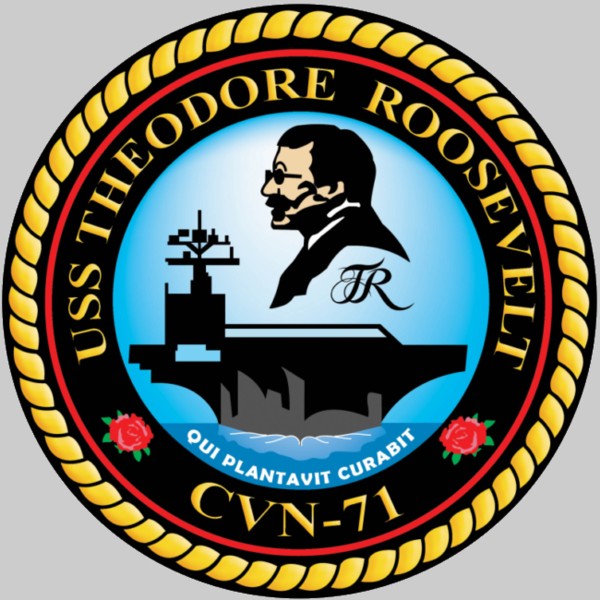 |
||
|
HOME
|
US Navy -
ships
|
US Navy - air
units
|
USMC - air
units
|
International
Navies
|
Weapon Systems
|
Special Reports |
||
|
US Navy - Aircraft Carrier CVN 71 - USS Theodore Roosevelt |
||
|
||
| 04/25 | ||
|
Type, class:
Aircraft Carrier - CVN; Nimitz class Builder: Newport News Shipbuilding, Newport News, Virginia, USA STATUS: Awarded: September 30, 1980 Laid down: October 31, 1981 Launched: October 27, 1984 Commissioned: October 25, 1986 IN SERVICE Homeport: NAS North Island, San Diego, California Namesake: Theodore Roosevelt (1858-1919), 26th President of the USA Ships Motto: QUI PLANTAVIT CURABIT (he who has planted will preserve) Technical Data: see: INFO > Nimitz class Aircraft Carrier - CVN |
||
|
Deployments / Carrier Air Wings embarked / major maintenance periods: January 1987 - February 1987 with Carrier Air Wing 1 (CVW-1) - shakedown cruise - Caribbean Sea March 1987 - July 1987: Post Shakedown Availability at Newport News Shipbuilding, Virginia August 1988 - October 1988 with Carrier Air Wing 8 (CVW-8) - Atlantic Ocean December 1988 - June 1989 with Carrier Air Wing 8 (CVW-8) - Mediterranean Sea July 1989 - November 1989: Selected Restricted Availability (SRA) at Norfolk Naval Shipyard, Virginia December 1990 - June 1991 with Carrier Air Wing 8 (CVW-8) - Operation Desert Shield + Desert Storm October 1991 - May 1992: Drydocking Selected Restricted Availability (DSRA) at Norfolk Naval Shipyard, Virginia March 1993 - September 1993 with Carrier Air Wing 8 (CVW-8) - Mediterranean Sea November 1993 - April 1994: Selected Restricted Availability (SRA) at Norfolk Naval Shipyard, Virginia March 1995 - September 1995 with Carrier Air Wing 8 (CVW-8) - Mediterranean Sea November 1995 - March 1996: Selected Restricted Availability (SRA) at Norfolk Naval Shipyard, Virginia November 1996 - May 1997 with Carrier Air Wing 3 (CVW-3) - Mediterranean Sea July 1997 - July 1998: Extended Selected Restricted Availability (EDSRA) at Newport News Shipbuilding, Virginia March 1999 - September 1999 with Carrier Air Wing 8 (CVW-8) - Mediterranean Sea, Gulf January 2000 - June 2000: Planned Incremental Availability (PIA) at Norfolk Naval Shipyard, Virginia September 2001 - March 2002 with Carrier Air Wing 1 (CVW-1) - Mediterranean Sea, Arabian Sea May 2002 - October 2002: Planned Incremental Availability (PIA) at Norfolk Naval Shipyard, Virginia February 2003 - May 2003 with Carrier Air Wing 8 (CVW-8) - Mediterranean Sea February 2004 - December 2004: Planned Incremental Availability (PIA) at Norfolk Naval Shipyard, Virginia September 2005 - March 2006 with Carrier Air Wing 8 (CVW-8) - Mediterranean Sea, Gulf March 2007 - November 2007: Planned Incremental Availability (PIA) at Norfolk Naval Shipyard, Virginia September 2008 - April 2009 with Carrier Air Wing 8 (CVW-8) - Mediterranean Sea, 5th Fleet AOR August 2009 - August 2013: Refueling and Complex Overhaul (RCOH) at Newport News Shipbuilding & Dry Dock, Virginia March 2015 - November 2015 with Carrier Air Wing 1 (CVW-1) - Norfolk to San Diego via 6th, 5th and 7th Fleet AOR May 2016 - December 2016: Planned Incremental Availability (PIA) at Naval Base San Diego, California October 2017 - May 2018 with Carrier Air Wing 17 (CVW-17) - Pacific Ocean, Gulf July 2018 - December 2018: Planned Incremental Availability (PIA) at Naval Base San Diego, California May 2019 with Carrier Air Wing 11 (CVW-11) - Gulf of Alaska - exercise Northern Edge January 2020 - July 2020 with Carrier Air Wing 11 (CVW-11) - Pacific Ocean December 2020 - May 2021 with Carrier Air Wing 11 (CVW-11) - Pacific Ocean July 2021 - March 2023: Drydocking Selected Restricted Availability (DSRA) at Puget Sound Naval Shipyard, Washington January 2024 - ?? with Carrier Air Wing 11 (CVW-11) - Pacific Ocean, Indian Ocean |
||
| images | ||
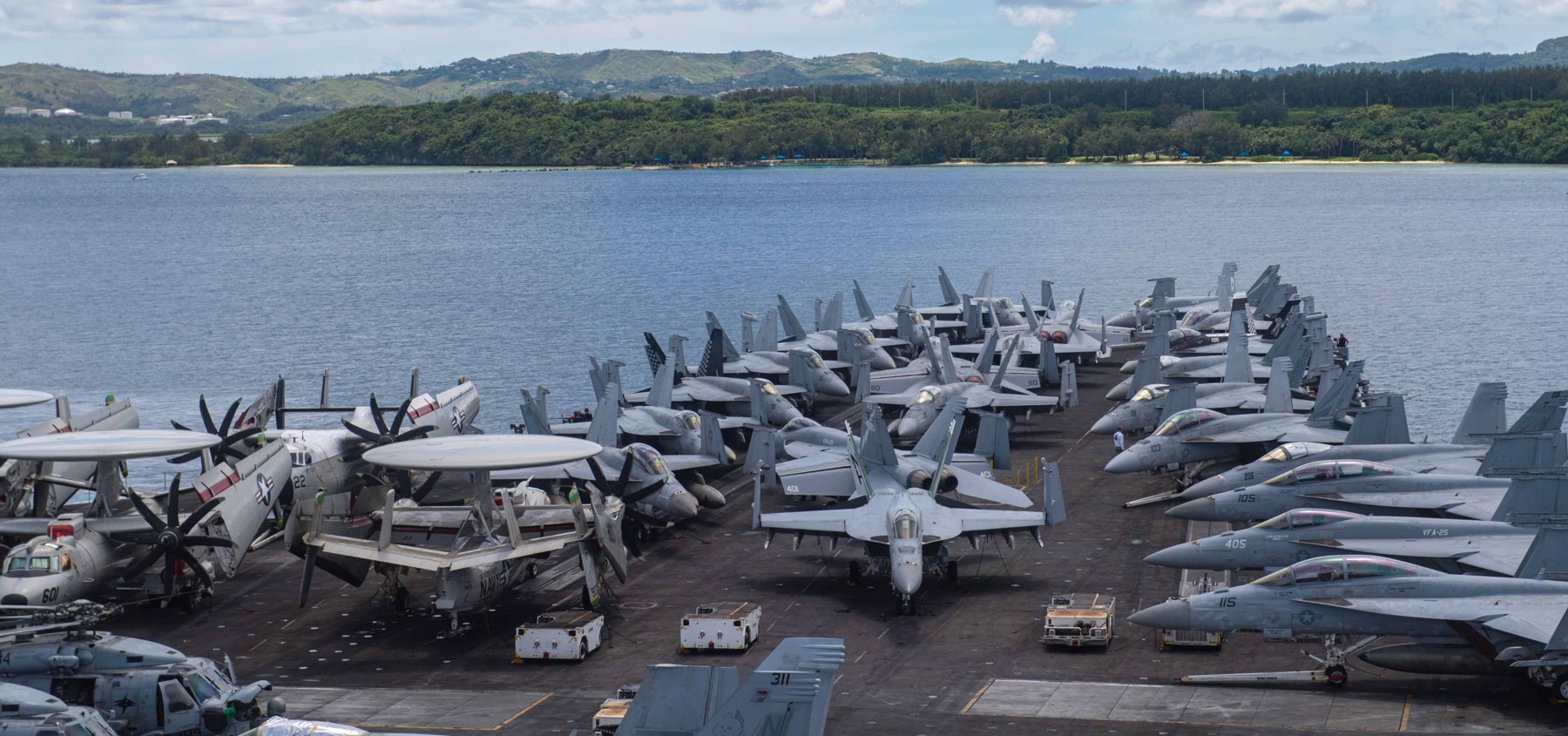 with CVW-11 embarked - Naval Base Guam, Apra Harbor - September 2024 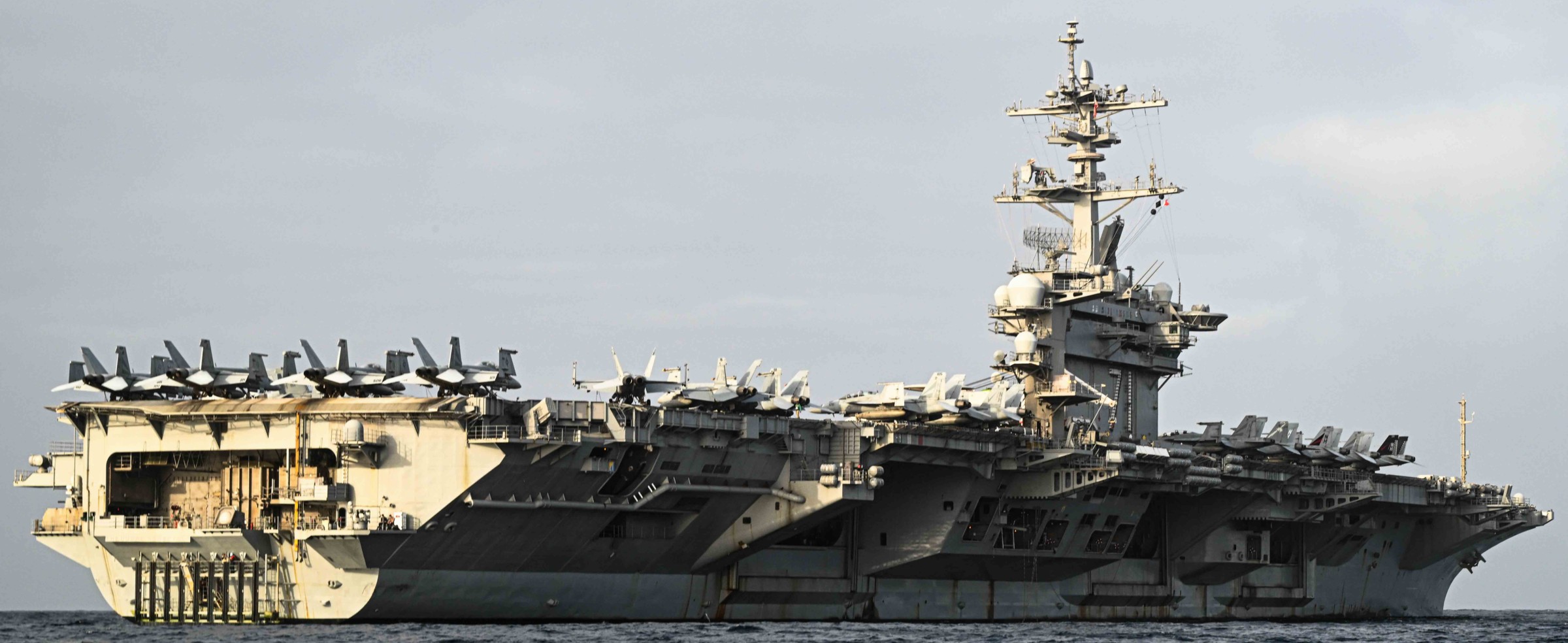 with CVW-11 embarked - 5th Fleet AOO - August 2024 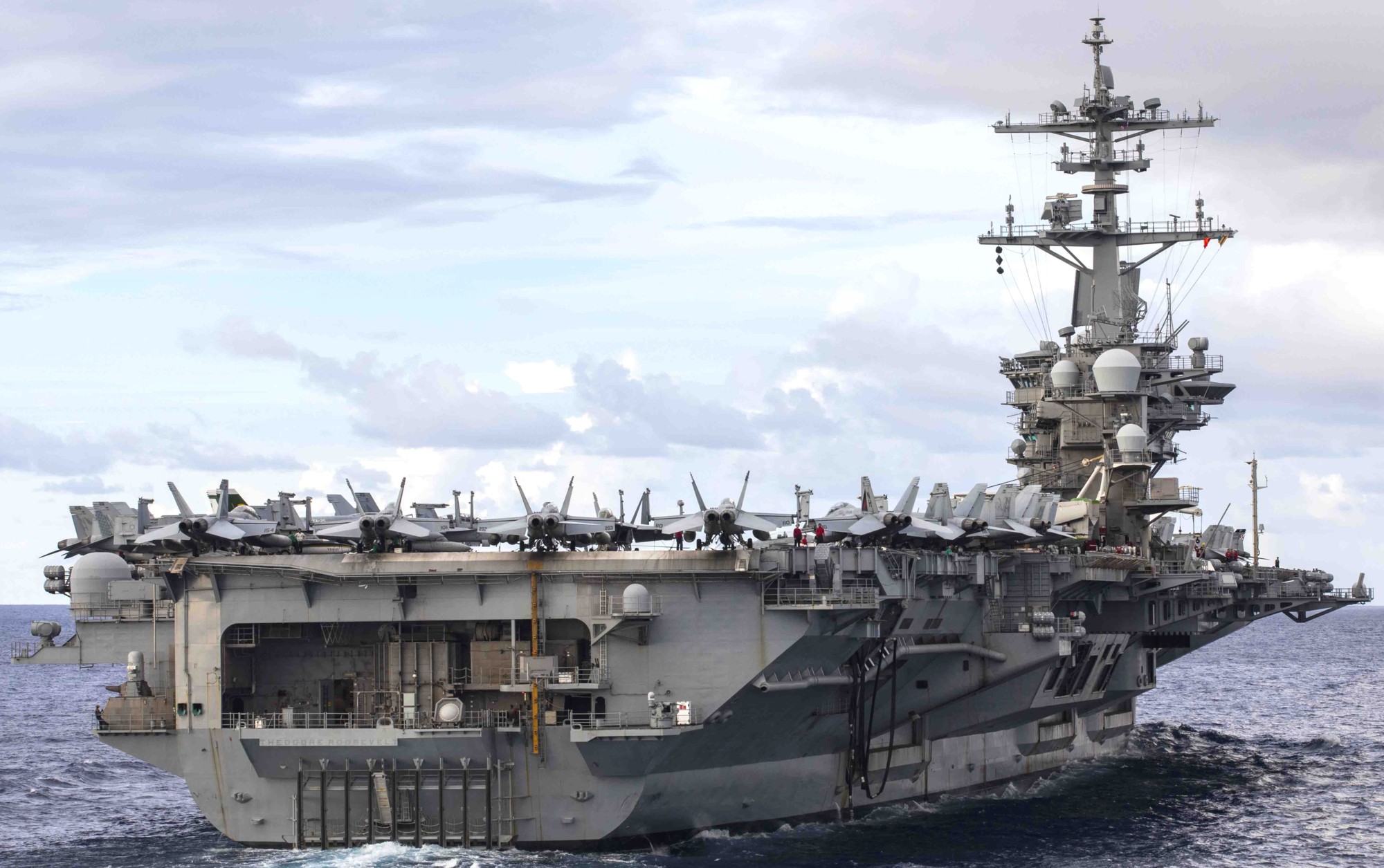 with CVW-11 embarked - South China Sea - June 2024  with CVW-11 embarked - South China Sea - June 2024  with CVW-11 embarked - departing Changi Naval Base, Singapore - May 23, 2024  with CVW-11 embarked - Laem Chabang, Thailand - April 2024  with CVW-11 embarked - 7th Fleet AOR - April 2024  with CVW-11 embarked - Philippine Sea - January 2024  with CVW-11 embarked - Philippine Sea - January 2024 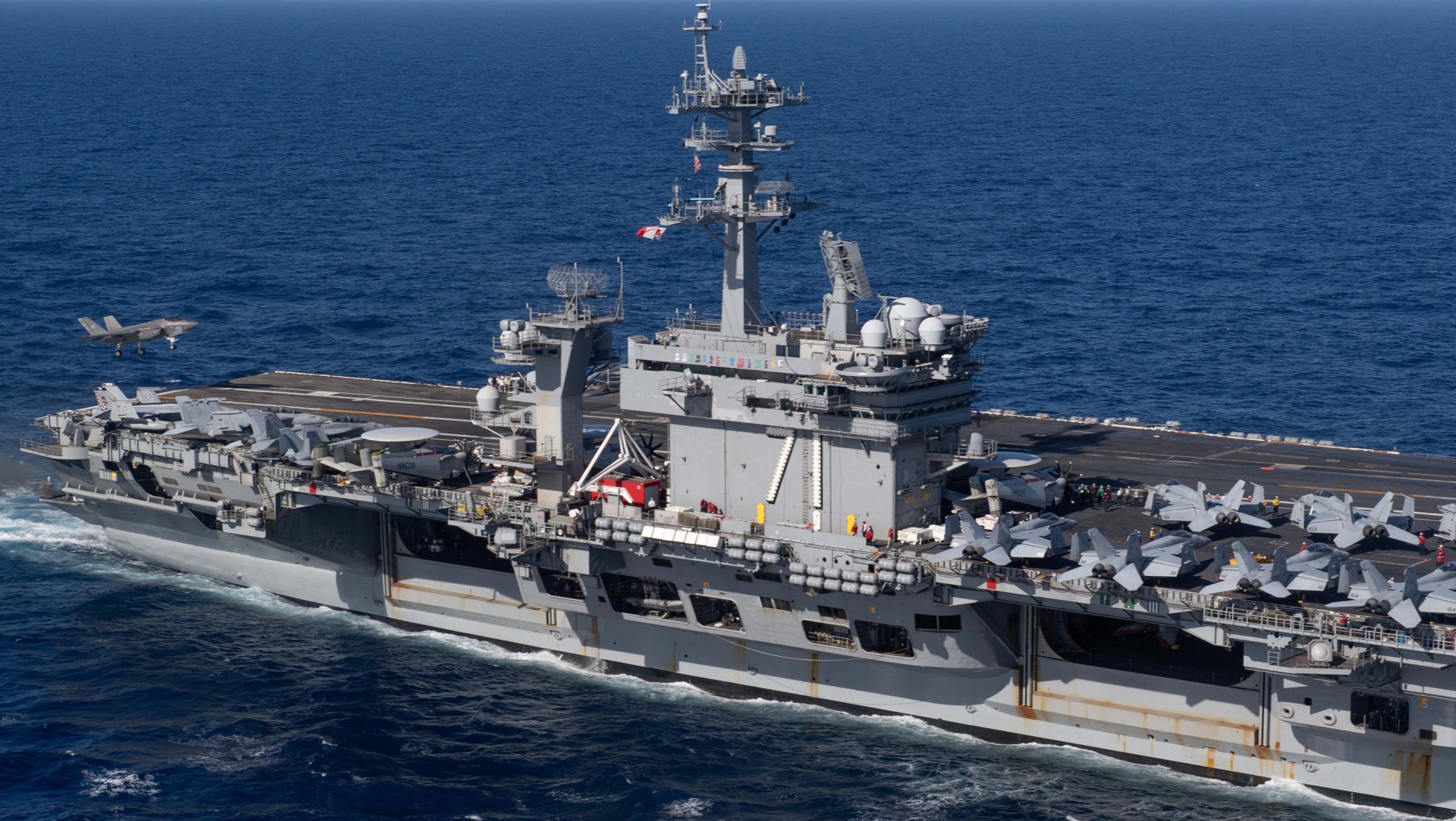 with CVW-11 embarked - Philippine Sea - January 2024 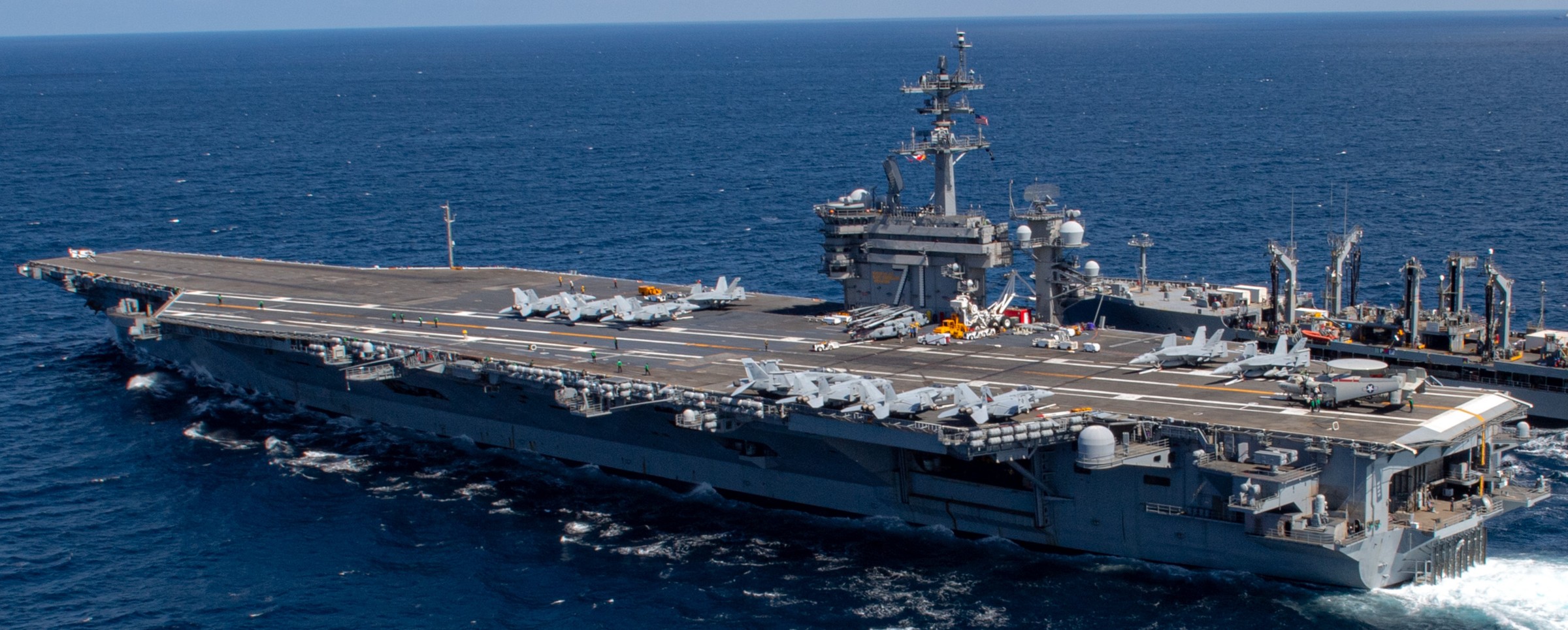 with CVW-11 embarked - Pacific Ocean - September 2023 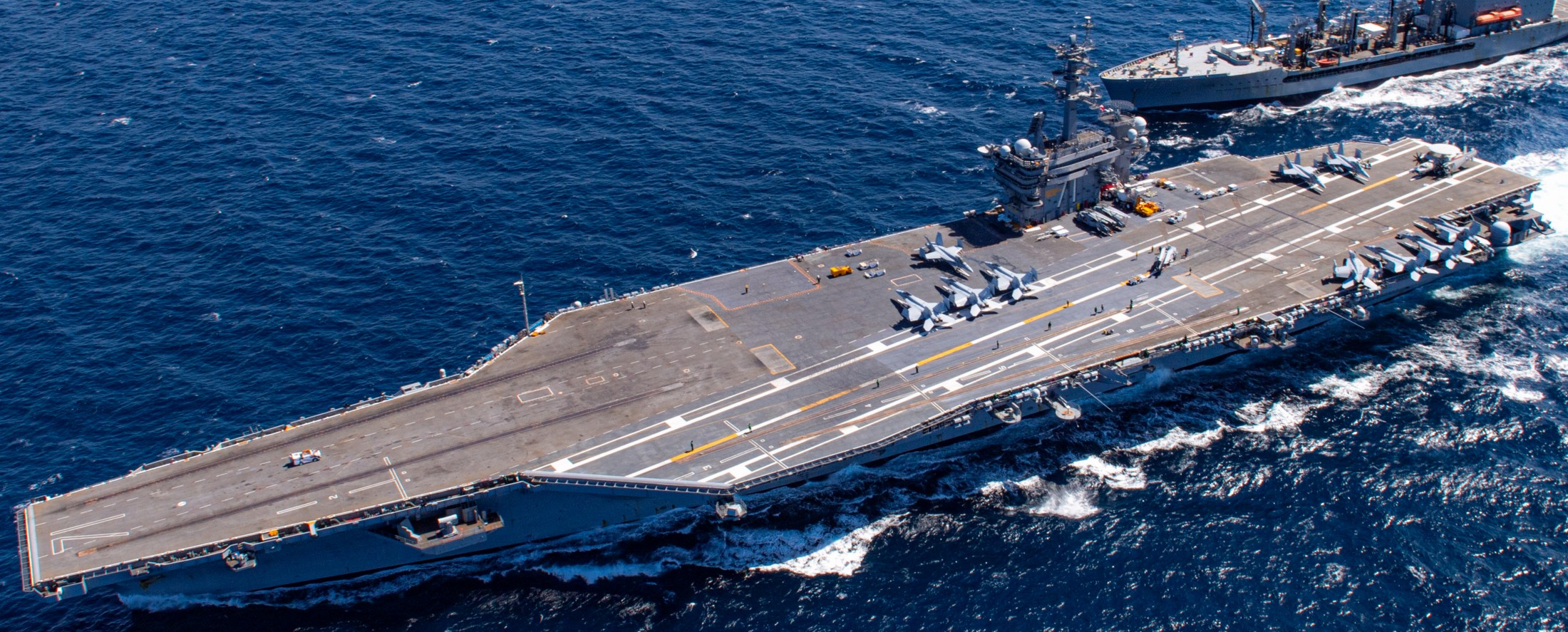 with CVW-11 embarked - Pacific Ocean - September 2023 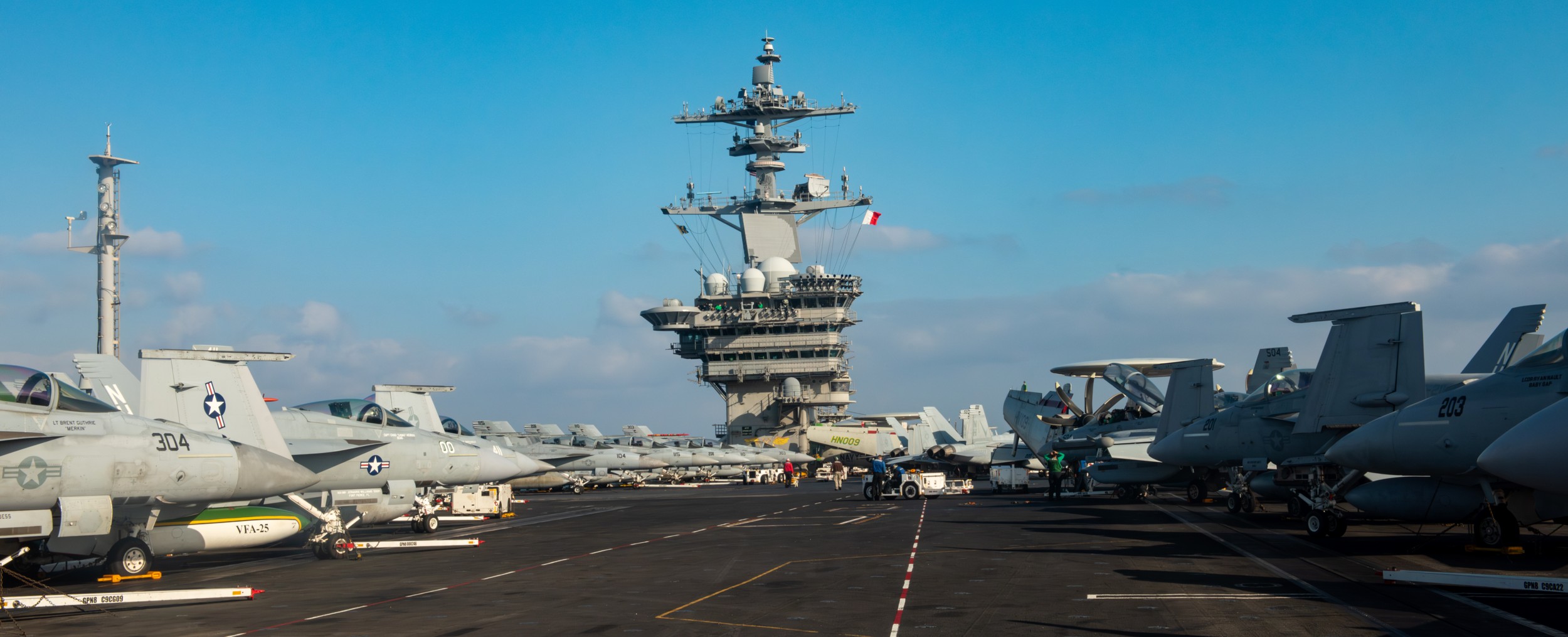 with CVW-11 embarked - Pacific Ocean - September 2023 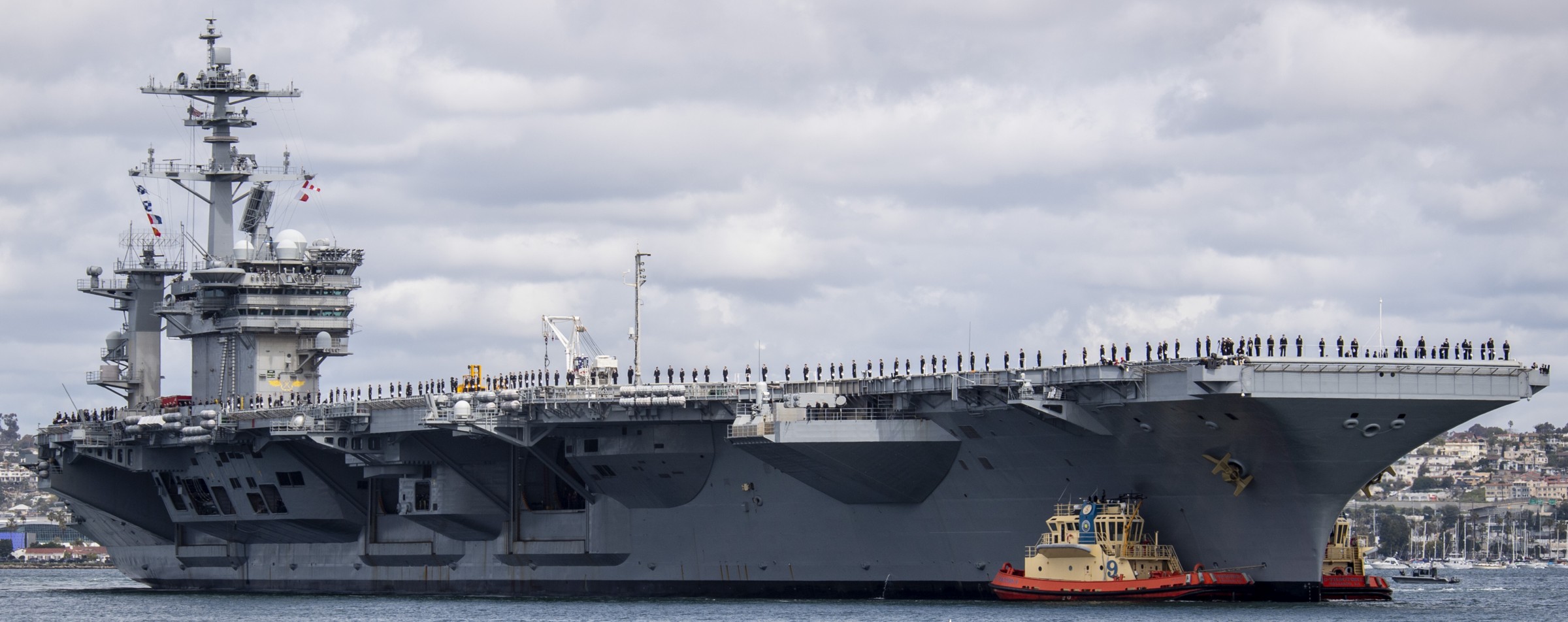 returning to her homeport NAS North Island, San Diego, California after a 28-month DPIA at Puget Sound Naval Shipyard - March 2023  returning to her homeport NAS North Island, San Diego, California after a 28-month DPIA at Puget Sound Naval Shipyard - March 2023 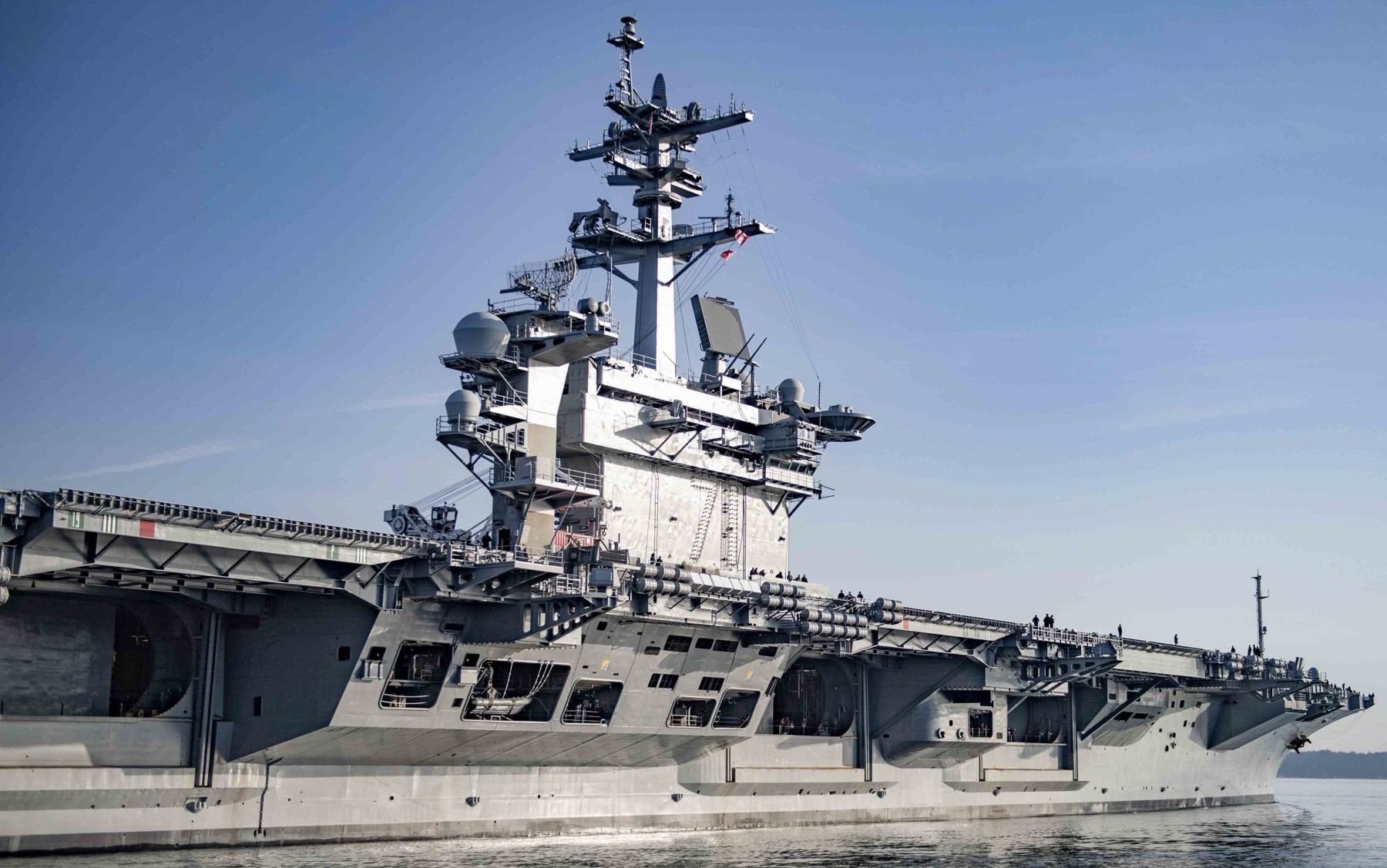 departing Puget Sound Naval Shipyard, Bremerton, Washington after her scheduled DPIA - March 2023 July 2021 - March 2023: Drydocking Planned Incremental Availability (DPIA) at Puget Sound Naval Shipyard, Bremerton, Washington 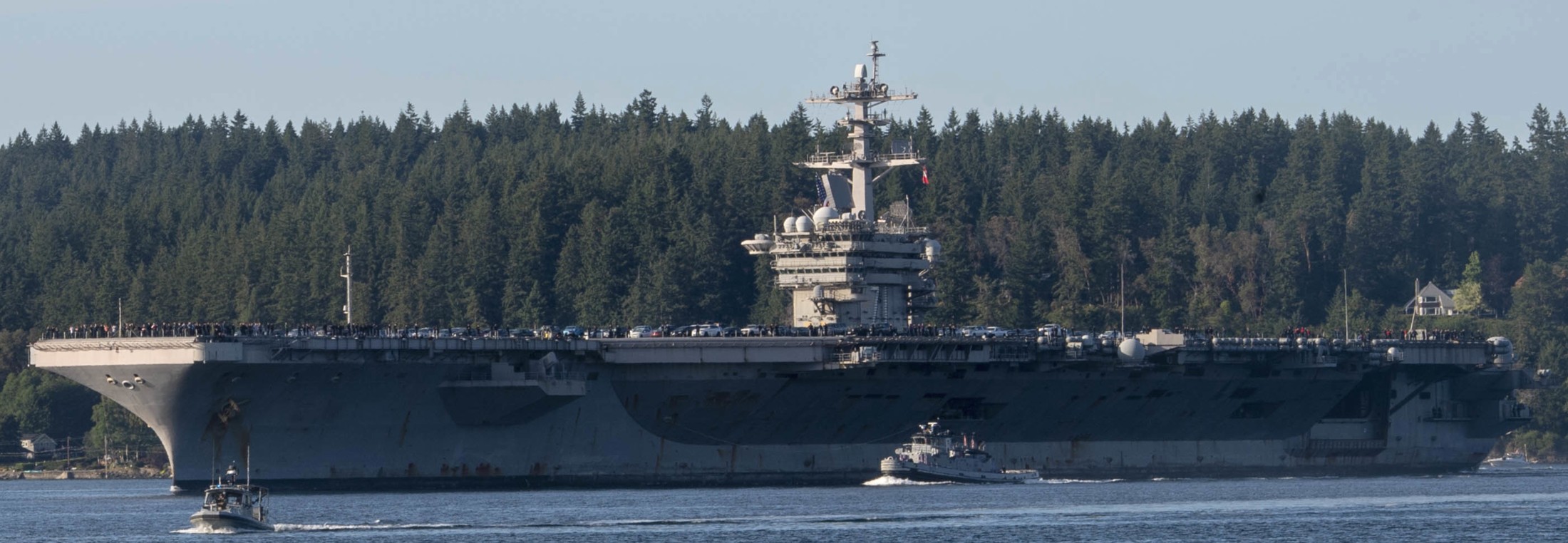 arriving at Puget Sound Naval Shipyard, Bremerton, Washington for her scheduled DPIA - July 2021  arriving at Puget Sound Naval Shipyard, Bremerton, Washington for her scheduled DPIA - July 2021  returning to Naval Base San Diego, California - May 2021 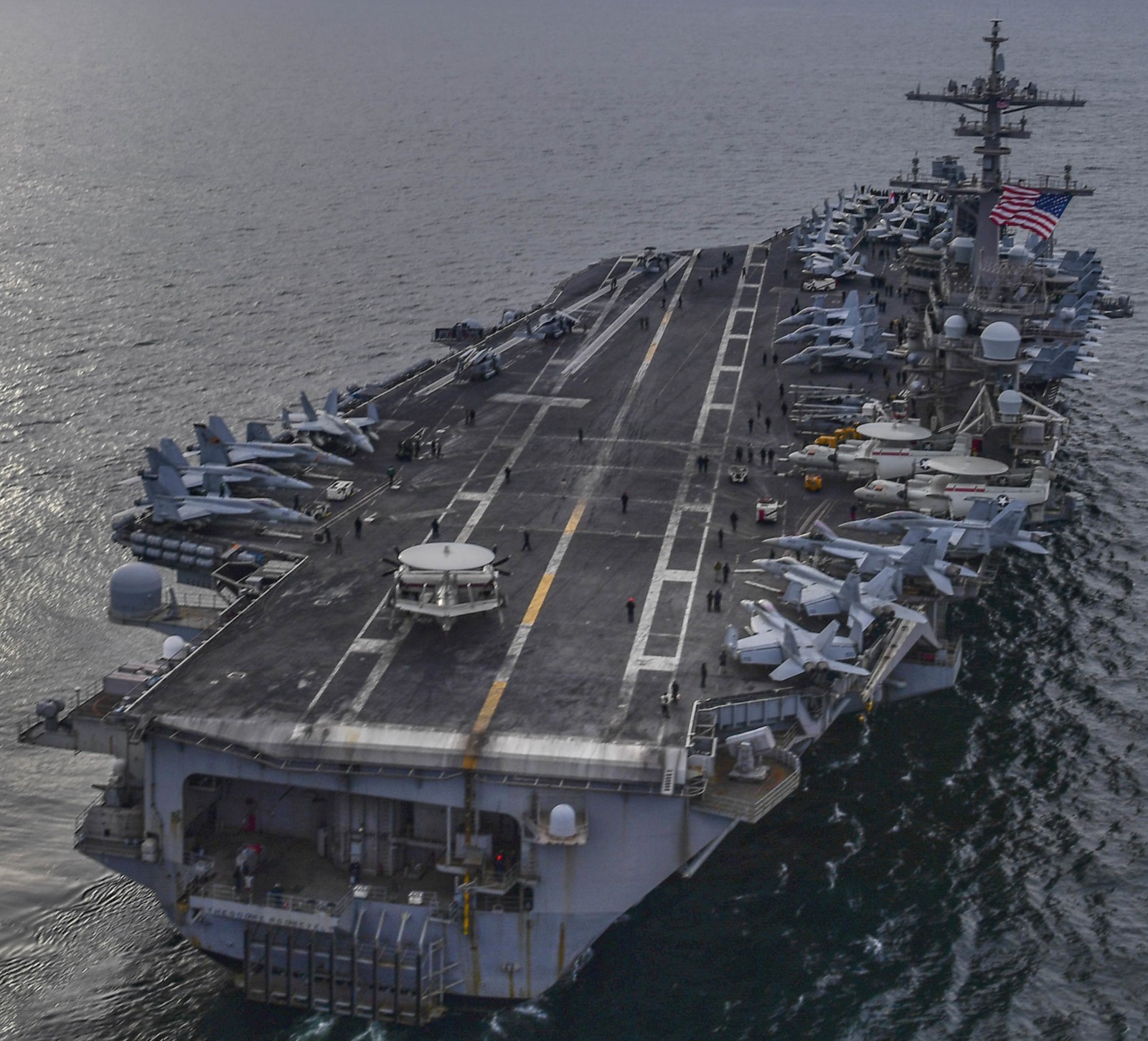 with CVW-11 embarked - Gulf of Alaska - May 2021 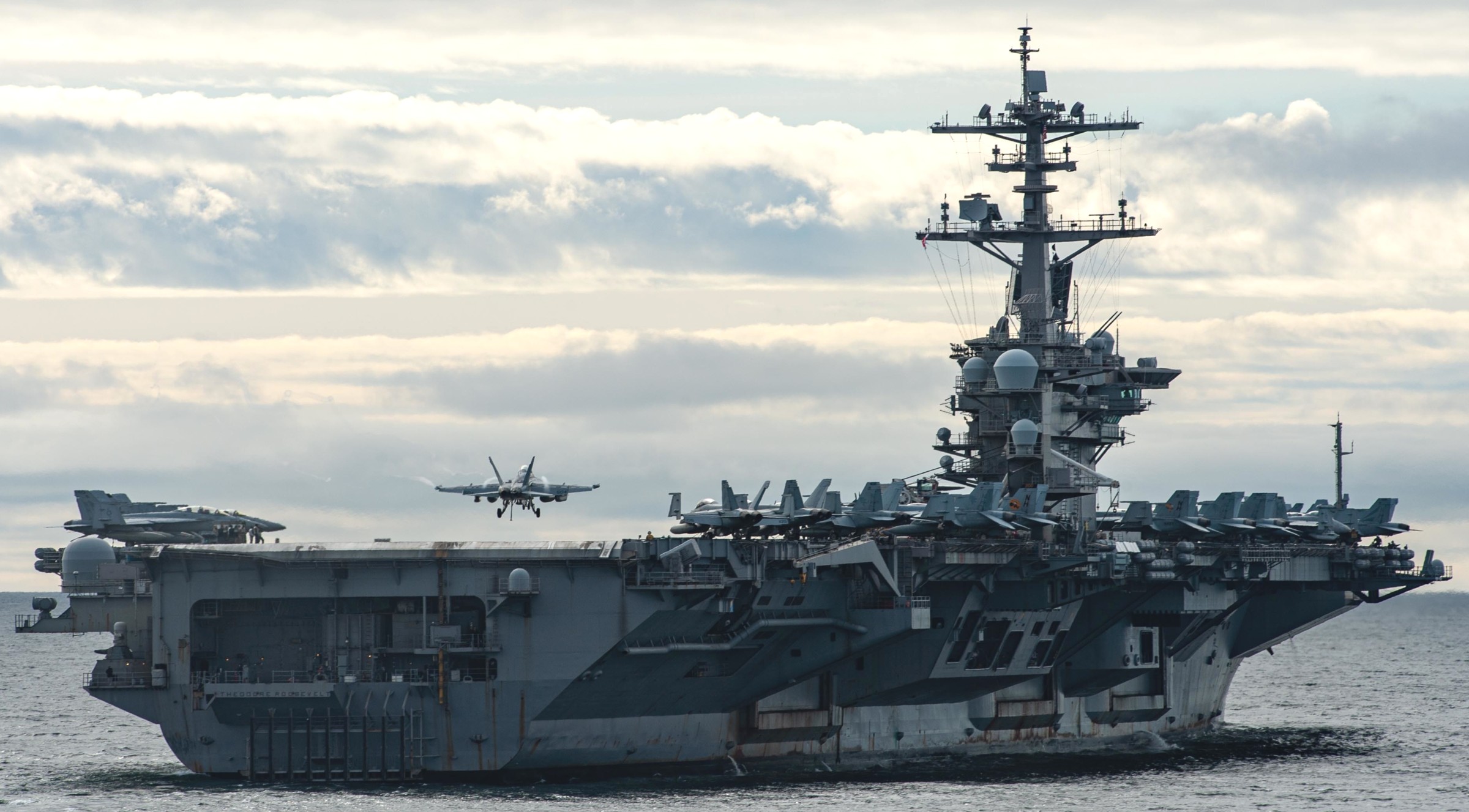 with CVW-11 embarked - Pacific Ocean - April 2021 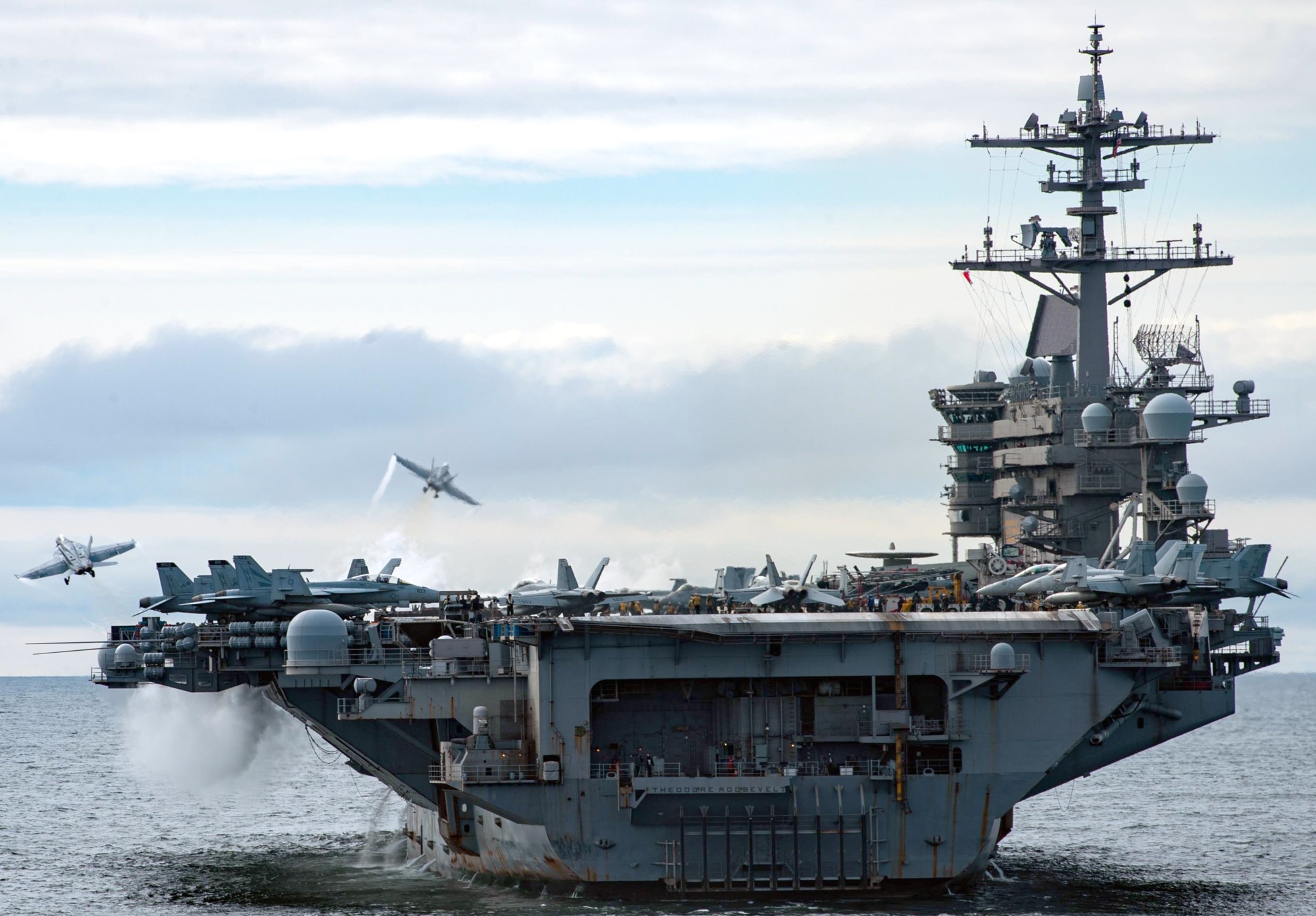 with CVW-11 embarked - Pacific Ocean - April 2021 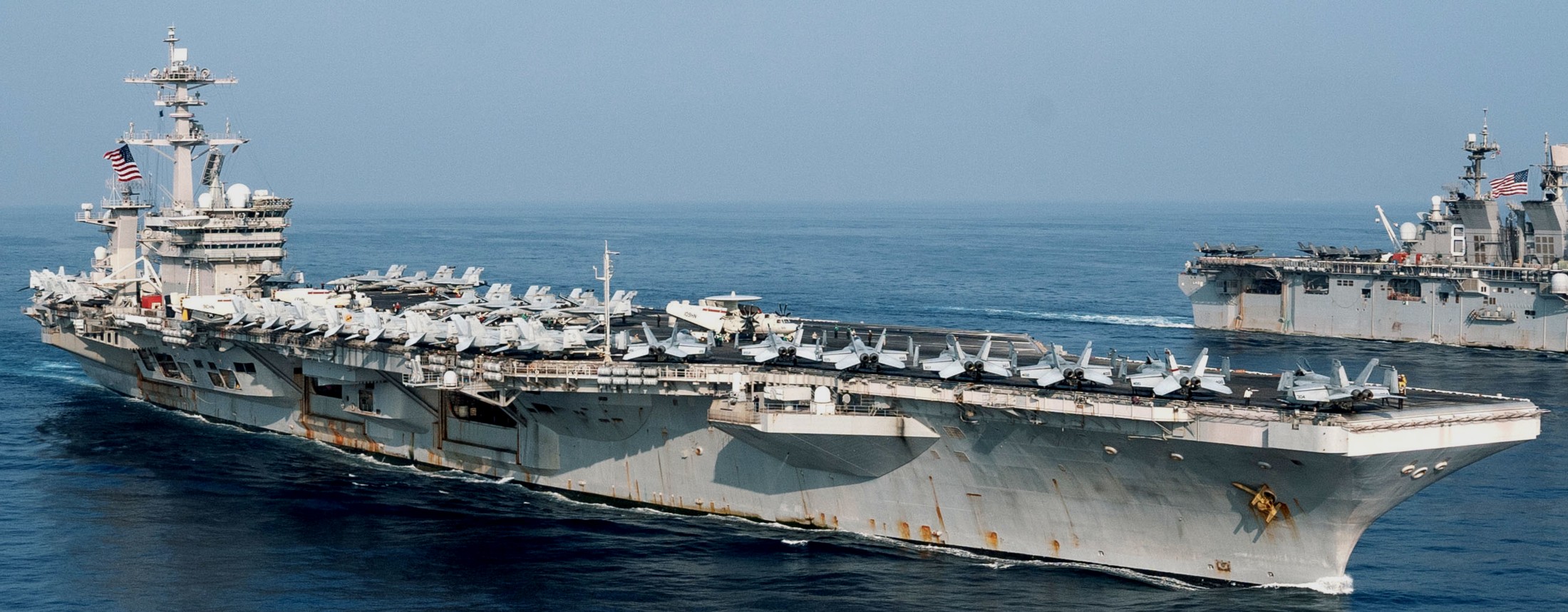 with CVW-11 embarked - South China Sea - April 2021 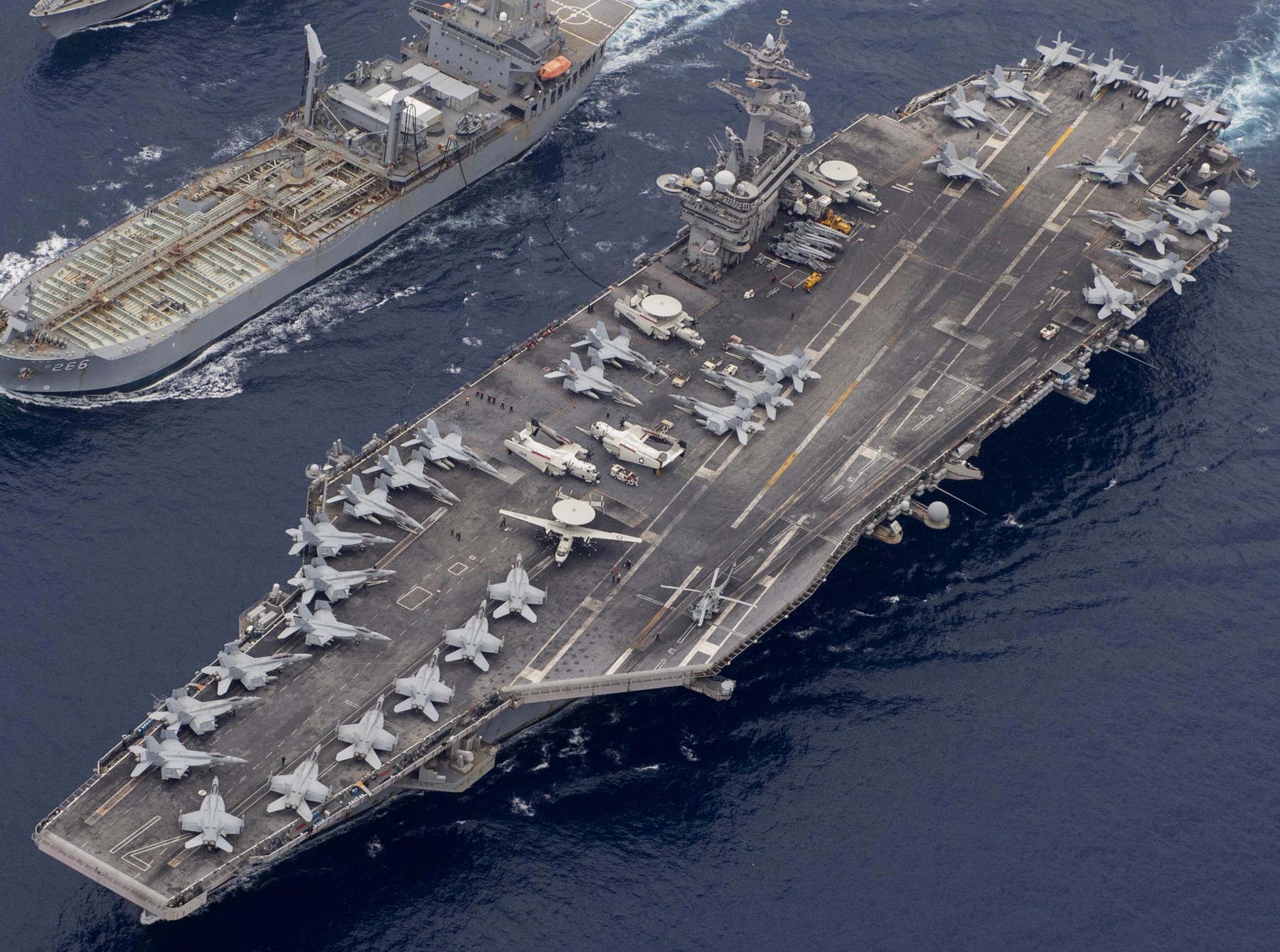 with CVW-11 embarked - Indian Ocean - March 2021 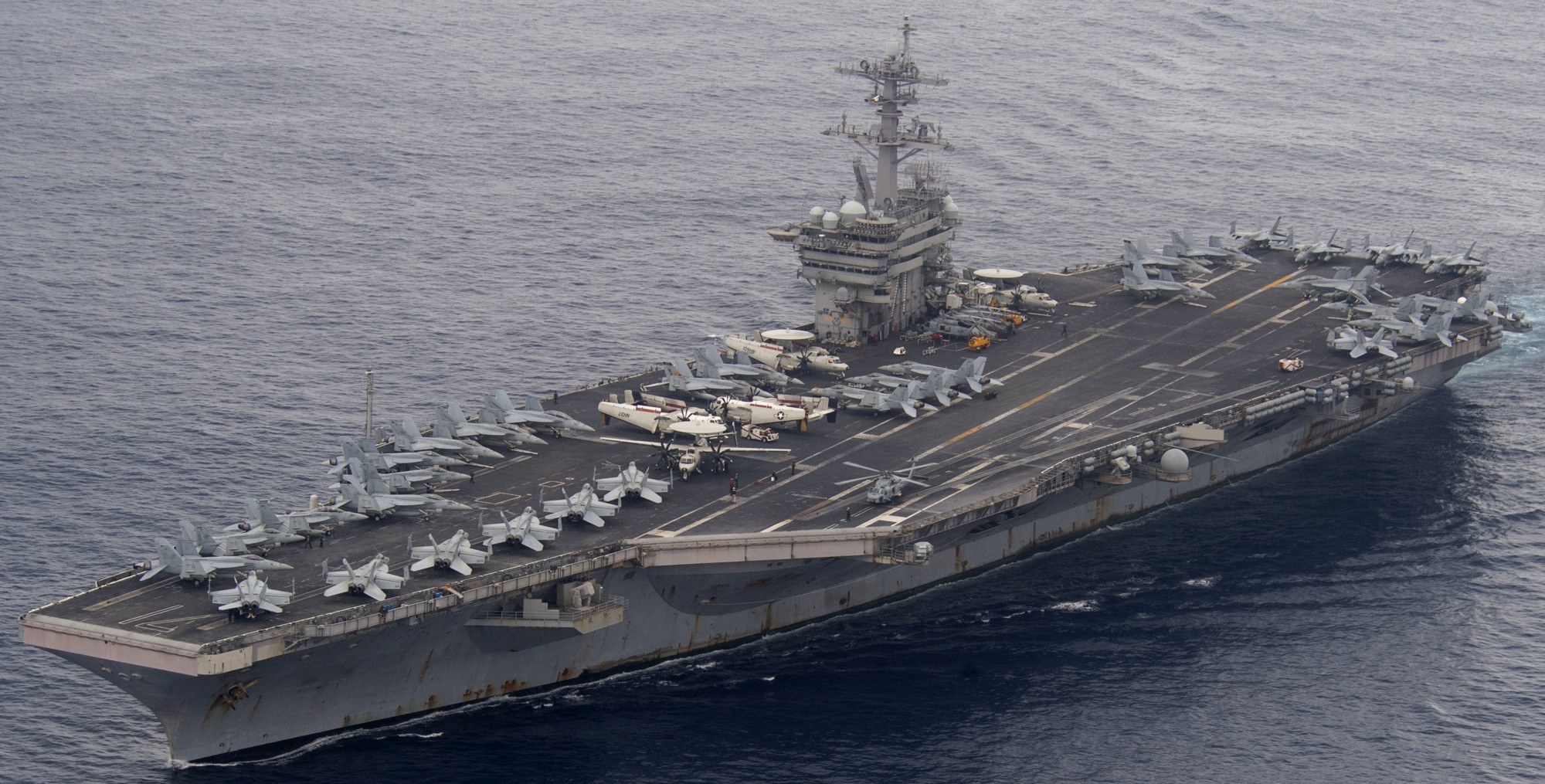 with CVW-11 embarked - Indian Ocean - March 2021 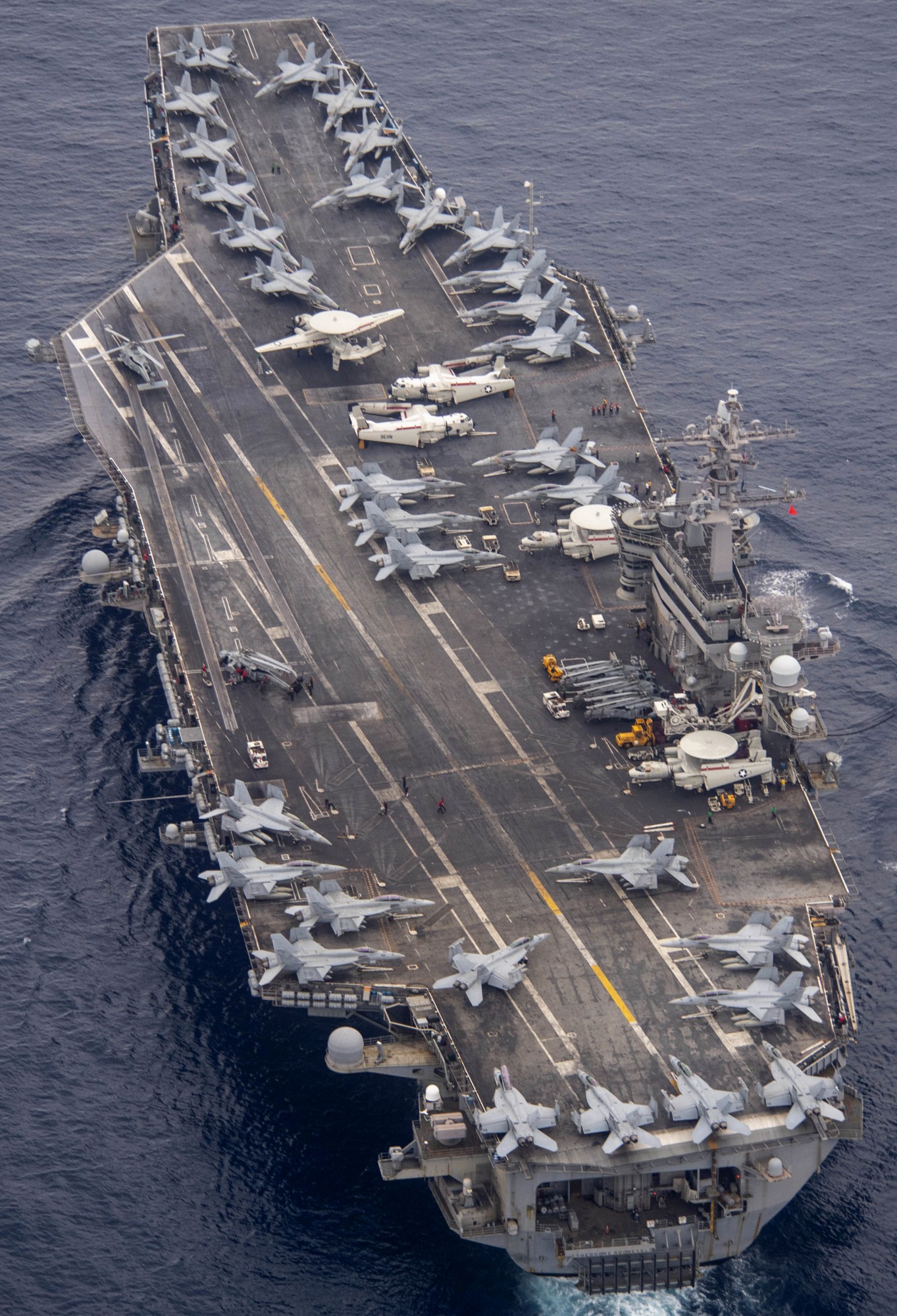 with CVW-11 embarked - Indian Ocean - March 2021 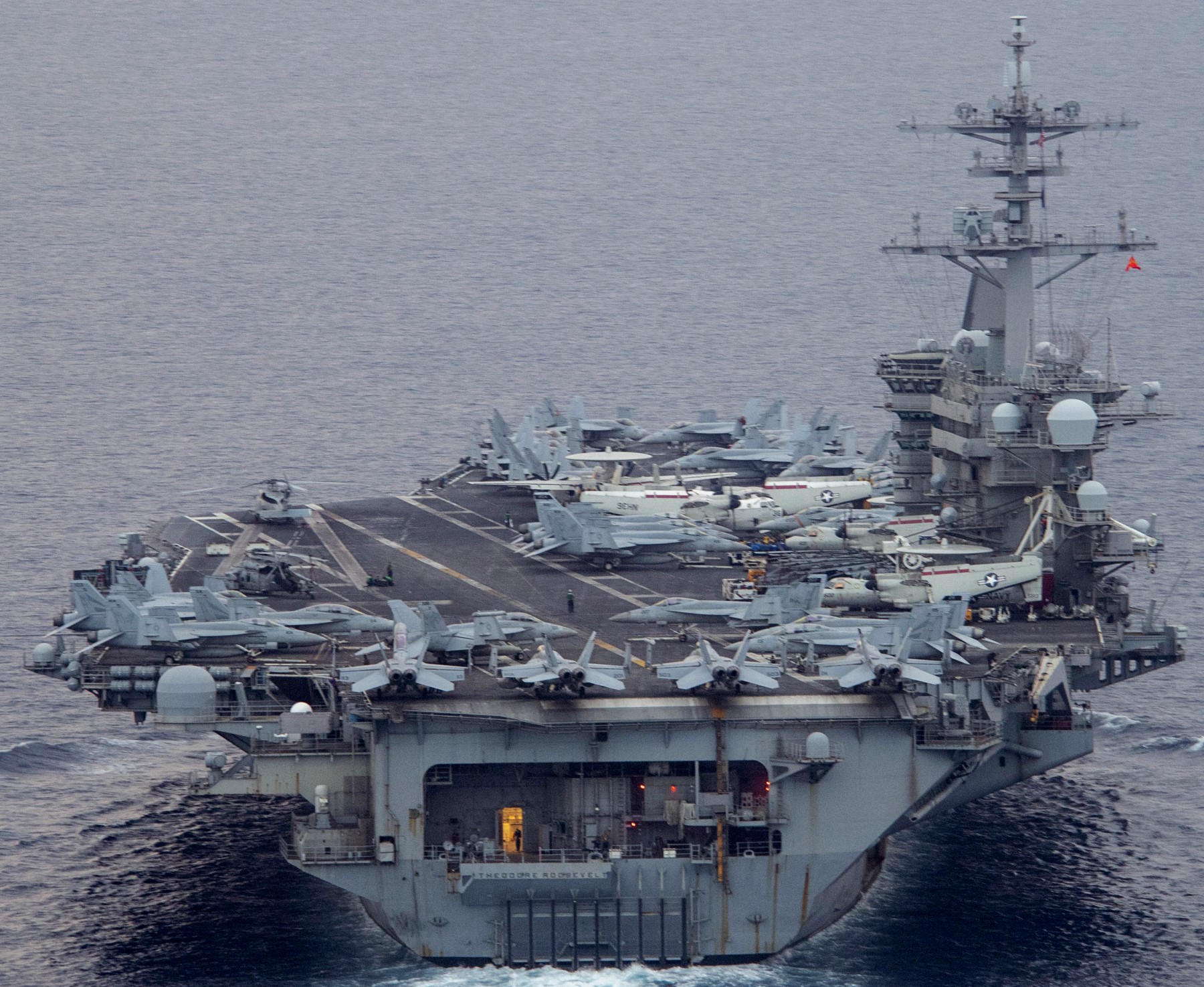 with CVW-11 embarked - Indian Ocean - March 2021 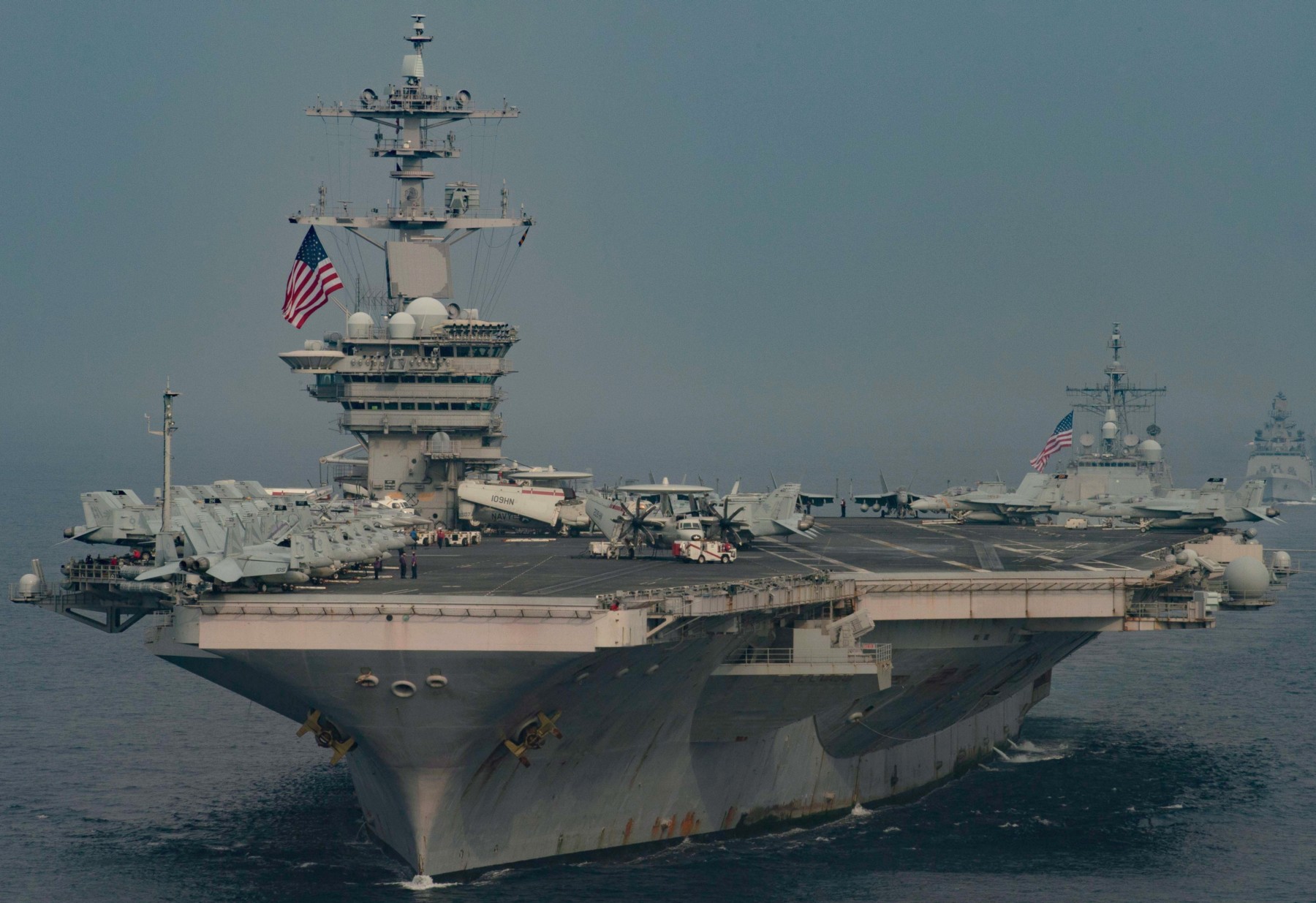 with CVW-11 embarked - Indian Ocean - March 2021 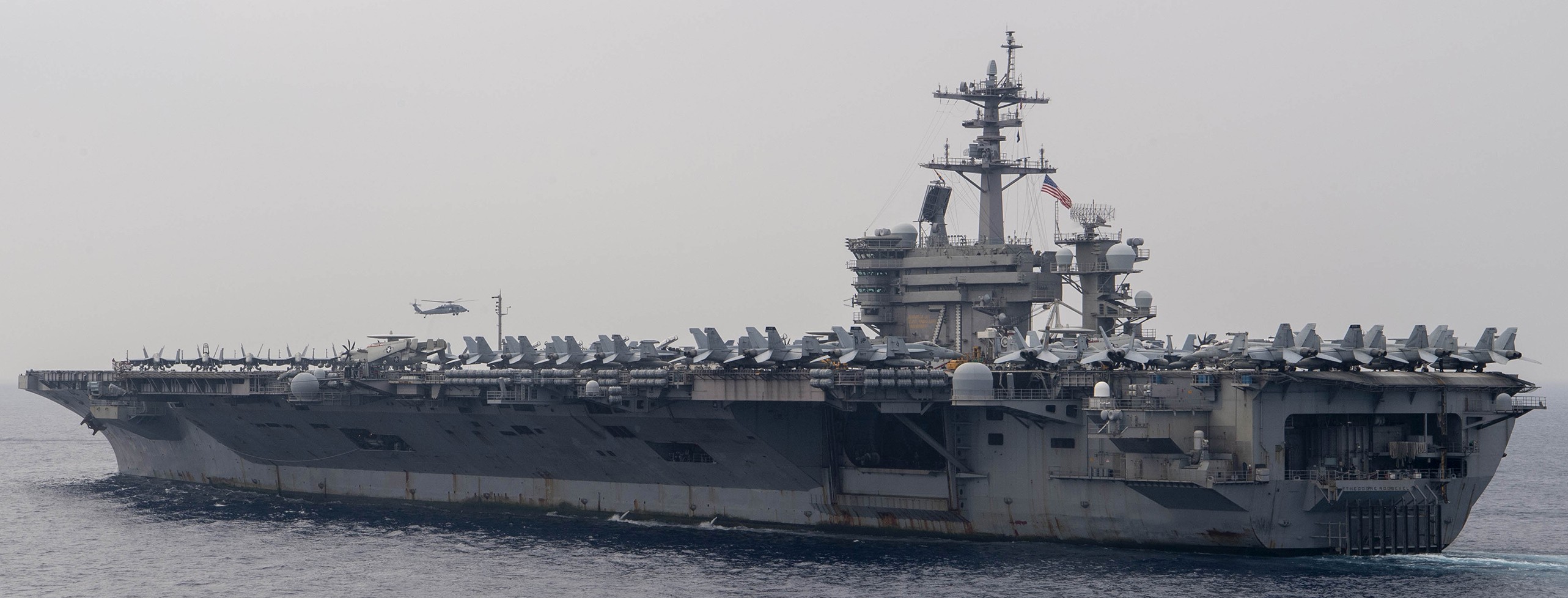 with CVW-11 embarked - Indian Ocean - March 2021 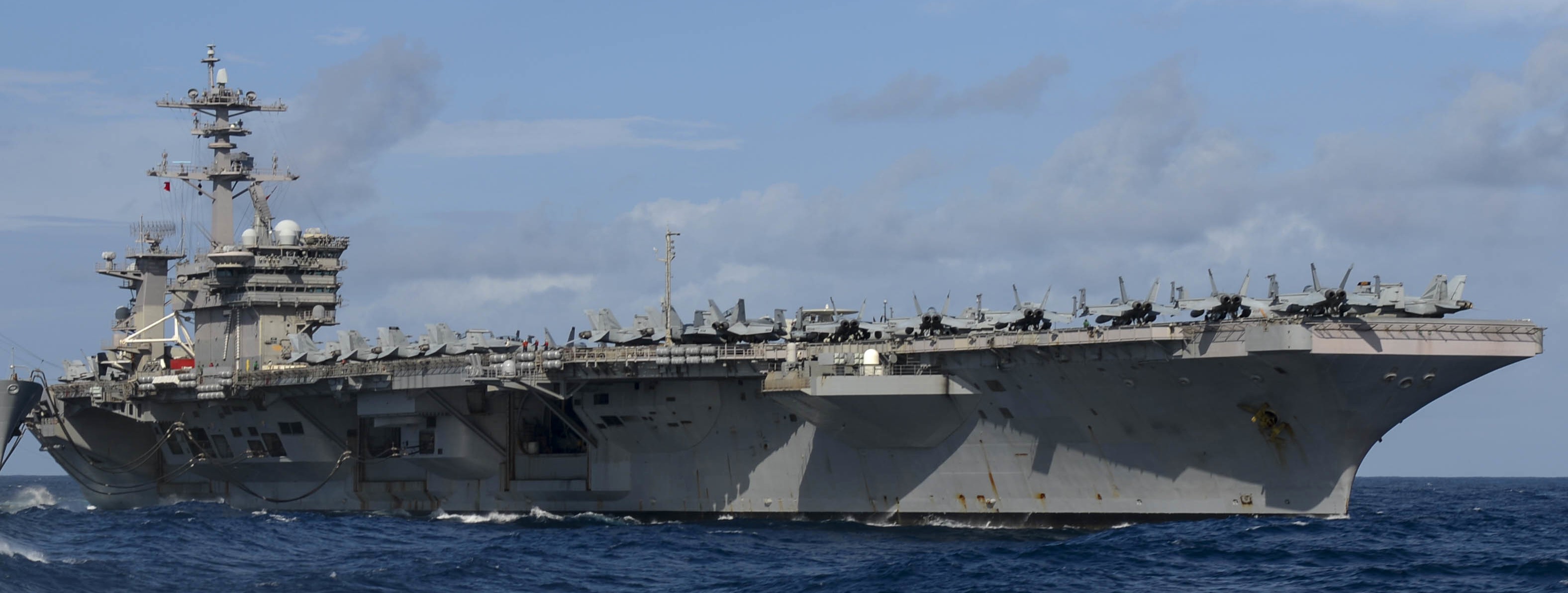 with CVW-11 embarked - South China Sea - February 2021 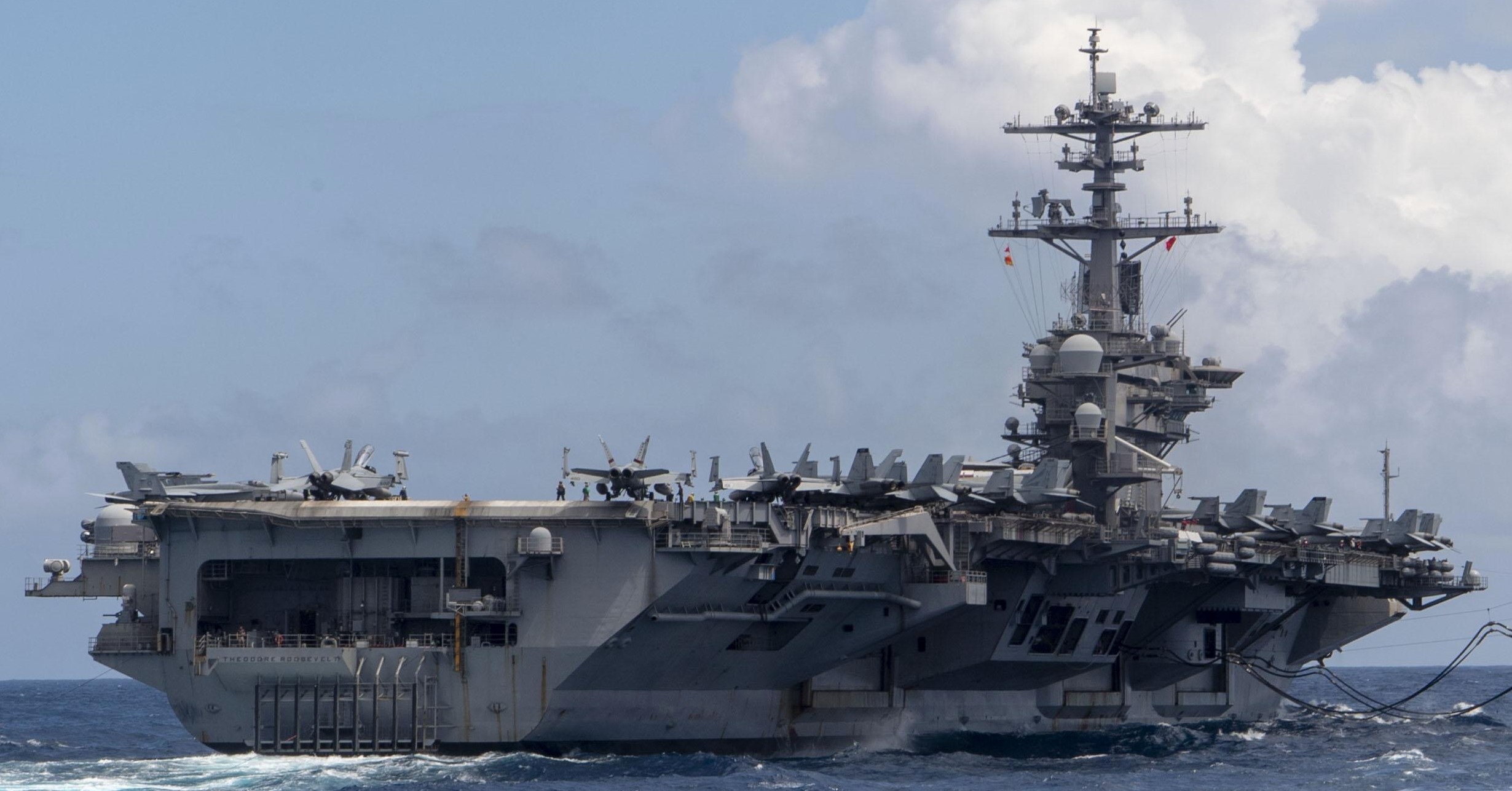 with CVW-11 embarked - South China Sea - February 2021 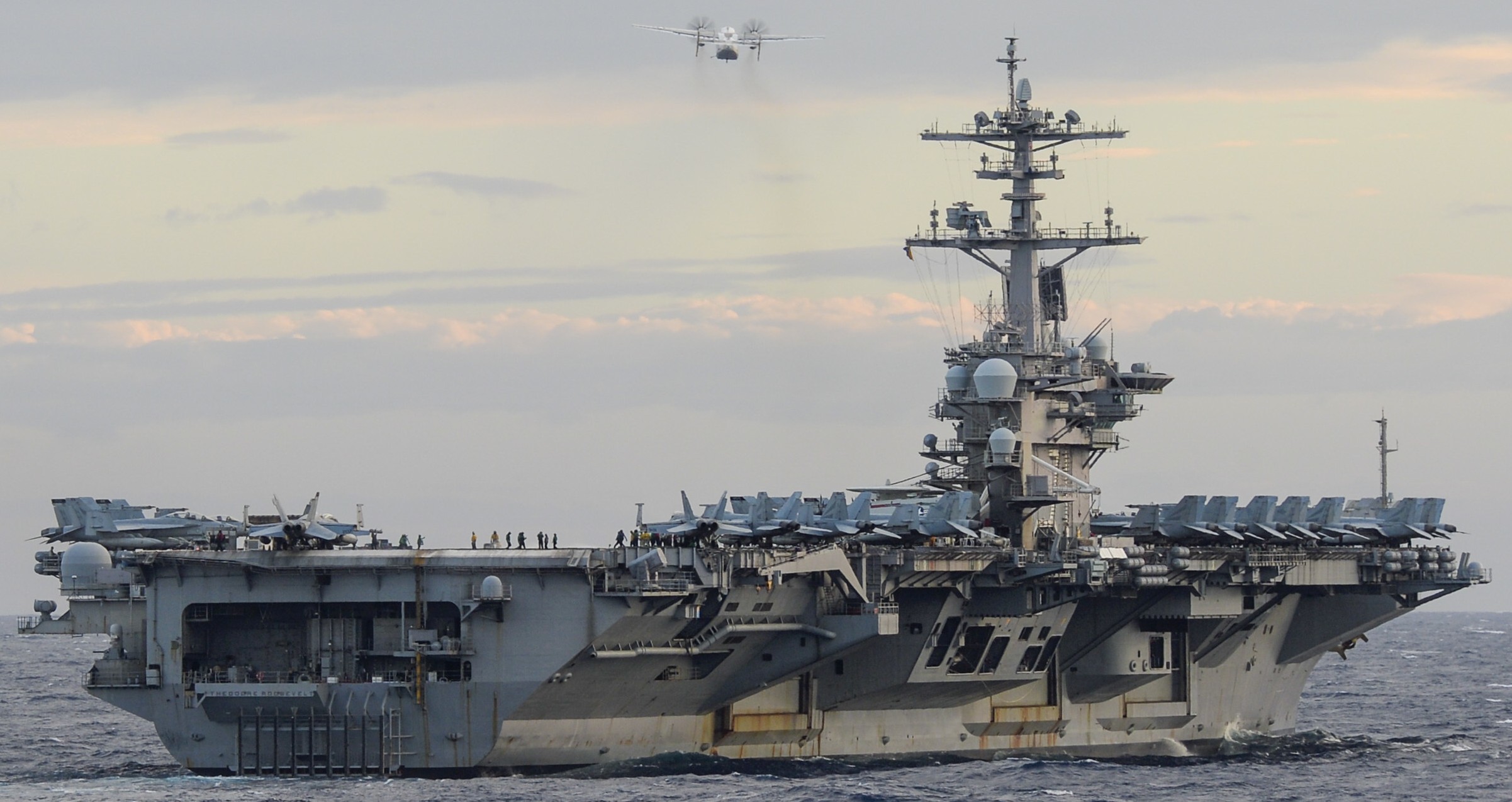 with CVW-11 embarked - South China Sea - February 2021 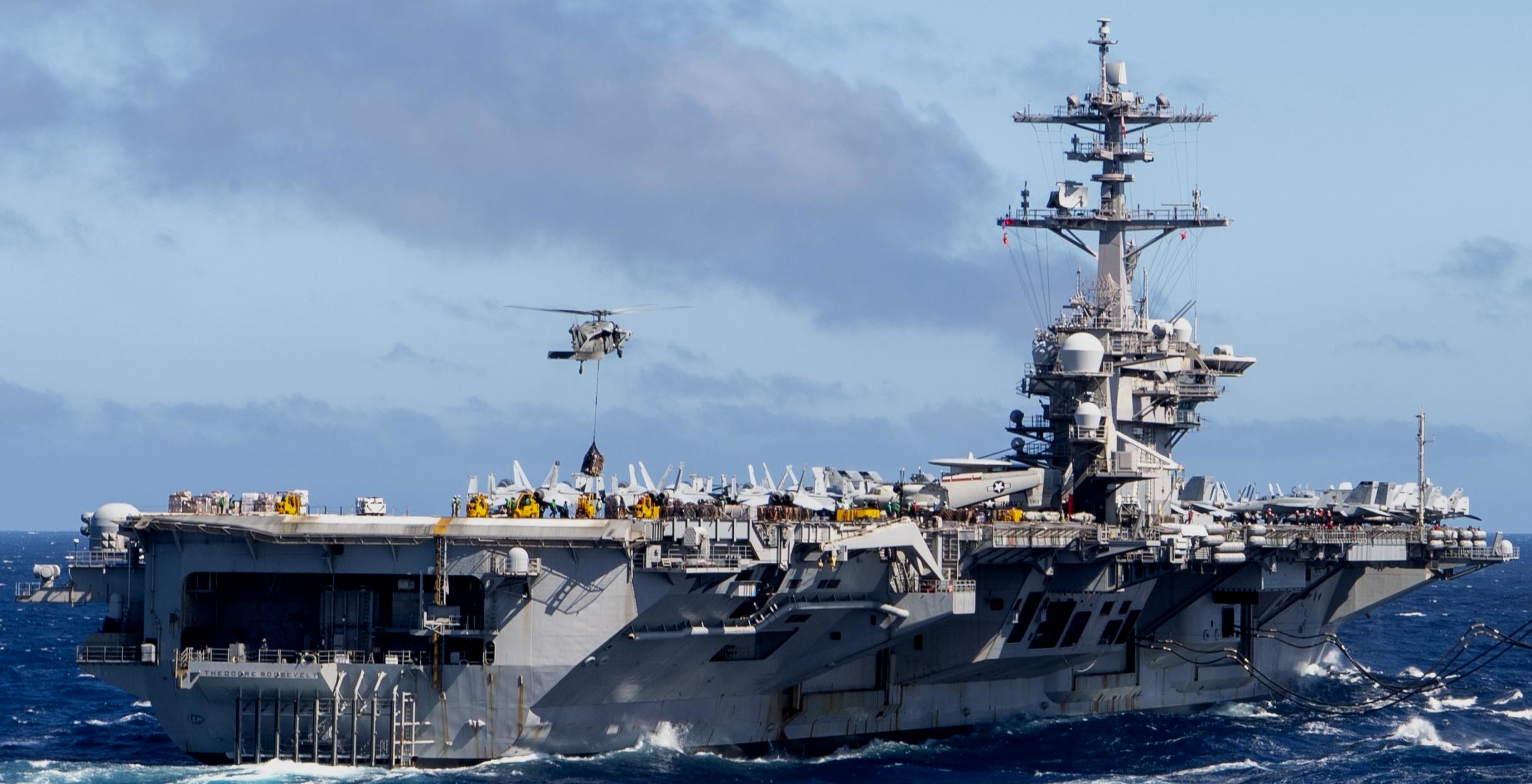 with CVW-11 embarked - Pacific Ocean - January 2021  with CVW-11 embarked - Pacific Ocean - January 2021  with CVW-11 embarked - Pacific Ocean - December 2020 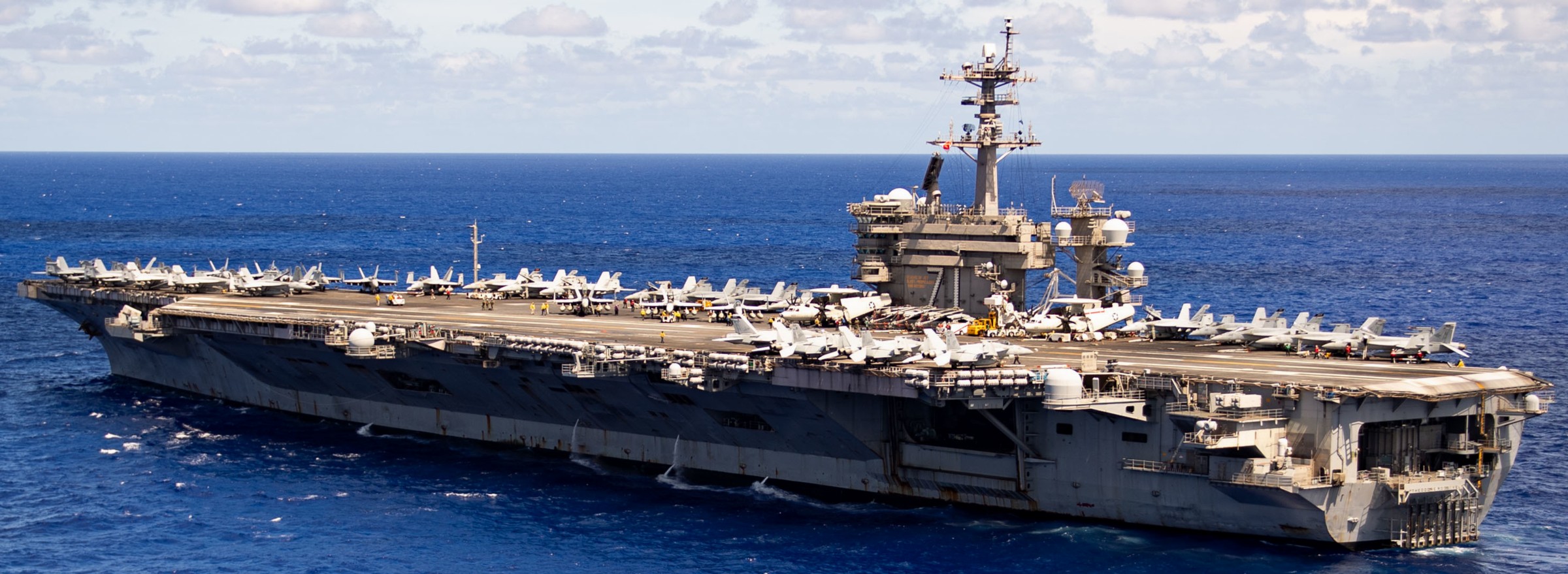 with CVW-11 embarked - Philippine Sea - June 2020 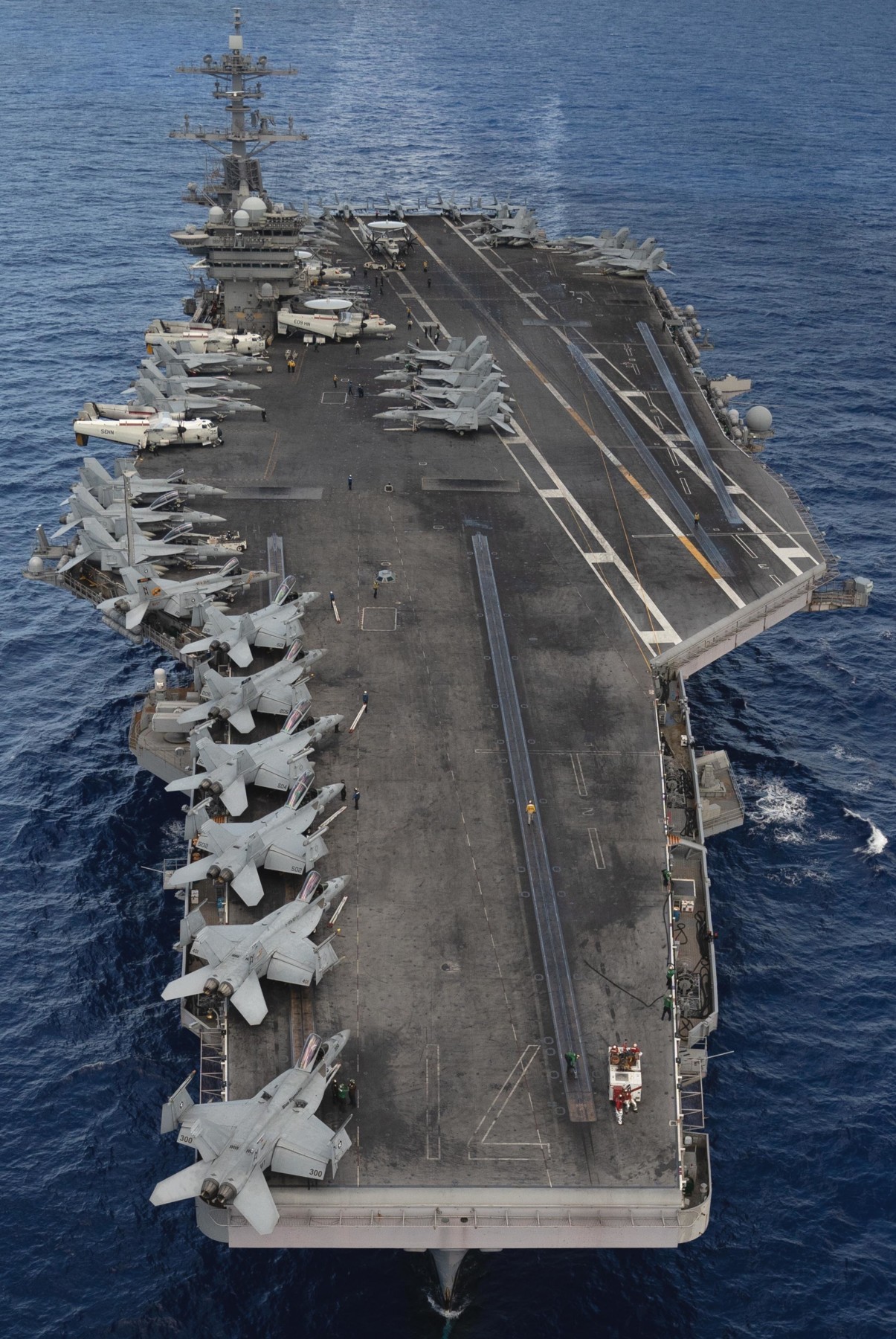 with CVW-11 embarked - Philippine Sea - June 2020 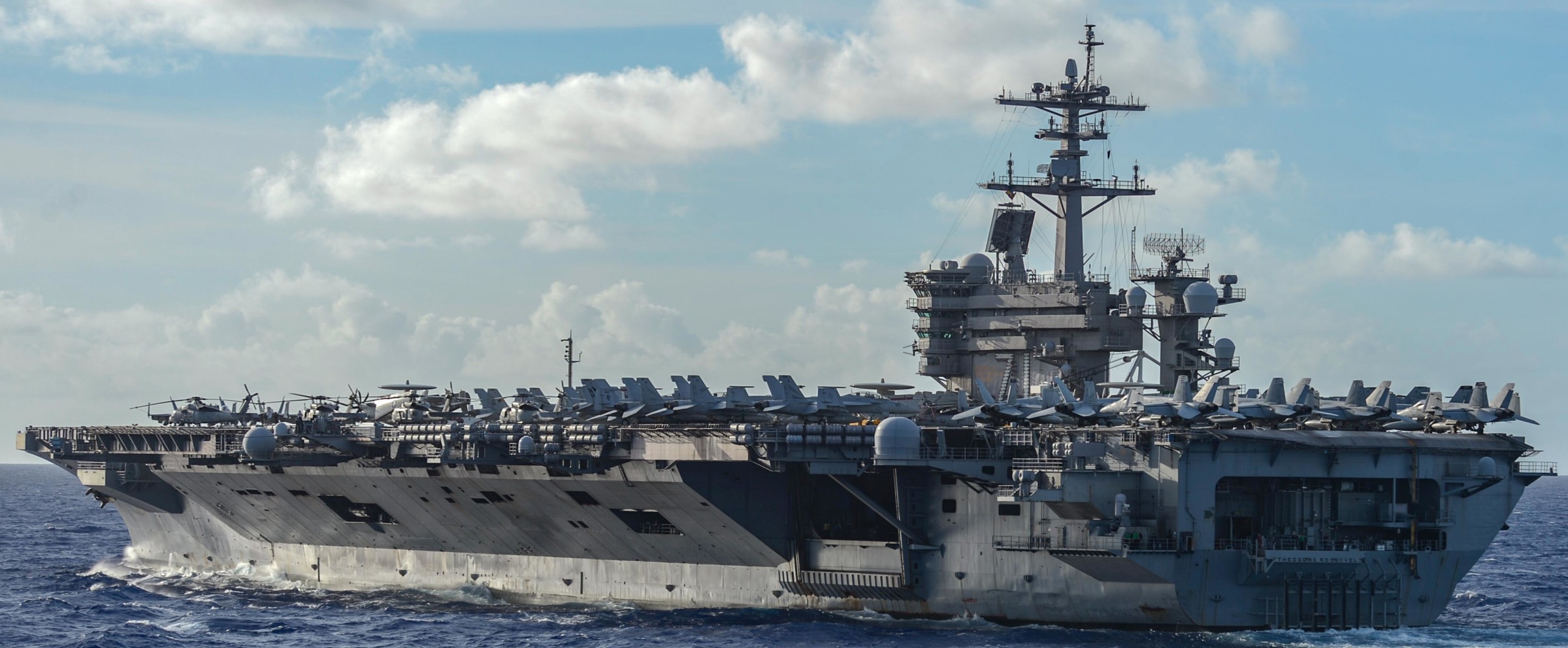 with CVW-11 embarked - Philippine Sea - June 2020  with CVW-11 embarked - Philippine Sea - June 2020 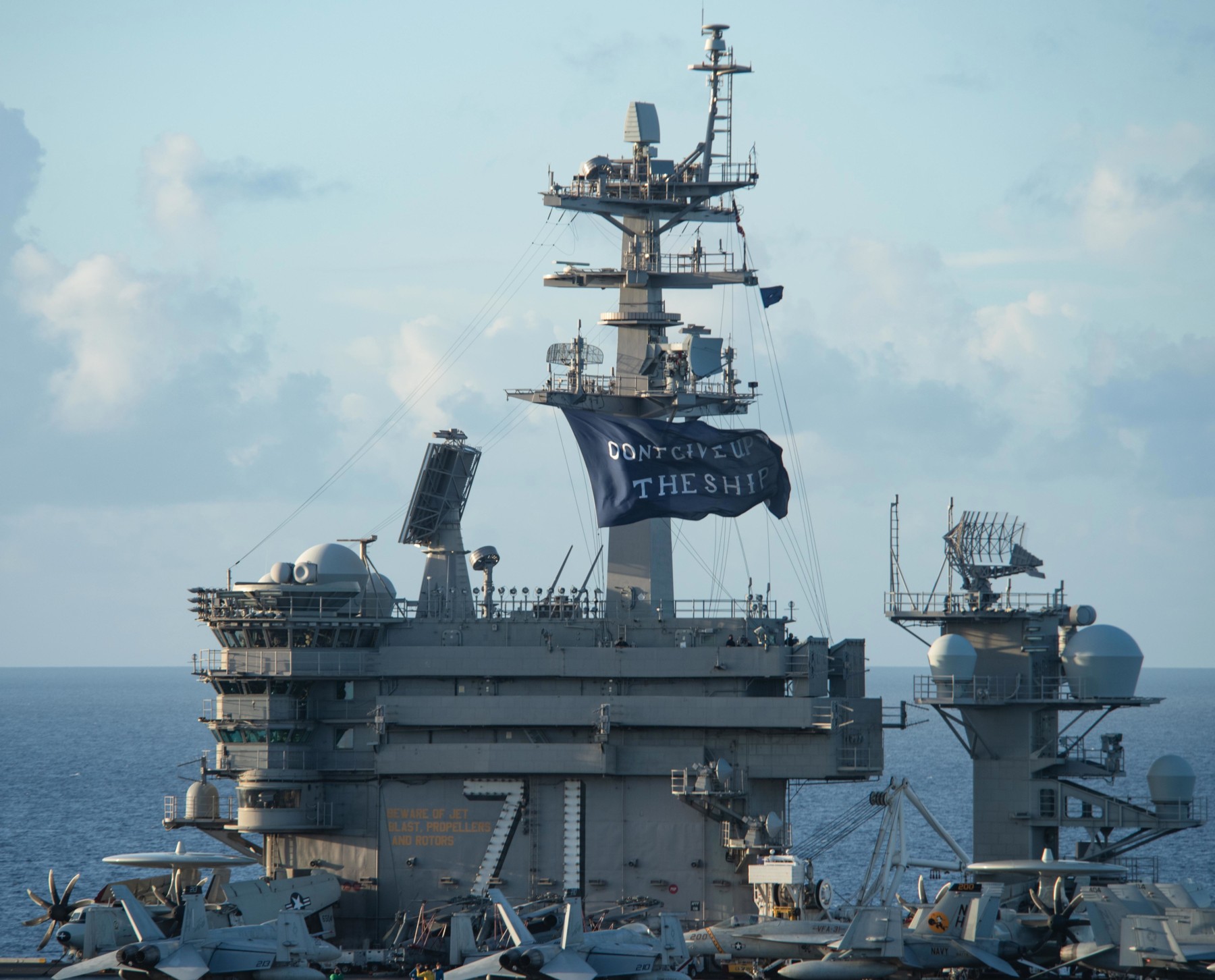 with CVW-11 embarked - Philippine Sea - June 2020 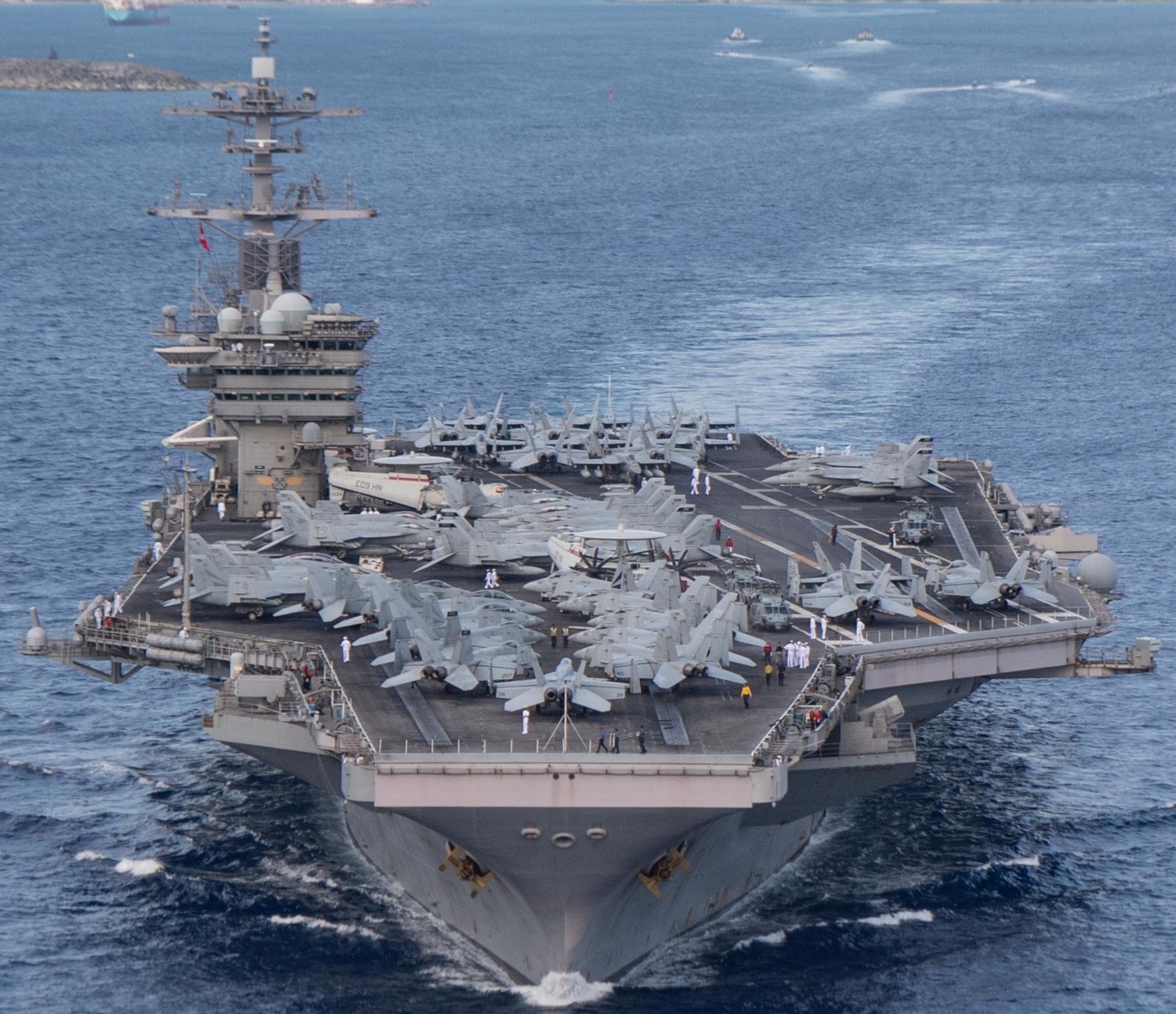 with CVW-11 embarked - departing Apra Harbor, Guam - June 2020 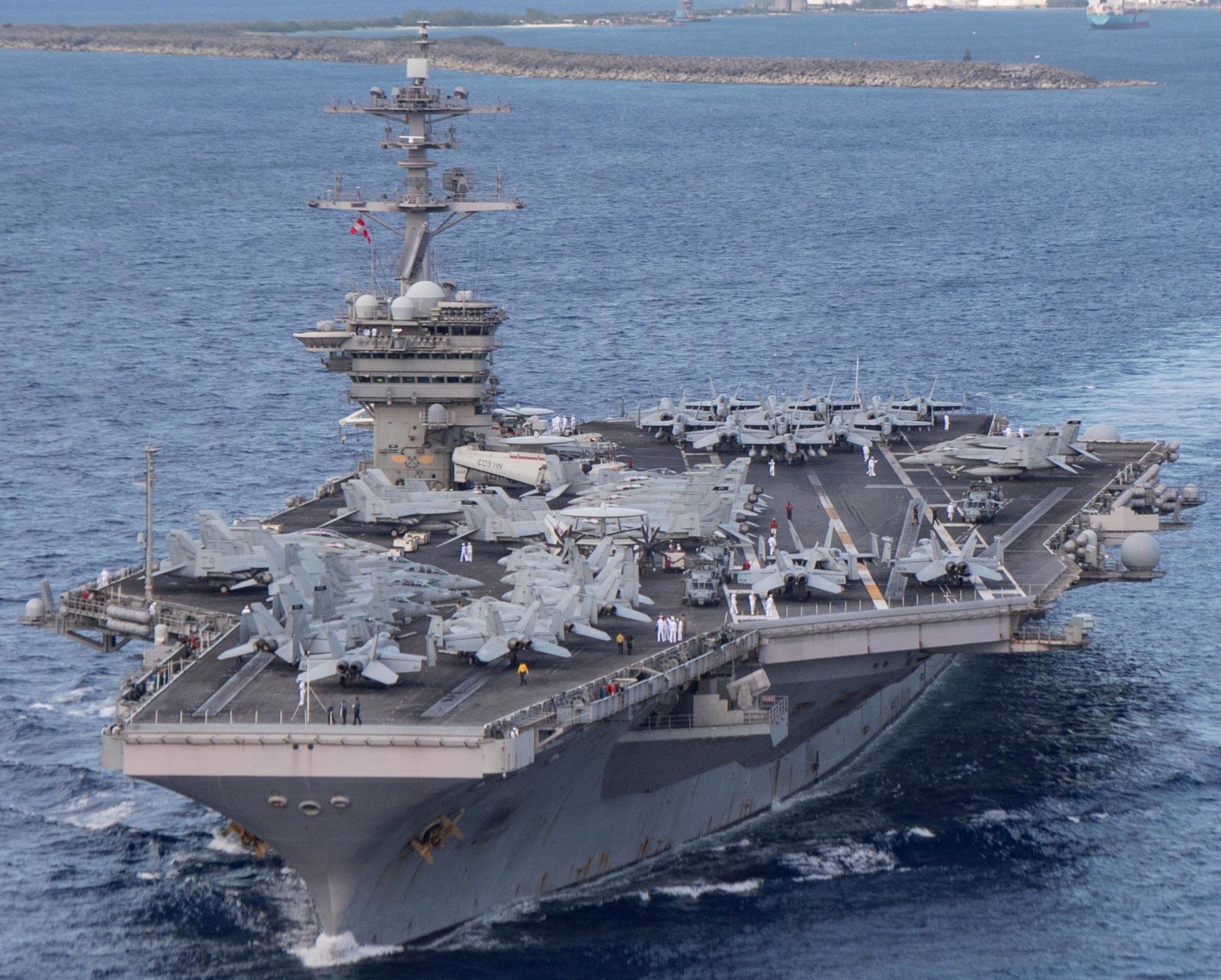 with CVW-11 embarked - departing Apra Harbor, Guam - June 2020 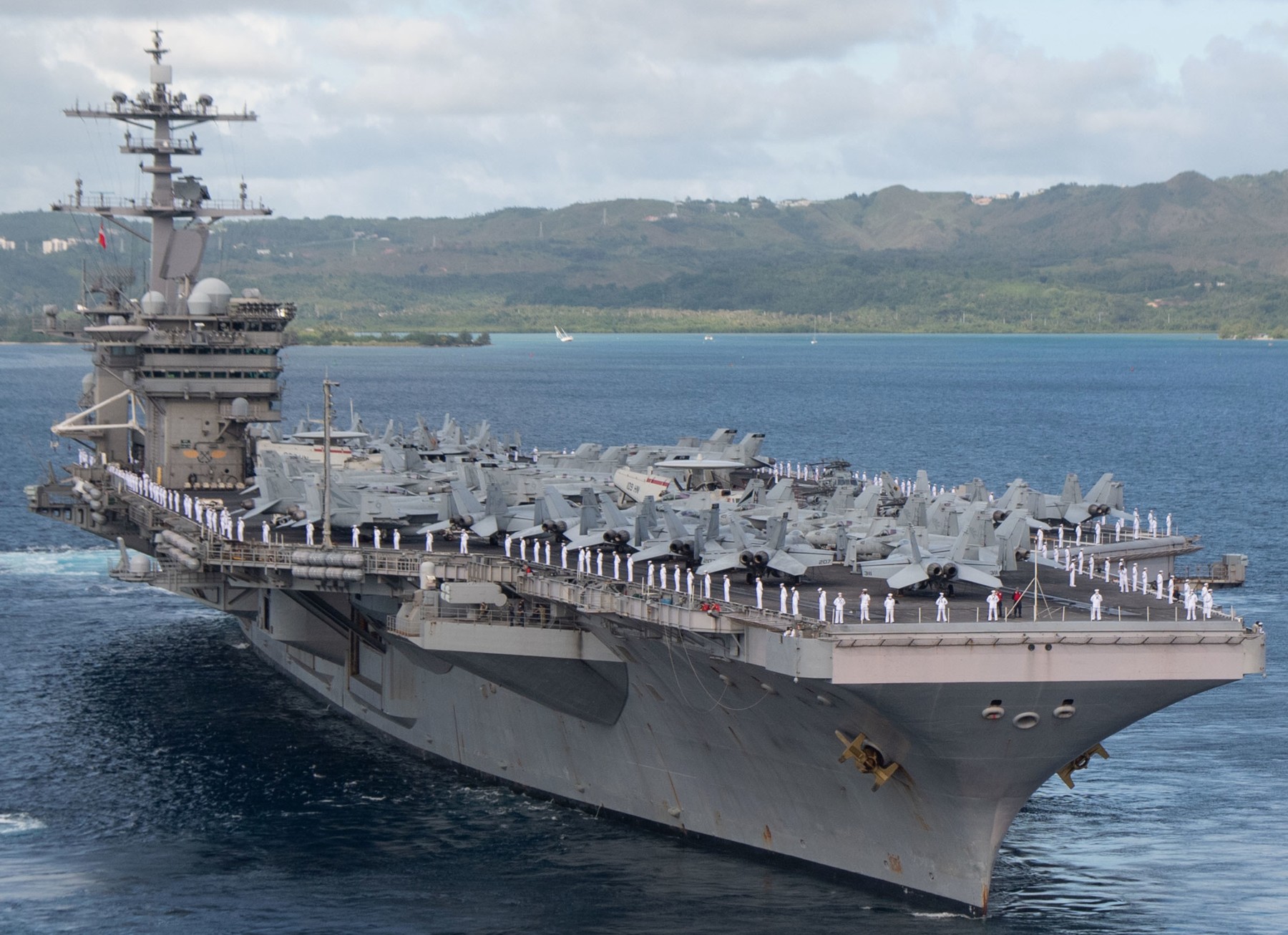 with CVW-11 embarked - departing Apra Harbor, Guam - June 2020 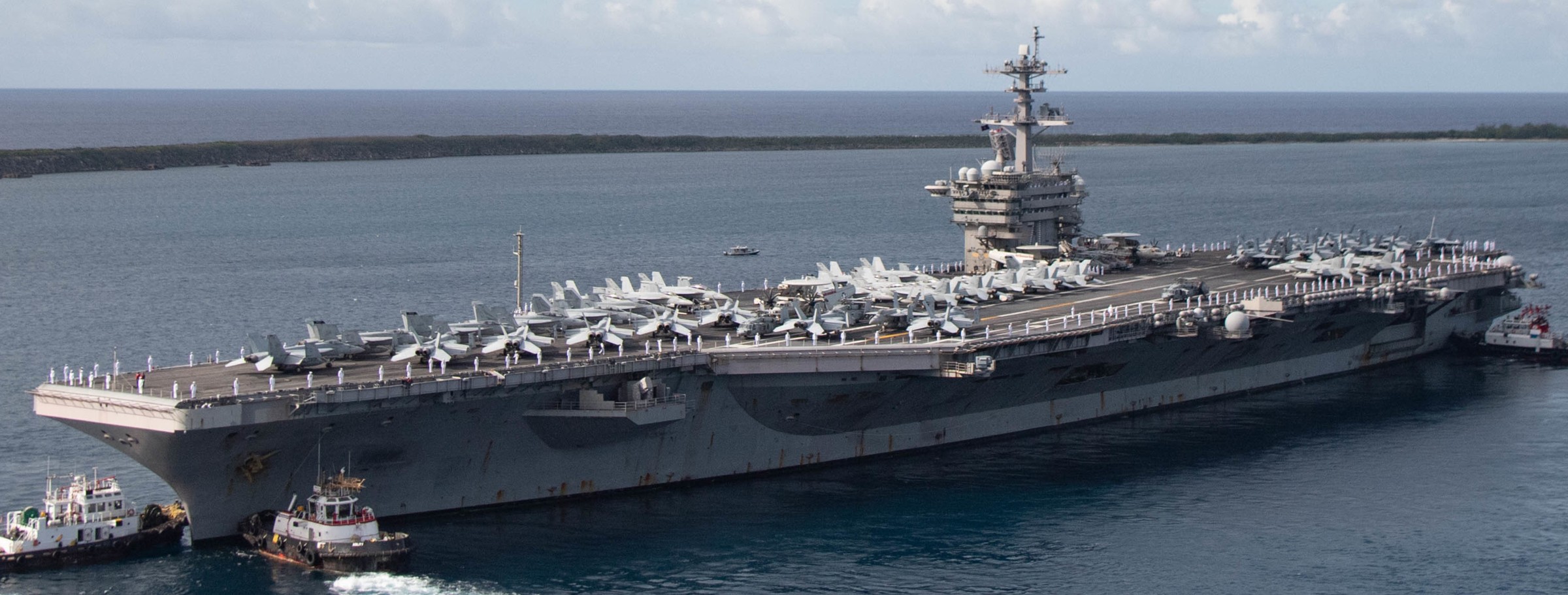 with CVW-11 embarked - departing Apra Harbor, Guam - June 2020 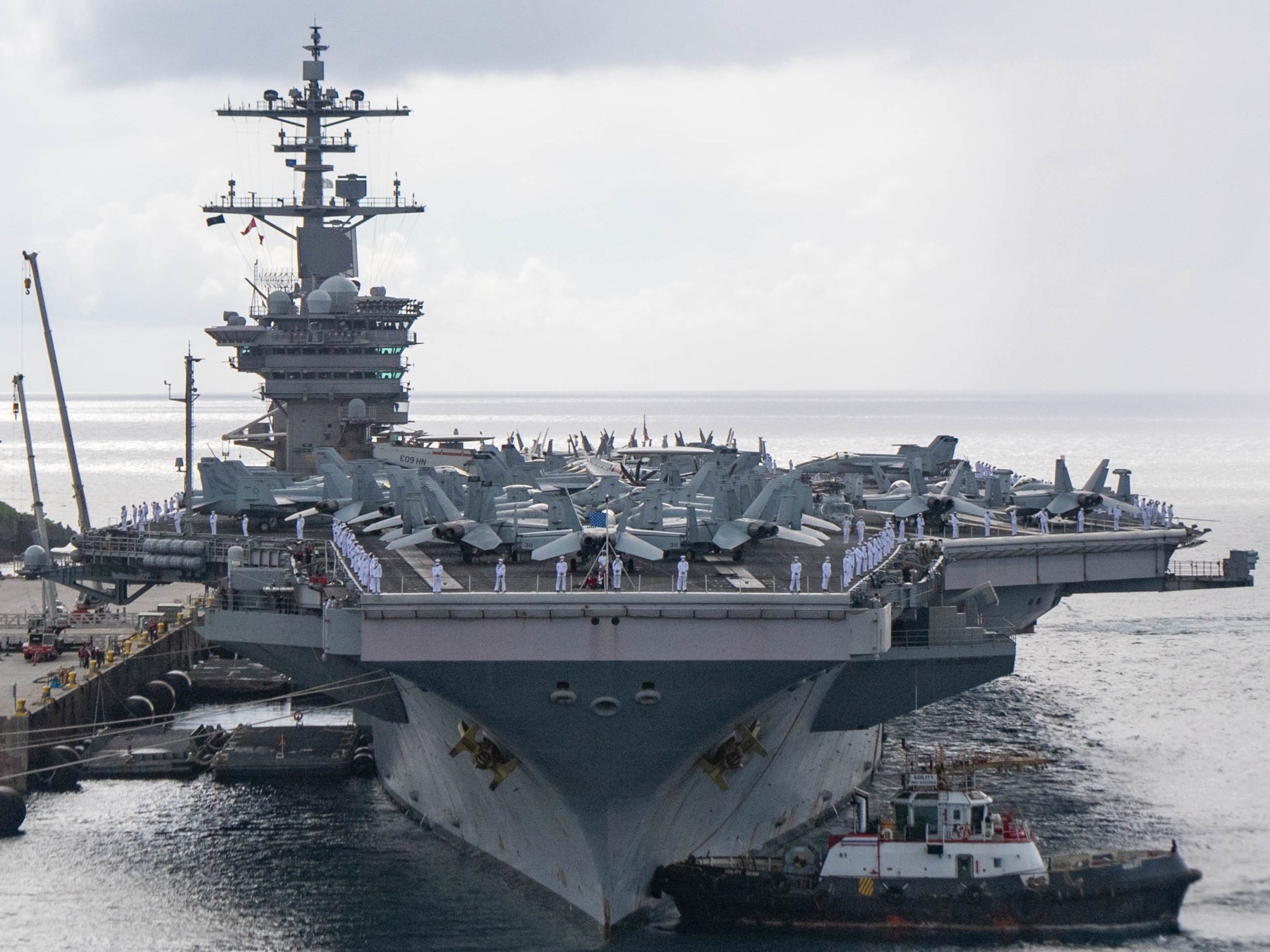 with CVW-11 embarked - departing Apra Harbor, Guam - June 2020 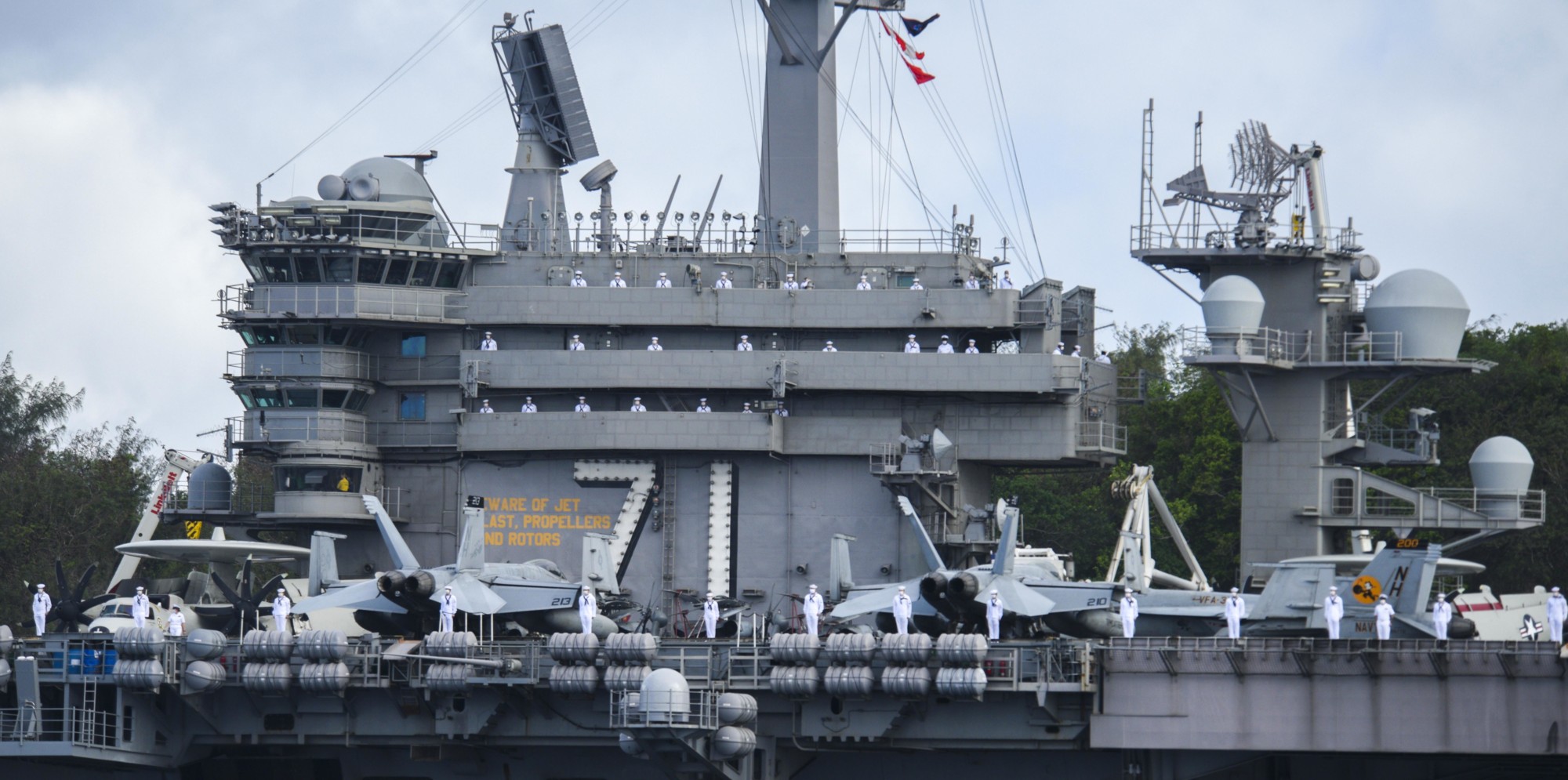 with CVW-11 embarked - departing Apra Harbor, Guam - June 2020 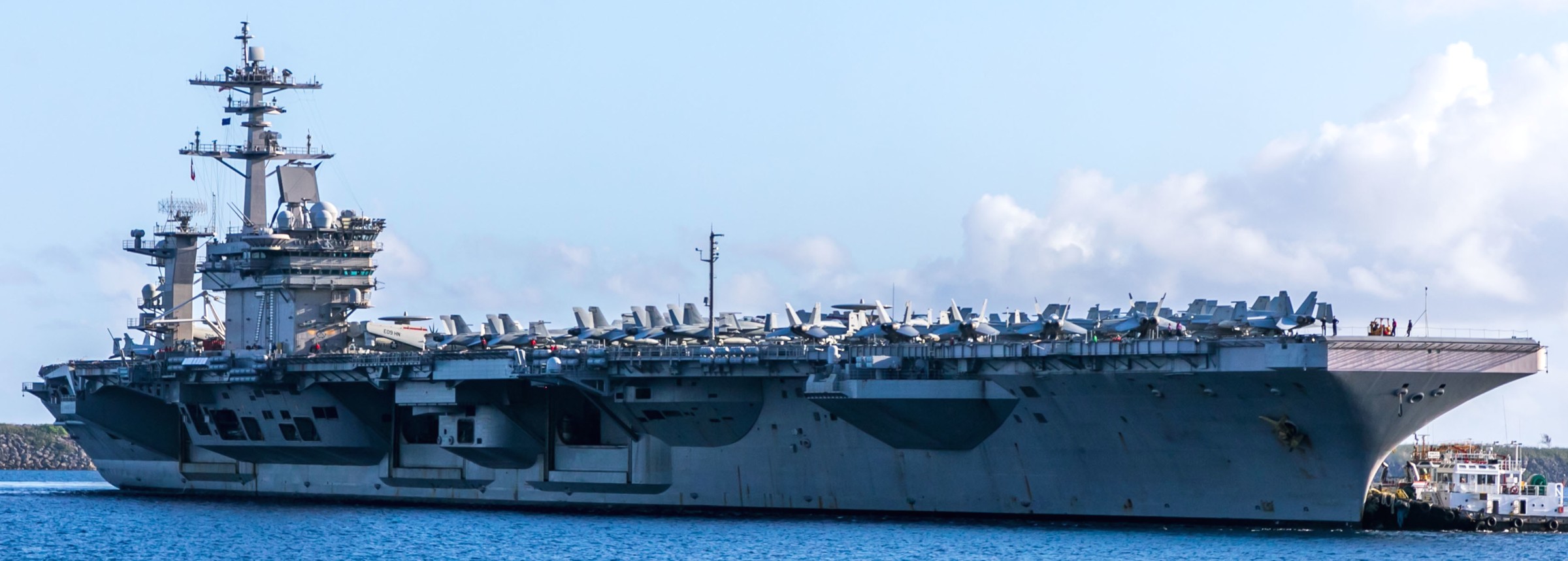 with CVW-11 embarked - Apra Harbor, Guam - June 2020 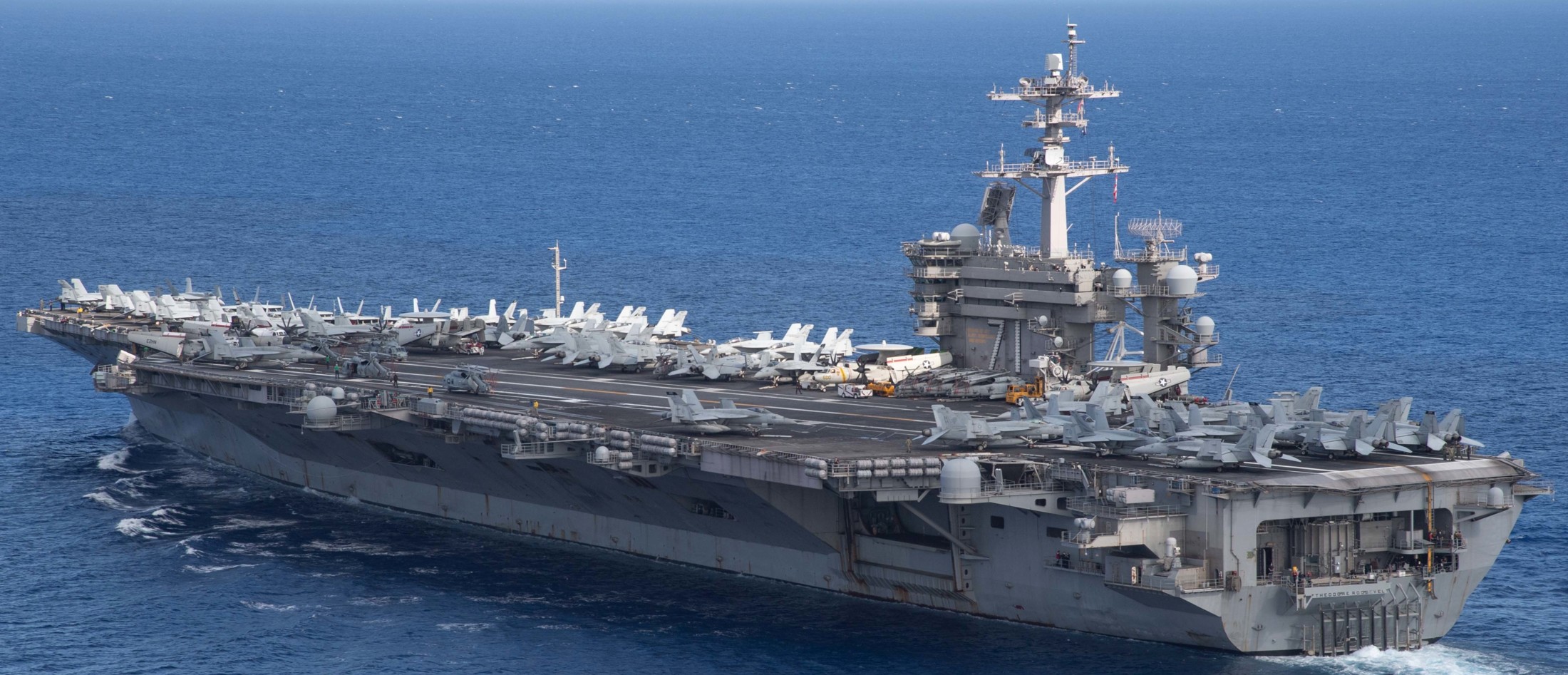 with CVW-11 embarked - Apra Harbor, Guam - May 2020 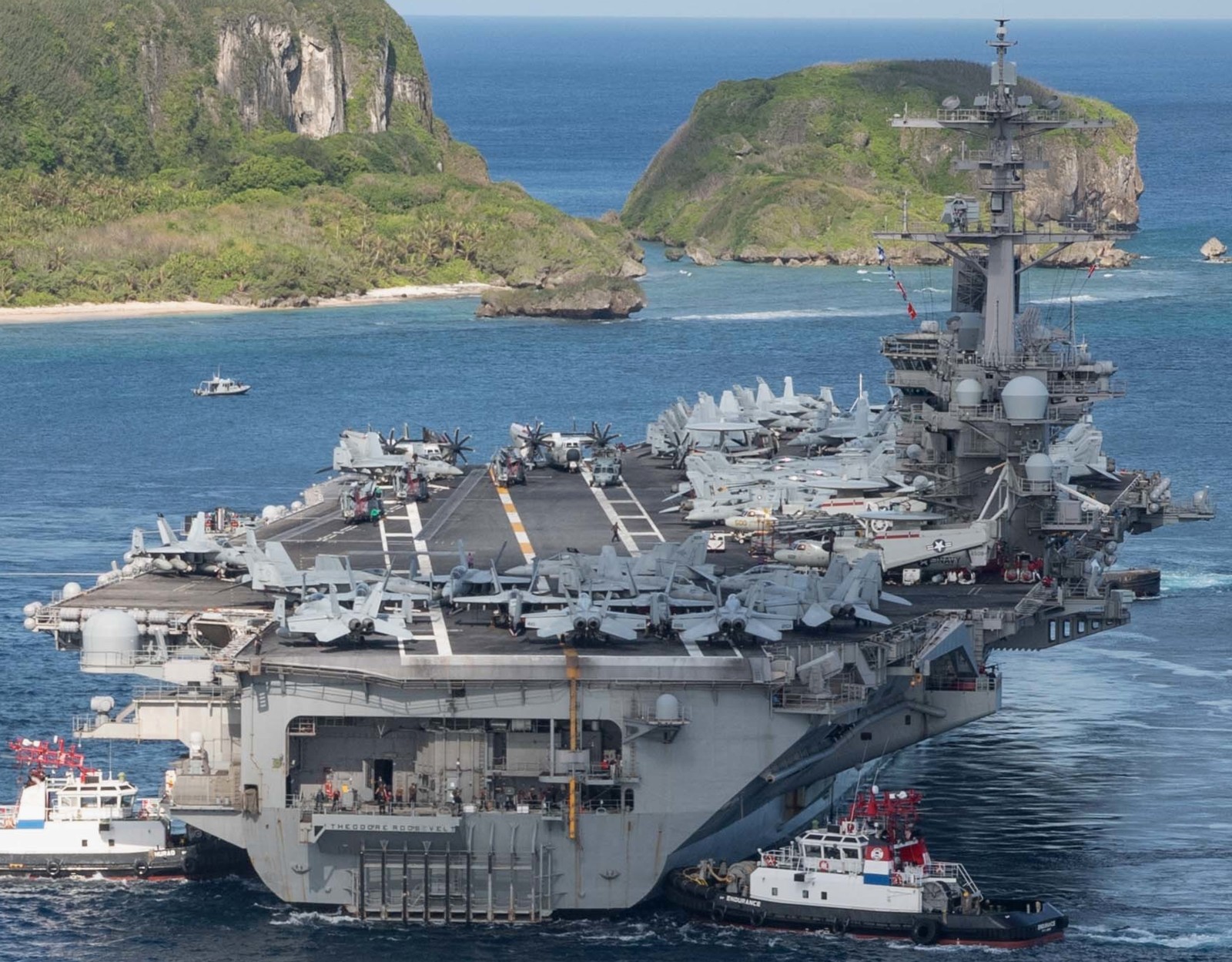 with CVW-11 embarked - Apra Harbor, Guam - May 2020 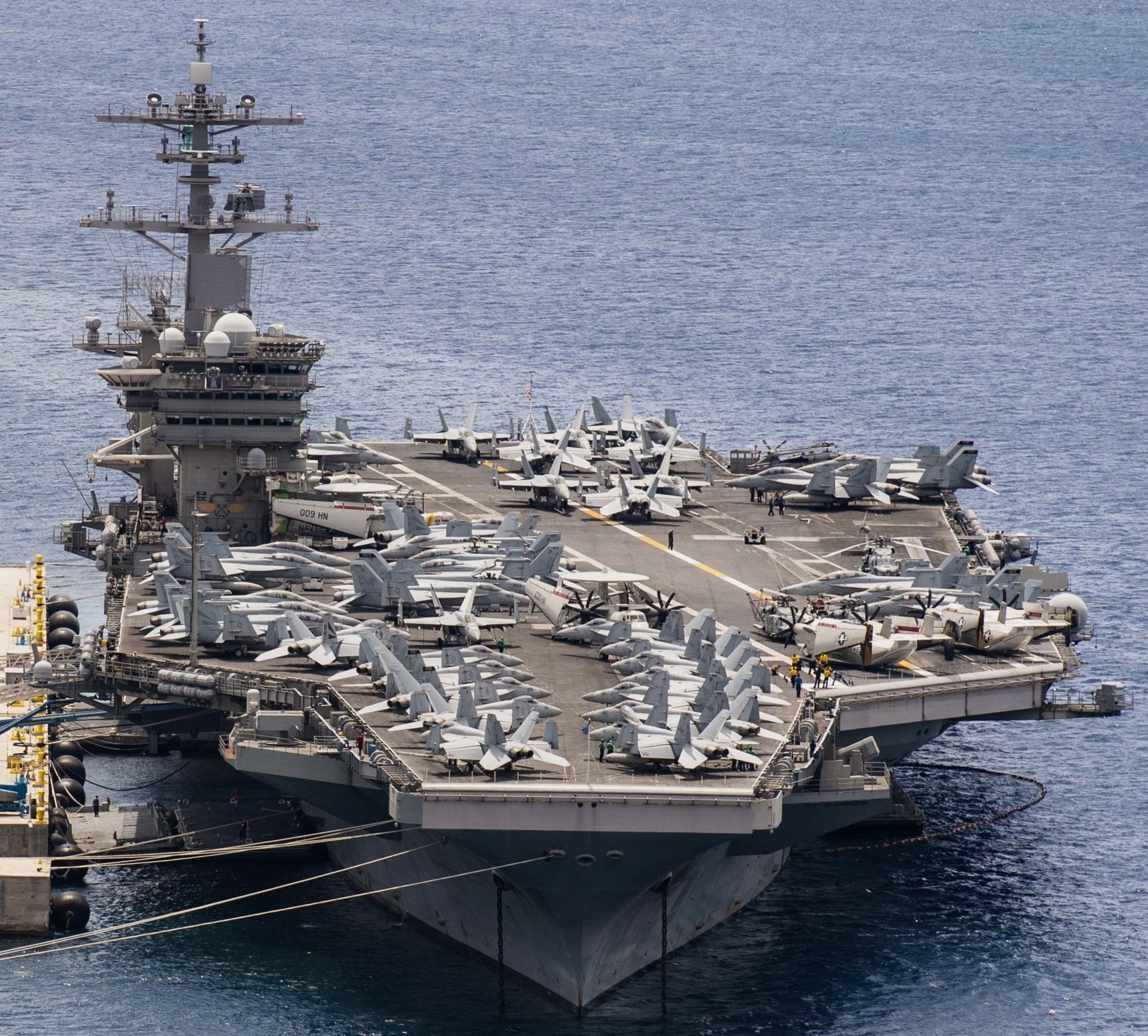 with CVW-11 embarked - Apra Harbor, Guam - May 2020 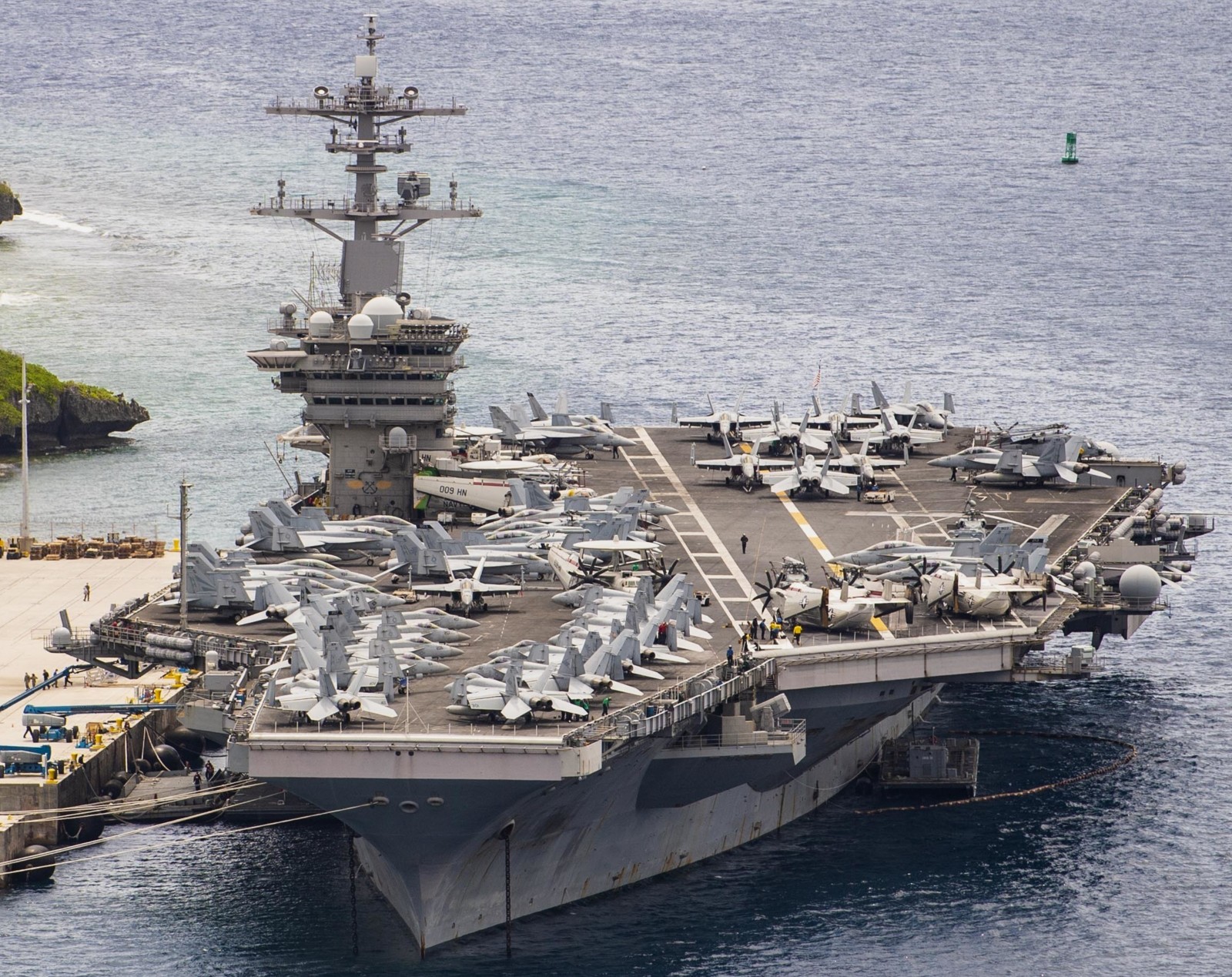 with CVW-11 embarked - Apra Harbor, Guam - May 2020  with CVW-11 embarked - Apra Harbor, Guam - May 2020 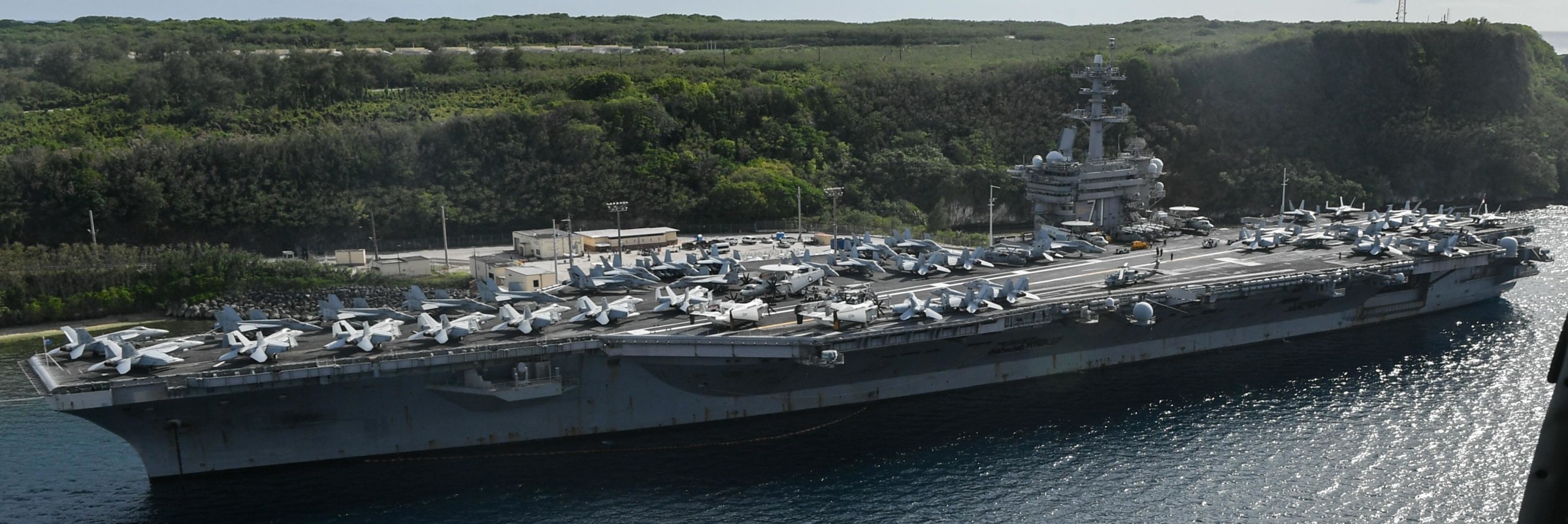 with CVW-11 embarked - Apra Harbor, Guam - May 2020  with CVW-11 embarked - Philippine Sea - March 2020 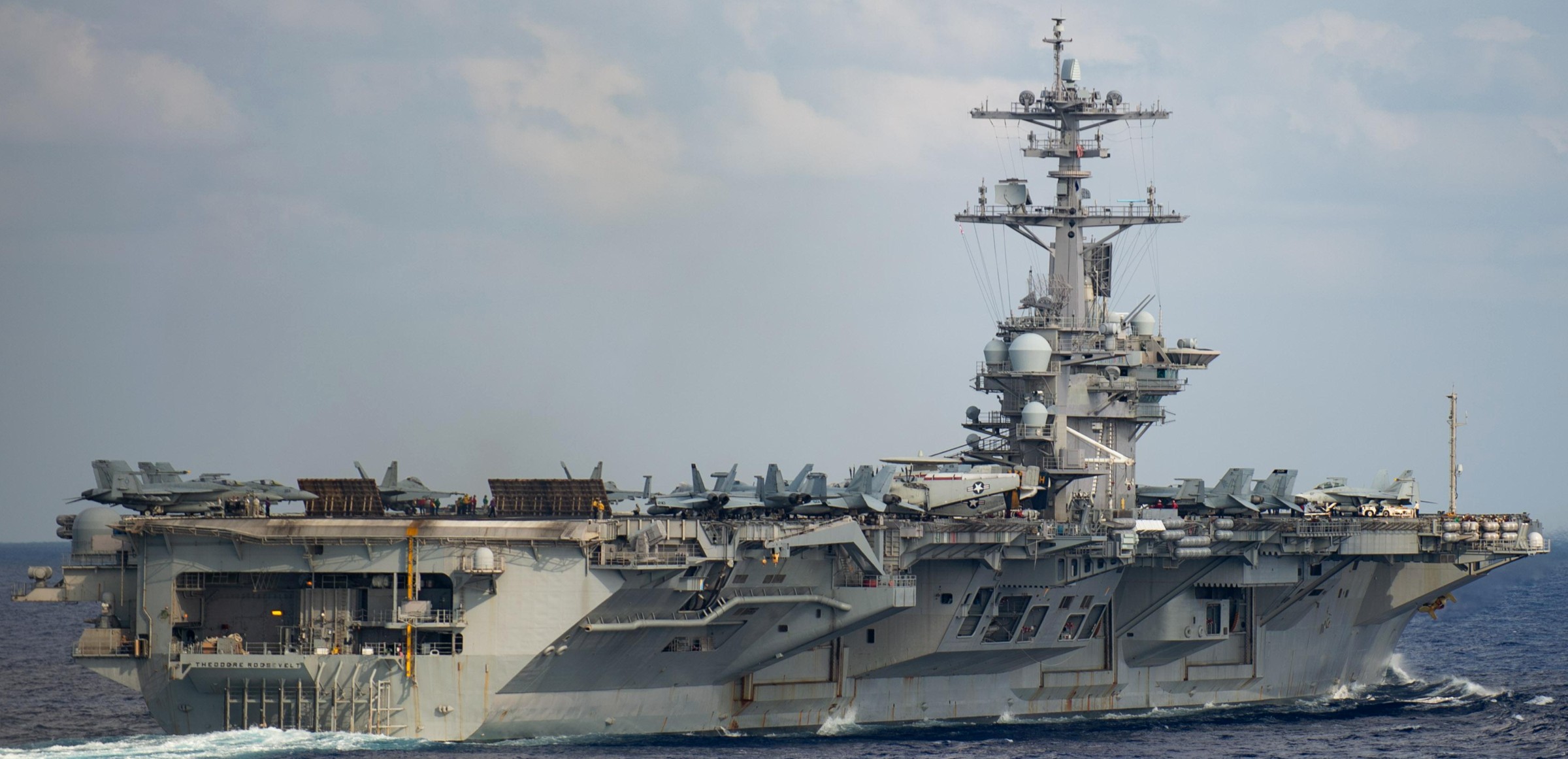 with CVW-11 embarked - Philippine Sea - March 2020 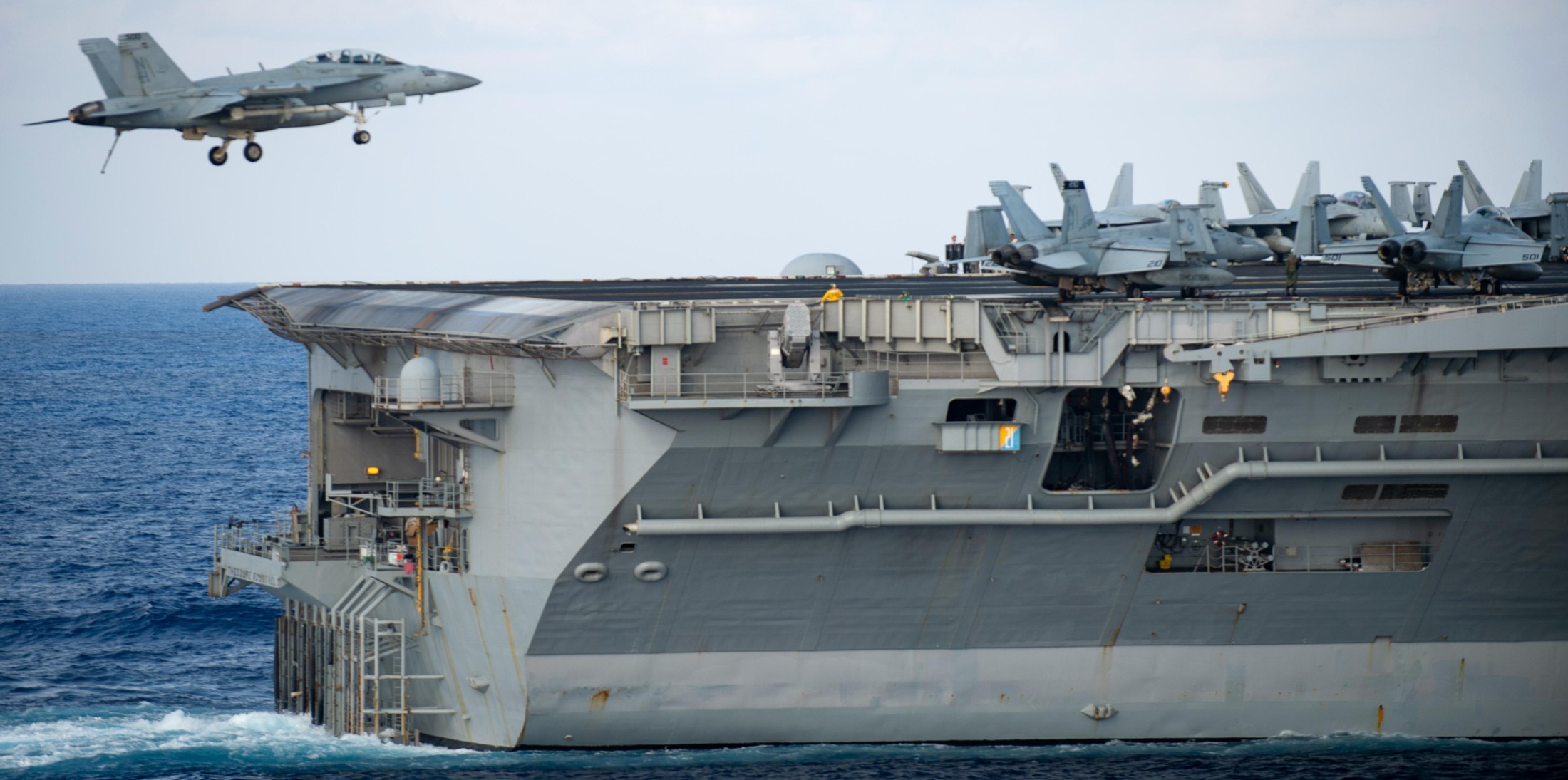 with CVW-11 embarked - Philippine Sea - March 2020 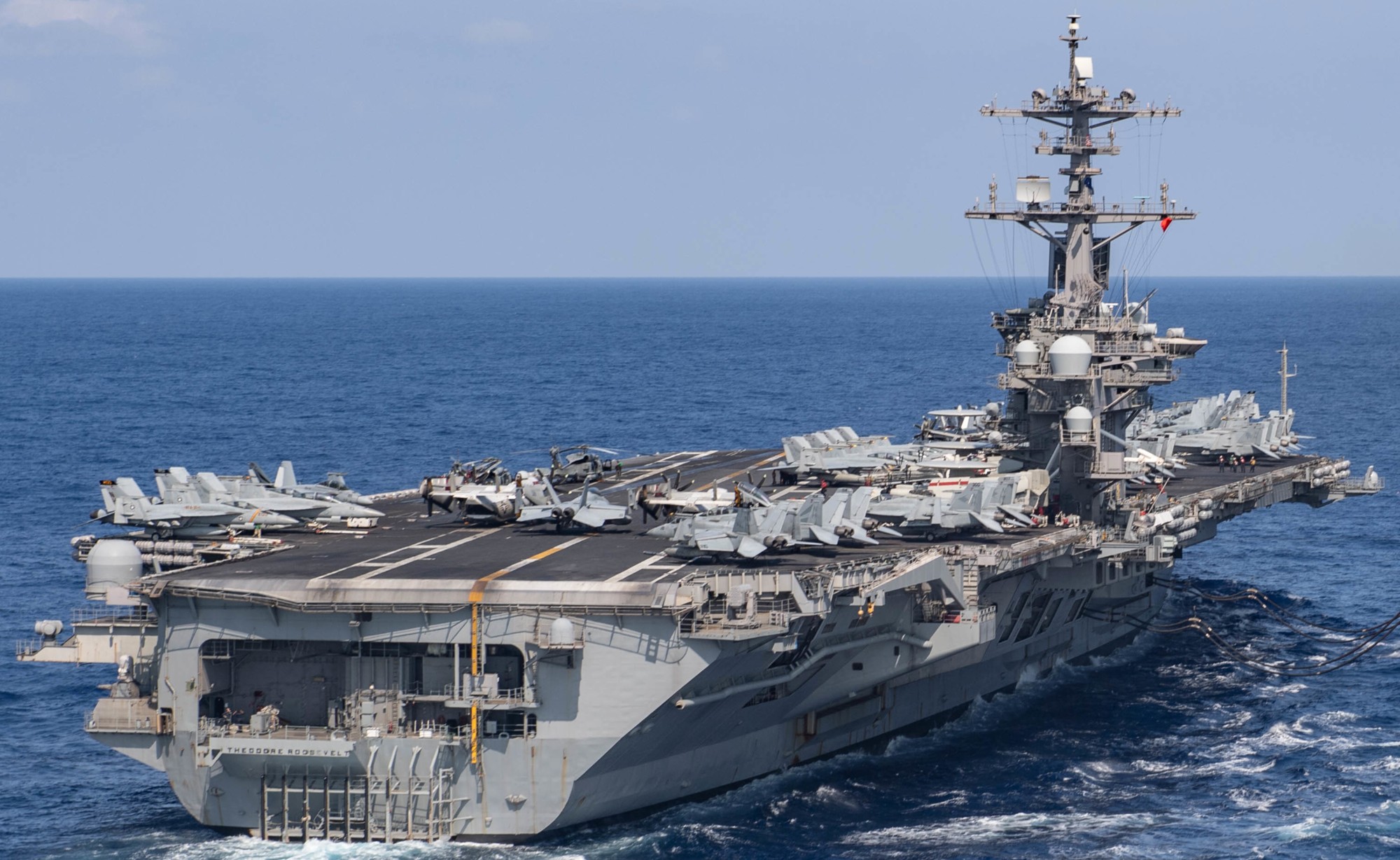 with CVW-11 embarked - South China Sea - March 2020 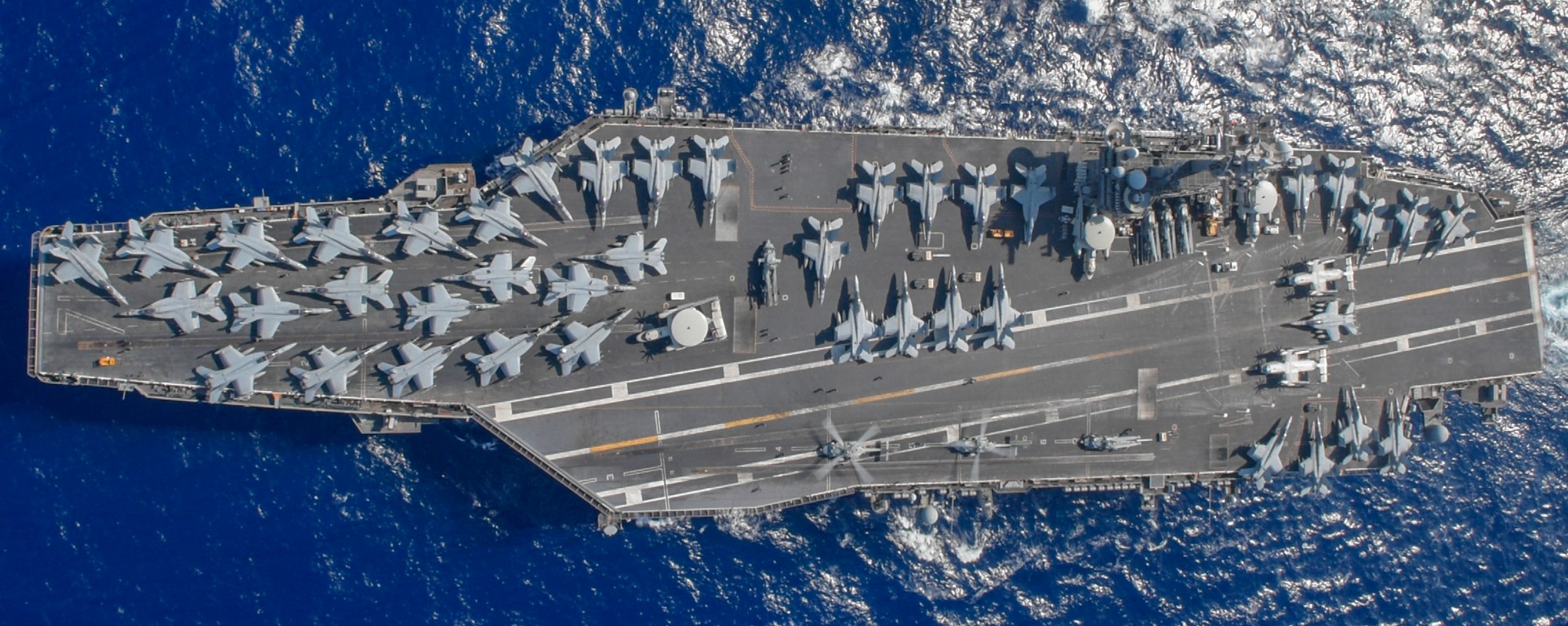 with CVW-11 embarked - South China Sea - March 2020 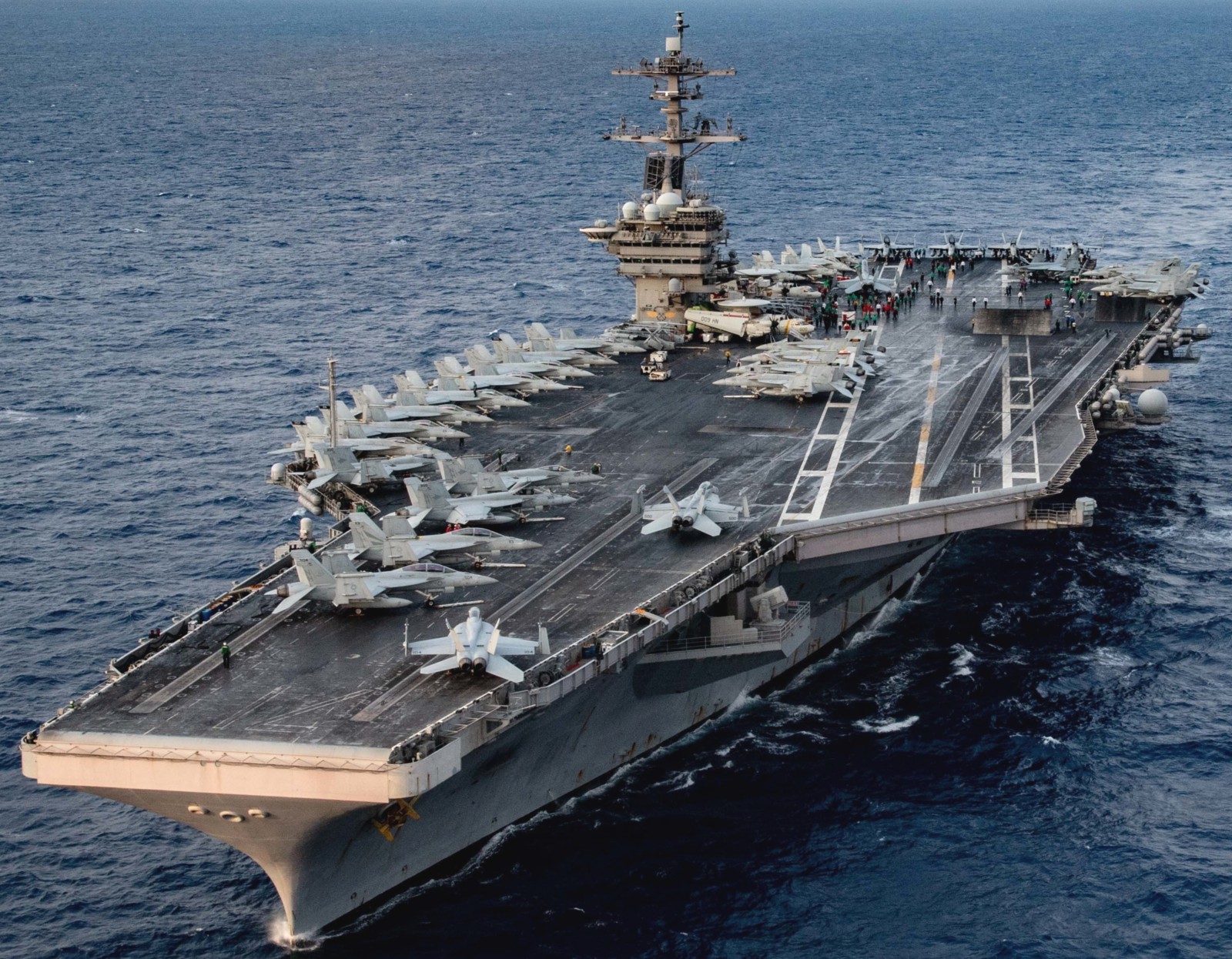 with CVW-11 embarked - South China Sea - March 2020 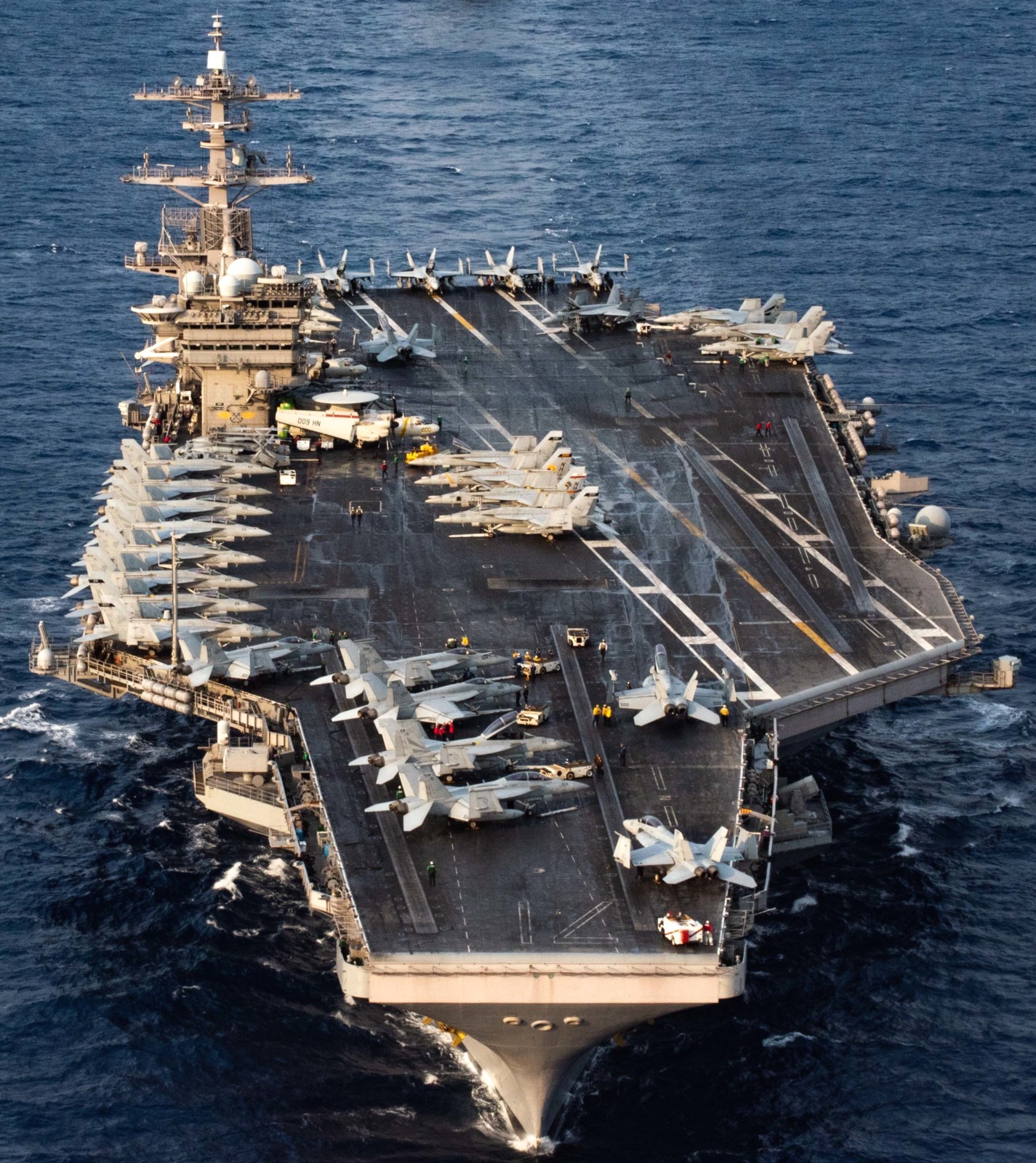 with CVW-11 embarked - South China Sea - March 2020  with CVW-11 embarked - Da Nang, Vietnam - March 2020 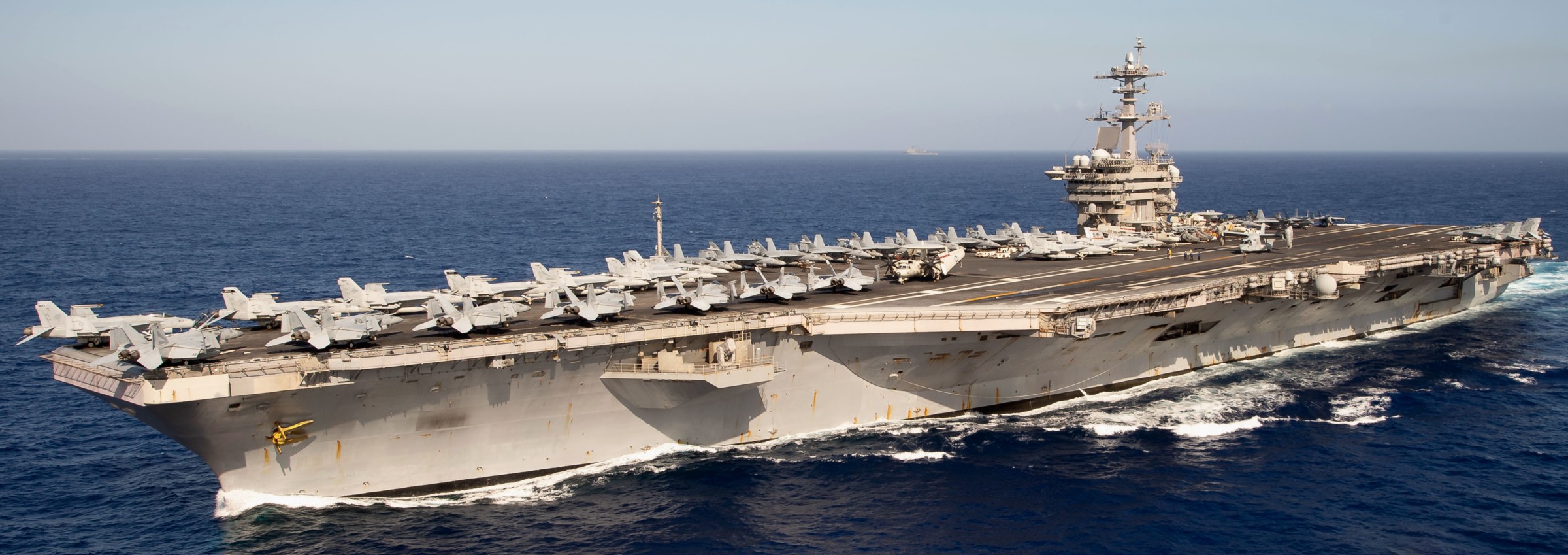 with CVW-11 embarked - Pacific Ocean - February 2020  with CVW-11 embarked - Pacific Ocean - February 2020  with CVW-11 embarked - arriving at Apra Harbor, Guam - February 2020 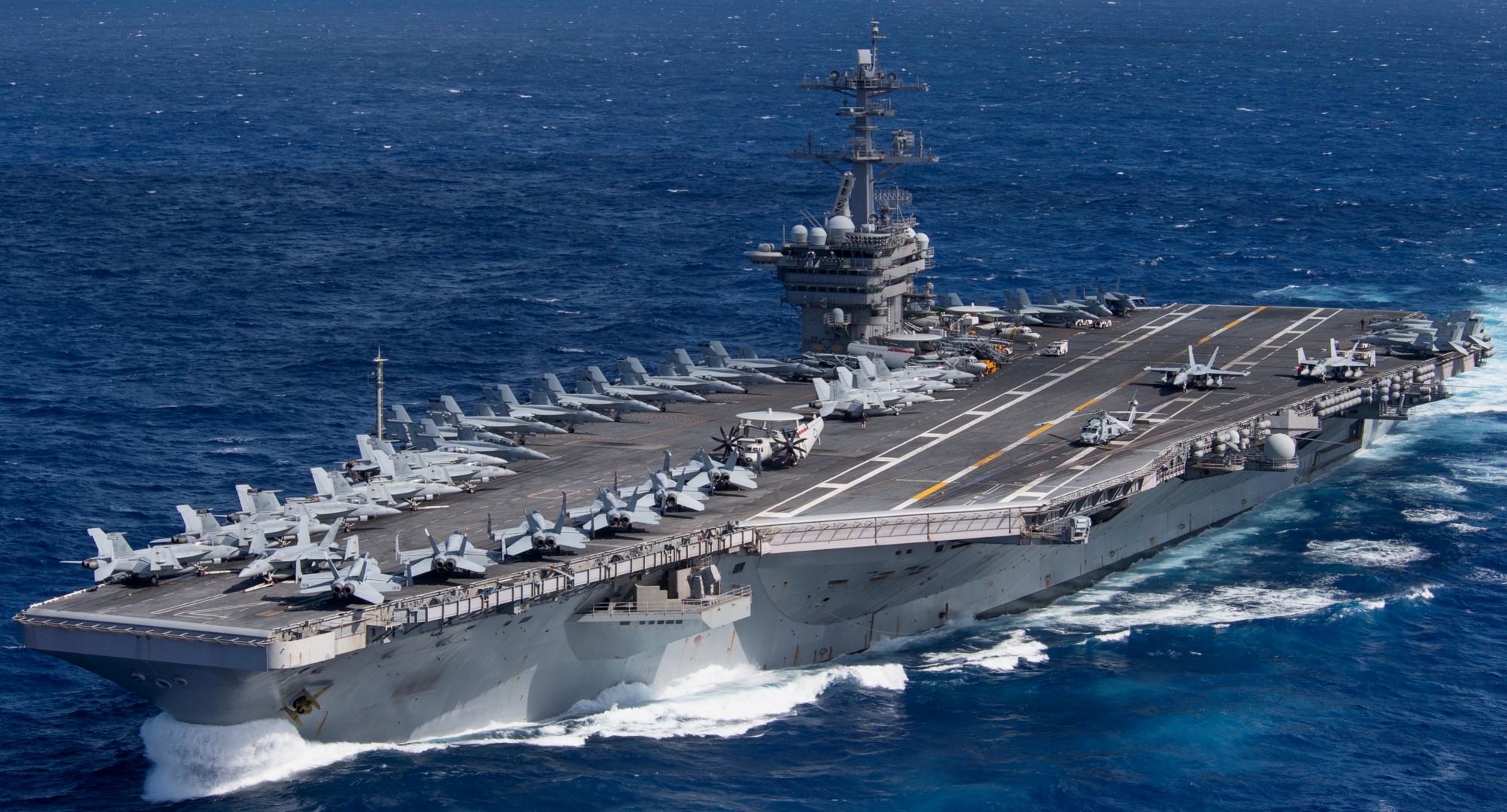 with CVW-11 embarked - Pacific Ocean - January 2020 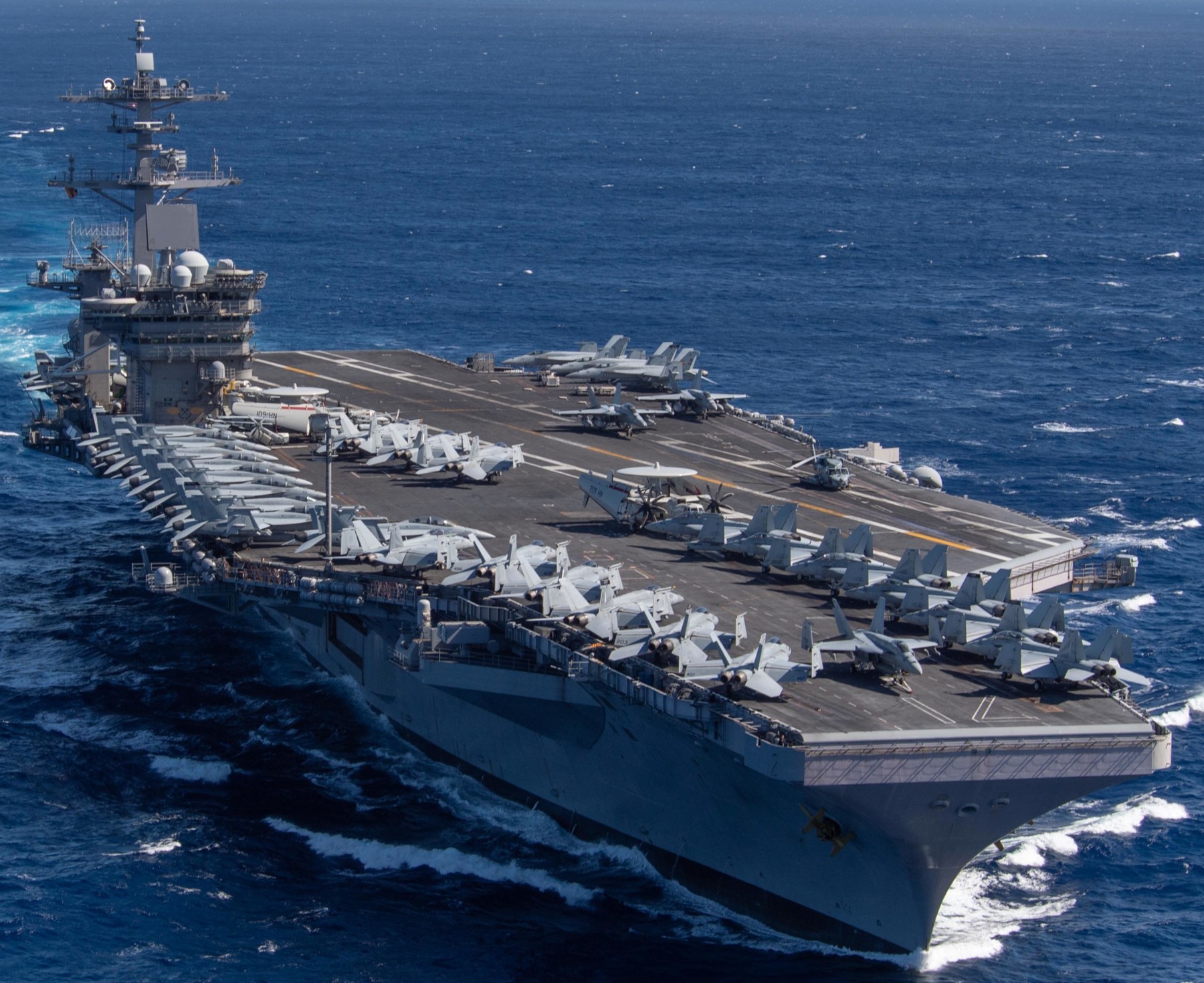 with CVW-11 embarked - Pacific Ocean - January 2020 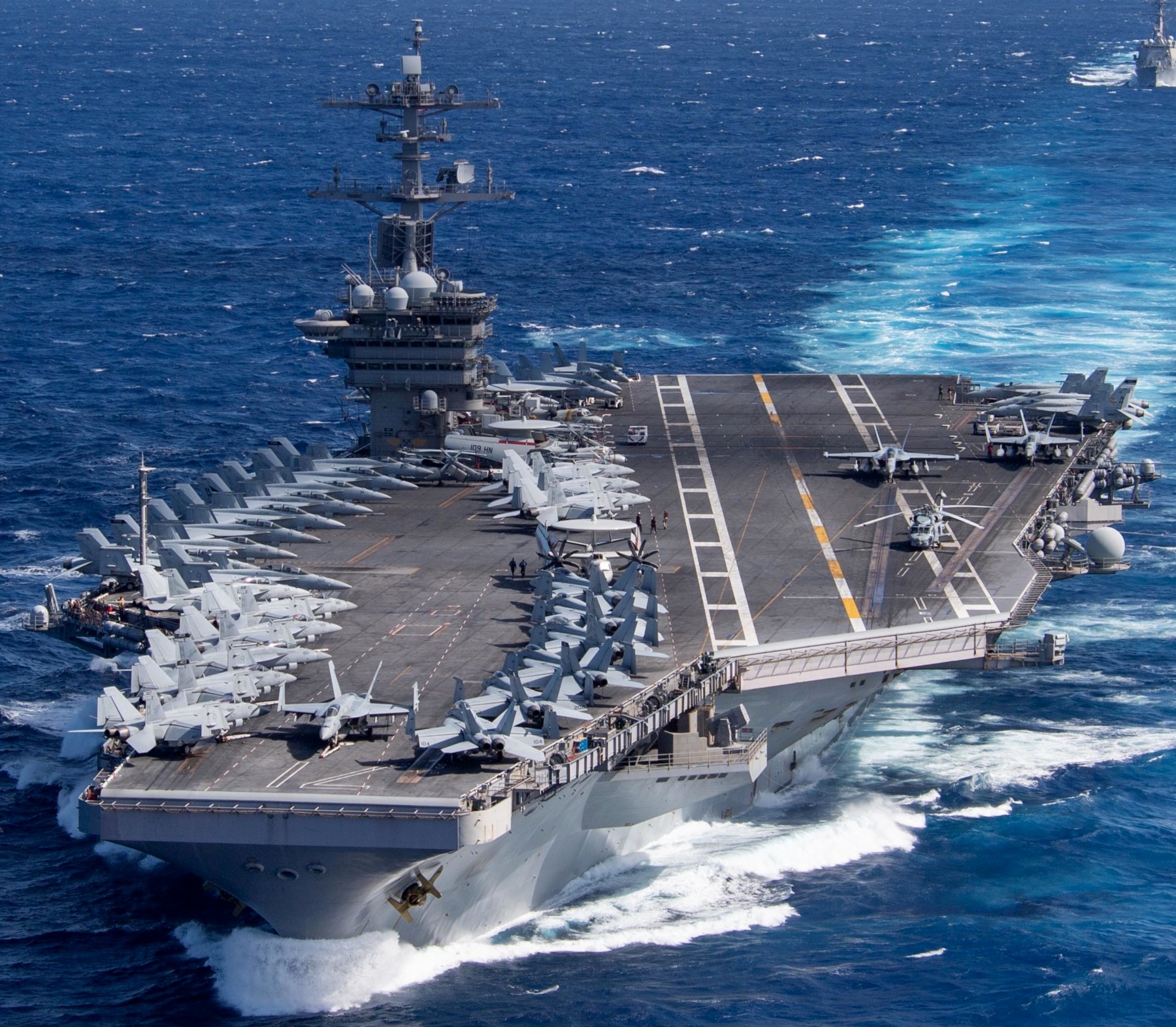 with CVW-11 embarked - Pacific Ocean - January 2020 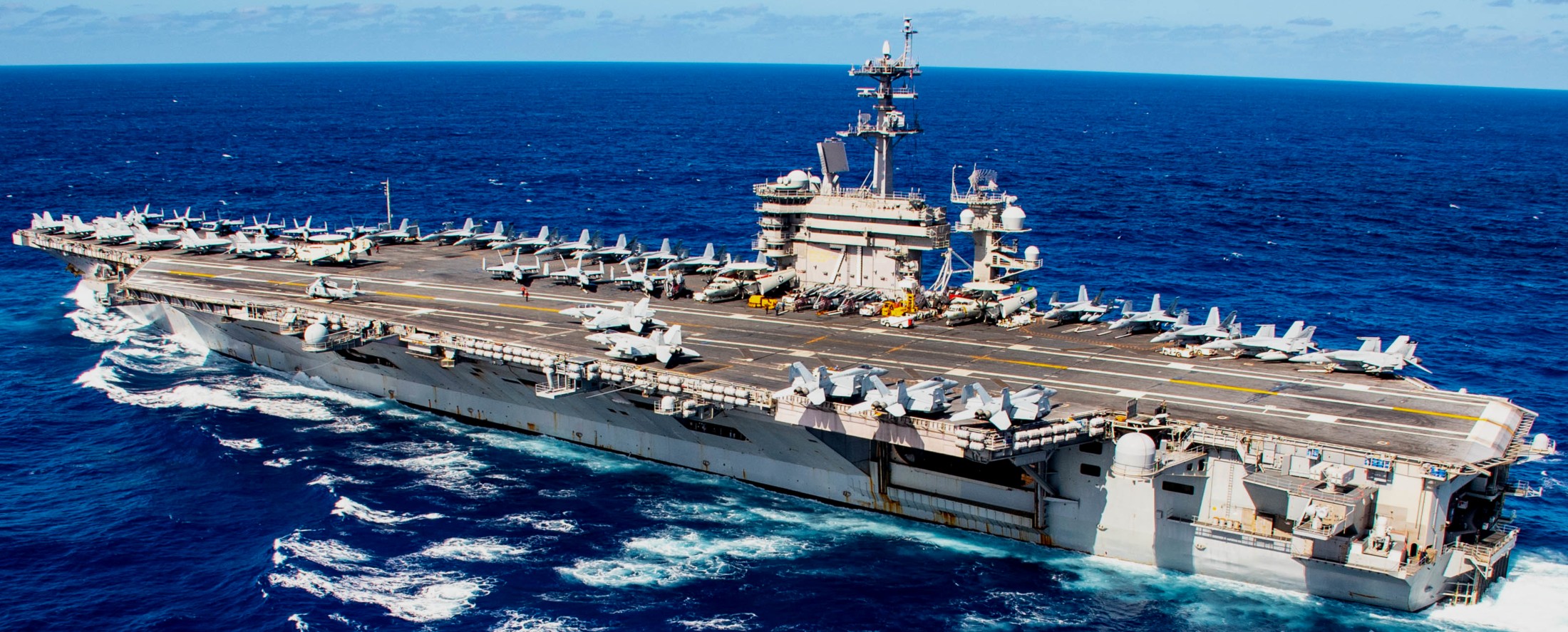 with CVW-11 embarked - Pacific Ocean - January 2020  with CVW-11 embarked - Pacific Ocean - January 2020  with CVW-11 embarked - Pacific Ocean - January 2020 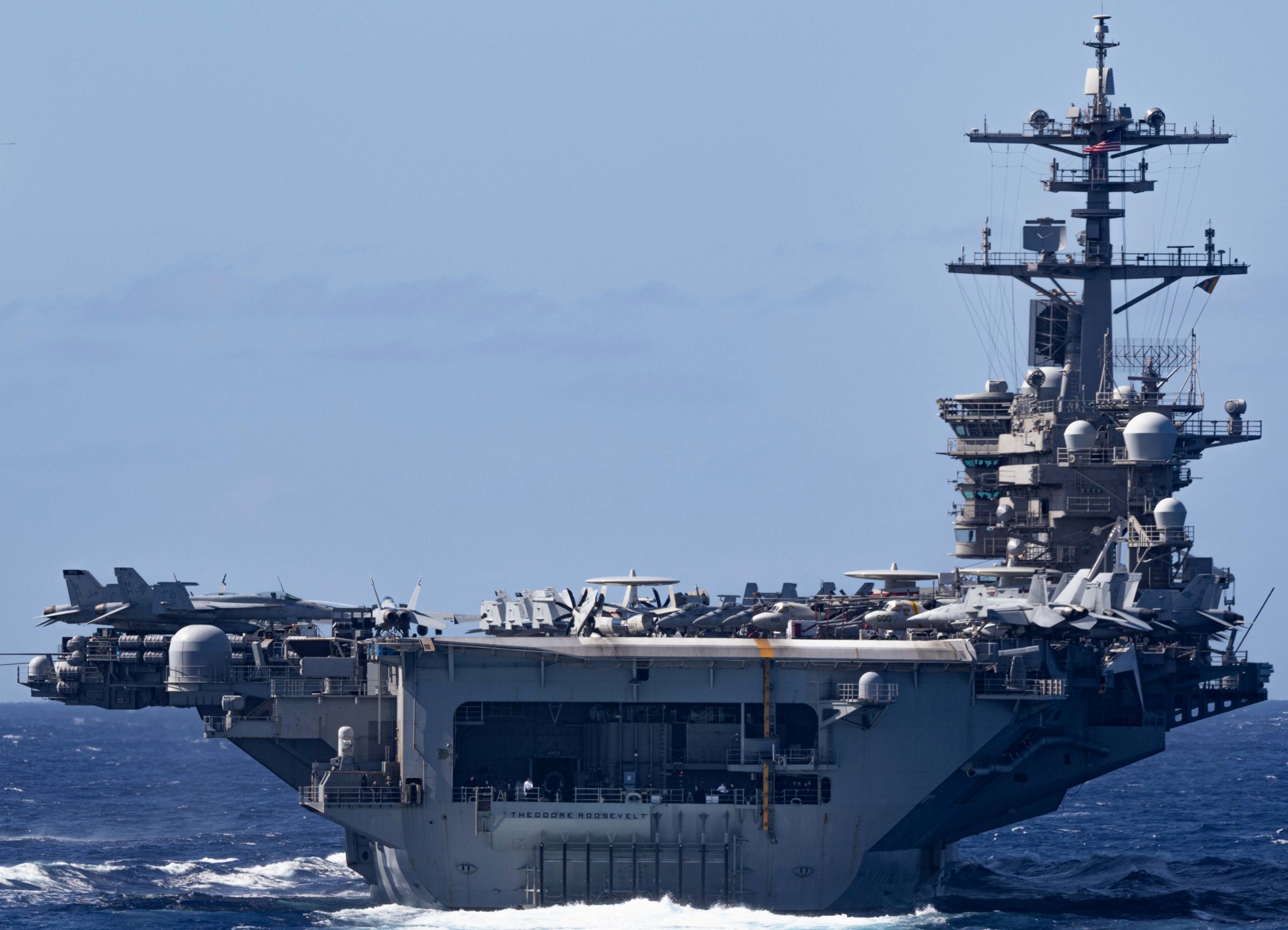 with CVW-11 embarked - Pacific Ocean - January 2020  departing San Diego, California - January 17, 2020 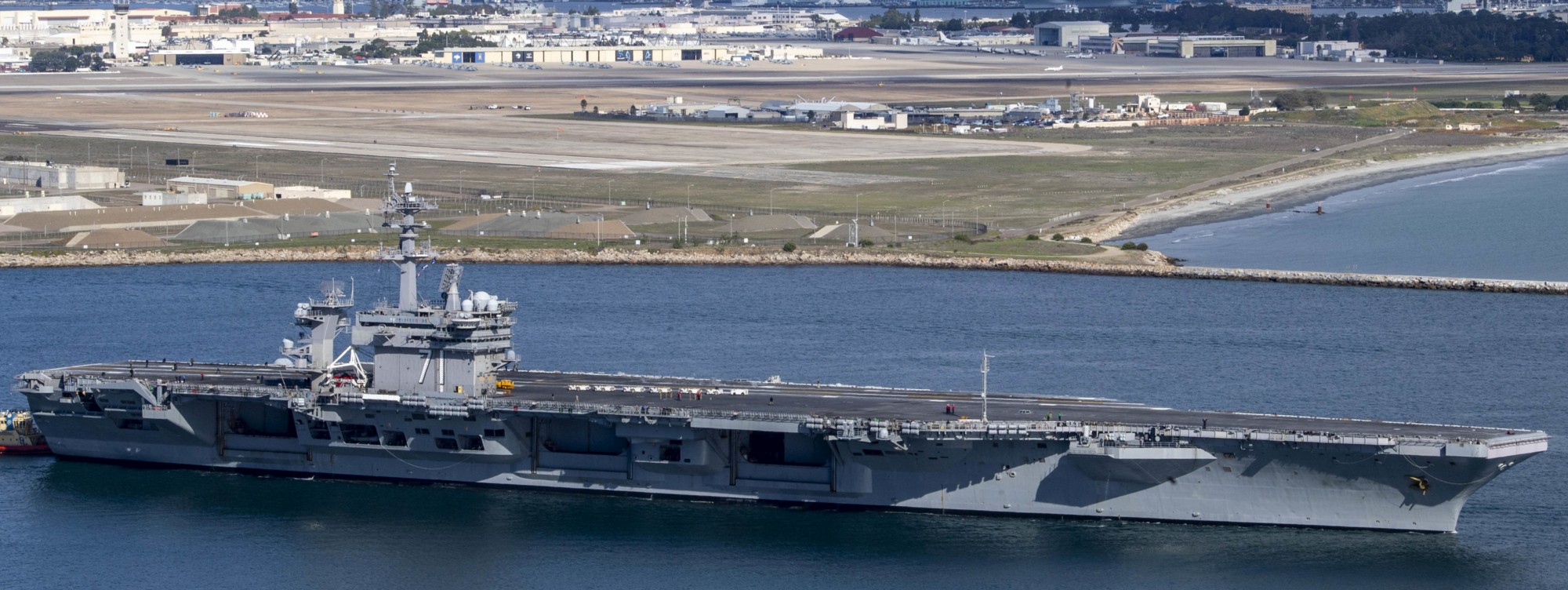 departing San Diego, California - January 17, 2020 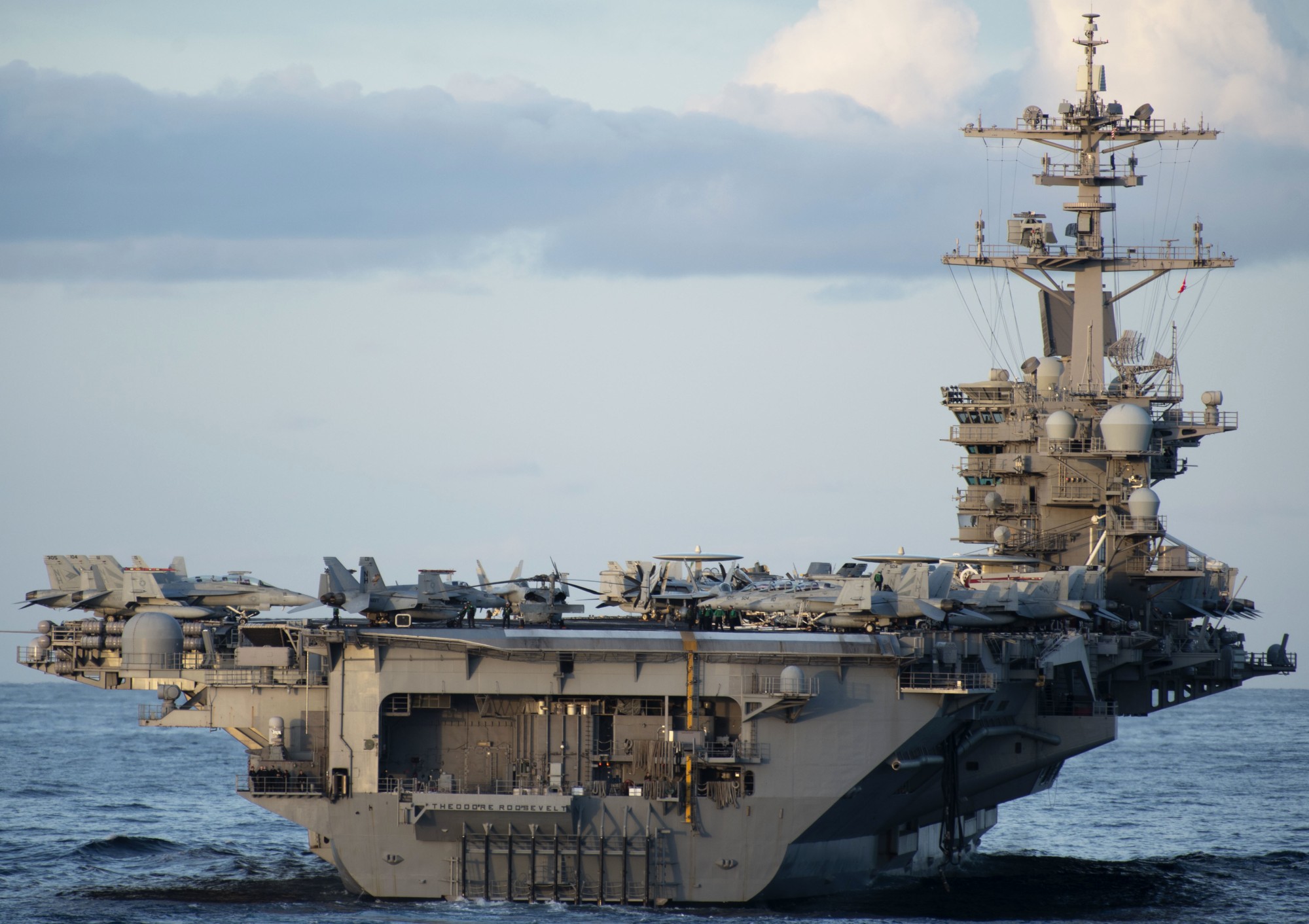 with CVW-11 embarked - Pacific Ocean - November 2019 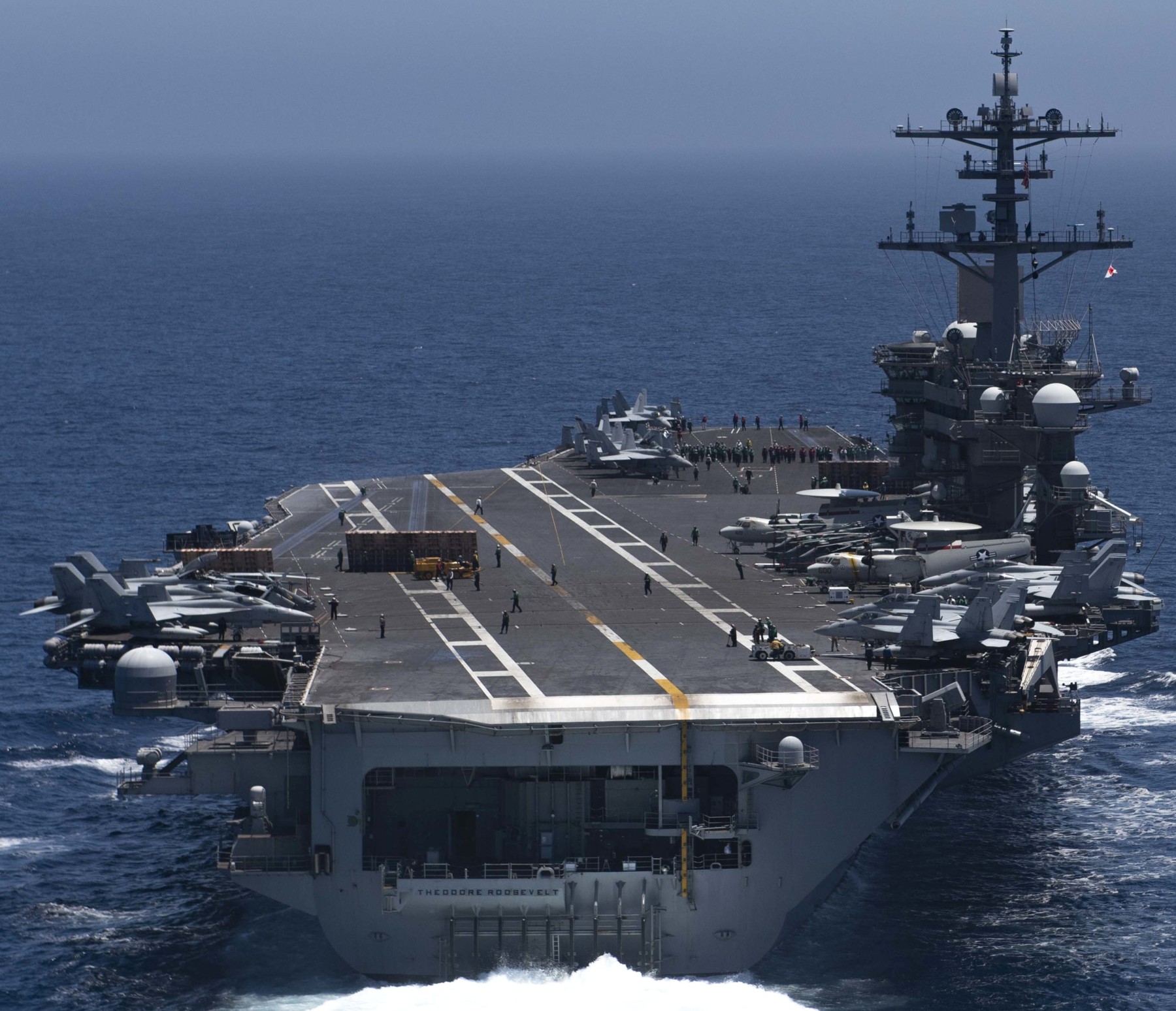 with CVW-11 embarked - Pacific Ocean - July 2019 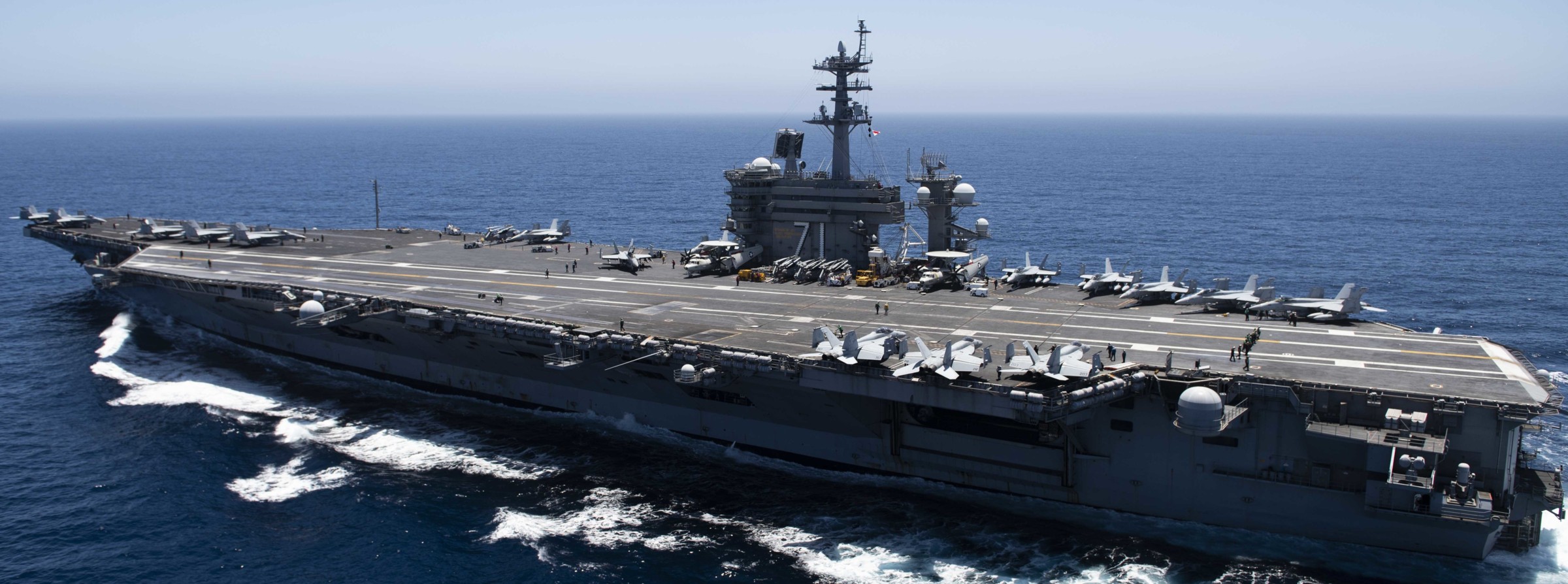 with CVW-11 embarked - Pacific Ocean - July 2019 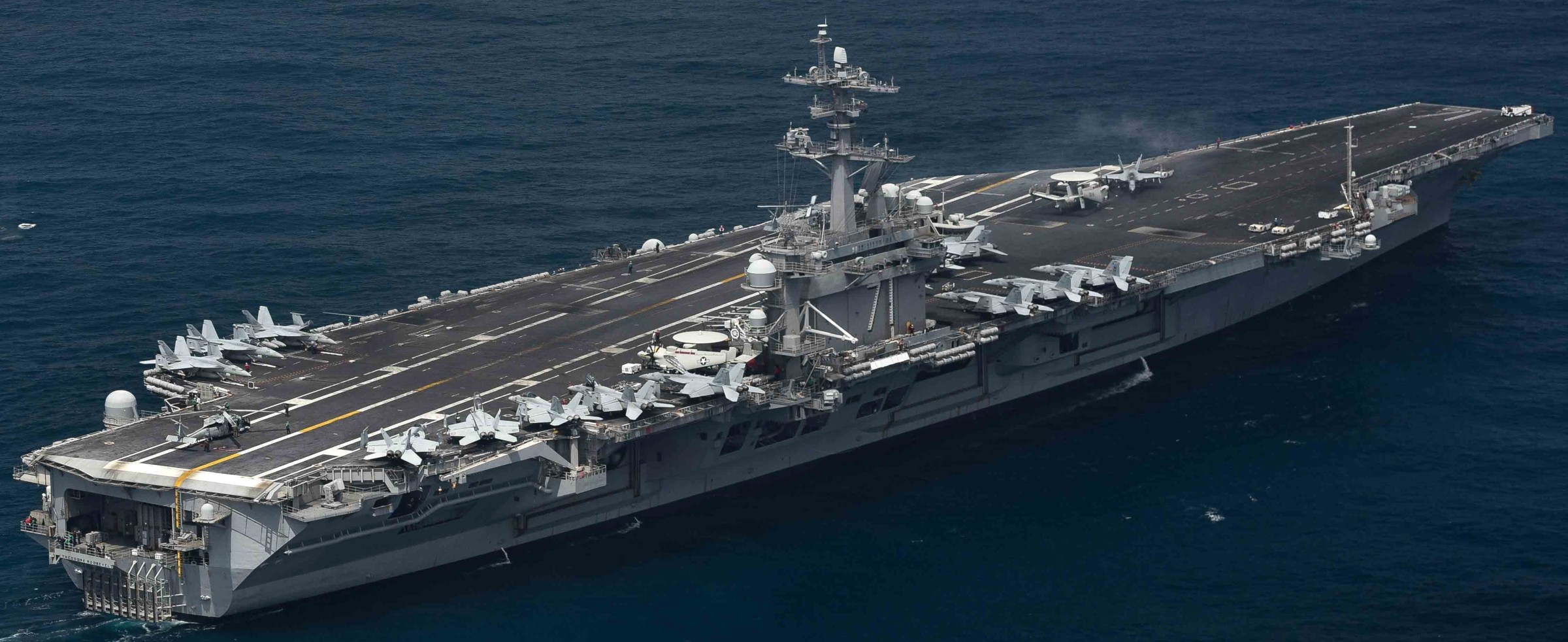 with CVW-11 embarked - Pacific Ocean - July 2019 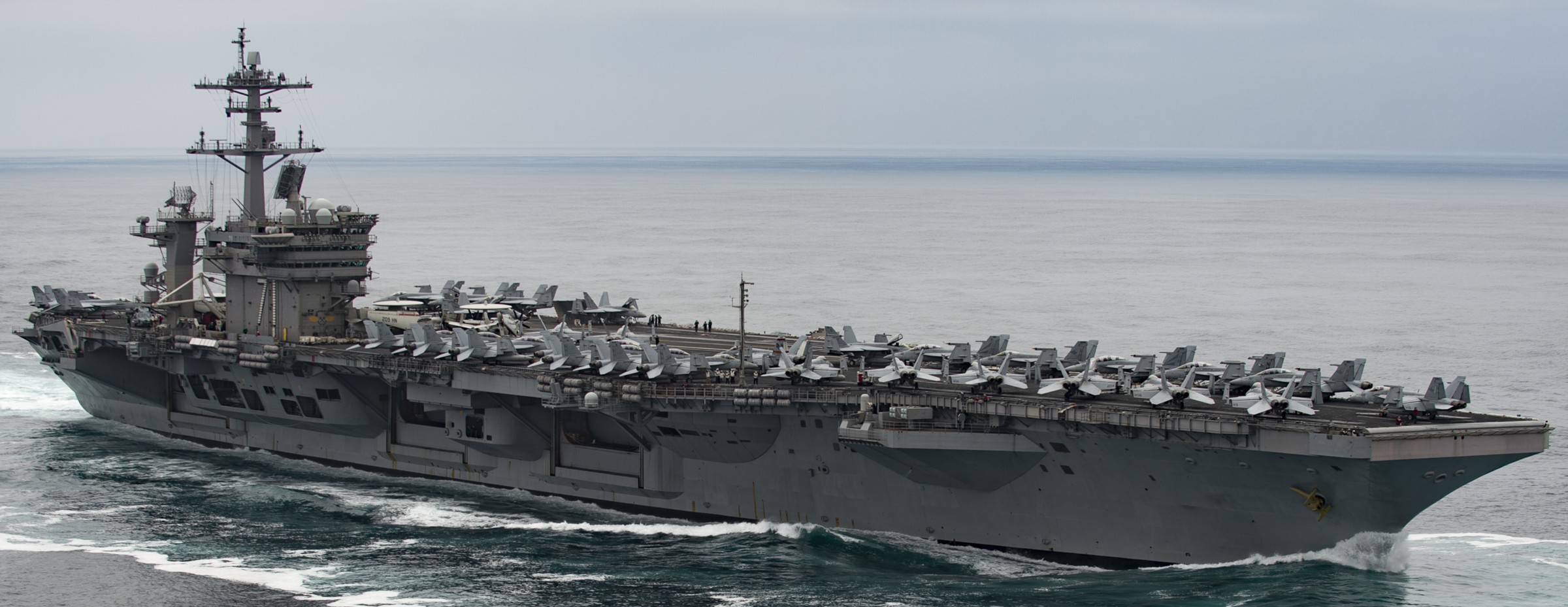 with CVW-11 embarked - Pacific Ocean - July 2019  with CVW-11 embarked - Pacific Ocean - July 2019  with CVW-11 embarked - Pacific Ocean - July 2019 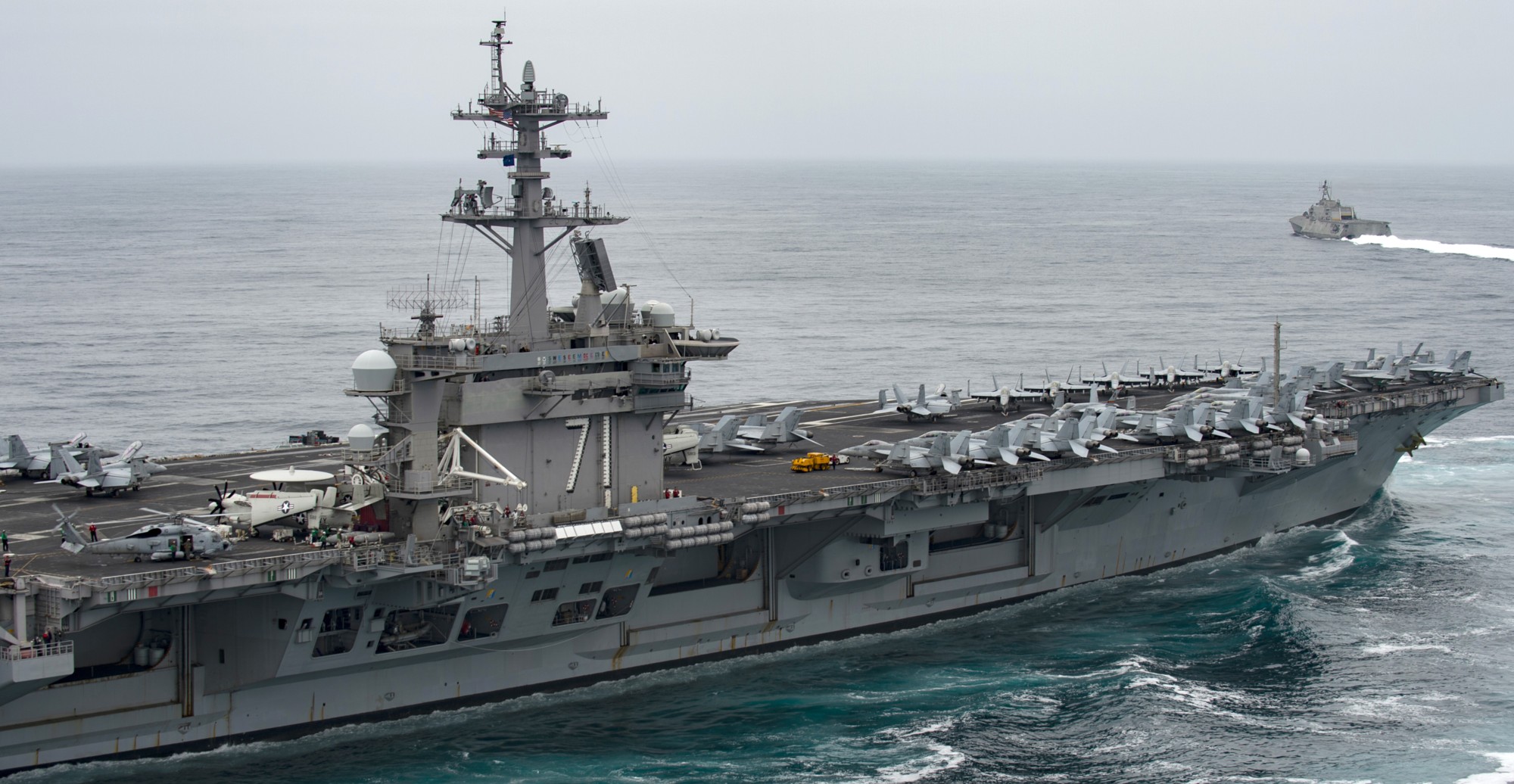 with CVW-11 embarked - Pacific Ocean - July 2019 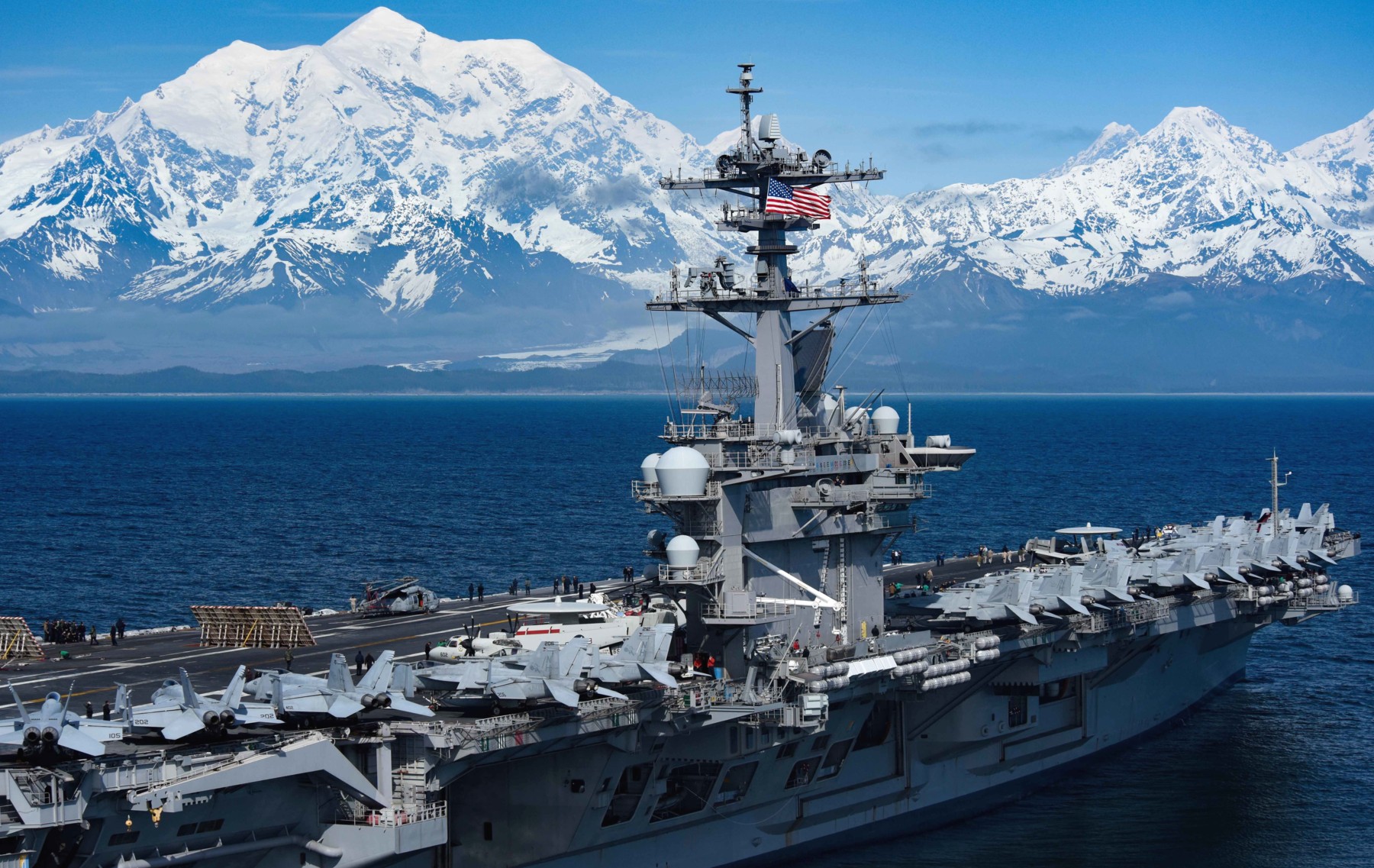 with CVW-11 embarked - exercise Northern Edge - Gulf of Alaska - May 2019 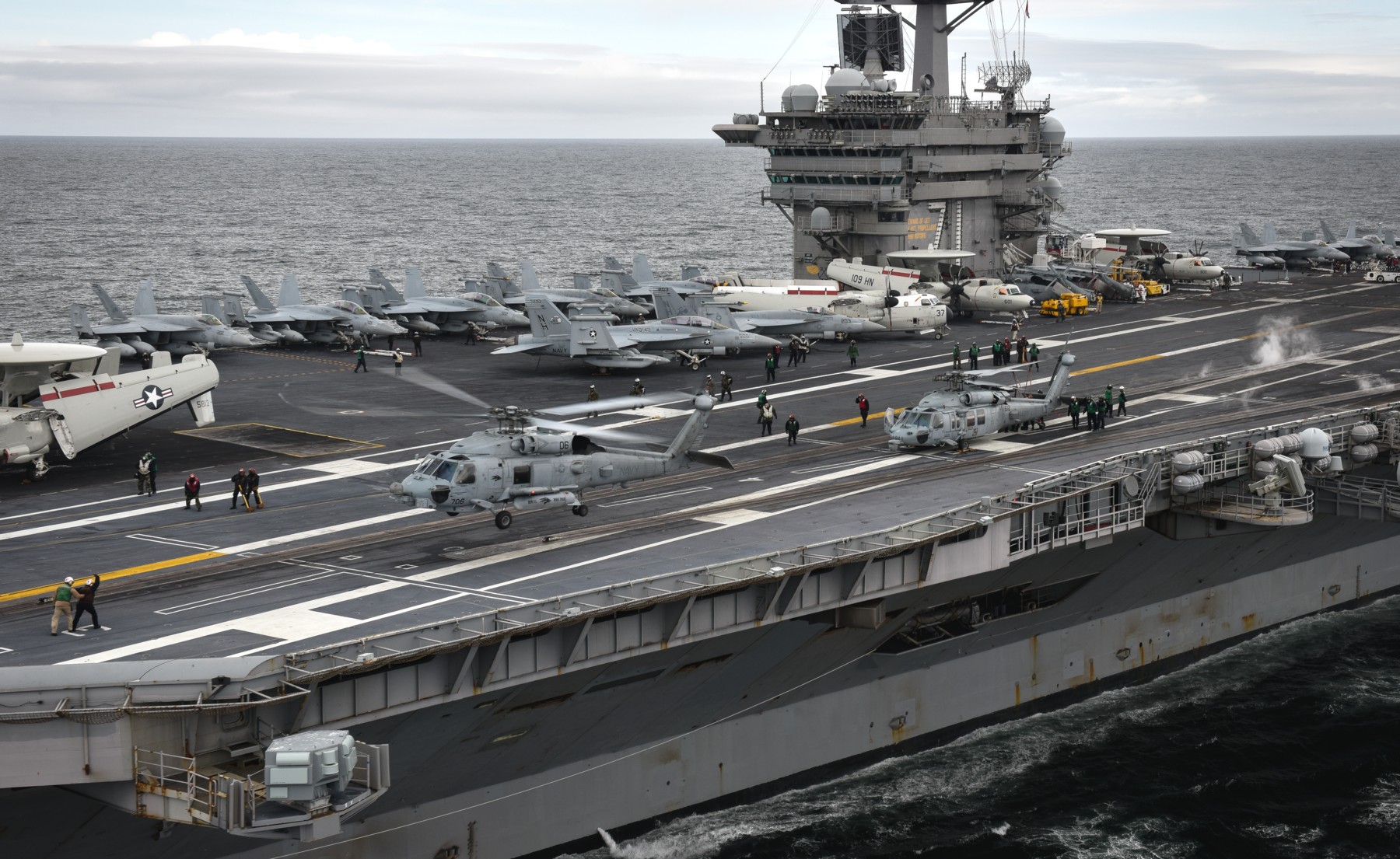 with CVW-11 embarked - exercise Northern Edge - Gulf of Alaska - May 2019 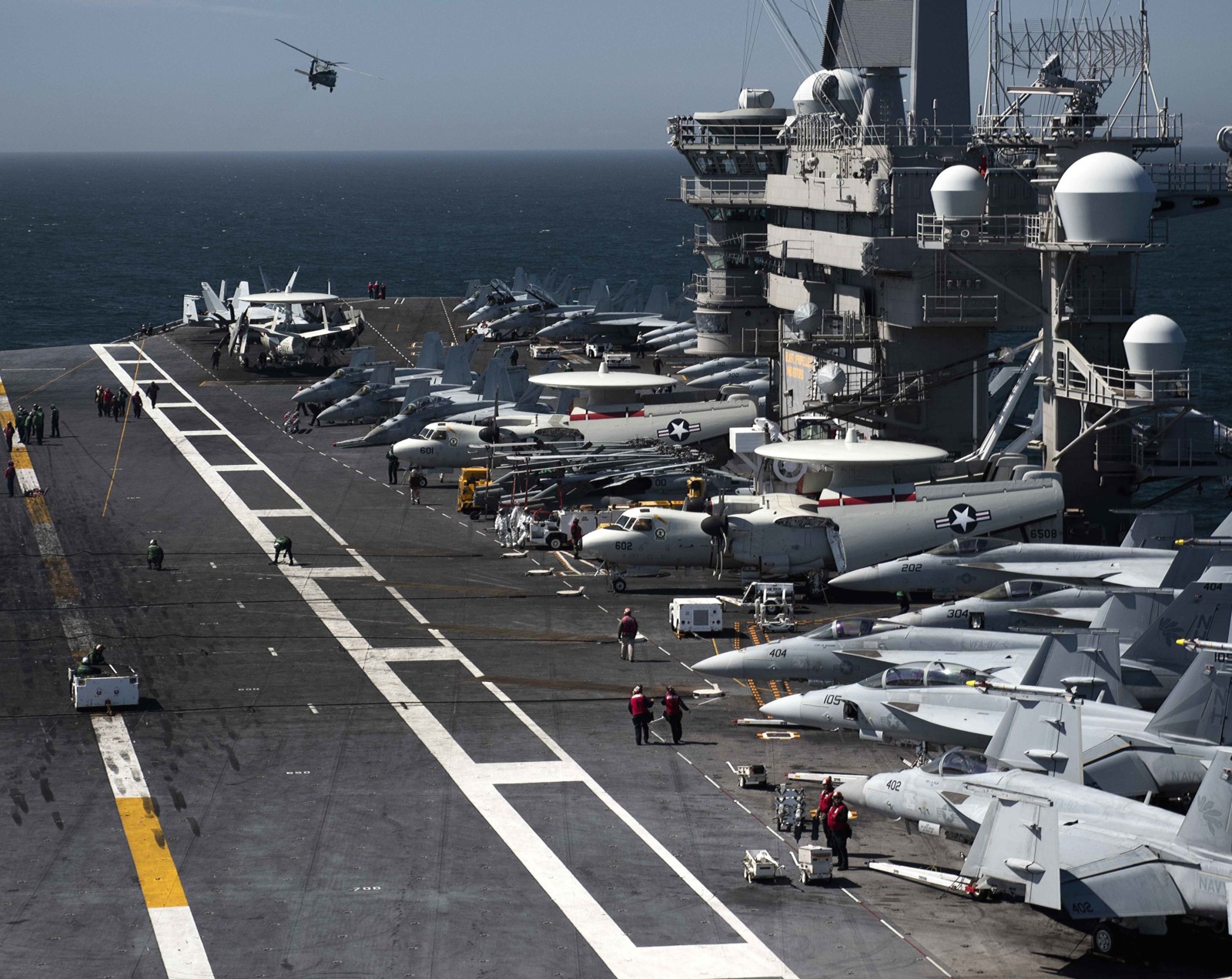 with CVW-11 embarked - exercise Northern Edge - Gulf of Alaska - May 2019 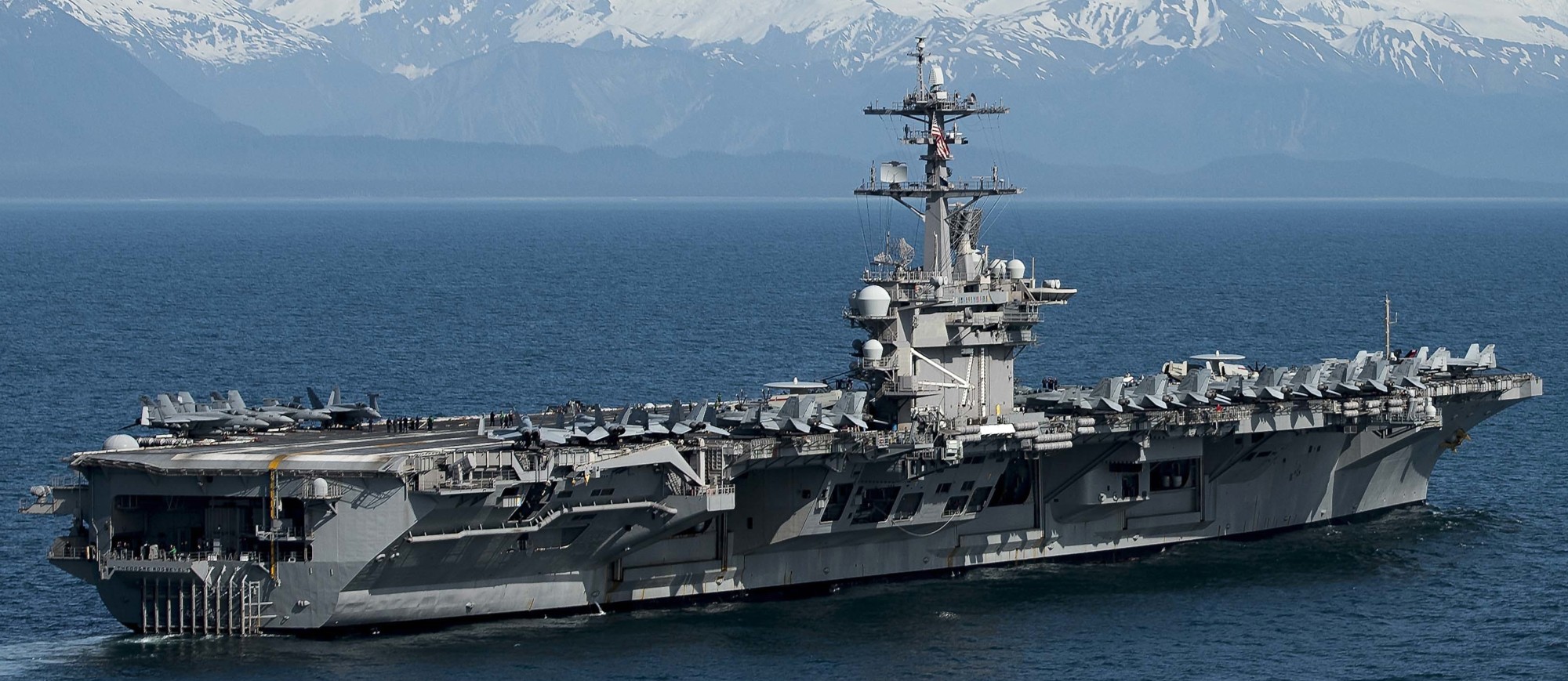 with CVW-11 embarked - exercise Northern Edge - Gulf of Alaska - May 2019  with CVW-11 embarked - exercise Northern Edge - Gulf of Alaska - May 2019  with CVW-11 embarked - exercise Northern Edge - Gulf of Alaska - May 2019  with CVW-11 embarked - exercise Northern Edge - Gulf of Alaska - May 2019 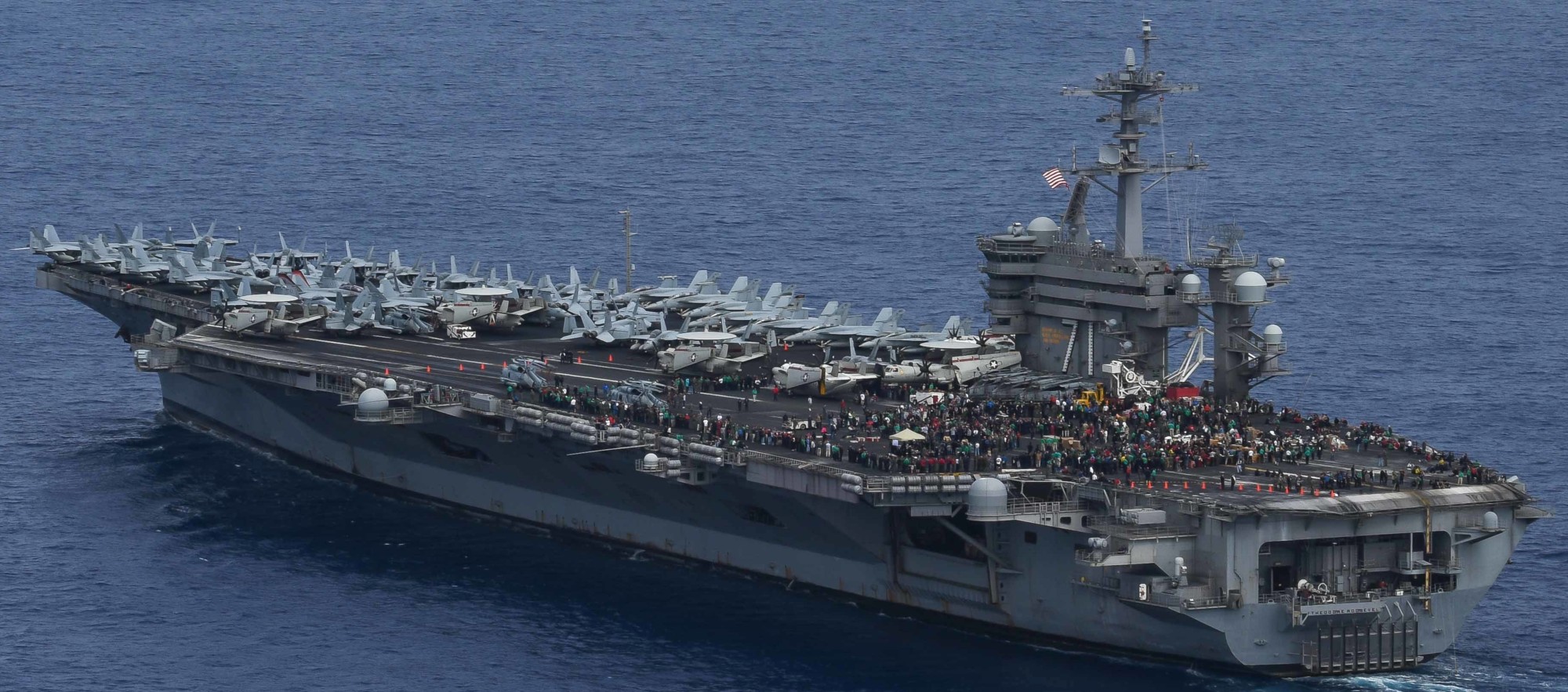 with CVW-17 embarked - Pacific Ocean - May 2018  with CVW-17 embarked - Pacific Ocean - May 2018  with CVW-17 embarked - Pacific Ocean - May 2018 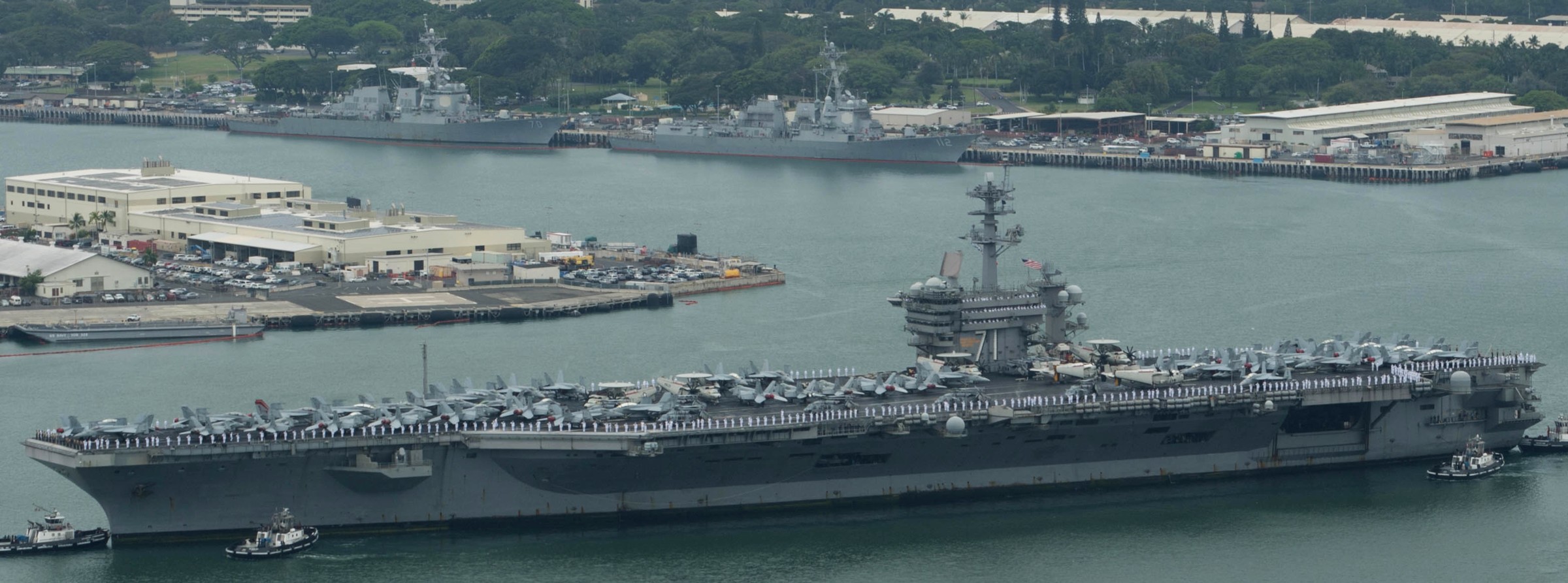 with CVW-17 embarked - Joint Base Pearl Harbor-Hickam, Hawaii - April 2018 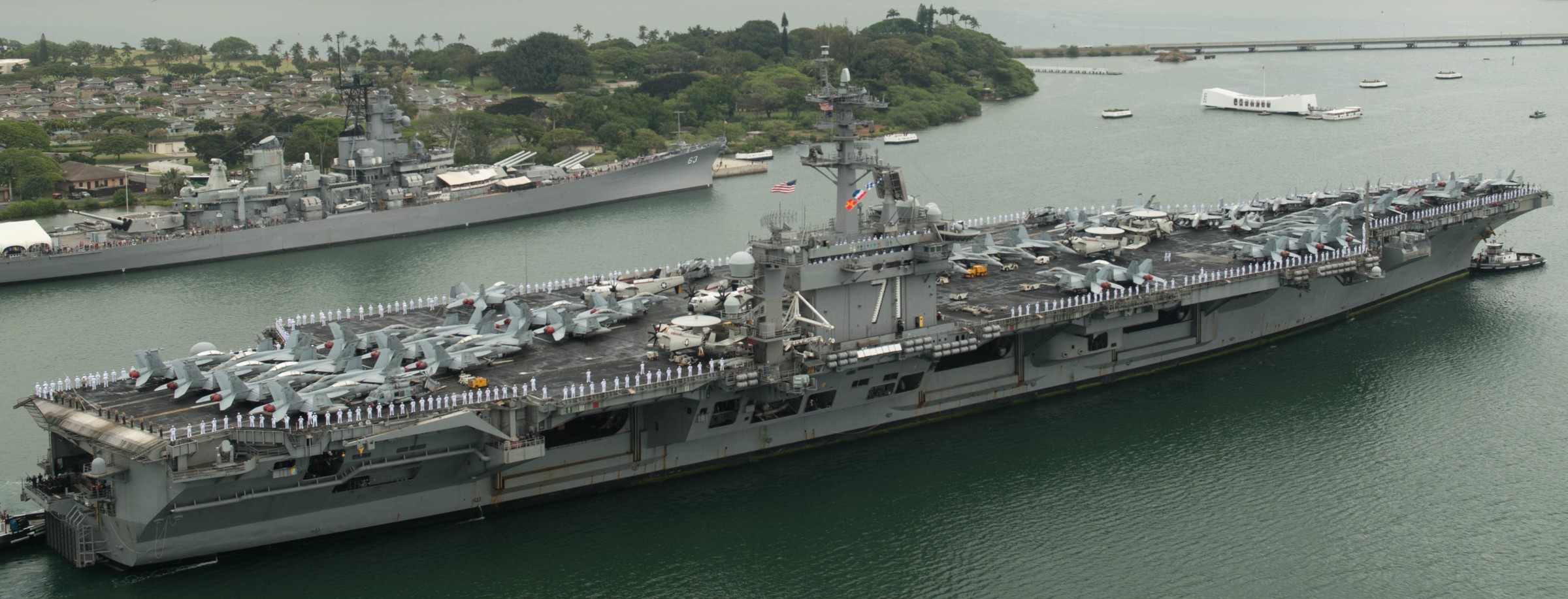 with CVW-17 embarked - Pearl Harbor, Hawaii - April 2018 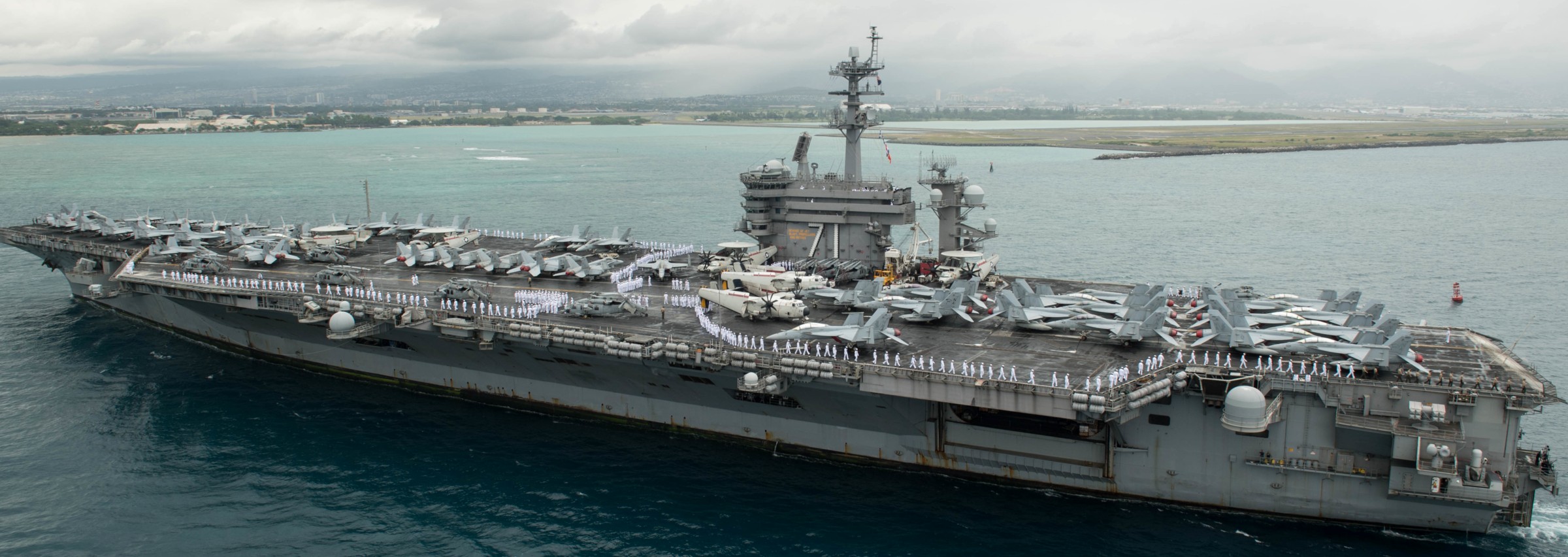 with CVW-17 embarked - Pearl Harbor, Hawaii - April 2018  with CVW-17 embarked - Pearl Harbor, Hawaii - April 2018  with CVW-17 embarked - Pearl Harbor, Hawaii - April 2018 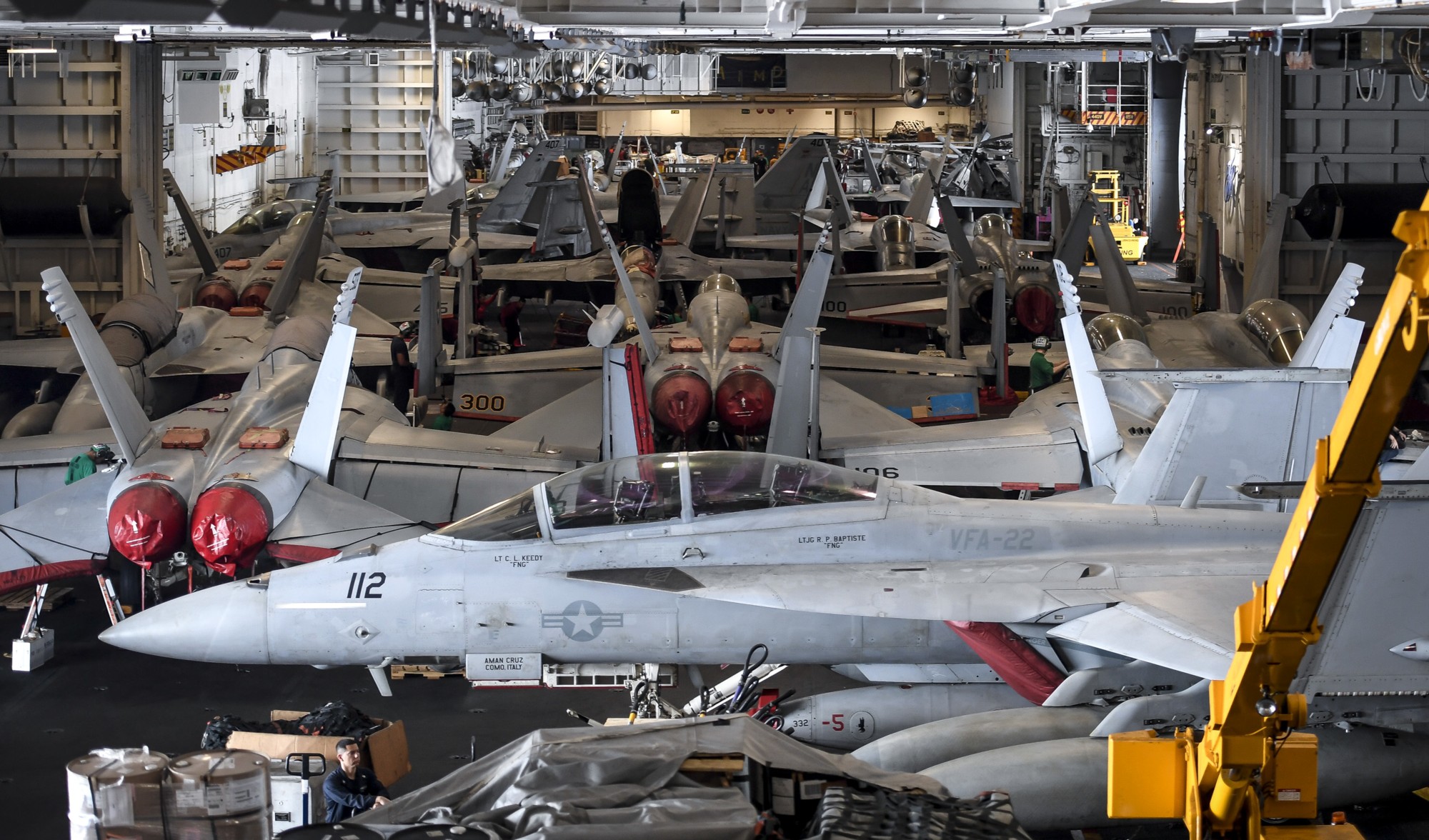 with CVW-17 embarked - Pacific Ocean - April 2018  with CVW-17 embarked - Pacific Ocean - April 2018 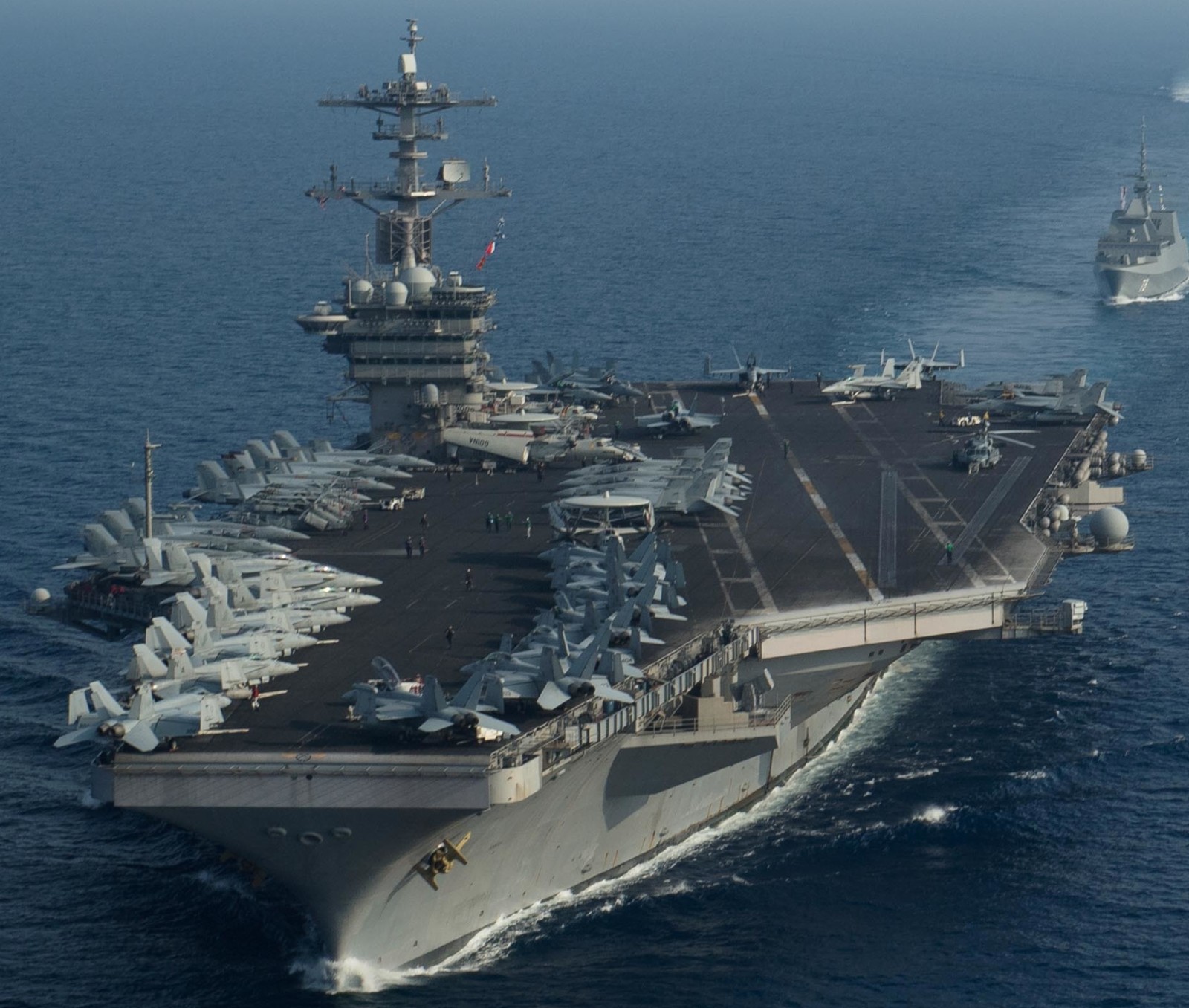 with CVW-17 embarked - South China Sea - April 2018  with CVW-17 embarked - Changi Naval Base, Singapore - April 2018 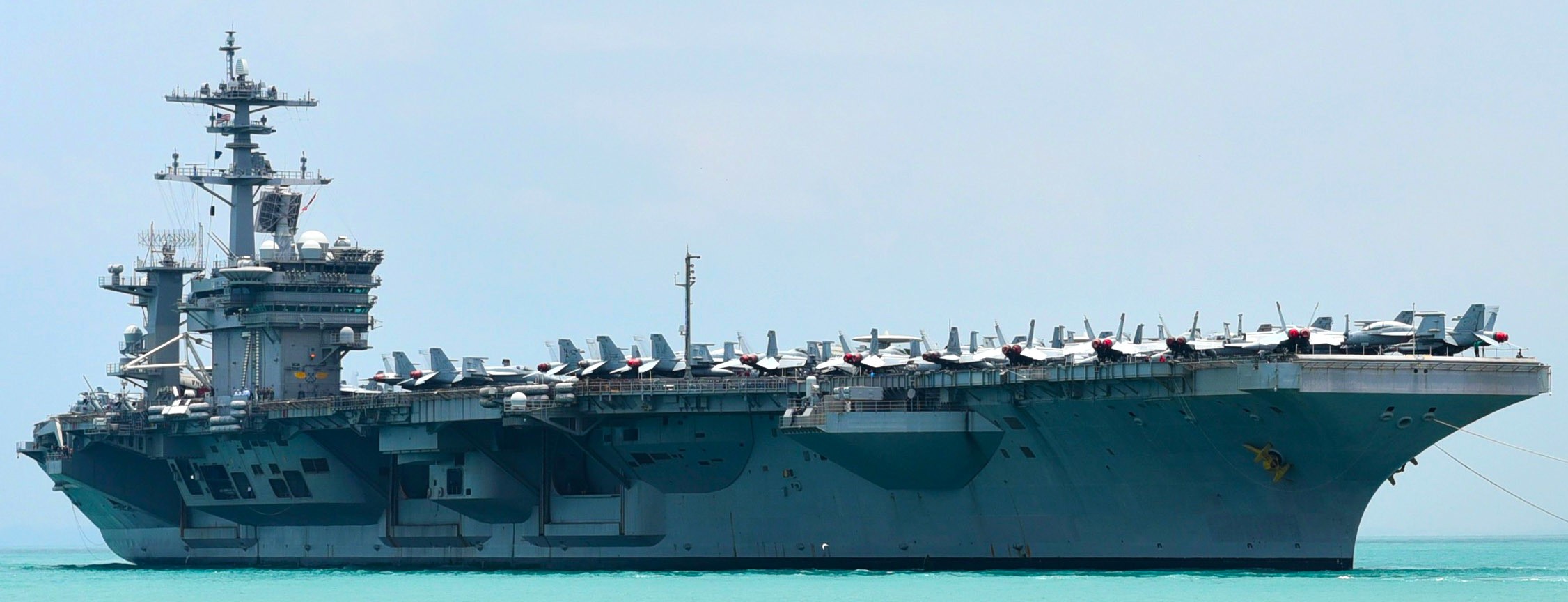 with CVW-17 embarked - Changi Naval Base, Singapore - April 2018 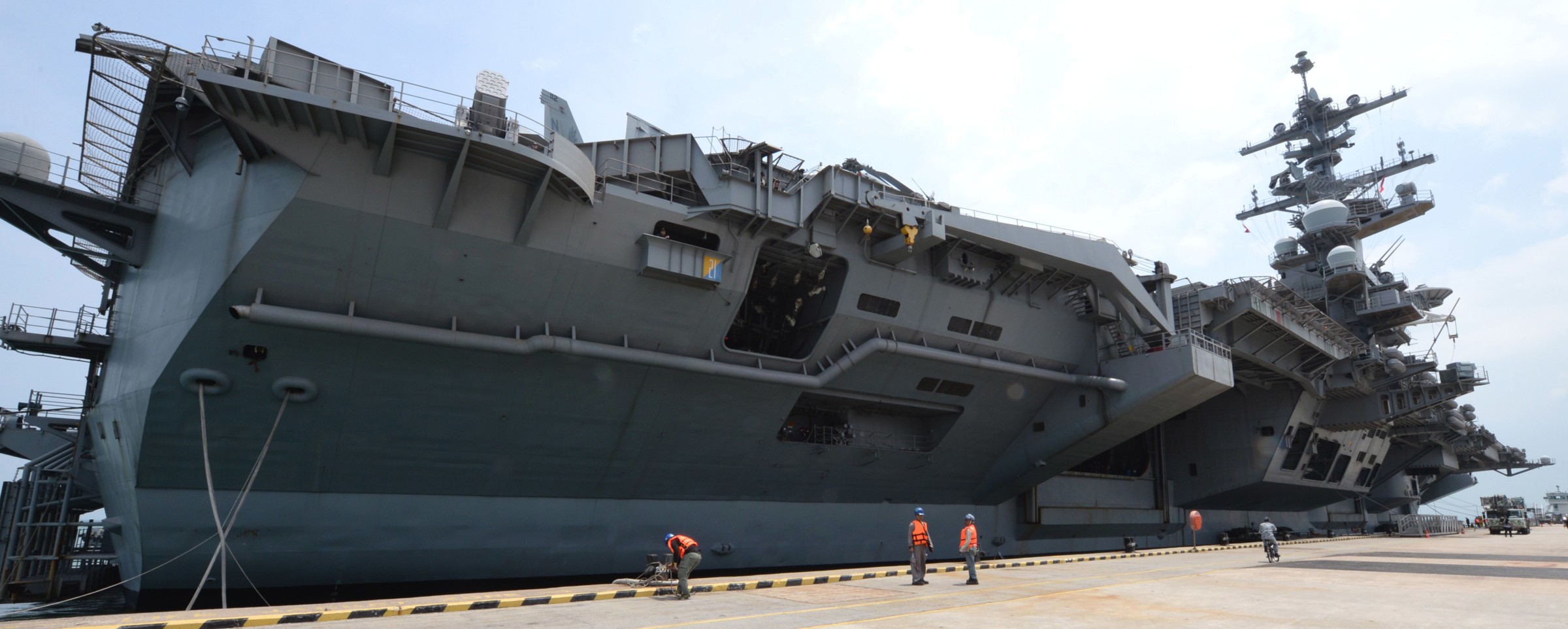 with CVW-17 embarked - Changi Naval Base, Singapore - April 2018  with CVW-17 embarked - Strait of Malacca - April 2018 (celebrating the 125th birthday of the Navy chief petty officer / CPO rate) 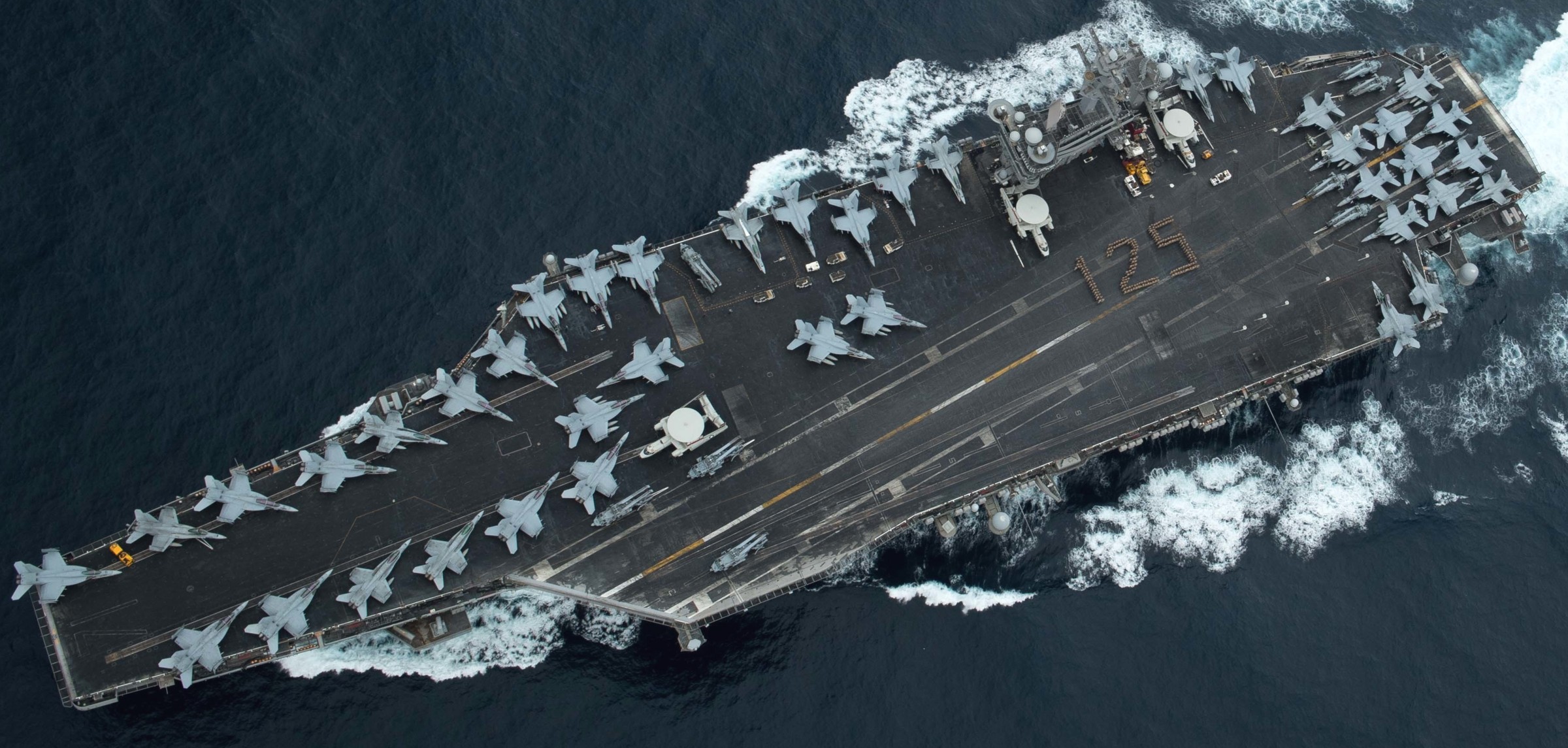 with CVW-17 embarked - Strait of Malacca - April 2018 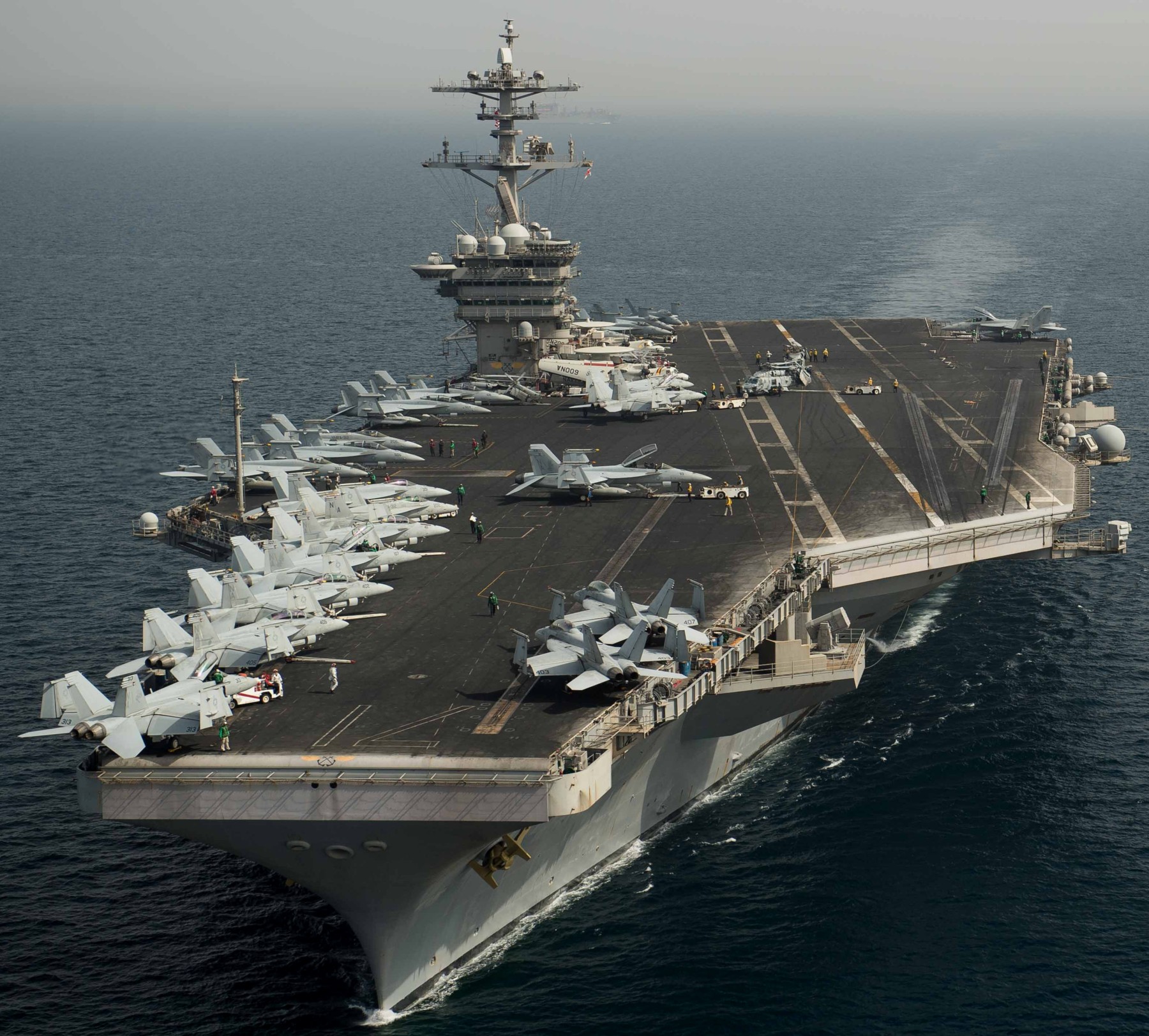 with CVW-17 embarked - Arabian Gulf - March 2018  with CVW-17 embarked - Arabian Gulf - March 2018 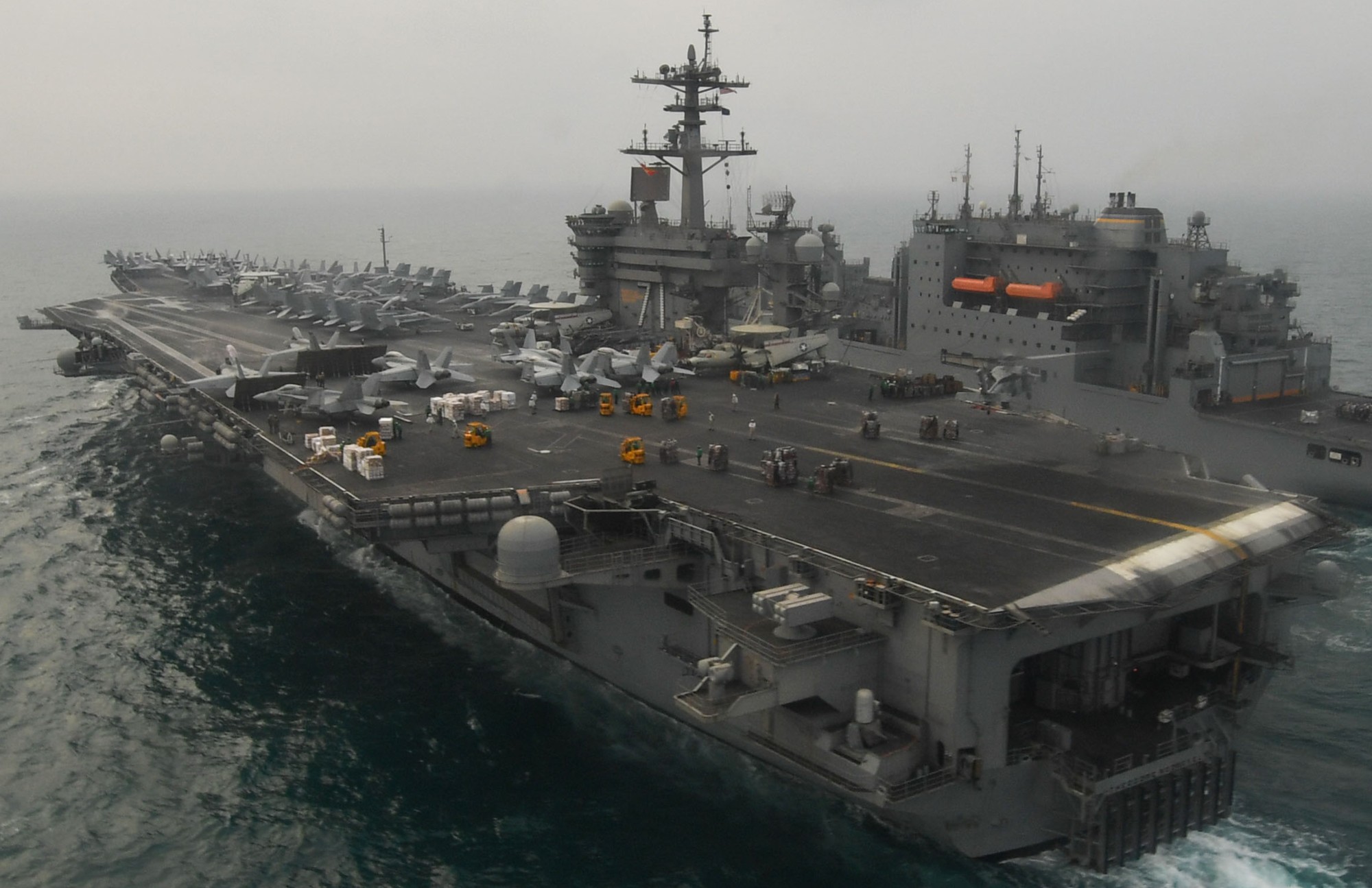 with CVW-17 embarked - Arabian Gulf - February 2018 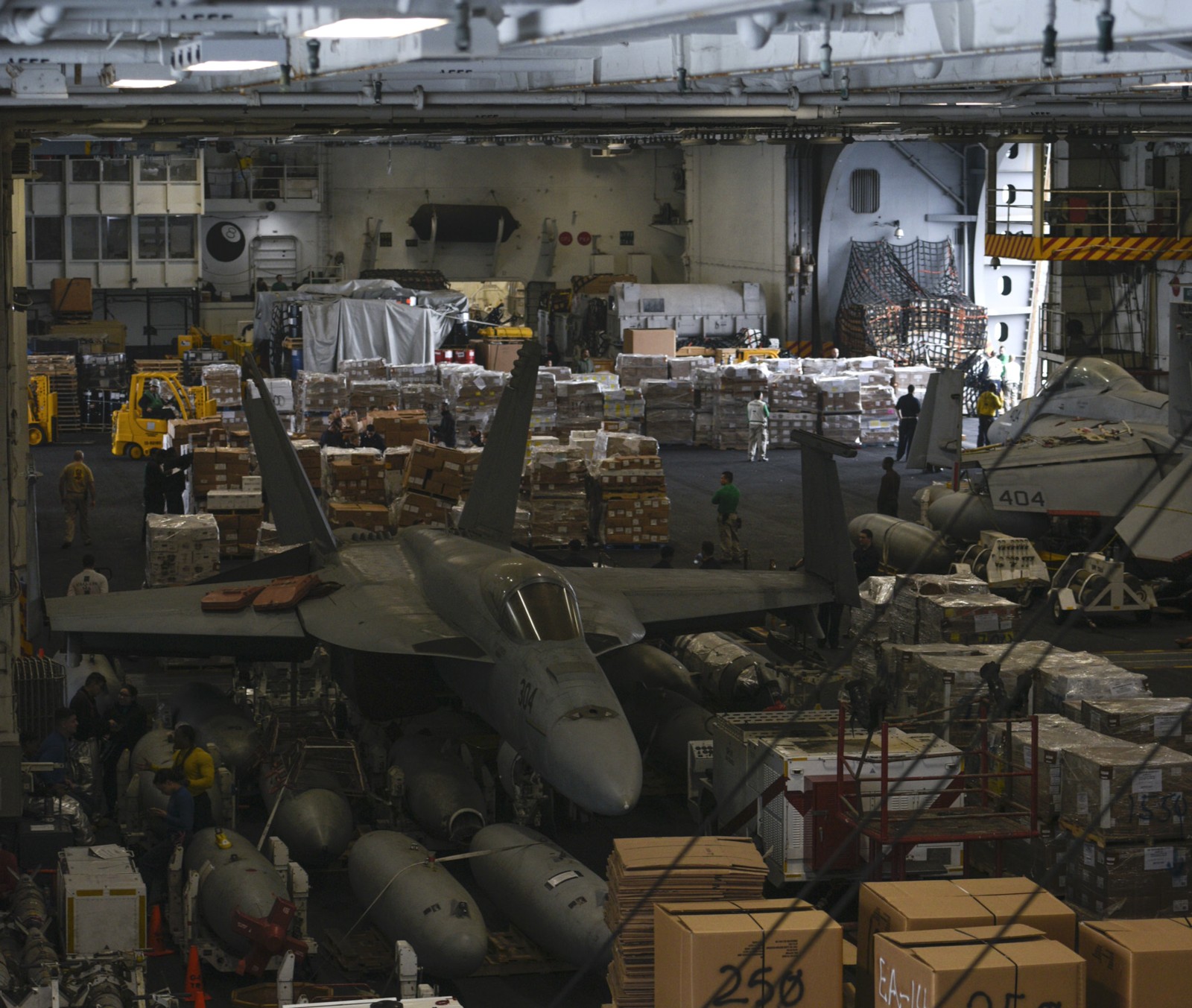 with CVW-17 embarked - Arabian Gulf - February 2018 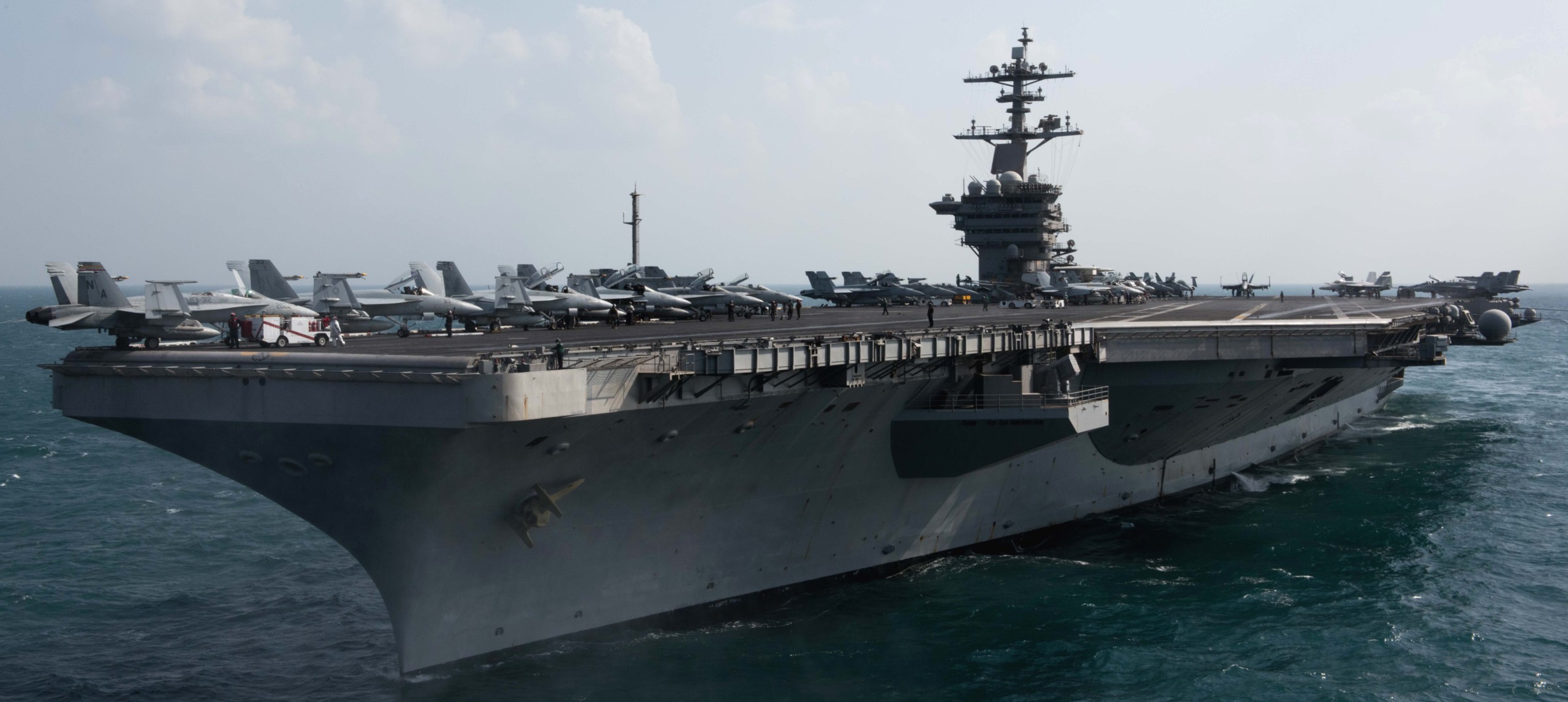 with CVW-17 embarked - Arabian Gulf - January 2018 > continue - CVN 71 image page 2 < |
||
Theodore Roosevelt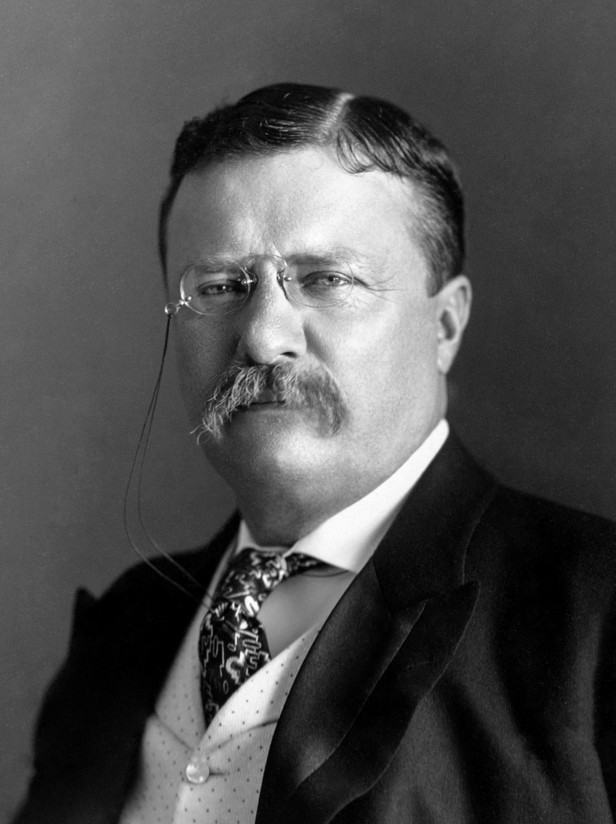
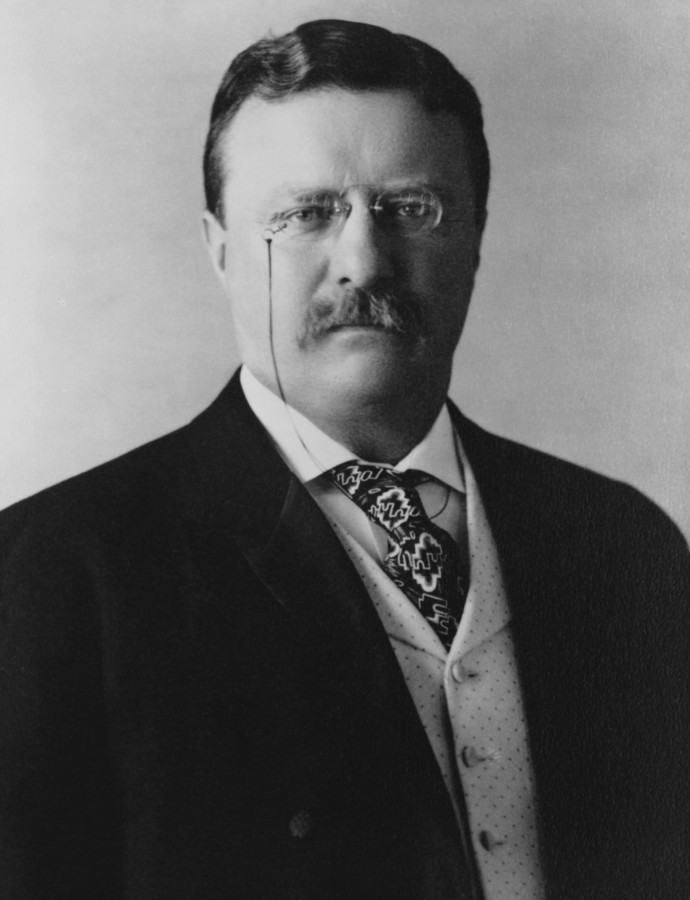 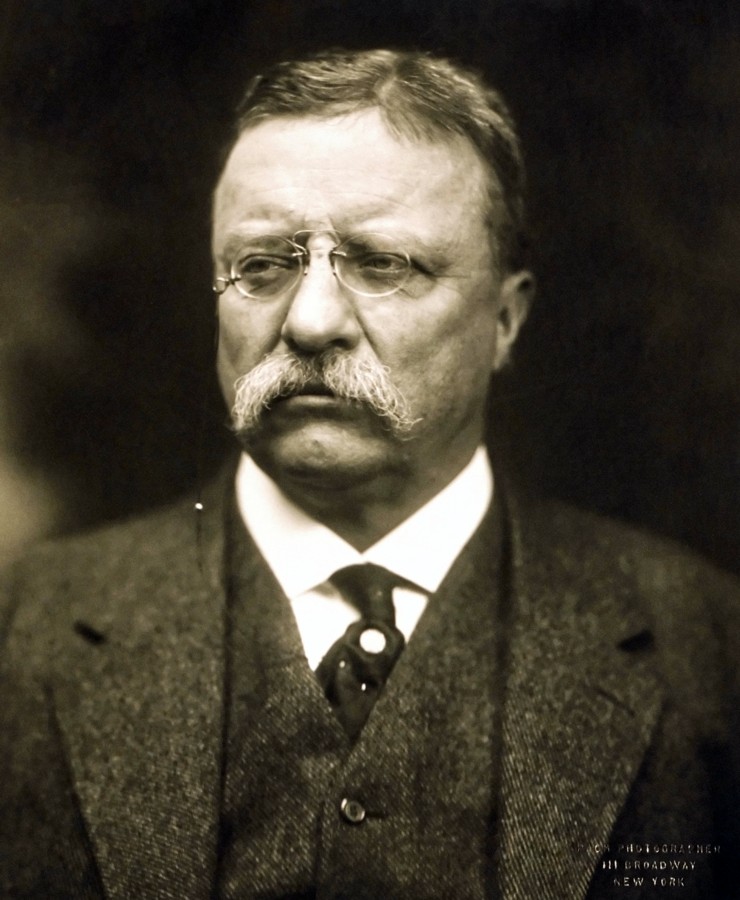
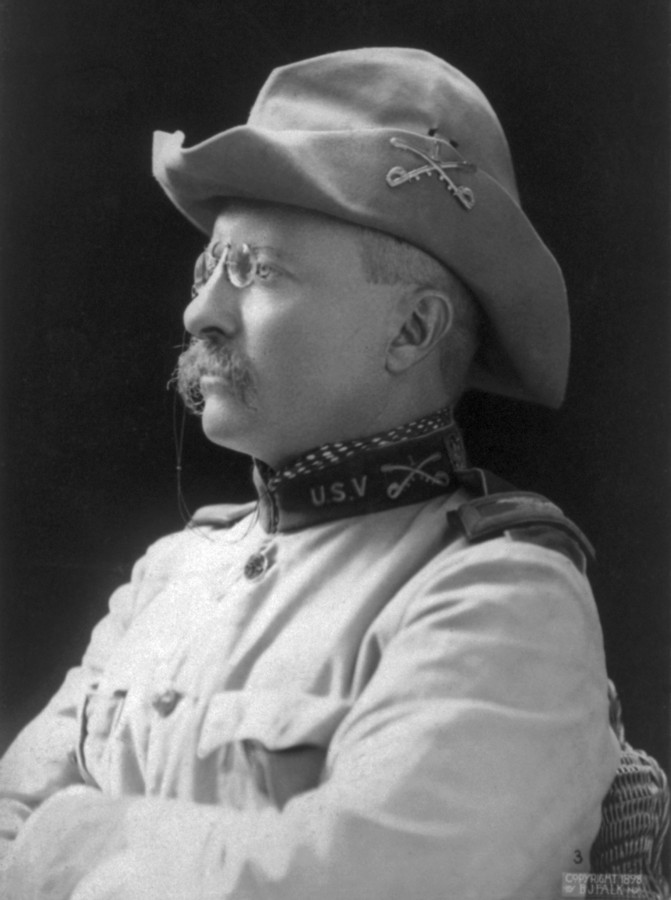 |
||
|
Theodore Roosevelt Jr. (October
27, 1858 - January 6, 1919): ... was an American statesman, author, explorer, soldier, naturalist, and reformer who served as the 26th President of the United States from 1901 to 1909. As a leader of the Republican Party during this time, he became a driving force for the Progressive Era in the United States in the early 20th century. Born a sickly child with debilitating asthma, Roosevelt successfully overcame his health problems by embracing a strenuous lifestyle. He integrated his exuberant personality, vast range of interests, and world-famous achievements into a "cowboy" persona defined by robust masculinity. Home-schooled, he began a lifelong naturalist avocation before attending Harvard College. His first of many books, The Naval War of 1812 (1882), established his reputation as both a learned historian and as a popular writer. Upon entering politics, he became the leader of the reform faction of Republicans in New York's state legislature. Following the deaths of his wife and mother, he took time to grieve by escaping to the wilderness of the American West and operating a cattle ranch in the Dakotas for a time, before returning East to run unsuccessfully for Mayor of New York City in 1886. He served as Assistant Secretary of the Navy under William McKinley, resigning after one year to serve with the Rough Riders, where he gained national fame for courage during the Spanish–American War. Returning a war hero, he was elected governor of New York in 1898. The state party leadership distrusted him, so they took the lead in moving him to the prestigious but powerless role of vice president as McKinley's running mate in the election of 1900. Roosevelt campaigned vigorously across the country, helping McKinley's re-election in a landslide victory based on a platform of peace, prosperity, and conservatism. Following the assassination of President McKinley in September 1901, Roosevelt, at age 42, succeeded to the office, becoming the youngest United States President in history. Leading his party and country into the Progressive Era, he championed his "Square Deal" domestic policies, promising the average citizen fairness, breaking of trusts, regulation of railroads, and pure food and drugs. Making conservation a top priority, he established a myriad of new national parks, forests, and monuments intended to preserve the nation's natural resources. In foreign policy, he focused on Central America, where he began construction of the Panama Canal. He greatly expanded the United States Navy, and sent the Great White Fleet on a world tour to project the United States' naval power around the globe. His successful efforts to end the Russo-Japanese War won him the 1906 Nobel Peace Prize. Elected in 1904 to a full term, Roosevelt continued to promote progressive policies, but many of his efforts and much of his legislative agenda were eventually blocked in Congress. Roosevelt successfully groomed his close friend, William Howard Taft, to succeed him in the presidency. After leaving office, Roosevelt went on safari in Africa and toured Europe. Returning to the USA, he became frustrated with Taft's approach as his successor. He tried but failed to win the presidential nomination in 1912. Roosevelt founded his own party, the Progressive, so-called "Bull Moose" Party, and called for wide-ranging progressive reforms. The split among Republicans enabled the Democrats to win both the White House and a majority in the Congress in 1912. The Democrats in the South had also gained power by having disenfranchised most blacks (and Republicans) from the political system from 1890 to 1908, fatally weakening the Republican Party across the region, and creating a Solid South dominated by their party alone. Republicans aligned with Taft nationally would control the Republican Party for decades. Frustrated at home, Roosevelt led a two-year expedition in the Amazon Basin, nearly dying of tropical disease. During World War I, he opposed President Woodrow Wilson for keeping the U.S. out of the war against Germany, and offered his military services, which were never summoned. Although planning to run again for president in 1920, Roosevelt suffered deteriorating health and died in early 1919. Roosevelt has consistently been ranked by scholars as one of the greatest U.S. presidents. His face was carved into Mount Rushmore alongside those of George Washington, Thomas Jefferson, and Abraham Lincoln. |
||
|
Ship's History: The yard’s Construction Project Manager W.B. Miffleton, Jr., observed that the company utilized a 900-ton gantry crane and modular construction techniques, consisting of 159 large modules, to piece together the carrier’s 60,000-tons of steel 17 months ahead of schedule, a system that the Navy and Newport News used in the following twoNimitz-class carriers, Abraham Lincoln (CVN-72) and George Washington (CVN-73). In the interim, Capt. Paul W. Parcells assumed command as the ship’s first Commanding Officer, on 22 February 1984. Precommissioning Unit Theodore Roosevelt (CVN-71) was established on 9 September 1984, and the crew began to move on board in May 1986. During the midst of ongoing changes regarding the Navy’s design of aircraft carriers and their embarked air wings, Director, Carrier and Air Station Programs Division D.T. Schwaab wrote to Deputy Commander, Surface Combatants, Naval Sea Systems Command Rear Adm. Donald P. Roane on 12 June 1986. Schwaab recommended the pursuit of “a disciplined path to determine the shipboard impact of airwing changes.” SecNav Lehman had decided to split the squadrons equipped with Grumman A-6E Intrudersnormally assigned to aircraft carriers Coral Sea (CV-43) and Midway (CV-41), and he made an “innovative” maintenance concept to minimize manning and space impacts. As a result of these decisions, Schwaab also noted the Secretary’s directive to bring Theodore Roosevelt on line as “a 10-squadron notional airwing ship,” a decision that profoundly affected her design and construction. In addition, Theodore Roosevelt became the first carrier to put to sea equipped with an updated Combat Direction Center in place of the usual Combat Information Center. The principal differences comprised advanced systems including a large screen display based upon the AEGIS system, capable of identifying and tracking multiple targets at extended ranges, providing tactical action officers with ‘real time’ analysis and decision making. Theodore Roosevelt conducted sea trials from 22 September to 10 October 1986. The crew hoisted colors aloft at 0800, and the ship then backed into the James River and sailed toward the Atlantic. The carrier completed her builder’s sea trials within 74 hours. Just before the ship increased to flank speed for the first time, Commanding Officer Capt. Parcells elicited laughs when he informed his crew over the 1MC that they intended to steam quickly enough “to pull a lot of water skiers.” Newport News delivered Theodore Roosevelt to the Navy on 17 October 1986. Theodore Rooseveltcommissioned at Outfitting Berth No. 1 at Newport News, on the rainy day of 25 October 1986. The estimated 20,000 guests included: Secretary of Defense (SecDef) Caspar W. Weinberger; Secretary Lehman; Chief of Naval Operations (CNO) Adm. Carlisle A.H. Trost; President and Chief Executive Officer Edward J. Campbell of Newport News Shipbuilding and Dry Dock Co.; and Congressman Herbert H. Bateman (Republican, Virginia). “Theodore Roosevelt is a national asset and the [free world] can be more secure as a result of [her] presence,” Adm. Trost observed. The commissioning of the ship coincided with the commemoration of the 75th (observed) anniversary of U.S. naval aviation. The ship sailed from Newport News for the first time as a commissioned man of war in order to conduct flight deck certification in the waters off the Virginia Capes, shifting colors at 0605 on 3 November 1986. While the carrier steamed 80 miles southeast of Virginia Beach, pilot Lt. Peter A. Vanderspek, copilot Lt. Dennis P. Hogan, and aircrewman Petty Officer 3d Class Darrin Walker of Fleet Logistics Support Squadron (VRC) 40 accomplished the first fixed-wing aircraft arrested landing on board Theodore Roosevelt, in a Grumman C-1A Greyhound (BuNo 136034) at 1258. The Greyhound reeled out more than 200 feet of the 3-inch arrester cable from No. 1 arrester wire before the plane halted. Mere seconds later, pilot Lt. Comdr. Abraham J. Goldstein, copilot Lt. j.g. Edward H. Clay, and aircrewman Petty Officer 3d Class Erin Webb followed them in a second Greyhound. The second landing enabled Webb to stake her claim as the first woman to trap on board. Thirty-three minutes later an LTV A-7 Corsair II designated Aircraft No. 401, flying from Navy Air Test Center at NAS Patuxent River, Md., touched down as the first attack aircraft to trap on board. The following morning at 0856, 401 became the first jet to launch from the ship. During the succeeding days Grumman F-14A Tomcats, McDonnell Douglas F/A-18A Hornets, Corsairs, Intruders, Grumman EA-6B Prowlers, and a Lockheed S-3A Viking from the Center made additional traps and launches. The ship passed her flight deck certification on 11 November, and on 17 November returned to Pier 11 at NS Norfolk. The ship underwent deperming from 2 to 6 December 1986. During the two previous weeks, the crew and shipyard workers laid out 11 miles of insulated copper cable, which they wrapped around the ship. Operators then passed electrical current through the cables that realigned the carrier’s magnetic field to protect her from magnetic mines, ensure accurate compass reading, and to safeguard electronic equipment on board. Theodore Roosevelt trained in the Jacksonville Operating Area off Florida from 7 to 19 December 1986. Aircraft from CVW-7 including Tomcats of Fighter Squadrons (VFs) 142 and 143, Intruders of Attack Squadron (VA) 34, Corsair IIs of VAs 46 and 72, Grumman E-2C Hawkeyes of Carrier Airborne Early Warning Squadron (VAW) 121, Vikings of Carrier Air Antisubmarine Squadron (VS) 31, and Sikorsky SH-3H Sea Kings of Helicopter Antisubmarine Squadron (HS) 5 accomplished flight operations during these first large scale aircraft operations on board. The ship fired her first seven RIM-7M NATO Sea Sparrow surface-to-air missiles, scoring seven hits against seven drones, on 14 December 1986. While taking part in these exercises she also fired more than 4,000 rounds from her Phalanx Close-In Weapon System (CIWS) mounts. The Navy developed CIWS as a last-ditch defense against cruise missiles. The system’s six barrel M61A1 Vulcan gun fired tungsten alloy projectiles at a rate of two to three thousand rounds per minute, raising a nearly impenetrable barrier against missiles. Theodore Roosevelt then returned to Pier 12 at NS Norfolk. Vice Admiral Richard M. Dunleavy relieved Vice Adm. Robert F. Dunn as Commander, Naval Air Force, Atlantic Fleet, during a ceremony held on board on 23 December 1986. Throughout the year aircraft completed 829 catapult launches and 798 traps, and flew 915.8 hours (819.5 daytime and 96.3 nighttime) from the ship. Theodore Roosevelt trained in Atlantic waters from 6 January to 20 February 1987. While she completed her shakedown cruise in Caribbean waters (12 to 24 January) on 10 January, the ship rescued shipwrecked mariners Joseph D. Buffkin and John W. Frederico from their crippled sailboat, after the men floated adrift in the Caribbean for more than four days. Two days later, an SH-3H (BuNo 148995) of HS-11 ditched in the sea off the coast of Florida after experiencing mechanical difficulties, but the ship recovered the helo’s crew. The carrier anchored at Naval Station (NS) Guantánamo Bay, Cuba, on 25 January, and at Nassau in the Bahamas over 28 January to 1 February. Senator Edward M. Kennedy of Massachusetts became the first member of Congress to embark on board Theodore Roosevelt during his visit on 12 and 13 February. Congressmen Owen B. Picket of Virginia followed him as the initial member of the House of Representatives to embark on 14 and 15 February. The ship responded to a medical emergency on board Sunfish (SSN-649) on 16 February 1987, when one of the attack submarine’s crewmembers suffered a heart attack. High seas and heavy weather impeded a Sea King from the carrier that lowered medical officer Lt. John Bean, MC, to the submarine, but the stricken crewmember died. Theodore Roosevelt also tested airframes which the Fleet selected for instrumentation: a McDonnell Douglas A-4E Skyhawk (BuNo 150058), an E-2B (BuNo 150540), a McDonnell Douglas F-4JPhantom II (BuNo 155806), and an A-7E (BuNo 157506). Instructors from Fleet Training Group, Guantánamo Bay, evaluated the readiness of the Navy’s newest carrier during 20 days of testing. The carrier completed an Inspection and Survey (INSURV) off Jacksonville from 2 to 12 March. Theodore Roosevelt IV, the great grandson of the man for whom the ship was named, took off and landed in a Tomcat flown by Lt. Roe Massey of VF-101, on 4 March. During the first take off from the No. 1 catapult, Roosevelt keyed the radio by mistake, shouting “Hoo yah! That’s incredible!” During this time frame, the ship’s sponsor Barbara W. Lehman, together with the wife of SecNav James H. Webb, visited the ship. The ship completed a post shakedown availability at Newport News Shipbuilding and Dry Dock Co., over 30 March to 26 July 1987. The 322 sailors on board who advanced to third class petty officers during March exams (on 16 July) included Aerographer’s Mate Airman Frederick Roosevelt, a direct descendent of the ship’s namesake. The Navy selected Theodore Roosevelt to undergo shock trial tests to represent Nimitz class aircraft carriers. The tests determined the survivability of such ships against large caliber and high explosive warhead blasts nearby, including detonations by weapons of mass destruction. The ship initially completed shock trials practice with fleet ocean tug Apache (T-ATF-172) off the Virginia capes from 4 to 14 August. Pilot Lt. John Covell of VAW-123 trapped on board in an E-2C Hawkeye, designated Aircraft No. 602, on 10 August, enabling Covell to become the carrier’s first Centurion, successfully accomplishing 100 arrested landings on board a given carrier. The following day Theodore Roosevelt assisted two mariners in distress, Jack Harary and Wayne Holderness. The men sailed en route from Point Pleasant, New Jersey, to Fort Augustine, Fla., in their sailboat Astrea when Harary became acutely ill. They contacted the Coast Guard, which requested help from the carrier. The ship’s medical staff treated Harary. Theodore Roosevelt then completed the actual shock trials in the Jacksonville Operating Area from 31 August to 21 September 1987. Testers emplaced over 800 sensors on structures and ship’s systems to record the effects of the shock, including accelerations, velocities, and events such as the opening of the circuits, moments, and contacts. Crewmembers and civilian technicians detonated the first of the four blasts at 1400 on 2 September. Immediately after each detonation, damage control teams and specialists from the Underwater Explosions Research Division of the Naval Ocean Systems Center searched for damage. The teams set off three more explosions on 10, 14, and 19 September. Pilot Lt. Jeff Miller of the Naval Air Test Center at NAS Patuxent River made the first Sikorsky SH-60F Seahawk landing on board Theodore Roosevelt during the helicopter’s sea trials on 9 September. The ship punctuated the trials with a brief visit to NS Norfolk to enable her crew to celebrate Labor Day, before returning to the waters off Florida to resume testing. The ship also received a medically evacuated patient from salvage ship Hoist (ARS-40), on 14 September. Captain Dayton W. Ritt relieved Capt. Parcells as Commanding Officer of the ship, on 3 October 1987. The carrier completed fleet carrier qualifications off Jacksonville from 6 to 15 October, receiving and treating a medically evacuated patient from guided missile destroyer Farragut (DDG-37) on 9 October. Leading dignitaries and officials routinely visited the ship, and Director for Operations, Atlantic Fleet Rear Adm. Gary F. Wheatley led an entourage including Indonesian Navy Chief of Staff Adm. Rudolf Kasenda on board on 2 November. Under SecNav H. Lawrence Garrett, III, visited the following day. Theodore Roosevelt recorded 3,610 daytime and 1,439 nighttime aircraft arrested landings during 1987, together with 652 daytime and 64 nighttime ‘touch and goes,’ and 177 daytime and 164 nighttime ‘bolters,’ for a total of 3,100.3 daytime and 1,410.4 nighttime flight hours. The ship put to sea for the first time since her shock trials in order to complete fleet carrier qualifications off the Virginia capes, from 23 February to 3 March 1988. Theodore Roosevelt completed a massive ammunition onload comprising 650 lifts with ammunition ship Santa Barbara(AE-28) on 25 February. The ship then carried out additional fleet carrier qualifications, first off Jacksonville and then toward Cuban waters, during 8 March to 7 April 1988. This cruise marked the first embarkation on board of all the squadrons of CVW-8 simultaneously. During flight operations a propeller of an E-2C Hawkeye killed Airman Ronald E. Kraus, a plane captain assigned to VAW-124, on the morning of 13 March. Kraus bore the sad distinction as the first sailor to die on board Theodore Roosevelt. During this period Commander, Fleet Training Group Capt. Albert P. Johnson led a team that evaluated the ship and her crew. George Steinbrenner, the owner of the New York Yankees baseball team, led an entourage on board over 30 and 31 March. The carrier then put into Fort Lauderdale, Florida, through 4 April. Tragedy followed the crew, however, when Airman Patrick J. Heslin of the Air Department’s V-3 Division, which was responsible for hangar bay operations, drowned while on liberty in Fort Lauderdale on 3 April. Theodore Roosevelt headed for home with 1,500 dependents on board for a Tiger Cruise. Theodore Roosevelt accomplished additional fleet carrier qualifications off the Virginia capes, from 19 to 24 April. Observers from the David R. Taylor Naval Ship Research and Development Center conducted standardization and deceleration trials at Hector Range during the final two days of the sail. Their resulting data determined the maximum speed that Theodore Roosevelt could safely attain, and filled in further data for Nimitz class aircraft carriers. The ship completed advance phase training off the Virginia capes and in the waters off Jacksonville and into the Caribbean, from 23 May to 28 June. Airman Apprentice William H. Berry, III, of VS-24 fell overboard during flight operations 163 miles northeast of Jacksonville, on 30 May. Searchers did not recover Berry. The ship visited St. Thomas, Virgin Islands, on 17 to 19 June. Commander-in-Chief, Atlantic Fleet Adm. Frank B. Kelso, II, embarked over 6 to 7 July 1988. The following day, Chairman of the Joint Chiefs Adm. William J. Crowe, Jr., escorted on board a Soviet entourage led by: First Minister of Defense and Chief of the General Staff Marshal Sergei F. Akhromeyev; Deputy Commander-in-Chief, Soviet Navy, Adm. K.V. Makarov; First Deputy Commander-in-Chief, Soviet Army, General-Colonel L.A.A. Grinkevich; and First Deputy Commander-in-Chief, Soviet Air Force, General-Colonel of Aviation V.Y. Pan’kin. Near noon a female naval lieutenant flew the guests from Andrews Air Force Base near Washington, D.C. The growing status of women in the U.S. armed forces intrigued Akhromeyev, whose experience with women serving in the Soviet forces differed markedly. As they prepared to take off Pan’kin, who sat behind the marshal, stubbornly refused to fasten his seat belt, until the pilot left her seat and walked aft to admonish him, explaining that they would not leave the ground until he did so. Akhromeyev turned around and angrily ordered the man to “Fasten your d___ belt!” This visit marked the first carrier landing for the Soviets, many of whom commented upon the event. The air wing performed a firepower demonstration, and aircraft dropped a variety of live ordnance on targets within a mile of the carrier. Their precision timing deeply impressed the guests, as did their aircraft launch and recovery cycles. Theodore Roosevelt etched herself into the minds of Akhromeyev and his staff to such an extent that during future meetings he often countered Adm. Crowe’s arguments concerning the defensive strategies espoused by U.S. naval officers by emphasizing the “threat” that aircraft carriers poised to the East Bloc, citing his experience on board Theodore Roosevelt. “The crew has always been showcased in all our visits and what Akhromeyev saw in the crew was something the Soviet Union does not possess,” the ship’s Commanding Officer Capt. Ritt reflected. The Soviet party returned to Norfolk. SecNav William L. Ball, III, also visited the ship, arriving in an F/A-18 Hornet and departing in an A-6EIntruder. Icelandic Prime Minister Thorsteinn R. Palsson became the first head-of-state to visit the ship, on 12 August. Supreme Allied Commander, Atlantic Adm. Lee Baggett, Jr., hosted the prime minister’s visit. Theodore Roosevelt sailed to join her battle group for the first time as part of operational exercise during a series of maritime and amphibious exercises designated Teamwork ’88, in the North Atlantic from 25 August to 21 September 1988. More than 200 ships and submarines, about 500 aircraft, and 45,000 people from nine nations took part. Aircraft carrier Forrestal (CV-59) moved into the Norwegian Sea from the south while Theodore Roosevelt steered easterly courses from American and Canadian waters through the Atlantic around Greenland and the gap between Iceland, the Faeroe Islands, and the British Isles, before operating off Vestfjord, Norway. The dozens of distinguished visitors to the ship included Secretary Ball, Adm. Baggett, Secretary General of NATO Dr. Manfred Wörner, British Commander-in-Chief North Gen. Sir Geoffrey Howlett, Canadian Chief of the Defense Staff Gen. Paul D. Manson, two ambassadors, three ministers, eight members of national parliaments, and over 20 flag and general officers. Theodore Roosevelt crossed the Arctic Circle at 009° 37'9"E, on 14 September 1988. The event enabled the participating crewmembers to earn the title of ‘Bluenoses,’ the ancient tradition including the men so marking themselves through the next 24 hours, a ceremony they relished with pride. The ship subsequently entered Vestfjord and stood out to sea the next day. Meanwhile, Forrestal visited Portsmouth, over 25 to 26 August, and at one point also passed over the Arctic Circle. In the interim, Theodore Roosevelt made her initial overseas port call when she visited Wilhelmshaven, West Germany, from 25 to 29 September. West German Minister of Defense Dr. Rupert Scholz and Commander, Naval Bureau Rear Adm. Hein-Peter Wehyer visited the ship. During her return home the ship passed through the English Channel, on 30 September. The ship trained in Caribbean waters over 7 to 18 November. Crewmembers and evaluators tested the concept of the Force Over-the-Horizon Coordinator, which assisted staff members in tracking enemy and friendly forces for hundreds of miles surrounding the battle group. Theodore Roosevelt sailed on her first deployment, which the crew dubbed their “Great Adventure,” on 30 December 1988. Commander, Cruiser-Destroyer Group 8 Rear Adm. David B. Robinson, who also served as Commander, Task Force 60, broke his flag in the ship. CVW-8 deployed with sailors from 10 squadrons, which added an attack squadron equipped with Intruders and one each additional Hawkeye and Prowler aircraft. During the year aircraft completed 8,511 daytime and 3,898 nighttime traps on board the carrier, 992 daytime and 157 nighttime ‘touch and goes,’ 320 daytime and 359 nighttime bolters, and 11,748.2 daytime and 4,554.5 nighttime flight hours. Theodore Roosevelt became the principal strike element of Task Force 60 when she relieved John F. Kennedy (CV-67) in the Mediterranean, on 15 January 1989. The crew of Theodore Roosevelt onloaded 35 lifts of weapons from John F. Kennedy. Italian Chairman of the Joint Chiefs of Staff Adm. Marchio di Ugo Porta embarked overnight, on 21 and 22 January. The ship then anchored at Palma De Mallorca in Spain, from 24 to 31 January. The visit marked her first liberty port following 24 consecutive days at sea. Theodore Roosevelt participated in an exercise designated Phinia ’89, in the Western Mediterranean, over 4 to 8 February 1989. Aircraft flew missions in support of amphibious operations, including an opposed landing and a non-combatant evacuation. Commander-in-Chief, Allied Forces Southern Europe Adm. James B. Busey, and French Chairmen of the Joint Chiefs of Staff Gen. Schmitt embarked at times.Theodore Roosevelt conducted a missile exercise dubbed CEM 89A MissilEx the day following the amphibious exercise. The ship anchored off Marseilles, France, for a visit scheduled to run from 10 to 17 February. Unexpected Mistral (strong and cold) winds forced her to emergency sortie on 14 February. The carrier returned to pick up crewmembers two days later, and the following day she stood out of the harbor. Meanwhile, John F. Kennedy transited the Strait of Messina to facilitate a turnover with Theodore Roosevelt in the Tyrrhenian Sea, so that the latter could complete her maiden Mediterranean deployment. Theodore Roosevelt passed through the Strait of Messina on 20 February. The ship steamed in waters to the north of Libya during a period of tension between the Americans and the Libyans, over 22 and 23 February 1989. Commander, Sixth Fleet Vice Adm. James D. Williams arrived on board to supervise operations. Following the apparent lessoning of tensions the carrier anchored off Alexandria, Egypt, from 24 to 26 February. The ship sailed from Egyptian waters and anchored in Antalya Bay, Turkey, from 2 to 10 March. Turkish Chief of the General Staff Gen. Necip Turumtay visited on 2 March. At one point as the ship steamed in the Eastern Mediterranean, pilot Comdr. James B. Renninger of VS-24 brought an S-3 Viking in for a night landing and narrowly averted disaster. When Renninger touched down the Viking, the jet’s nose landing gear collapsed. The pilot pulled the ejection ring to save his crew, but the aircraft suffered a malfunction that one of the survivors afterward described as a “blinding flash.” The sequence triggered the seat for the co-pilot and he shot from the Viking, but the remaining three crewmembers remained trapped within the cockpit. Renninger resolutely fought the aircraft into the air, dumped fuel, recovered his night vision, disrupted by the flash, and circled around for another attempt. The Viking slammed into the barricade and the crew survived. The following day the ship dropped anchor in Antalya Bay. Theodore Roosevelt again patrolled to the north of Libya during heightened tensions on 12 and 13 March, and then sailed through the Strait of Messina to anchor at Naples, from 15 to 20 March. The ship then steamed westerly courses and anchored off Tangiers, Morocco, on 23 and 24 March. Coming about, she held a carrier battle group conference, also hosting a visit by Secretary Ball while anchored at Augusta Bay, Sicily, from 29 to 30 March. The ship then transited the Strait of Bonifacio and anchored the following day at Toulon, from 2 to 9 April. Theodore Roosevelt’s historian noted that a routine transit between Toulon and Monaco became “drama on the high seas” when she responded to mariners in distress, on 13 April 1989. A flotilla of 16 British sailboats set out from Toulon for Corsica but a storm slammed into the mariners. Waves estimated by meteorologists to tower 35 feet in height, and winds clocked at 70 knots, drove four of the boats from the rest of the vessels. Sikorsky SH-3H Sea Kings of HS-9, embarked on board the carrier, together with guided missile cruiser South Carolina (CGN-37), participated in the rescue. Despite horrendous conditions, search and rescue swimmers from HS-9 entered the cold waters and rescued 15 yachtsmen. One man suffered a broken leg requiring his airlift to Toulon, while the others gamely walked ashore the following day as the carrier entered the French port. More than 13,000 Sailors, 2,000 Marines, and 50 vessels of the Theodore Roosevelt Battle Group, a Marine amphibious ready group consisting of amphibious assault ship Guadalcanal (LPH 7), amphibious transport dock Austin (LPD-4), dock landing ship Whidbey Island (LSD-41), and tank landing ships Newport (LST-1179) and Spartanburg County (LST-1192), together with British, Dutch, French, Spanish, Italian, and Turkish servicemembers, participated in Dragon Hammer ’89, from 20 April to 2 May 1989. Planners intended the exercise to emphasize sea control, projection of power ashore by carrier-based aircraft, land-based air operations, and the integration of land and carrier-based air defenses. The exercise comprised two phases. The first, a training phase, focused upon unit and group training, with the primary area of interest as the Western Mediterranean, Tyrrhenian, Ionian, and Aegean Seas, and of Sardinia. The participants simulated what the Navy announced as “an international tension scenario” that compelled allied forces to strengthen their vigilance and readiness. Seven multi-national task groups operated with aircraft and submarines to maintain control of sea lines of communication extending across the Mediterranean. Some 2,300 British, Dutch, Italian, Spanish, and U.S. Marines from 11 amphibious ships including Guadalcanal and British assault ship Intrepid (L-11) accomplished the major event of this phase when they made an amphibious landing against Italian mechanized infantry on Capo Teulada, Sardinia. American Marine McDonnell Douglas AV-8B Harrier IIs flew from Italian aircraft carrier Guiseppe Garibaldi (C-551) in support of the landings, while Italian and Turkish ships screened Guiseppe Garibaldi as she maneuvered in the Ionian Sea to clear the defended area to enable the carrier battle groups to operate. Commander, Cruiser-Destroyer Group 8 Rear Adm. David B. Robinson broke his flag in Theodore Roosevelt, and operated with seven other U.S. ships; guided missile cruisers South Carolina, Leyte Gulf (CG-55), and Sixth Fleet flagship Belknap (CG-26); guided missile destroyersConyngham (DDG-17), Sellers (DDG-11), and William V. Pratt (DDG-44); and frigate Moinester (FF-1097). In addition, Spanish aircraft carrier Principe de Asturias (R-11) and Italian guided missile destroyer Ardito (D-550) worked with the Americans. Meanwhile, ships from the Naval On-Call Forces Mediterranean including guided missile destroyerCharles F. Adams (DDG-2) completed the linked exercise Deterrent Force 89-1. Further air support included: 12 USAF General Dynamics F-16A/B Fighting Falcons of the 612th Tactical Fighter Squadron from Torrejón AB Spain that deployed to Balikesir AB Turkey; Corsair IIs of the Air National Guard’s 140th Tactical Fighter Wing from Buckley Air National Guard Base, Colorado, to Sivrihisar AB Turkey; and another dozen Fighting Falcons of the 69th Tactical Fighter Squadron from Moody AFB Georgia to Gioia Dell Colle AB Italy. These aircraft tangled with their Navy and NATO counterparts in multiple strike and air superiority scenarios. Replenishment oiler Kalamazoo (AOR-6), ammunition ship Nitro (AE-23), salvage ship Opportune(ARS-41), logistic support oilers Joshua Humphries (T-AO-188) and John Lenthal (T-AO-189), and general bulk cargo carriers Advantage and Samuel V. Cobb maintained the ships at sea during the huge exercise. Theodore Roosevelt also participated in mine warfare exercise Damsel Fair. The ship anchored at Augusta Bay on 25 April 1989. A group of distinguished American and Maltese visitors also arrived on board Theodore Roosevelt the following day. “As long as there is water in the Mediterranean, Malta will have strategic value,” Vice Adm. Williams observed. “I consider the Maltese visit every bit as important as the visit of the Marshal of the Soviet Union last year,” an observation echoed by Capt. Ritt. Theodore Roosevelt anchored off Haifa, Israel, over 4 to 8 May, and again from 12 to 15 May. The carrier next participated in exercise Juniper Stallion with the Israelis, from 18 to 20 May. Theodore Roosevelt made her second visit of the cruise to Palma de Mallorca, from 24 May to 2 June. Over 300 men viewed a bullfight and thanks in large part to warm weather and the peak of the tourist season, the crewmembers surveyed announced the stop as their favorite port call of the deployment. The carrier participated with the French, Italians, and Spaniards in exercise Sardinia ’89 from 3 to 7 June. Aircraft of CVW-8 flew missions to protect convoys, low level bombing runs to support an amphibious landing, and air patrols to guard against opposing air attacks. Following the exercise the ship anchored briefly at Augusta Bay. The ship next took part in National Week 89B, from 10 to 18 June 1989, including patrols against Libyan intrusions on 11 and 12 June. Coral Sea relieved Theodore Roosevelt but the ship continued in the exercise in the Mediterranean on 15 June. The crew conducted a back-breaking transfer of weapons to Coral Sea (180 lifts) and ammunition ships Butte (AE-27) and Nitro, requiring an additional 100 and 30 lifts, respectively. Five days later Theodore Roosevelt sailed through the Strait of Gibraltar and transferred from the Sixth Fleet to the Second Fleet. Theodore Roosevelt returned from her first deployment on 30 June 1989. Just before her return, Commander, Naval Air Force, Atlantic Fleet Vice Adm. John K. Ready arrived on board and greeted the crew. Soviet Ambassador to the United States Yuriy V. Dubinin and the captains of three Russian ships visitedTheodore Roosevelt on 24 July. The carrier proceeded up the Elizabeth River to Norfolk Naval Shipyard, Portsmouth, Va., to complete a $26 million selected restricted availability, from 31 July to 22 November 1989. The work included modifications to the EA-6B facility in order to accommodate vans upgraded to ECP-390 configuration, the removal of six KY-8 communications antennas, and the installation of ten KY-58s. The ship completed sea trials off the Virginia capes over 24 to 26 November 1989, followed by carrier qualifications off the Virginia capes, from 6 to 13 December. During 1989, the ship conducted approximately 10,600 catapult launches and 10,600 arrested landings, and CVW-8 aircraft flew almost 22,000 flight hours from her flight deck. The ship began carrier qualifications for VA-128, VFA-106, VF-101, and VAW-120 off the Virginia Capes on 24 January 1990. During this time frame, a camera crew from the Arts and Entertainment (A&E) Network embarked for five days to produce a documentary covering the ship’s operations entitled City at Sea. Chairman of the Supreme Soviet Committee on Defense and State Security Vladimir Lapygin and an entourage of U.S. admirals and congressional representatives, visited the ship, on 15 February 1990.Theodore Roosevelt began carrier qualifications for VA-42, VF-106, HS-1, and VRC-40 off the Virginia Capes on 22 February. Race car driver Rick R. Mears also embarked to videotape an insert that racing authorities aired during the 1990 Indianapolis 500. Swedish Chief of Naval Operations Vice Adm. Bengt J. Schuback embarked overnight on 22 and 23 February. The ship completed further carrier qualifications for VF-41, VF-84, VFA-87, VAW-124, VS-24, and HS-9 off the Virginia capes, from 9 to 15 March. Supreme Commander of the Swedish Armed Forces Gen. Bengt Gustafsson continued that country’s close connections to the ship when he paid her a visit on 10 April. The ship then completed carrier qualifications for VA-42, VFA-106, VF-101, VAW-120, and HS-9 off the Virginia Capes, from 24 April to 1 May. (Former) SecNav Fred Korth and Barbara W. Lehman also embarked, on 28 and 29 April and on 29 and 30 April, respectively. Vice Adm. Michael P. Kalleres relieved Vice Adm. Jerome L. Johnson as Commander, Second Fleet, during a ceremony on board at NS Norfolk on 4 May. The weather took a drastic change for the worse, and the crew shifted the event from the flight deck to the hangar deck. Theodore Roosevelt accomplished refresher training in Atlantic waters over 5 to 24 May, breaking her grueling regimen by a brief visit to Port Everglades, Fla., from 18 to 22 May. There, the ship embarked male dependents and friends of the crew for a Tiger Cruise during the return to NS Norfolk. An air show highlighted the voyage. Capt. Charles S. Abbot relieved Capt. Ritt as Commanding Officer on 9 June 1990. The ship took part in Advanced Phase training in Puerto Rican waters over 20 June to 27 July. Planners designed the training to test the ability of the ship to operate with a carrier battle group. Commander, Carrier Group 4 Rear Adm. Richard C. Macke broke his flag in Theodore Roosevelt, and CVW-8 embarked on board. At times guided missile cruiser Richmond K. Turner (CG-20), guided missile destroyer Preble (DDG-46), frigate Vreeland (FF-1068), fleet ballistic missile submarine John Marshall (SSBN-611), attack submarine Memphis (SSN-691) and oilers Platte (AO-186) and Henry J. Kaiser(T-AO-187) operated with the carrier. Advanced Phase I of the training lasted until the ship visited Charlotte Amalie on St. Thomas in the Virgin Islands, enabling the crew to celebrated Independence Day, over 2 to 4 July. Advanced Phase II resumed the hectic pace until the ship put into Port of Spain, Trinidad and Tobago, on 19 and 20 July. Iraqi tanks and troops poured across the borders from Iraq into Kuwait as Saddam Hussein seized the tiny country on 2 August 1990. The dictator’s troops raped and looted helpless Kuwaitis; and sailors on board guided missile frigate Robert G. Bradley (FFG-49), patrolling in the Persian Gulf barely 50 miles offshore, overheard the victims’ pleas for help via their bridge-to-bridge radio. Restrictive rules of engagement constrained the crew, however, until the U.S. responded by forming a coalition that eventually comprised 29 nations. These allies rushed reinforcements to the region during Operation Desert Shield: an operation designed to protect the region from Iraqi aggression. “Saddam Hussein won the toss and elected to receive,” Commander, CVW-15 Capt. Lyle G. Bien, detailed to CentCom as the U.S. Navy’s senior strike planner, noted. The Navy augmented the Red Sea Battle Group’s mission to include Maritime Interception Operations (MIOs) to enforce UN Security Council Resolution 51, which imposed an embargo upon ships entering or leaving Iraqi-occupied Kuwaiti and Iraqi ports. The first MIOs led to a flurry of activity over 16 to 18 August. Guided missile frigate John L. Hall (FFG-32), a ship that would eventually average 10 interceptions daily, made the initial challenge of a merchantman. Two days later, guided missile frigate Reid (FFG-30) fired nine warning shots across the bow of Iraqi tanker Khanaqin, whose master stubbornly refused to alter course after being ordered to do so, firing the first naval shots of Desert Shield. Robert G. Bradley fired three rounds from a 25 millimeter chain gun at Iraqi tanker Babr Gurgr when she also refused to come about, but the Iraqis continued on their way. Guided missile frigate Taylor (FFG-50) subsequently relieved Robert G. Bradley of her charge. A boarding party from guided missile cruiser England (CG-22) carried out the first boarding by inspecting the cargo and manifest of Chinese freighter Heng Chung Hai. Guided missile destroyer Scott(DDG-995) then ordered Cypriot merchantmen Dongola away from al-Aqabah, Jordan, when Dongola’s master confessed to carrying cargo bound for Iraq. Aircraft flying from aircraft carrier Dwight D. Eisenhower (CVN-69) covered many of those ships as they made these ongoing interceptions. SecDef Richard B. Cheney also embarked in Dwight D. Eisenhower and Scott on 18 August. In the meantime, Theodore Roosevelt completed carrier qualifications for VA-42, VA-128, VFA-106, VF-101, VF-125, VAW-120, VS-27, VRC-40, and HS-9 off the Virginia capes, from 25 September to 3 October, followed by additional such qualifications over 10 to 19 October. Commander, Carrier Group 8 Rear Adm. David E. Frost broke his flag in the carrier. During this second series of exercises elements of CVW-8 comprising VA-36, VA-65, VFA-15, VFA-87, VF-41, VF-84, VAW-124, VAQ-141, VS-24, and HS-9 embarked. The ship gradually moved south until making port at Port Everglades, where she became the centerpiece of the Broward Navy Days celebration, over 12 to 15 October. Additional ships that took part in the celebrations in Florida waters included Second Fleet flagship Mount Whitney (LCC-20), a command ship from which Vice Adm. Kalleres broke his flag, guided missile destroyers Kidd (DDG-993), Tattnall (DDG-19), and Luce (DDG-38), guided missile patrol combatant (hydrofoil)s Aquila (PHM-4) and Aries (PHM-5), and Vreeland. Norwegian Chief of Defense Staff Adm. Torolf Rein visited the carrier on 22 October 1990. The ship stood out of the channel for FleetEx 1-91, which her historian described as an “intensely busy exercise,” from 31 October to 19 November. Leyte Gulf and Richmond K. Turner, destroyer Caron (DD-970), guided missile frigate Hawes (FFG-53), Vreeland, Santa Barbara, repair ship Vulcan (AR-5), and Platte operated with the carrier. In addition, ships from the America (CV-66) Carrier Battle Group participated in FleetEx 1-91, during 16 to 18 November. During this period, U.S. and allied forces in the Middle East increased their ability to detect Iraqi actions. Guided missile cruisers Bunker Hill (CG-52) and Worden (CG-18), together with a frigate that rotated through these tasks as available, established a positive radar advisory zone in the Northern Arabian Gulf. To provide them with additional radar coverage, Theodore Roosevelt deployed an E-2C detachment ashore to NSA Bahrain, where the Hawkeyes supplemented Lockheed EP-3E ARIES (Airborne Reconnaissance Integrated Electronic System) electronic warfare planes. These aircraft normally flew patrols off the Kuwaiti coast in what their crews dubbed a ‘racetrack pattern’ in order to detect Iraqi intruders. President George H.W. Bush announced a decision to double the number of carrier battle groups deployed in support of Desert Shield, on 8 November 1990. During the succeeding five weeks, orders rushed America with CVW-1 embarked on board, Ranger (CV-61) with CVW-2, and Theodore Roosevelt with CVW-8 to reinforce John F. Kennedy (CV-67) with CVW-3, Midway with CVW-5, and Saratoga (CV-60) with CVW-17, in the region by 15 January 1991. Midway, Saratoga, Theodore Roosevelt, and Ranger thus completed pre-deployment tactical and integrated battle force exercises. The day following her return from FleetEx 1-91, Theodore Roosevelt briefly took the national spotlight by hosting NBC’s Today Show on the flight deck, on 20 and 21 November 1990. The show’s anchors Bryant Gumbel, Deborah Norville, Joe Garagiola, and Willard Scott spoke to a number of high-ranking military and civilian officials during the two days of filming. Their topics of conversation focused upon the readiness of the armed forces to respond to the Iraqi invasion of Kuwait, as well as the threat that Saddam Hussein’s aggression posed to the other nations of the area. More than 16,000 Sailors and Marines and 17 ships and submarines from the America and Theodore Roosevelt Carrier Battle Groups deployed from NS Norfolk for Desert Shield, on 28 December 1990. A sign that crewmembers displayed on board Theodore Roosevelt identified their departure date but showed a question mark concerning their return date, emphasizing the uncertainties that weighed upon the men sailing to war. Ominously, newscasters announced that the Iraqis test fired another Scud-B (R-17E) surface-to-surface missile as the ships stood down the channel. Guided missile cruisers Leyte Gulf and Richmond K. Turner, Caron, Vreeland, combat store ship San Diego (AFS-6), and Platte accompanied Theodore Roosevelt. VRC-40 Detachment D provided one C-2A (BuNo 162168), and in addition, the ship ferried six North American OV-10D Broncos of Marine Observation Squadron (VMO) 1 across the Atlantic for the war. The ships almost immediately encountered stormy weather that produced heavy seas and fierce winds that buffeted them for days during their crossing of the Atlantic. Training assumed a grimly realistic tone when Sailors and Marines practiced donning gas masks to prepare for possible Iraqi chemical weapon attacks. “I can only speak for these two battle groups [America and Theodore Roosevelt],” CommanderTheodore Roosevelt Battle Group Rear Adm. David E. Frost observed, “but they will be ready.” As the admiral completed his comments, a sailor outside the windows of the bridge removed Christmas decorative lights. While an EA-6B Prowler of VAQ-141 landed on board Theodore Roosevelt on 31 December 1990, an arrester gear cable parted and the Prowler went over the side. Pilot Lt. Comdr. Cox, copilot Lt. Clark, and aircrewmen Aviation Antisubmarine Warfare Operator 2d Class Hunt and Aviation Antisubmarine Warfare Operator 3d Class Marshall of HS-9 manned an SH-3H Sea King on plane guard, and in conjunction with a motor whaleboat from the ship swiftly rescued all four Prowler crewmembers from the sea. The ship completed a RIM-7M NATO Sea Sparrow surface-to-air missile antiair exercise and a simulated attack by an Aérospatiale Exocet antiship missile in cooperation with the Germans, on 5 January 1991. The Marines of VMO-1 flew the six Broncos from the ship without the aid of her catapults on 8 January. The Marines subsequently joined MAG-13 (Forward) at King Abdul Aziz Naval Base, Saudi Arabia. Later the same day the carrier transited the Strait of Gibraltar into the Mediterranean. In the interim, Congress voted 52 to 47 in the Senate and 250 to 183 in the House on a joint resolution that gave the President his support for military action against the Iraqis, on 12 January 1991. Theodore Roosevelt crossed the Mediterranean, passed through the Suez Canal on 14 January and entered the Red Sea. The crew received word that the Iraqis ignored the UN deadline on the following day, and many of the men became resolved to the likelihood of war. Talk of the forthcoming strikes thus dominated conversations throughout the ship. The next day the carrier transited Bab al-Mandeb to the Gulf of Aden. Six carrier battle groups, two battleships, and a 31-ship amphibious task force steaming in the Red Sea, Arabian Sea, and Persian Gulf, comprising more than 100 ships and submarines, 75,000 Sailors, and 85,000 Marines afloat and ashore, launched the opening strikes of Operations Desert Storm against the disobedient Iraqis, on 17 January 1991. Nine ships and submarines fired 122 BGM-109 Tomahawk Land Attack Missiles (TLAMs), marking the first combat launchings of the all-weather subsonic cruise missiles, at 0130. Aircraft carriers America, John F. Kennedy, and Saratoga sailing in the Red Sea,Midway and Ranger in the Persian Gulf, and Theodore Roosevelt steaming at speed off the Yemeni coast en route to the Gulf, launched a total of 228 combat sorties. The Iraqis fired the first eight of a total of 93 Scuds launched in terror attacks against the coalition and Israelis during the War, sending these eight missiles against the Israelis in Haifa and Tel Aviv, beginning at 0215. Saddam Hussein’s ploy threatened to drag the Israelis into the war, which would have enraged Arabs and unraveled the coalition. The Pentagon later announced that allied forces had destroyed the identified stationary Scud sites in Iraq, but pilots started to seek out the mobile sites in what they termed “The Great Scud Hunt.” Iraqi gunners became adept at eluding allied aircraft, launching the missiles from isolated desert locations, and then moving their launchers and hiding amidst ravines, culverts, and highway underpasses. The U.S. also prepared to dispatch additional Army PAC-3 Phased Array Tracking Intercept of Target antimissile batteries to help the Israelis defend against the Scuds. At one point in the war, Hawkeyes of VAW-124 reacted to an emergency verbal message from theBattle Force Zulu Commander, organizing strike aircraft from three carriers and directing a six-hour close air support relief effort for coalition forces at Ras al Kafji that thwarted an Iraqi attack. Hawkeyes of the squadron also conducted a successful search and rescue of a Hornet pilot following his ejection into the Central Gulf, and coordinated the effort while maintaining Airborne Early Warning (AEW). On another occasion, a squadron Hawkeye located four Iraqi patrol boats when they attempted a late night covert transit into Iranian waters. The E-2C crew coordinated a strike by aircraft flying from Ranger which sank three of the enemy boats. The vagaries of the fighting compelled the Theodore Roosevelt Carrier Battle Group to change its order of battle several times during the war. When the group passed through the Strait of Hormuz into the Persian Gulf on 19 January 1991, it comprised Theodore Roosevelt, Leyte Gulf, Richmond K. Turner, guided missile frigate Ford (FFG-54), Dutch guided missile frigate Jacob van Heemskerck (F-812), and two Italian ships; guided missile destroyer Audace (D-551) and guided missile frigate Zeffiro (F-577).Theodore Roosevelt launched her first combat strike of the war from within the Gulf that evening, and two days later took station off Iraq near Qatar, operating with Midway and Ranger. The arrival of Theodore Roosevelt enabled Commander, Carrier Battle Group North Arabian Sea (CTG 150.4) Rear Adm. Daniel P. March to simultaneously support Commander, Air Forces, Central Command and Ninth Air Force (assigned as Joint Force Air Component Commander) Lt. Gen. Charles Horner, USAF, as well as to launch strike missions ashore, and to accomplish the allied maritime campaign in the Gulf. The carriers sailing in the Gulf accomplished a demanding regimen of 15 to 18 hours of flight operations daily, including launching and recovering at least two major strike formations, as well as providing aircraft for Combat Air Patrol (CAP) and the Suppression of Enemy Air Defenses (SEAD). The on-duty periods for Ranger and Theodore Roosevelt occurred during opposite segments on most days, with three hours of current operations whenever they turned over, during one of which Midway stood her turn. Theodore Roosevelt began with about 18 Hornets, 18 Tomcats, and 18 Intruders embarked as her principal strike aircraft. Strike packages usually comprised an operational average of 25 aircraft: eight Tomcats as fighter escorts; four Prowlers or similar aircraft to suppress enemy air defenses; and 13 Hornets, Corsairs (from other carriers), or Intruders to bomb the enemy. Hawkeyes (as available from whichever carriers) maintained command and control, and USAF Airborne Warning and Control System (AWACS) aircraft monitored Iraqi airspace on their radar. During their initial strikes from Theodore Roosevelt, Intruders of VA-65 pummeled Iraqi power grids across southeastern Iraq with laser-guided bombs so effectively that the media credited them with “knocking out the lights.” The President signed an executive order designating the Arabian Peninsula areas, airspace, and adjacent waters as a combat zone, on 21 January 1991. “Our strategy for dealing with this [Iraqi] army is very, very simple,” Chairman of the Joint Chiefs of Staff Gen. Colin L. Powell, USA, told reporters on 23 January. “First, we’re going to cut it off, then we’re going to kill it.” To attain the air supremacy necessary to achieve the general’s objectives, coalition aircraft began blasting Iraqi hangars with special ordnance that penetrated into hardened shelters to destroy the aircraft parked within. Aircraft flying from Theodore Roosevelt participated in these strikes, which ultimately accounted for an estimated 141 enemy aircraft destroyed by the participating commands during the war. An allied patrol aircraft spotted a possible Iraqi minesweeper moored to a pier at Qaruh Island, a tiny and barren isle at about the midpoint between the oilfield at al-Dorra and the Kuwaiti coast, at 0650 on 24 January 1991. A pair of Intruders of VA-65 operating from Theodore Roosevelt investigated, and discovered an Iraqi Yevgenya-class minesweeper a few minutes later. Commander, Destroyer Squadron 7 Capt. George T. Forbes, who broke his flag in destroyer Paul F. Foster (DD-964), ordered the Intruders to shadow the Iraqis until they put to sea and then sink them. The Iraqis cast off their mooring lines and as they reached a point two miles from Qaruh, the Intruders blasted them with bombs and shells. The attacks quickly disabled the minesweeper, which drifted aflame as the surviving crewmembers abandoned ship. Destroyer Leftwich (DD-984) and guided missile frigatesCurts (FFG-38) and Nicolas (FFG-47) patrolled a nearby minefield, and Forbes ordered Curts to capture the crew. The frigate launched Lonewolf 3, her Sikorsky SH-60B Light Airborne Multipurpose System (LAMPS) Mk III Seahawk. The helicopter spotted a floating mine about 1,000 yards off the starboard bow of Curts and sank the device with machine gun fire. The Seahawk then detected the stricken minesweeper and Iraqi patrol boat P4027. In attempting to evade the ensuing air attacks, P4027struck a drifting Iraqi mine and sank. During the firefight, Curts launched two Army helos embarked from the 4th Squadron, 17th Cavalry, commanded by Chief Warrant Officer Dudley C.A. Carver, USA, to cover Lonewolf 43. As the frigate approached the minesweeper her Sailors observed Iraqi crewmembers courageously destroying equipment and papers, so her Seahawk opened fire to dissuade the Iraqis from continuing their efforts. The frigate lowered a motor whale boat with embarked SEALs and sailors from her crew, who boarded and searched the minesweeper, removing 11 Iraqi prisoners and two dead from the disabled ship and from a lifeboat. At about 0850 on this busy day of 24 January 1991, four or five Iraqi aircraft took off from an airfield at al-Kut southeast of Baghdad, and headed for the Kuwaiti coast in a formation that radar operators referred to as a ‘high-low split.’ Some of the Iraqis came about but two Dassault-Breguet F-1 Mirages continued southeast just to the seaward of the Kuwaiti coast, apparently stalking some U.S. aircraft returning from a strike (allied observers of the action also speculated that the Iraqis may have attempted to attack the Saudi oil complex at Ras Tannurah). The Iraqis flew along the boundary between USAF and Navy radar trackers during the confusion, resulting in their penetration some distance into the allied screen surrounding ships steaming in the Gulf. Communications errors interfered with the attempts by a USAF Boeing E-3A Sentry AWACs to notify guided missile cruisers Bunker Hill, Mobile Bay (CG-53), and Worden of the aircraft tracks, though theSentry informed them by voice of the approaching menace. The AWACS vectored four Saudi McDonnell Douglas F-15 Eagles to intercept the intruders, and a Hornet returning to Midway from covering a strike group west of Bubiyan Island also acquired and began tracking the Mirages. In addition, Tactical Action Officer Comdr. William L. Richards of Worden directed a pair of Hornets fromTheodore Roosevelt flying CAP at the ‘Whisky 4’ station toward the Mirages. By this point, three different groups of allied fighters closed on the Iraqis: the Tomcats from Theodore Roosevelt from the northeast; the Hornets from the southeast; and the Saudi Eagles from the west. TheTomcat aircrew adjusted their final pre-fire checks as they prepared to splash the uncommonly aggressive Iraqis when the intruders turned toward the Saudi Eagles. Saudi Capt. Ayedh al-Shamrani shot down both Mirages with AIM-9 Sidewinder air-to-air missiles at 0934. The Iraqis reached a point west of the Manifah oilfield off the northern coastline of Saudi Arabia, 60 nautical miles from Mobile Bay, and thus within range of launching their Aérospatiale AM.39 Exocet air-to-surface missiles at the cruiser. “Believe me, we were all pretty shocked when we received the final AWACS report on the Splash position and plotted it,” Tactical Action Officer Lt. Kevin E. Pollack ofMobile Bayrecalled. The AWACS monitored the Iraqis after they crossed over the water toward the ships, but none of the vessels maintained cohesive tracks because of the limits imposed by the radar horizon. In addition, Theodore Roosevelt’s crew and air wing had only just arrived in the war and not yet familiarized themselves with the myriad of procedures, and their Tomcats thus did not rapidly identify the Iraqi jets. Inexperience compounded communications and radar errors and led to a nearly calamitous encounter. Aircraft No. AJ-304, a Hornet (BuNo 163121) of VFA-15, went down operationally over the Gulf overnight on 24 and 25 January 1991. The jet developed mechanical difficulties and the pilot lost control and ejected. A Navy helo rescued the man and transferred him to battleship Wisconsin (BB-64) for medical attention, and he returned to Theodore Roosevelt the following day. Considering the logistic complexities of the war, a replacement aircraft arrived relatively quickly, on 4 February. Later that evening the crew of the carrier manned their battle stations for the first time in earnest, the ship’s historian noting that they went to general quarters with “alacrity and professionalism.” During this time frame, the Iraqis set many oil refineries and drills afire. Flames and smoke plumes rose in billowing columns into the air, impeding low-flying aircraft and posing challenging navigational hazards for pilots. In addition, the Iraqis dumped several million barrels of oil into the Gulf from their Sea Island crude oil tanker loading terminal, located off the Kuwaiti coast, together with five pre-positioned tankers in the occupied Kuwaiti port of Mina’ al Ahmadi, which they drained of oil and pumped overboard. The enemy combined these efforts with further oil pumped from storage tanks ashore through an underwater pipeline into the waters of the Gulf. By this point, the ensuing spill had already spread into a growing stain at least 20 miles long, three miles wide, and several feet deep, impacted ships sailing in these waters in what the Department of Defense branded “an act of environmental terrorism.” In the meantime, Theodore Roosevelt hosted her first combat correspondent media pool of the war when a camera crew and reporter from CNN led the pool on board, from 26 to 29 January. Iraqi antiaircraft guns shot down pilot Lt. Patrick K. Connor and bombardier/navigator Lt. Comdr. Barry T. Cooke in Heartless 531, an A-6E Intruder (BuNo 155632) of VA-36, flying from Theodore Roosevelt, near the island of Jazirat Faylaka, on 2 February 1991. The crash killed both men, who thus bore the sad distinction of becoming the ship’s first combat deaths of the war. Lieutenant Robert J. Dwyer of VFA-87 crashed in War Party 401, an F/A-18A Hornet (BuNo 163096), while returning to Theodore Roosevelt from a combat mission over Iraq overnight on 5 to 6 February. Dwyer died in the mishap. The next day the crew held a memorial service for their fallen shipmates from Heartless 531 and War Party 401. The ship hosted her second embarked combat correspondent media pool, again led by CNN, from 7 to 9 February 1991. The journalists transferred to Richmond K. Turner on 8 February, and the following day returned to the carrier. During this period, Hornets flying from the ship began to shift from providing air cover over the battle group to armed surface reconnaissance, which consisted of orbiting over the Northern Arabian Gulf waiting for possible Iraqi vessels to wend their way into Iranian waters. Carrier forces slowly worked their way northward in the Gulf as the Iraqi air and mine threat abated in order to decrease the distances that their aircraft flew into the battles within Iraq, thereby increasing the number of sorties. Many of these missions became battlefield interdiction sorties when aircraft blasted Iraqi troops fighting on the ground. Meanwhile, Hawkeyes of VAW-124 organized a “quick reaction” attack against a newly discovered enemy surface-to-surface missile site equipped with Chinese HY-2G Silkworms (CSS-C-2 Sea Eagle-2s), after the Iraqis opened fire on battleship Missouri (BB-63). The Hawkeyes vectored aircraft flying from America to the missile site, coordinated clearance through naval gunfire support areas, and conducted follow-up attacks until they confirmed the destruction of the Iraqi battery. Coalition forces also carried out an ongoing campaign to divert Iraqi attention from key points where the allies intended to strike, including large scale raids and harassment designed to draw the enemy’s notice toward the coast. America, Midway, Theodore Roosevelt, and Ranger thus all operated in the Gulf on 23 February 1991, while John F. Kennedy and Saratoga fought from the Red Sea. America, Midway, and Theodore Roosevelt launched strikes against Jazirat Faylaka and the Kuwaiti coast, paving the way for SEALs to raid behind the Iraqi lines. Four high-speed boats carrying a SEAL platoon from Task Force Mike reached a point near Mina al-Saud about nine miles off the Iraqi coast, a few hours after dusk. Lieutenant Thomas Dietz led a team of 15 SEALs onto the beach in three Zodiac rubber boats. About 500 yards offshore six men dropped overboard and swam into the extensive Iraqi beach fortifications. The swimmers planted 20-pound demolition charges and designated approach lanes with navigational marker buoys, in (apparent) preparation for amphibious landings. The SEALs recovered their teammates and a pair of speedboats closed the enemy. The charges exploded and the men on board the speedboats called in air strikes on the Iraqi defenders at 0100, adding to the cacophony by opening fire with machine guns and grenade launchers. These types of raids successfully diverted Iraqi attention from coalition troops while they enveloped the Iraqi landward defenses during Operation Desert Sabre: the coalition thrust on the ground that began on 25 February. Commander, Central Command Gen. H. Norman Schwarzkopf, USA, artfully referred to this enveloping movement around the Iraqi right flank as his “Hail Mary play.” Corsairs, Hornets, and Intruders flying from America, Ranger, and Theodore Roosevelt flew over 600 combat missions against Iraqi troops on 27 February 1991. Coalition planners principally intended these raids to prevent the Iraqis from conducting an orderly retreat from the advancing allied troops. Aircraft from Theodore Roosevelt blasted enemy troops during the early morning, carrying out their strike just prior to the announcement of a cease-fire. Intruders of VA-35 and VA-65 struck Iraqi vehicles, and dropped 20 MK-20 Rockeye cluster bombs on a road and on a bridge to the north of al-Basrah, where a pilot scored a direct hit with a laser-guided bomb on the bridge. Hornets of VFA-15 and VFA-87 bombed road intersections, denying enemy troops their chance to escape. Vikings of VS-24 provided electronic surveillance and surface scouting missions, Prowlers from VAQ-141 jammed the few remaining Iraqi radars that defiantly radiated, Hawkeyes of VAW-124 spotted enemy troops and equipment on the ground and controlled each of the strikes, and helos of HS-9 searched for mines to protect Theodore Roosevelt and other ships sailing in the Gulf. Theodore Roosevelt and CVW-8 launched 3,897 sorties during the Persian Gulf War. Aircraft flying from the ship dropped a total of 4,843,233 pounds of ordnance on Iraqi troops and positions, including a single-day high of 327,530 pounds. Over the 43 days of strikes the ship averaged a sortie rate of 1.28 forHornets, and she stood down for only four days during the war, the lowest number of days in action for all six carriers involved. Hornets flying from Theodore Roosevelt surged during Operation Desert Sabre to 122 sorties for a total sortie rate over Desert Sabre’s three days (25 to 27 February) of 2.03. The “lion’s share of what we did was just go out with four or five Mk 82s or Mk 83s and drop those from a relatively high altitude,” Hornet pilot Lt. Daniel K. Hinson explained. The Intruders of VA-65 annihilated Iraqi naval power to such effect that they claimed the sinking of 22 enemy vessels, the ship claimed a total of 31 Iraqi vessels during the war. All four of the carriers sailing in the Gulf (America, Midway, Ranger, and Theodore Roosevelt) briefly steamed together in formation on 2 March 1991. The following day, the crew of Theodore Rooseveltheld a ‘steel beach picnic’ on the flight deck to celebrate their hard-won victory over the Iraqis. The Seventh Fleet band Orient Express entertained the Sailors and Marines, who grilled chicken, hamburgers, and hot dogs. Commanding Officer Capt. Abbot also noted that the crewmembers consumed “for those so inclined, two beers per man.” “…Aggression is defeated…” President Bush reported to a joint session of the Congress on 6 March 1991. “…The war is over...” The ship made her first liberty call following 75 consecutive days at sea during a visit to Dubai in the United Arab Emirates (UAE), from 12 to 16 March. The carrier anchored at Bahrain Bell over 21 to 28 March, enabling the crew to hold a second steel beach picnic on 26 March.Theodore Roosevelt then departed the Gulf as she passed through the Strait of Hormuz. Theodore Roosevelt sailed through the Bab al-Mandeb on 1 April, commencing three weeks of operations in the Red Sea in support of UN Security Council Resolution 51. The ship carried out MIOs and enforced UN sanctions imposed against the recalcitrant Iraqis. The UN Security Council approved Resolution 689 establishing a UN-Iraq-Kuwait Observer Mission to monitor Resolution 687 (the cease-fire), from 9 to 11 April. The war ended at 1000 Eastern Daylight Time two days later upon the council’s issuance of 687. In the interim, Theodore Roosevelt’s Maritime Interdiction Force boarded a Soviet merchantman suspected of smuggling illicit goods to the Iraqis, on 10 April. Two days later, Theodore Roosevelt’s Maritime Interdiction Force boarded and inspected a Bulgarian merchant ship. As sailors prepared to relieve the midwatch at 2332, Airman Jeffrey Hatmaker fell overboard on the starboard side, near 26°44'N, 35°30'6"E. A moderate breeze touched the night and the sea rolled in strong but steady swells. The ship lowered a motor whaleboat and a diver rescued Hatmaker. The boat returned him to the carrier just before midnight. Theodore Roosevelt’s Maritime Interdiction Force boarded and inspected Maltese and Yugoslav merchant ships on 15 April 1991. The ship joined guided missile cruisers Virginia (CGN-38) and Richmond K. Turner and guided missile destroyers William V. Pratt (DDG-44) and Preble when the group transited the Suez Canal northbound, from 19 to 21 April 1991. The ships entered the Eastern Mediterranean and began their support of Operation Provide Comfort: coalition efforts to aid Kurdish refugees attacked by the Iraqis in the wake of Gulf War I. Theodore Roosevelt joined other forces including amphibious assault ship Guadalcanal (LPH-7), operating off the Syrian and Turkish coasts in an area northeast of Cyprus that crewmembers wryly referred to as “Whey Station.” These ships supported an estimated 7,000 American troops ashore designated Combined Joint Task Force Provide Comfort, while they helped the Kurds. Aircraft flew air cover, tactical photographic reconnaissance, and close air support missions for these troops, who saved numerous lives as they reached out to the destitute refugees in the midst of cruel hardships. Racecar drivers Daniel J. Sullivan, III, and D. Scott Preutt and motorsports broadcaster Paul Page of Indianapolis 500 fame visited the ship overnight on 24 and 25 April. Iraqi antiaircraft guns fired on a pair of Intruders flying from the carrier on a reconnaissance mission over the northern part of the country to observe Iraqi atrocities against the Kurds, overnight on 7 and 8 May. Their fire marked the first confirmed incidents of Iraqi violations of the cease-fire since allied troops began occupying a designated security zone for Kurdish refugees. The Iraqis missed the A-6Es, which completed their mission and returned to the ship. During Provide Comfort, CVW-8 aircraft flew 820 operational sorties from Theodore Roosevelt.Tomcats of VF-84 shot more than 150,000 feet of Tactical Aerial Reconnaissance Pod System (TARPS) film, providing over 6,000 photographs to allied troops in northern Iraq. Vikings delivered these images using a system of sonobuoy drops. The photographs identified Iraqi troop emplacements, armored concentrations, early warning sites, and command posts, in addition to the valuable assistance these images made available in locating the widely-scattered groups of Kurds fleeing the Iraqis. Altogether, the attack aircraft gave critical close air support to U.S. and allied troops on the ground during more than 600 sorties and nearly 2,000 flight hours. The ship visited Haifa over 24 to 29 May, and the following day, Forrestal deployed from NS Mayport, Fla., to relieve Theodore Roosevelt. Over 2 to 7 June, Theodore Roosevelt put into Rhodes. Security and changing political considerations resulting from the ongoing crisis in the Middle East compelled the ship to restrict liberty calls ashore to periods of 24-hours each, but crewmembers nonetheless voted the island their favorite port of call during the deployment. Forrestal relieved Theodore Roosevelt in the Eastern Mediterranean over 14 to 16 June, enabled the latter to pass westward through the Strait of Gibraltar two days later. At that point, the Theodore Roosevelt Battle Group consisted of Virginia, Leyte Gulf, Richmond K. Turner, Caron, Vreeland, Santa Barbara, and destroyer tender Puget Sound (AD-38). Theodore Roosevelt returned to Pier 12 at NS Norfolk, the last of the six carriers that participated in Gulf War I to come back to her home port, on 28 June 1991. A huge crowd of civilian and military dignitaries joined family members to greet the crew. While home on leave following his return from Desert Storm, Chief Aviation Electronics Technician Russell W. Gibbs of VAW-124 passed the scene of an automobile accident on 4 July. Gibbs noted smoke rising from the burning car and broken glass, and he stopped and joined other passersby assisting victims. A woman and a child had escaped from the disabled vehicle, but the wreckage pinned the driver within. “The hood was so mangled that I knew we couldn’t raise it,” he later explained. “We tried unsuccessfully to put out the fire and suddenly one of the tires and the radiator blew up! That really scared us.” Flames leapt from the floorboards and Gibbs and a pair of witnesses bravely pulled the driver from the wreckage. “When the authorities arrived minutes later,” Gibbs said, “the car was nothing but one huge fireball.” Gibbs received the Navy/Marine Corps Medal. Theodore Roosevelt completed an independent steaming exercise in Atlantic waters from 10 to 20 September. After conducting a NATO Sea Sparrow surface-to-air missile exercise on 11 September, she made port at Halifax, Nova Scotia, from 13 to 16 September. Upon arrival at that Canadian city, automobile racer Robert W. Unser, visiting Halifax for the Moosehead Grand Prix, toured the ship. The ship anchored off NS Norfolk to offload weapons on 18 and 19 September, before returning to that port. The ship made a deadstick (without her own power and under tow) transit to Norfolk Naval Shipyard, where she completed a drydock selected restricted availability, from 1 October 1991 to 15 May 1992. This event marked the first such availability in the carrier’s history. Crewmembers and civilian shipyard workers initially secured Theodore Roosevelt onto blocks in Drydock No. 8. The work included the conversion of the ship to accommodate night-configured F/A-18 Hornets and SH-60 Seahawks, as well as Marine CH-53D Sea Stallions and UH-1N Iroquois. The carrier conducted sea trials off the Virginia capes from 15 to 18 May 1992, and then returned to Pier 12 North at NS Norfolk. Theodore Roosevelt accomplished carrier qualifications off the Virginia capes over 20 to 27 May. Commander, Carrier Group 8 also embarked. The ship conducted combat systems qualifications trials from 8 to 25 June, punctuated by a rescue on 13 June. While Theodore Rooseveltsteamed in Puerto Rican waters during the second dog watch, a lookout sighted a red flare off the port bow at 2018. A moderate breeze touched the waves, the temperature was a balmy 82° F., and the visibility stretched up to seven nautical miles. Within the hour watchstanders noted a flashing white light originating from a small sailboat at 19°6'5"N, 65°0'3"W. Helo No. 613 launched to investigate and discovered 26-foot sailboat Sailbad the Sinner adrift. The boat’s owner, Bryan K. Pickett, notified them of his distress and requested assistance. The ship lowered her starboard motor whaleboat, whose crew recovered Pickett and returned him to the carrier by 2225, where he complained to sick bay staff of lower back pain. Sailors also recovered the sailboat to ensure that she did not pose a navigational hazard. As it turned out they rescued a shipmate, because Pickett had once served as a third class petty officer in the Navy. The ship then visited Charlotte Amalie at St. Thomas in the Virgin Islands, from 18 to 22 June 1992. Despite heavy seas, liberty boat crews took sailors ashore with what the ship’s historian described as “proficiency and aplomb.” As Theodore Roosevelt completed additional work-ups off the Virginia capes over 16 to 23 July, she also integrated the F/A-18C Hornets of Marine Fighter Attack Squadron (VMFA) 312 on board, marking the first operations of these Marines from the ship. The squadron Commanding Officer Lt. Col. James F. Amos, USMC, noted that the regulations required his pilots to perform 10 daytime and six nighttime arrested landings in order to be fully carrier qualified. The Marines flew their jets off to return to Marine Corps Air Station (MCAS) Beaufort, S.C., on 22 July. Former Supreme Allied Commander Atlantic Adm. Leon A. Edney, a veteran of the Vietnam War whose decorations included the Distinguished Flying Cross and Bronze Star, retired during a ceremony on board on 31 July. The guests in attendance included SecDef Richard B. Cheney, SecNav Sean O’Keafe, Chairman of the Joint Chiefs Gen. Powell, and CNO Adm. Kelso. Theodore Roosevelt completed refresher training off the Virginia capes over 7 to 22 August. Captain Stanley W. Bryant relieved Capt. Abbot as Commanding Officer on 27 August 1992. The ship then held her first meeting to begin the novel experiment of integrating the Special Marine Air-Ground Task Force (SPMAGTF) into operations, on 28 September. Theodore Roosevelt completed carrier qualifications in Atlantic waters from 6 to 23 October. The helicopters of Marine Heavy Helicopter Squadron (HMH) 362 flew on board during familiarization operations at sea on 9 October. From 13 to 19 October, the carrier put into Fort Lauderdale during Broward County Navy Days. Sailors from the ship volunteered to help local residents clean-up following Hurricane Andrew, which devastated southern Florida during its sweep across the southeastern United States, causing almost $25 billion in damage in those areas. Adm. Kelso and Chief of Staff of the Indian Navy Adm. Laximinarayan Ramdas witnessed a firepower demonstration while embarked after she stood back out to sea, on 23 October. The ship participated in Composite Fleet Training Exercise (CompTuEx) 2-93 off the Virginia capes, from 12 November to 9 December 1992. These operations marked one of the largest exercises thatTheodore Roosevelt completed to date. Guided missile cruisers Hué City (CG-66), Josephus Daniels (CG-27), and Richmond K. Turner, guided missile destroyer Arleigh Burke (DDG-51), destroyerPeterson (DD-969), guided missile frigates De Wert (FFG-45), Hawes, Kauffman (FFG-59), andNicholas (FFG-47), attack submarines Norfolk (SSN-714), Phoenix (SSN-702), and Scranton (SSN-756), fast combat support ship Seattle (AOE-3), and destroyer tender Shenandoah (AD-44) also took part. The fleet problem simulated a series of progressively difficult and dangerous scenarios. The crew gained a brief respite by spending Thanksgiving in St. Thomas when the ship anchored therein, over 25 to 28 November 1992. The Medical Department reported 6 December as their “most hectic period” during the exercise, when a sailor suffered a heart attack, a Marine of VMFA-312 presented with severe gastrointestinal bleeding, and a sailor from Kauffman was evacuated to Theodore Roosevelt to rule out a heart attack. The number and severity of these injuries drove the decision to bring the ship about a day earlier then scheduled, in order to allow these patients to reach Portsmouth Naval Hospital in Virginia, where they all recovered. Theodore Roosevelt completed the first phase of training off the Virginia capes and waters extending southward toward the Outer Banks of North Carolina, from 10 to 18 December. Planners intended these operations to facilitate the integration of the SPMAGTF into the ship and CVW-8. Embarking the Marines required months of preparations by Theodore Roosevelt, and crewmembers adapted numerous communications, repair and maintenance, and accommodation and berthing procedures and spaces. Under the command of Col. John W. Schmidt, USMC, I Company, 3d Battalion, 6th Marines formed a Ground Combat Element (GCE) of about 200 Marines; together with an Aviation Combat Element (ACE) comprising six Sikorsky CH-53D Sea Stallions of HMH-362, and four Bell UH-1N Iroquois from Marine Light Attack Helicopter Squadron (HMLA) 167; supported by Marines in groups designated ‘attachments’ from the 2d Marine Division, including Radio Battalion and Reconnaissance Platoons from the 6th Marines, Marine Aviation Logistics Squadron, Marine Air Control Group, and Marine Wing Support Squadron. The Marines began their embarkation from the area of Camp Lejeune, N.C., on 10 December. Four days later the ship stood out of NS Norfolk. “It’s a whole new time for the Marine Corps and Navy, a new concept, and we’re the text case,” Col. Schmidt explained to journalists. “In most cases, we operate with the amphibious navy,” the force’s Operations Officer Maj. Raymond F. Deatherage, USMC, added. “Our goal in the next three weeks is to work out the kinks of working with a carrier, develop planning procedures, then to try and maximize the assets of the aircraft carrier that aren’t available on an amphibious ship, and integrate the unique feature of SPMAGTF.” The Marines practiced noncombatant evacuations, raids, security reinforcement, insurgency operations, Tactical Recovery of Aircraft and Personnel (TRAP), and Visit, Board, Search and Seizure (VBSS) operations. One scenario involved rescuing an American ambassador trapped in a country torn by internal discord, on 16 December 1992. The Marines landed and evacuated the ambassador and other evacuees from “Combat Town,” a facility designed to provide realistic training, at Camp Lejeune. The ship’s historian described the exercises as a “familiarization process” with Theodore Roosevelt for the Marines. During 1992, Theodore Roosevelt completed conversion to accommodate night attack configured F/A-18C/D Hornets. The crew expanded their weight room by taking space from an adjacent berthing area, relocating the displaced racks to other berthing area to avoid losing bunks. They outfitted the new gymnasium with the latest high-tech equipment, and in conjunction with two other smaller Nautilus rooms and what sailors laughingly referred to as “cycle-city” (an exercise bicycle room), in order to increase their limited recreational options on board. Sailors converted the Anchor Windlass Room into a workout room complete with chin-up bars, to enable the Marines to maintain their physical conditioning while at sea. Theodore Roosevelt completed the second phase of training off the Virginia capes and southward designed to integrate the SMAGTF, from 14 to 27 January 1993. Adm. Kelso, wearing two hats as the CNO and the Acting SecNav, visited the ship on 17 January. The focus of the exercise began on 23 January when the Sailors and Marines began a scenario to respond to what Theodore Roosevelt Intelligence Officer Lt. Timothy S. Schipke described as an “international incident.” Planners converted a portion of Camp Lejeune into the fictional country of Redonda, which erupted into a civil war that trapped Americans ashore. Waves of helicopters lifted off from Theodore Roosevelt to evacuate people as Marines established secure landing zones to accommodate the rescue. Ongoing battles against the “rebels” continued over the succeeding days, including an assault to capture a rebel stronghold and arms cache on 24 January. The ship wrapped-up the training over 2 to 11 February. Theodore Roosevelt, Hué City, Josephus Daniels, Richmond K. Turner, Arleigh Burke, Hawes,Kauffman, Nicholas, Norfolk, Scranton, and Shenandoah then deployed to the Mediterranean, the carrier setting sail at 0930 on 11 March 1993. This marked the maiden voyage of Arleigh Burke, the name-ship of her class. SEAL Team 8, Bravo Platoon, also worked with the carrier at times during the deployment. “The Theodore Roosevelt Battle Group,” Commander, Second Fleet Vice Adm. William J. Flanagan observed, “is without question the most well-prepared I have seen.” More than 600 Marines of the SMAGTF uniquely embarked with CVW-8, together comprising: the F-14A Tomcats of VF-84, F/A-18A Hornets of VFA-15 and VFA-87, F/A-18C Hornets of VMFA-312, A-6E Intruders of VA-36, E-2C Hawkeyes of VAW-124, EA-6B Prowlers of VAQ-141, SH-60F and HH-60H Seahawks of HS-3, six CH-53D Sea Stallions of HMH-362, four UH-1N Iroquoisof HMLA-167, and two C-2A Greyhounds of VRC-40 Detachment 2. Setting sail with the Marines necessitated leaving some of the wing ashore, and the F-14A Tomcats of VF-41 and S-3Bs of VS-24 did not deploy, though the Vikings launched a simulated long-range strike against the ship as she steamed northeast of Bermuda. In addition, the A-6E Intruders of VA-65 remained behind because the squadron disestablished on 31 March. President William J. Clinton visitedTheodore Roosevelt as she steamed 70 miles off the Virginia coast on 12 March 1993. The visit became a tasking one for theGreyhounds of VRC-40 while they transported 96 people including SecDef Leslie Aspin, Senators John W. Warner and Charles S. Robb of Virginia, and members of the White House Press Corps back and forth to the ship. President Clinton stepped off Marine One onto the flight deck wearing a green Navy flight jacket with the tag ‘Bill Clinton Commander in Chief,’ a few moments after noon. Commander-in-Chief, Atlantic Command Adm. Paul D. Miller and Commander, Marine Corps Forces Atlantic Lt. Gen. William M. Keyes, USMC, greeted the chief executive. The President and his party then stood to attention as Arleigh Burke sailed by to render honors, following which they ate a lunch of chicken and peas on the mess decks with crewmembers. “When word of a crisis breaks out in Washington,” President Clinton told the crew, “it’s no accident that the first question that comes to everyone’s lips is ‘Where’s the nearest carrier?’” The chief executive responded to questions posed to him by Sailors and Marines. The topics ranged from reductions in naval strength resulting from the lessoning Cold War tensions following the collapse of the East Bloc, to the status of gays in the armed forces, a subject that crewmembers raised repeatedly. The President then toured the hangar deck and answered further questions from pilots, aircrew, maintainers, SEALs, and Marines. President Clinton inspected a Tomcat as pilot Lt. Anthony E. Gaiani of VF-84 briefed him on the capabilities of the jet by demonstrating weapons and fuel stations. The President noticed Lance Corporal Derek Morgan, USMC, holding an 83 millimeter man-portable Shoulder-Launched Multipurpose Assault Weapon (SMAW). Morgan explained some of the weapon’s capabilities to the President, and the chief executive responded by hefting the weapon and sighting it down the hangar bay toward a parkedIntruder. Suddenly, he lowered the SMAW, eliciting laughter from the crowd by commenting that he could see the headlines: “Clinton destroys airplane.” The President continued to the bridge and the aptly named ‘Vulture’s Row’ to watch aircraft launch and recover. He then addressed nearly 1,000 crewmembers packed into Hangar Deck No. 2, noting that he intended to ensure that the military received the support “to be the best trained, best prepared, best equipped fighting force in the world.” The President had occupied his office for barely two months and emphasized his leadership by mentioning the term “Commander-in-Chief” three times during his 15-minute speech. President Clinton visited for just over three hours. While crossing the Atlantic the ship passed through a cyclonic front of such intensity and strength that the media dubbed it “the storm of the century,” from 12 to 15 March 1993. At its height the tempest stretched from Canadian to Mexican waters, driving waves as high as 17 feet and fierce winds exceeding 50 knots into the ship as she plowed eastward. “All hands stand clear of catwalks, weather decks, and sponsons due to high winds and heavy seas,” boatswain mates piped at times during the four days. More than 100 Sailors and Marines reported to sick bay for illness. Command Master Chief Machinist’s Mate James L. Herdt observed that the ship only made way by heading directly into the massive swells. “If we would have taken a change of course,” Herdt noted, “we would have gotten a rude awakening.” The storm ripped the forward starboard boat boom from the carrier, buckled the decks of Fueling Stations 11 and 13, and caused major structural damage to the starboard motor whaleboat davit. Theodore Roosevelt refueled Arleigh Burke four of six days in heavy seas. By adding Marines, the ship manned a fourth underway replenishment rig, one more than normally possible. The escort ships suffered abysmally and at one point crewmembers on board the carrier snapped a photo for her Rough Rider Familygram showing a wave slamming into Arleigh Burke with such force that spray obscured the destroyer’s bridge, labeling the photo with the caption: “Is it a submarine?” Aircraft from John F. Kennedy flew cover for USAF Lockheed C-130 Hercules during Operation Provide Promise over 22 to 25 March. The operation consisted of air transport and air drops of relief supplies to refugees driven from their homes by the fighting in Bosnia-Herzegovina in former Yugoslavia. Passing through the Strait of Gibraltar and entering the Mediterranean, the ship also recorded her 60,000th arrested landing when a Hornet of VFA-87 trapped on 22 March. The next day Commander, Sixth Fleet Vice Adm. T. Joseph Lopez visited. Theodore Roosevelt relieved John F. Kennedy on 24 March. The following day her aircrew received their first air tasking order. The arrival of CVW-8 nearly tripled the number of allied strike aircraft initially available, resulting from delays by NATO members in deploying. Lt. Comdr. Jon A. Rystrom and Lieutenants Patrick J. Ardaiz, William R. Dyer, Robert H. Forwalder, and John A. Messier of VAW-124 crashed in Bear Ace 603, also designated AJ 603, a Hawkeye (BuNo 161548), while returning from a three and a half hour flight to the ship in the Ionian Sea, 65 miles east of Crotone, Italy, at 0054 on 26 March 1993. The sea was calm, but aircraft contended with solid cloud cover and areas of fog. Winds blew from the south at 14 knots and visibility dropped to about five miles. Bear Ace 603 launched at 2115 and operated with a second Hawkeye above the Adriatic coast of Bosnia-Herzegovina, monitoring air drops of supplies to refugees and maintaining data links between the ship and allied commands, before both early warning aircraft returned to the carrier. The Landing Signal Officer (LSO) waved-off the E-2C because of a fouled deck as the plane approached from aft, and theHawkeye then passed over the flight deck and flew a mile ahead of Theodore Roosevelt before hitting the water. All five men on board died, though helos from the carrier and Hué City, the cruiser steaming about nine miles away at the time of the crash, combed the area all night and into the next day looking for survivors. Hué City lowered a motor whaleboat to join the search. Through skillful maneuvering the ship recovered part of the Hawkeye’s radome, sailors hauling it on board by using the boat and aircraft crane. Theodore Roosevelt operated in the Adriatic Sea from 27 March to 5 April 1993. To prepare for possible emergencies her embarked Marines conducted a combat search and rescue exercise on 30 March, followed by a TRAP exercise on 3 April. The Marines became the primary seaborne coalition forces for these operations, known as Sparrowhawk. Vice Admiral Lopez visited on 29 March, and two days later a pair of Lockheed EP-3E ARIES of Fleet Air Reconnaissance Squadron (VQ) 2 flying over the Adriatic began providing critical support to the delivery of humanitarian supplies to victims of the war in Bosnia-Herzegovina. Theodore Roosevelt often coordinated operations between aircraft of different types and nationalities during these tense days. Two A-6E Intruders and a Prowler flying from Theodore Roosevelt, together with a Lockheed P-3COrion of Patrol Squadron (VP) 24, participated in Datex-Lafayette ’93, a joint exercise with the French including their aircraft carrier Clemenceau (R-98) in the waters off Toulon, over 5 to 8 April. The exercise demonstrated a wide range of capabilities of Carrier Task Force 60 Mediterranean Maritime Action Group. Theodore Roosevelt anchored briefly on 10 April. Operation Deny Flight, the NATO and UN enforcement of a “no-fly” zone over Bosnia-Herzegovina, occurred from 12 April 1993 to 20 December 1995. During Deny Flight the alliance proposed the zone to the UN Security Council when the international Implementation Force (IFOR) assumed responsibilities to realize the military aspects of the Peace Agreement, in order to stop the fighting in Bosnia-Herzegovina. The council thus passed Resolution 802 to enforce compliance. Enemy resistance including heavy and accurate ground fire and occasional brushes with determined aircraft, interfered with the campaign in combination with logistics, weather, and international political problems, but the raids prevented the warring factions from effectively using their air power. Allied aircraft flew a total of 100,420 sorties during the 983 days of Deny Flight. In the weeks preceding the arrival of Theodore Roosevelt, Bosnian-Serbs fired antiaircraft artillery and surface-to-air missiles (SAMs) against reconnaissance aircraft, prompting NATO commanders to assign escorts to such flights. Theodore Roosevelt’s main strike force consisted of 14 Tomcats and 36 Hornets from CVW-8. Uniquely, 12 Hornets transferred from Theodore Roosevelt to NATO operational control for a brief period. Additional allied ships and submarines fell under the carrier’s operational control at times during the fighting. The Mediterranean Amphibious Ready Group, centered around amphibious assault ship Saipan (LHA-2), provided search and rescue and TRAP teams for these flights. In the event of an escalation of the crisis, her embarked Marines planned to seize the Adriatic port of Split and advance into the Bosnian hills to hunt gunmen. Naval aircraft flew from the ship and from ashore with USAF McDonnell Douglas F-15E Strike Eagles, British Panavia Tornadoes, Dutch and Turkish General Dynamics F-16 Fighting Falcons, and French Mirages. Theodore Roosevelt provided EA-6B Prowlers of VAQ-130, at certain times the only electronic warfare aircraft available to counter enemy air defenses by using their sophisticated electronic systems and AGM-88 High Speed Antiradiation Missiles (HARMs). Comdr. John P. Cryer, III, a naval aviator who operated with Prowlers, described the enemy’s ingenuity: “They were very cagey about putting any radars on and leaving them up for HARM because there was a tremendous amount of HARM in the air.” Allied strike aircraft thus relied heavily upon Prowlers to jam enemy radar and systems, and Cryer added that “the Prowlers did a terrific job of suppressing the radar picture that the Serbs could build.” When Theodore Roosevelt arrived in the Adriatic the allies had already packed 26 Prowlers from different squadrons onto a single runway at Aviano AB Italy. The performance of the EA-6Bs proved crucial to SEAD and the Combined Air Operations Center requested reinforcements. The ship responded by deploying additional Prowlers ashore at Aviano. Cryer subsequently described a mission where naval aircraft supported USAF Strike Eagles in a night raid against Serbian SA-6 Gainful SAMs hidden near Pristina: “…as we got up there and close, we had a total of six missiles in the air almost right away.” Aircrew watched these Gainfuls spiral upward toward them, and the Strike Eagles broke into evasive maneuvers while the Prowlers fired HARMs and jammed enemy electronic signals. “We were on our back a couple times, but we kept jamming” Cryer recalled of their evasive maneuvering. The operations of the Prowlers’ enabled the Strike Eagles to reform and blast their targets. The allies carried out further actions during this period including Operation Sharp Guard: the enforcement of UN resolutions by inspecting or diverting violators. These interceptions sometimes led to clashes, such as when NATO seized Maltese-registered tanker Lido II while she attempted to violate the maritime embargo on 1 May 1994. The seizure involved a confrontation with Yugoslav naval forces, which the NATO forces drove off while they brought Lido II into Italian waters. Commander-in-Chief Naval Forces, Europe Adm. Jeremy M. Boorda visited Theodore Roosevelt to talk to her Sailors and Marines about their role in Deny Flight, on 17 April 1993. The crew marked their 45th consecutive day at sea with a flight deck picnic and a ration of two beers for each man, or, for those few who decided not to drink, a $10.00 gift certificate to use in the ship’s store, on 25 April. The ship then crossed the Northern Adriatic and offloaded many of her Marines at Tagliamento, Italy, for a training exercise, from 26 to 30 April. Theodore Roosevelt again anchored out on 1 May. Commander, Task Force 432 requested that Theodore Roosevelt and CVW-8 launch exercise surface combat air patrol on a daily basis, from 4 to 12 May 1993. These missions supported OperationMaritime Guard: to enforce compliance with UN Security Council resolutions by halting and inspecting all ships bound to or from Yugoslav territorial waters to verify their cargoes and destinations. The carrier also supported Deny Flight and Provide Promise. Theodore Roosevelt responded to a distress call from German guided missile destroyer Rommel (D-187), which had a crewmember requiring immediate medial attention, on 6 May. Sailors evacuated the patient to the carrier for emergency surgery, where he recovered, and six days later he returned to Rommel. Admiral Boorda again visited Theodore Roosevelt on 15 May. Three days later the ship and her aircraft tracked a French Daphné class submarine while she transited from the Northern Adriatic. The carrier departed the Adriatic to enable her aircraft to train on the Greek bombing range at Avgo Nisi on 24 May. An accident occurred on board Theodore Roosevelt on 25 May 1993. A Hornet attempted to land but the ship had what Sailors call ‘a foul deck’ (aircraft or equipment on the flight deck presenting a landing hazard). The LSO waved off the Hornet but the jet’s tailhook struck the tail of an Intruder as the A-6E taxied from the landing area. The Medical Department evaluated seven sailors for injuries. Following 78 continuous days at sea, Theodore Roosevelt visited Rhodes from 28 May to 2 June. The ship passed her (scheduled) halfway point of the deployment on 10 June. Theodore Roosevelt dropped anchor off the coast of southern Italy to enable the crew to celebrate the event. Sailors and Marines cleared most of the hangar bay for three-on-three basketball and six-on-six volleyball tournaments, together with an arm-wrestling competition. Joggers ran laps around the flight deck, and other men tossed footballs and baseballs, while their more sedate friends sunbathed. Some of the Marines from the ship participated in Chambere, a French field exercise with theirChasseurs Alpins (mountain hunters), consisting of practice in small unit tactics and mountain terrain training, from 13 to 20 June 1993. The ship often provided communications and logistics support to the Marines when they conducted these exercises ashore, and aircraft flew reconnaissance and intelligence gathering and close air support missions. The ship anchored on 17 June, and two days later British Commanding Officer Capt. Blackham of aircraft carrier Ark Royal (R-07) visited Theodore Roosevelt. Charlie Daniels, his wife, and several USO entertainers performed two shows for the crew on 20 June. A detachment of Marines from the ship participated in Spanish field exercise Sierra de Retin from 21 to 26 June. Theodore Roosevelt came about from the Adriatic and visited Marseille, France, from 26 to 30 June. French journalists from the newspaper Le Provencal in anticipation of the ship’s visit hailed her as avéritable forteresse flottante (truly a floating fortress). A crisis with Saddam Hussein erupted during this period. Former President George H.W. Bush, his wife Barbara, two of their sons, and former Secretary of State James A. Baker, III, had arrived in Kuwait on 14 April 1993, to participate in ceremonies commemorating the allied victory in Gulf War I. The Kuwaitis arrested and charged 17 men with an attempt to assassinate the chief executive and Kuwaiti Emir (Sheikh) al-Ahmed al-Jaber al-Sabah with a car bomb. On 29 April, the CIA reported that the bomb bore the evidence of Iraqi origins. Guided missile cruiser Chancellorsville (CG-62) then launched nine TLAMs from the Northern Arabian Gulf, and destroyer Peterson (DD-969) fired 14 more missiles from the Red Sea, in a coordinated night attack against the Iraqi Intelligence Service headquarters building in Baghdad, Iraq, on 26 June 1993. At least 13 missiles struck the walled compound. During a press conference, Chairman of the Joint Chiefs Gen. Powell described the attack as a “proportionate” response to the Iraqi assassination plot. The Navy thus decided to strengthen forces making these strikes, and dispatched Theodore Roosevelt and Arleigh Burke to the Red Sea the next day. On 29 and 30 June, the carrier and her consort passed through the Suez Canal southbound, with Marines manning additional M-60 machine gun positions, a stand by ‘fast reaction force,’ and an FIM-92 Stinger man portable air defense (ManPAD). The ships entered the canal during the midwatch and the rising sun greeted the men before they reached the Red Sea. To break the monotony of the passage the carrier held a 20K four-man relay while they passed through Lake Timshah, which her embarked SEALs won. The ships completed their journey through the canal steaming at high speed, and Theodore Roosevelt’s spokesman referred to their sail as a “sprint.” Destroyer Spruance (DD-963) rendezvoused with Theodore Roosevelt and Arleigh Burke. Marines from the carrier and Coast Guardsmen subsequently reinforced the two boarding teams from Spruance. These borders queried and boarded an average of four merchant ships a day while operating in the Red Sea and Gulf of Aqabah during the ensuing crisis, searching for illegal cargoes smuggled to the Iraqis in violation of UN sanctions. A SH-60B LAMPS Mk III of HSL-48 Detachment 1 embarked on board the destroyer, proving instrumental in identifying and tracking smugglers for the ship. Spruance carried out her first boarding of a ship during the crisis over 10 to 12 July 1993. Her crew and their reinforcements from Theodore Roosevelt celebrated querying their 100th ship on 28 August, before returning to the Mediterranean on 9 October. Theodore Roosevelt also coordinated many of these operations. The carrier received her first Operation Southern Watch tasking order on 30 June 1993. Following the Persian Gulf War the UN had established two no-fly zones over Iraq. In April 1991, the organization authorized the northern zone to protect the Kurds from the Iraqis. Air Force aircraft predominated during the patrols over the north during these flights, designated Operation Northern Watch, mainly from Incirlik AB near Adana, Turkey. Meanwhile, the Iraqis lashed out at Shiahs and the Madan People (Marsh Arabs) in southern Iraq. The UN subsequently established a southern zone extending along the 32d parallel in order to ban Iraqi flights below that line. The coalition later extended the zone from the 32d to 33d parallels to grant pilots more tactical options and to pen the Iraqis in. Carriers usually launched patrols over the south during what became Operation Southern Watch, and in time the two zones covered half of Iraq. Aircraft flew their first Southern Watch missions from the ship on 1 July. These flights normally averaged up to five hours or more over landscape that observers of VFA-15 referred to as “desolate.” During her time supporting Southern Watch, the ship launched missions against key Iraqi air defense nodes and antiaircraft and SAM sites, culminating when Commanding Officer Comdr. William E. Gortney of VFA-15 led the air wing in a theater-wide, coalition major image joint strike. Theodore Roosevelt and Arleigh Burke conducted surveillance and intelligence tracking of Iranian Kilo-class submarine Noor (S-902) from 11 to 13 July 1993. The Iranians purchased the submarine from the Russians, and the boat sailed en route to the Iranian port of Bandar Abbas. The destroyer detached to keep a closer eye on the Iranians, but broke off her surveillance and raced northward to assist in the search when jet blast blew loadmaster Aviation Machinist’s Mate 1st Class Mark A. Wall of VRC-40 Detachment 2 overboard from Theodore Roosevelt on 12 July. Arleigh Burke and an Orion helped the ship and aircraft scour the sea for Wall, but to no avail. While the crisis erupted in the Middle East the fighting continued in the Balkans. SecDef Les Aspin approved an order directing American aircraft to deploy and to join NATO’s planned air support of the UN protection force in Bosnia-Herzegovina, on 14 and 15 July. His orders authorized a phased deployment of 30 attack and 10 support aircraft. Theodore Roosevelt thus came about and transited the Suez Canal northbound to the Mediterranean. Marines again reinforced the crew manning gun and missile positions during the transit. Following a visit to Naples over 18 to 26 July, Theodore Roosevelt conducted carrier qualifications in the Ionian Sea, before returning to the Adriatic to continue her participation in Operations Deny Flight, Provide Promise, and Sharp Guard from 26 to 28 July. Admiral Kelso again visited on 26 July. The ship accomplished ‘war-at-sea’ exercises with French Dassault-Breguet Super Etendards flying from aircraft carrier Foch (R-99) from 2 to 5 August. The ship’s Marine detachment accomplished its first airborne sniper/door gunner training with HS-3 utilizing M-16A2 rifles and M-60s. The carrier made her final port visit of the deployment to Corfu from 6 to 11 August. Theodore Roosevelt then operated in the Adriatic supporting sanctions and embargoes against the Yugoslavs through 26 August. The ship launched primarily CAP and close air support missions. America, with CVW-1 embarked, had deployed from NS Norfolk on 11 August, and on 26 August she relievedTheodore Roosevelt. The Bosnian-Serbs continued their aggressive actions following the departure of Theodore Roosevelt. Their air defense sites at Dvor and Otoka illuminated NATO aircraft with radar, and allied aircraft retaliated against nearby missile batteries on 23 November 1994. The Bosnian-Serb air defenses hit a French Super Etendard IV P in the tail, though the jet recovered on board Foch on 17 December. While Theodore Roosevelt and her consorts returned home, the air group conducted a missile exercise in the vicinity of Lajes in the Azores on 31 August. Aircraft fired six NATM-9M and three CATM-9MSidewinder and two AIM-7M Sparrow air-to-air missiles, and nine AGM-65E/F Maverick air-to-ground missiles. The ship also fired a pair of RIM-7 Sea Sparrows. The aircraft of CVW-8 flew off on 6 September, and the following day SPMAGTF disembarked. The leaders who observed the Marine disembarkation included SecNav John H. Dalton, Commander, Atlantic Fleet Adm. Henry H. Mauz, Jr., and Commanding Officer 2d Marine Aircraft Wing Maj. Gen. Jefferson D. Howell, Jr., USMC. These men also spoke to Sailors and Marines who had deployed, and Secretary Dalton presented the crew with a Meritorious Unit Commendation for their vital roles in Deny Flight, Provide Promise, and Sharp Guard. The carrier moored to Pier 11 North at NS Norfolk at 0930 on 8 September 1993. The ship spent 165 of her 183 deployed days at sea. The aircraft of CVW-8 flew more than 16,000 flight hours and over 12,000 sorties supporting Deny Flight, Provide Promise, Sharp Guard, and Southern Watch during the deployment. The Tomcats of VFA-84 flew CAP over the carrier and performed photographic reconnaissance missions over Bosnia-Herzegovina and Iraq, Hornets flew escort and practiced air strikes familiarization flights over the rugged terrain of the Balkans and the Middle East, and the Intruders of VA-36 prepared to attack ground targets directed by UN forward air controllers. These aircraft did not fly strike missions but they did receive fire from Serbian antiaircraft guns on more than one occasion. In addition, Theodore Roosevelt and Arleigh Burke participated in a unique Navy experiment to ban smoking on board both ships during this period. The service issued the controversial instructions to protect crewmembers’ health, and to cut costs for Morale, Welfare, and Recreation funding. As planners expected, Sailors and Marines greeted the endeavor with mixed but strong emotions. Non-smokers praised the move, but smokers resented what they considered an infringement upon their privacy and rights, some crewmembers continuing to smoke illegally because of their habits and from resentment. Deputy SecDef Dr. William J. Perry, Adm. Mauz, and Commander, Naval Air Force Atlantic Fleet Vice Adm. Anthony A. Less visited the ship on 28 October. Theodore Roosevelt completed a selected restricted availability, designated SRA 93, at Pier 5 at Norfolk Naval Shipyard from 19 November 1993 to 21 April 1994. The Marines of the ship’s security detachment accomplished training ashore ranging from TRAP scenarios in the Fort Story training areas in Virginia, to live firing at Fleet Combat Training Center Atlantic at Dam Neck, Va. The Marines returned several times to these facilities during the course of the year to perfect their skills at such difficult tasks as rappelling/fastroping from helicopters, maritime tactics, and fire team and squad tactics. The ship accomplished her tactical air and control and her navigation certification, carrier qualifications for the embarked air wing and shipboard drills and evolutions during sea trials, from 14 to 20 April 1994. The carrier returned to Pier 12 South at NS Norfolk. Theodore Roosevelt next completed Tailored Ship Training Availabilities I through IV(TSTA) from 17 to 26 May 1994. This training consisted of a series of exercises designed to provide carrier qualification services to fleet replacement squadrons and the aircraft of CVW-8. Theodore Roosevelt accomplished TSTA I from 21 to 29 June. Crewmembers practiced man overboard drills, precision anchorage, torpedo anchorage, and worked many defense systems while sailing off the Virginia Capes. Capt. Ronald L. Christenson relieved Capt. Bryant as Commanding Officer on 8 July 1994. The carrier conducted TSTA II, which included a small boat attack drill, in addition to flight operations, over 19 to 28 July. She completed TSTA IV off the Virginia capes from 30 July to 16 August. These exercises included the unique employment of what her historian dubbed “a training ground” for soldiers of the Army’s 10th Mountain Division. In addition, the ship received the Battenberg Cup during this period. The Fleet bestows the coveted award annually to ships that demonstrate superior performance in battle efficiency competition, operational readiness, morale, leadership, and community service. Adm. Mauz presented the award, and pointed out that the services would utilize the lessons they learned from Theodore Roosevelt in the future, noting that George Washington put their experiences to good use in a recent exercise during her embarkation of Army Rangers and their helicopters. “Carriers are more important to the fulfillment of our country’s defense than ever before,” the admiral explained to reporters. Theodore Roosevelt completed an unscheduled restricted availability pierside at NS Norfolk to replace her 1C nuclear reactor cooling pump from 17 August to 1 November 1994. Veterans of Composite Squadron (VC) 99 held their reunion on board the ship on 22 October. Three days later, survivors of escort aircraft carrier Gambier Bay (CVE-73), which the Japanese sank during the Leyte Gulf campaign on 25 October 1944, held their 50th anniversary memorial service to honor their fallen shipmates, on board Theodore Roosevelt. The ship then entered TSTA III, which tested her abilities to conduct complex operations, from 2 to 14 November. Rough seas slammed into the carrier and the crew initiated a “heavy weather tiedown” on 11 November. Theodore Roosevelt completed intermediate phase training designated CompTuEx 94 with her battle group in Atlantic and Caribbean waters, from 15 November to 15 December. The scenario tested military power against a crisis erupting in the Middle East that planners designed similarly, to what the ship had just endured during her previous deployment. The fictitious war centered around Vandal Land, which mined the Virgin Passage, through which flowed 50% of the world’s oil. Aircraft from CVW-8, vessels from the battle group, and SEALs from Bravo Platoon of SEAL Team 8 destroyed a large portion of Vandal Land’s armed forces during strikes on 3 December. Planners prepared the raids to hit the enemy’s command and control to prevent the Vandalese from launching coordinated attacks. “This is something we could very possibly see in the Mediterranean and the Mideast during the cruise,” Lt. Joseph L. Smith, an Intelligence Officer from Theodore Roosevelt explained. Meanwhile, the carrier made a brief stop in St. Maarten, which required making boating liberty runs ashore, over 22 to 25 November. While there, the crew also performed a sunset parade for a crowd of about 350 visiting dignitaries. Following the departure of the carrier, a wave washed a man overboard from attack submarine Batfish (SSN-681) on 28 November 1994. A Seahawk of HS-3, embarked on board Theodore Roosevelt, rescued the sailor, with the helo’s swimmer Aviation Warfare Systems Operator 3d Class Rafael E. Garcia entering the water. At times guided missile cruisers Hué City, Mississippi (CGN-40), andTiconderoga (CG-47), Arleigh Burke, destroyers John Rogers (DD-983) and O’Bannon (DD-987), guided missile frigates Clark (FFG-11), Gallery (FFG-26), Hawes, Kauffman, British Broadsword (F-88), and Dutch Willem van der Zaan (F-829), attack submarine Whale (SSN-638), Seattle, and MSC-operated oiler Big Horn (T-AO-198) sailed with the carrier. The ship returned to sea following her holiday leave period in order to take part in Joint Forces Exercise 95-2, from 21 January to 4 February 1995. During this exercise she conducted several operations with embarked aircraft and battle group and amphibious ships off the Virginia capes, including anti-air warfare training with Hué City on 23 January. Theodore Roosevelt and her screen, including guided missile cruisers Mississippi, Hué City, and Ticonderoga, Arleigh Burke, Hawes, Kauffman, attack submarines Batfish, Key West (SSN-722), and Montpelier (SSN-765), and Seattle deployed to the Mediterranean, Red Sea, and Arabian Gulf on 22 March 1995. A detachment of eight officers, 25 enlisted Sailors, and two EA-6B Prowlers of reserve squadron VAQ-209 uniquely deployed with the ship to support VAQ-141. In addition, the Kearsarge Amphibious Ready Group, consisting of amphibious assault ship Kearsarge (LHD-3) on her maiden deployment, amphibious transport dock Nashville (LPD-13), and dock landing ship Pensacola (LSD-38), with the 24th Marine Expeditionary Unit (MEU), Special Operations Capable (SOC) embarked, Col. Martin R. Berndt, USMC, commanding, deployed. Theodore Roosevelt spent the first several days accomplishing carrier qualifications and only began flight operations in earnest four days out. As the carrier neared the Azores she operated with Spanish ships including Principe de Asturias over 3 to 5 April. On 5 April, Theodore Roosevelt relieved Dwight D. Eisenhower. Following a carrier weight test and balance survey, the ship then completed several days of flight operations and underway steaming exercises before making a brief visit to Haifa over 10 to 13 April 1995. During the ship’s final evening at Haifa the seas picked up and six to eight foot swells rolled in, rendering loading and unloading passengers in liberty boats dangerous. Several of the carrier’s boats were not operational and Israeli ferry operators refused to continue to operate during the risky conditions. The Safety Department compensated by reducing boat loads to half levels, which delayed Sailors and Marines going ashore and returning to the ship, some of whom waited for hours. The need to ensure that each boat carried enough life preservers for all the men on board also imposed delays. The carrier began Phase II of her deployment by transiting the Suez Canal and entering the Red Sea on 14 and 15 April. During this period, aircraft began to patrol the southern Iraqi no-fly zone duringSouthern Watch. These flights averaged up to 450 nautical miles from the ship in order to reach the Iraqi borders. Packages of eight to 10 aircraft launched on triple cycles and flew a total of 259 sorties during this time frame, primarily strike familiarization into western Iraq. A daily section/division relieved USAF fighters flying CAP. Four F-14A Tomcats of VF-41 detached to Dhahran AB, Saudi Arabia, to fly four to six daily TARPS and CAP missions against the Iraqis. The Tomcats processed their crucial footage with a reconnaissance detachment from No. 9 Squadron of the British Royal Air Force (RAF). Meanwhile, three Tomcats, five Hornets, and a Prowler flew to Cairo West AB to operate with Egyptian Phantom IIs, Fighting Falcons, Mikoyan Gurevich (MiG) 21s/F-7 Chengdus, Mirage 5/2000s, and Hawkeyes for Eagle Arena 95, an exercise running over 15 to 20 April 1995. In addition during the cruise, two detachments of four F/A-18Cs each flew to Al Jaber AB Kuwait, where their missions consisted mostly of strike familiarization flights for the first detachment, and CAP for the second batch of Hornets. Two Tomcats, five Hornets, and a Prowler also detached to Muwaffiq Saltl in Jordan to participate with the Jordanians in Infinite Acclaim ’95 from 21 to 27 April. King Hussein bin Talal (Hussein I) of Jordan visited the ship on 22 April, followed by a visit from Saud bin Faisal bin Abdul Aziz Al Saud (Prince Faisal) of Saudi Arabia two days later. The ship sailed through Bab el-Mandeb on 28 April 1995. Aircraft flew 34 Southern Watch sorties over the Northern Arabian Gulf and southern Iraq over 29 and 30 April. The missions over Iraq required heavy tanker support because of the extended ranges. The ship meanwhile crossed the Gulf of Aden, rounded the Arabian Peninsula, and passed through the Strait of Hormuz into the Arabian Gulf on 1 May. Following a stop at Jebel Ali in the UAE from 2 to 8 May, the ship began Phase III of the deployment by operating in the Northern Arabian Gulf. Aircraft flew 475 sorties in support of Southern Watch against noncompliant Iraqi troops and their air defense sites, consisting primarily of strike familiarization, CAP, electronic support, AEW, and SEAD missions. Theodore Roosevelt then came about. Theodore Roosevelt sailed through the Suez Canal, entering the Mediterranean on 20 May. The crew held a picnic while passing through the canal. Aircraft flew 768 Southern Watch surface CAP and anti-air warfare missions from the ship during the ship’s outward passage. At one point, a pair of Hawkeyes from VAW-124 detached to Kuwait International Airport to cover two AEW “windows” per day during times when the USAF rotated their aircraft through patrols. The ship’s aircraft completed Phase IV by supporting Deny Flight and Sharp Guard over the skies of Bosnia-Herzegovina and the Adriatic. A Tomcat of VF-41 experienced difficulties during a routine training flight and attempted an emergency landing on a Sicilian airfield on 22 May, but crashed before reaching shore. Pilot Lt. Comdr. Jerry I. Boyenga, copilot Lt. John J. Suarez, flight surgeon Lt. Daniel Gramins (MC), and aircrewmen Chief Aviation Warfare Systems Operator Dennis S. Groover and Aviation Warfare Systems Operator 1st Class James H. Moore of HS-3 manned a Seahawk on plane guard. Boyenga turned the helo toward the crash site. Meanwhile, Lt. Donald R. Cioffi and Lt. Comdr. Brad Robinson of VS-24 responded in a Viking, supported by a second squadron Viking flown by Comdr. Steven W. Daily and Lt. j.g. David M. Slayton. Cioffi and Robinson climbed to 5,000 feet to establish communications for the rescue, while Daily and Slayton dropped to 500 feet in order to search and to guide the helo in. The Seahawk arrived in 15 minutes and Groover lowered Moore, who rescued the Radar Intercept Officer (RIO). The chief raised the man to the helicopter and Gramins began a medical check. A second helo from Hué Citypulled the pilot from the water. Both men from the Tomcat survived. Commander, Sixth Fleet Vice Adm. Donald L. Pilling visited Theodore Roosevelt on 24 May 1995. The ship then participated with British, French, German, Greek, Italian, Spanish, and Turkish forces inTridente 95 (Trident Express) in the Central Mediterranean from 24 to 26 May. The training included an amphibious exercise where Kearsarge off-loaded her embarked Marine vehicles. The escalation of the fighting in the Balkans compelled the allies to cancel Tridente 95. Theodore Roosevelt and Kearsarge cut short their participation in the exercise and steamed to the Adriatic to support Deny Flight. By that point, aircraft flew 370 sorties from the ship, focusing upon CAP, electronic support, electronic combat, AEW, airborne command, control, and communication, and SEAD missions. Planners increased the tactical flexibility of Hornets by configured many of the jets with a mix of laser-guided bombs, HARMs, and AIM-9 Sidewinder air-to-missiles. Capt. Scott F. O’Grady, USAF, of the 555th Fighter Squadron flew a mission in an F-16C Fighting Falcon designated Basher-52 from Aviano AB Italy, over Banja Luka, Bosnia-Herzegovina, on 2 June 1995. Serbian gunners, described by CVW-8’s Deployment Report as “very aggressive and innovative,” shot an SA-6 SAM that sliced Basher-52 in two 30 miles southeast of Bihac at 1500. O’Grady ejected and landed 20 miles behind the Serb lines in a heavily-wooded area of rugged highlands. The Serbians hunted relentlessly for O’Grady because of his political value as a bargaining chip, and at times they fired at movement into the brush near the terrified pilot. The man eluded his hunters, subsisting on ants, grass, and rainwater. A religious man, O’Grady later explained that his faith sustained him through the ordeal. Orders placed Kearsarge on a TRAP ‘Alert Posture’ during the week, and at 0200 on 8 June the allies established voice contact with O’Grady. The pilot defiantly notified them of his willingness to attempt an escape despite his physically weakened conditioned, O’Grady’s ordeal dehydrated and exhausted the man, and his weight dropped by almost 25 pounds. Upon short notice, the allies orchestrated a massive combat search and rescue effort involving at least 40 aircraft: a NATO AWACs and at least one General Dynamics EF-111A Raven orbited aloft to monitor the situation, a Boeing KC-135R Stratotanker refueled aircraft, and a Lockheed HC-130 Herculesparticipated as a dedicated search and rescue transport. The participating USAF aircraft also included F-15E Strike Eagles, F-16C Fighting Falcons, Fairchild Republic A-10 Thunderbolt IIs, and Sikorsky MH-53J Pave Low IVs. In addition to supporting the rescue, Theodore Roosevelt participated in Deny Flight and Sharp Guard and then visited Corfu from 5 to 9 June 1995. Some of the F-14A Tomcats of VF-41 and F/A-18C Hornets from VFA-15, VFA-87, and VMFA-312 flew CAP and close air support during the rescue. Shipmates awakened eight aviators of VAQ-141 and a detachment from VAQ-209 from their tents at Aviano at 0300, notifying them that they had barely an hour to get aloft. Lieutenant Commanders Brian E. Hinkley and John M. Geragotelis, Lt. Jonathan B. Eckert, and Lt. j.g. Michael J. Shoettle of VAQ-141, and Lieutenant Commanders William Barfield, John G. Watson, Nelson P. Hendricks, and Christopher M. Rowell of VAQ-209, headed into the void in a pair of EA-6B Prowlers. The men expected to encounter heavy Serbian resistance. “When we got onto station over Bosnia, they had already established radio contact with the pilot,” Watson, a reserve pilot with VAQ-209 who flew commercially for American Airlines, explained. “The next step was to localize his position.” The Prowlers flew SEAD and proved instrumental during the ‘extraction’ stage, when the Serbs threatened Marine aircraft. The Marine TRAP (and covering) aircraft comprised four McDonnell Douglas AV-8B Harrier IIs, while Capt. James Jenkin, II, USMC, and Maj. Scott Mykleby, USMC, flew two Bell AH-1W Cobragunships, and Maj. Bill Tarbutton, USMC, and Capt. Jim Wright, USMC, each commanded a CH-53ESuper Stallion designated Dash-1 and Dash-2, respectively. The Marines lifted off from the flight deck ofKearsarge as she steamed 85 miles from the pickup point. A Prowler detected Serb radar tracking the Marines, but as the gunships neared the site they spotted yellow smoke from O’Grady’s signal flares. TheSea Stallions landed near the crash site and Marines disembarked from one of the helos and established a perimeter at 0644. The pilot broke cover from a stand of pine trees and raced for the aircraft with pistol in hand. The Marines pulled O’Grady on board, but as the helos took off and gained altitude above the fog, the rising sun silhouetted the aircraft. The Serbs fired several SAMs, one of which, tentatively identified as an SA-7 ManPAD, hurtled past to the left of the aircraft. The Marines dropped down to barely 100 feet as they skimmed along the tree-tops, and received fire from small arms. Continuing for the coast, they returned O’Grady to Kearsarge by 0730. A medical team on board Kearsarge treated the pilot for his injuries before a helo flew him to Aviano. As the rescuers passed news of their escape via radios, Watson recalled that his Prowler crewmembers demonstrated exuberantly with “high-fives in the cockpits and victory rolls.” Hinkley added: “That was the one shot deal that actually came true.” Allied planners analyzing the battle decided that strikes could not proceed overland unless the NATO forces opened a SEAD window. Their decision required the availability of Prowlers or USAF electronic warfare aircraft in order to counter the extensive enemy air defenses. Aircraft flew a total of 390 sorties for all operations from Theodore Roosevelt over 2 to 4 June 1995. Some of the lessons that CVW-8 recommended for future combat search and rescues included an evasion plan of action and downed pilot procedures. The wing’s historian observed: “Practice on the theater level is the only way forces will be adequately prepared to execute the mission when an aircraft goes down.” Aircraft from the ship flew 153 sorties over the Adriatic and the Balkans from 10 to 24 June, the ship also anchoring in the Gulf of Macedonia off southeastern Italy on 23 and 24 June. Aircraft then flew 345 sorties for Deny Flight from the carrier through 1 July. Theodore Roosevelt visited Rhodes over 2 to 7 July, anchored in the Gulf of Macedonia on 17 and 18 July, and put into Trieste, Italy, from 24 to 29 July. At times eight men from Special Boat Detachment Charlie operated Rigid-Hull Inflatable Boats (RHIBs) from the carrier. Their operations added an unusual spectrum to the ship’s deployment, and the men supported SEALs from SEAL Team 8 and from HS-3. The highly trained and well-equipped special operators moved lightly and lacked firepower, so they practiced covert insertions behind enemy lines, because, as their officer-in-charge noted, “We don’t want to be contacted.” Aircraft flew 1,792 Deny Flight sorties from the carrier from 8 July to 7 August 1995. Prowlers of VAQ-141 and Hornets of VFA-87 each reactively shot two HARMs at two SA-6 sites manned by RSK (Republika Srpska Krajina, Krajina Serbs) near Knin and Udbina in RSK-held portions of Croatia, on 4 August. The Serbs exhibited hostile intent toward allied aircraft flying nearby, and delays by these aircraft would have hazarded lives and aircraft. The wing’s historian considered their actions as “know ROE [rules of engagement] cold and react.” The ship then participated in Coiled Cobra 95, an exercise culminating in a NATO Sea Sparrow surface-to-air missile shoot in the Central Ionian Sea and the waters off Crete, from 7 to 10 August. An observer in her embarked air wing noted that because of the dispersed nature of battle groups while they scattered across the Mediterranean for exercises and crises, planners found opportunities to operate as a task force “perennially limited.” Aircraft flew 293 sorties during Coiled Cobra. During Phase V of the cruise the carrier visited Haifa over 16 to 22 August, and then sailed in support of Operation Infinite Moonlight over the skies of Jordan and the Middle East. The exercise provided a deterrent presence in the wake of two defections by top Iraqi officials to Jordan. Aircraft flew a total of 163 sorties from 12 to 15 August, and then 658 sorties during 22 to 28 August. Theodore Roosevelt began Phase VI of the deployment by launching the early morning strikes against the Serbs in Bosnia-Herzegovina that began Operation Deliberate Force, on 29 and 30 August 1995. The warring factions in the region consistently disregarded UN mandates concerning safe areas and heavy weapons exclusion zones, and attacked NATO and UN aircraft and ground forces. Matters had reached a crisis two days before when Bosnian Serb artillery shelled the main market place in Sarajevo, killing 38 people. Allied planners responded with Deliberate Force, an air attack plan to reduce Serbian military capabilities to threaten or attack safe areas and UN peacekeepers and humanitarian aid workers.Theodore Roosevelt had prepared an exercise with the Combined Air Operations Center in order to test the search and rescue procedures developed following the extraction of O’Grady, but Deliberate Forcedrove the cancellation of the training. The targets for these first strikes included enemy fielded forces and heavy weapons, command and control facilities, direct and essential military support facilities, and supporting infrastructure and lines of communications. The ship’s principal aircraft flying in these strikes comprised 31 Hornets, four Tomcats, and two Prowlers (supported by others flying from Aviano), who attacked the enemy in two waves. The initial allied strike package cleared “feet dry” (over land) into Bosnia-Herzegovina from the Adriatic during the mid watch at 0140 on 30 August, and aircraft dropped their first bombs at 0212. This first wave struck Serb integrated air defense system targets in the southeast of the country, followed by five echelons of allied strikes on targets in and around Sarajevo. The ship also launched a Viking and a Lockheed ES-3A Shadow electronic warfare aircraft for the second wave. The enemy shot down a French Mirage 2000K,designated Ebro 33, with a ManPAD about 20 nautical miles southeast of Pale at 1716. Observers spotted two parachutes and initiated a search and rescue. Three allied strike packages of aircraft attacked integrated Serb air defense system nodes, ammunition depots, and equipment storage and maintenance facilities in the Sarajevo area from 31 August to 5 September 1995. Ongoing diplomatic negotiations led to a 24-hour suspension of raids, commencing at 0400 on 1 September. Aircrew nonetheless prepared a variety of strike missions throughout this period, and often stood ready on alert status. Negotiators authorized extensions several times, but the diplomatic efforts failed to achieve a peaceful solution to the fighting, and the strikes thus resumed at 1000 on 5 September. Aircraft flew 492 sorties from the ship over 29 August to 4 September. Ongoing efforts to locate and rescue the French aircrew of the Mirage 2000K resulted in the acquisition of ground indications (imagery), which justified launching a pre-planned reconnaissance mission on 6 September. The allies launched a helo-borne search and rescue reconnaissance mission, supported by the full range of NATO airpower, during the early morning hours, but poor weather compelled the cancellation of the mission. The NATO forces otherwise launched five strike packages and one re-strike package. A second helo-borne reconnaissance mission to locate and rescue the French aircrew occurred on 7 September. Aircraft from a number of commands and countries conducted an extensive search, but dense ground fog impeded their efforts. Meanwhile, the alliance tasked and flew six strike and two re-strike packages. The fluid fighting along the fronts persuaded planners to add seven missions late in the day against seven targets, six of which consisted of bridges and chokepoints. The allies then executed a third helicopter reconnaissance mission to locate and rescue the French aircrew on 8 September. Clearing weather enabled the searchers to perform a thorough search of the area, but without result. Serbian small arms fire wounded two helo crewmembers and damaged a helo during their egress, but an escorting gunship and fighter aircraft returned suppressing fire. The NATO forces continued their efforts to locate and rescue the downed French aircrew until 28 September 1995, when French authorities informed Commander-in-Chief, Allied Forces Southern Europe, of the likelihood of the Serbian capture of the French aviators, further indicating that “while search and rescue efforts have been suspended for the present, he is prepared to resume search missions or initiate recovery efforts at any time they are deemed necessary.” Meanwhile, planners refined attacks on the enemy’s integrated air defense system within northwestern Bosnia-Herzegovina, and made final preparations to use stand-off weapons, that allowed aircraft to attack targets in well defended areas from outside the range of Serb air defenses. The allies tasked four strike packages against 15 re-strike targets and 19 close air support aircraft against eight fixed targets. Reconnaissance aircraft and satellites continued to gather battle damage assessment data. The allies prepared five strike packages. Two of these attacks aborted because of foul weather, but the other three incurred delays and then successfully conducted planned attacks, launching stand-off weapons including HARMs and GBU-15 2000-pound glide bombs against the Serbian air defense system in areas that NATO spokesmen announced as “well-defended.” Reports of possible Bosnian Serb vehicles moving out of Sarajevo late at night resulted in a temporary suspension of raids against targets in the immediate vicinity of Sarajevo, in the hope of achieving a peaceful solution. Strike packages pounded targets that had hitherto escaped most of the fighting because of the harsh weather, on 10 September 1995. The attacks included an array of TLAMs, HARMs, and AGM-84 Standoff Land Attack Missiles (SLAMs) against integrated air defense system nodes in northwestern Bosnia-Herzegovina. Because negotiators hoped for the Bosnian Serbs to remove heavy weapons from the immediate vicinity of Sarajevo, the UN requested the suspension of NATO strikes on targets in that area to assess Bosnian Serb intentions. Aircraft thus re-planned to hit targets outside the Sarajevo area, but they had to increase reconnaissance tasking to support the effort to verify the reports of the removal by the Bosnian Serbs of their weapon stockpiles from Sarajevo. At 1425 the UN requested close air support following Bosnian Serb shelling of UN positions near the Tuzla airport. Three flights of allied fighters identified, targeted, and bombed two command bunkers and an artillery position. The allies planned four strike packages against 10 targets to take advantage of favorable weather conditions, conducting additional attacks using stand-off weapons against enemy troops deployed in northwestern Bosnia-Herzegovina, on 11 September 1995. Additional reconnaissance missions supported on-going efforts to refine target damage assessments and to develop re-strike requirements. America relieved Theodore Roosevelt on 12 September, enabling Theodore Roosevelt to begin Phase VII of her deployment by returning to NS Norfolk. Meanwhile, NATO forces struck ammunition storage depots in the Doboj area northwest of Tuzla; targets which the alliance approved the previous day following Bosnian Serb shelling of the Tuzla airport. Strike packages underwent reassignment to re-strike missions, and then launched the raids after validating their re-strike targets and strike plans. Allied aircraft flew 3,515 sorties from 29 August to 14 September 1995. Some 2,470 of these sorties penetrated enemy airspace, while aircraft flew 1,045 support sorties. Aircraft dropped 1,026 bombs (708 precision munitions and 318 non-precision munitions) against 48 target complexes and 338 individual targets within target complexes. The aircraft of CVW-8 flew a total of 613 of these sorties in support of Deliberate Force over the skies of Bosnia-Herzegovina, dropping or firing more than 257.32 tons of ordnance including 163 precision guided munitions, 50 HARMs, and almost 50 tactical air-launched decoys. They also delivered the first GBU-24 laser-guided hard target penetrators that the wing dropped in action, when Hornets of VFA-15 dropped three of the 2,000-pound bombs against Serb command and control bunkers. Aircraft from the ship also dropped their initial AGM-84E SLAMs in battle in this theater. “The pace of sorties was a steady grind,” Commander, Theodore Roosevelt Battle Group Rear Adm. William J. Fallon observed, “but morale remained high and the ship maintained a high level of safety.” Despite determined enemy resistance compounded by difficult weather and terrain, every aircraft and crewmember returned to the ship. Prowlers jammed enemy acquisition and surveillance radars and the two EA-6Bs of VAQ-209 fired 13 HARMs at Serb air defense positions. Naval aircraft from all commands participating afloat flew a total of 583 strike sorties, with those flying from the ship completing 330 sorties during this final period of 5 to 12 September 1995. The North Atlantic alliance suspended offensive operations in response to a UN letter to the Commander-in-Chief, Allied Forces Southern Europe from 14 to 20 September. The representatives of the warring factions agreed to the conditions set out in the UN-brokered Framework Agreement, the initial suspension of which lasted 72 hours beginning at 2200 on 14 September. Compliance by the warring factions with the initial conditions resulted in an additional 72 hour suspension, following which the UN and NATO reviewed the progress toward full compliance with the Framework Agreement. The UN and NATO agreed upon the successful completion of Deliberate Force objectives, and the achievement of their desired end states because the Serbs (apparently) no longer threatened or attacked safe areas, announcing that “the resumption of air strikes is currently not necessary” on 20 September. Hurricane Marilyn originated as a tropical wave that crossed from the west coast of Africa toward the eastern tropical Atlantic. The tempest compelled Theodore Roosevelt to steer additional avoidance courses. Marilyn devastated portions of the U.S Virgin Islands before it began accelerating toward the north-northeast late on 18 September, and a day later the storm’s center passed 150 nautical miles to the west of Bermuda. Following a brief resurgence, Marilyn ceased generating deep convection and became a tropical storm, though the front caused high seas and winds across a wide swath on 21 September. Guided missile cruiser Ticonderoga, Arleigh Burke, Hawes, and Kauffman thus returned earlier during the week ahead of schedule to avoid Marilyn, attack submarine Key West returned to NS Norfolk the day before her scheduled return, Seattle returned to her home port of Earle, New Jersey on 19 September, and Hué City returned to NS Mayport on 20 September. SecNav Dalton arrived on board the carrier to award the Theodore Roosevelt Battle Group the Navy Unit Commendation for their operations during the fighting in Bosnia-Herzegovina, on 21 September 1995. Theodore Roosevelt returned to Pier 11 at NS Norfolk, on 22 September 1995. Mississippi also returned from her deployment. The aircraft of CVW-8 flew more than 10,400 sorties during the cruise. The ship manned four underway replenishment stations, one more then normally operated, because of the Marines from her security detachment. Theodore Roosevelt and Enterprise off-loaded ammunition at sea with Santa Barbara, in an operation of such labor that Enterprise’s historian referred to the procedure as “extensive,” over 19 to 22 October. Boeing Vertol CH-46 Sea Knights and experimental Kaman K-Max medium-lift helicopters carried 1,507 lifts: 732 to Enterprise and 775 to Santa Barbara. The ship completed selected restricted availability SRA-96 at Pier 5 North at Norfolk Naval Shipyard from 9 November 1995 to 18 March 1996. Theodore Roosevelt completed sea trials off the Virginia capes from 19 to 25 March 1996. Hawes faithfully shepherded her charge during most of the trails as her primary escort. Capt. Matthew G. Moffit relieved Capt. Thomas E. Zelibor as Commander, CVW-3, during a ceremony on board on 12 April. Theodore Roosevelt established her first official internet home page on the World Wide Web on 1 May. “What does it take to put a nuclear aircraft carrier, equal to the size of a 24 story building, into every computer terminal in the world?” her command historian asked to explain the project. Following a series of training evolutions, the ship sailed to New England and Canadian waters for carrier qualifications for VF-101, training in particular off Narragansett Island and the North Boston Operating Area, from 28 May to 7 June. The carrierthen put into Halifax for a brief visit from 31 May to 5 June. The ship participated in TSTA IV off the Virginia capes from 9 to 19 July 1996, including a visit by Polish President Aleksandeer Kwasniewski on 9 July. The following day a team from the television series SeaTrek filmed segments of an episode on board, which subsequently aired on the Discovery Channel. Hurricane Bertha slammed into North Carolina’s southern coastline with strong seas, sustained winds of over 100 knots, and heavy rainfall over 11 to 13 July. The tempest inflicted damages estimated in excess of $60 million for homes and structures, and over $150 million for agriculture, severely harming corn, tobacco, and other crops. Thirty other Navy ships and 10 submarines emergency sortied to avoid the storm, and the carrier rode out the hurricane at sea as Bertha sped through the area. Theodore Roosevelt participated in TSTA III and CompTuEx off the Virginia Capes, and the waters off Cherry Point and Jacksonville, from 31 July to 20 September. The ship began using her first potable water electrolytic disinfectant generator system, which was designed to produce clean, safe water more efficiently without pipe corrosion or hazardous waste. Capt. Brian Bracken, USMC, of VMFA-312 made the carrier’s 90,000th trap in his Hornet during these exercises on 4 August. The Afloat Training Group reviewed the ship’s performance during the final evaluation period from 6 to 8 August. A Tomcat rolled over and crushed a sailor’s legs as crewmembers moved the aircraft on the flight deck on 7 August. Prompt action by shipmates saved the man’s life as Marine stretcher bearers rushed him to sick bay, where a surgeon evaluated the extent of his injuries to be such that they necessitated amputating the sailor’s left leg. Crewmembers generously provided critical blood transfusions. The man stabilized overnight, and a helo of HS-7 evacuated him ashore for further treatment. Pilot Lt. Craig M. Munson of VFA-105 crashed in an F/A-18C Hornet designated Aircraft No. 407 near 19°45'N, 65°4'W, at 2200 on 9 August 1996. Two Seahawks, a Hawkeye, a Viking, and USCG patrol boat Sitkinak (WPB-1329) searched across the area but failed to recover Munson. A RHIB crew from a cruiser retrieved two pieces of wreckage, each measuring approximately one foot by two foot; one marked “A” and the other “C” (the wing’s tail code was AC). The ship performed a burial at sea for the pilot three days later. The entertainer Meat Loaf toured the ship and performed for his fans on 17 and 18 August. Theodore Roosevelt visited Saint Maarten from 18 to 21 August. The ship then began the intermediate training assessment of CompTuEx, which involved an intensive 72-hour war game against the fictional enemy of Vandal Land. The carrier also moored at Fort Lauderdale over 7 to 11 September. She then participated in the rescue of two Canadians from their small sailboat 130 miles east of North Carolina on 17 September. Rough seas pummeled the boat and imperiled the men, who lost navigation, ran low on fuel, and took on water. A Hawkeye of VAW-126 and a Shadow of VQ-6 worked with the radar control center at NAS Oceana to accomplish the rescue. At times guided missile cruisers Leyte Gulf and Vella Gulf (CG-72), amphibious assault ship Nassau (LHA-4), Nashville, amphibious transport dock Ponce (LPD-15), guided missile destroyer Ramage (DDG-61), destroyer Hayler (DD-997), guided missile frigates Carr (FFG-52) and Hawes, attack submarines Albany (SSN-753), Atlanta (SSN-712), and Montpelier, and fast combat support ship Detroit (AOE-4) operated with Theodore Roosevelt. During Joint Task Force Exercise (JTFEx) 97-1 off the waters of North Carolina, Theodore Roosevelt worked with special operations forces during an exercise with CH-53 Super Stallions from9 to 25 October 1996. Theodore Roosevelt and Leyte Gulf operated together during the pre-dawn calm of the mid watch on 14 October 1996. At 0253 the carrier collided with the cruiser, 100 miles off the coast of Cape Hatteras, N.C., near 33°51'N, 75'W. Theodore Roosevelt accomplished engineering exercises, and ordered a forward bell after backing down to slow for the drills, while the cruiser ordered a backing bell and right rudder. The ships collided at the carrier’s aft CIWS mount and the cruiser’s ‘bull nose,’ damaging the stern of Theodore Roosevelt and the bow of Leyte Gulf. The impact knocked Sailors to the deck and Theodore Roosevelt experienced some vibration in her No. 3 engine, requiring sailors to stop and lock the shaft. Meanwhile, the cruiser stopped and drifted dead in the water during tense minutes as crewmembers examined the results of the accident, during which Leyte Gulf moved across the carrier’s stern from starboard to port. The collision inflicted enough harm that the carrier required work on her stern dock (for small boat operations) and her aft starboard CIWS mount and sponson, one of four on board and destroyed by the shock. Theodore Roosevelt required further repairs to the deck of the aircraft engine test cell, including the jet engine depot and the jet engine test cell, hand rails, safety lines, two ammunition storage boxes, and a variety of work that the Navy announced as “structural repairs.” Commanding Officer Capt. Christenson sent Commander, Naval Air Force Atlantic Fleet Vice Adm. John J. Mazach a message stating in part: “Have assessed all damage and determined no threat to ship’s integrity or security. All main engines test satisfactory. Shipyard structural engineer onboard assessing repair requirements. Intend to continue present mission.” As the damage occurred above the waterline,Theodore Roosevelt continued in the exercise and resumed flight operations that night at 1730. The cruiser could not complete her participation in JTFEx 97-1 and came about for repairs at her home port of NS Mayport. The Navy contracted Atlantic Marine for the bulk of the work on Leyte Gulf, which included replacing hull and deck plating, as well as some bulkheads, fixing anchor handling equipment and the center line anchor, lighting fixtures, and various cables and piping. Ramage stood by throughout the accident and relieved the cruiser of escorting the carrier. Commander, Cruiser Destroyer Group 2 Rear Adm. Michael G. Mullen led the investigation into the collision. The incident caused an estimated $10 in damage to the two ships. The carrier needed about $8 million worth of repairs, but the $2 million of repairs that Leyte Gulf required proved problematic because of the additional damage which the smaller ship sustained. Civilian shipyard workers from the Norfolk Naval Shipyard worked with sailors upon their return to repair Theodore Roosevelt in time for her deployment. The Navy determined the results of the investigation concerning the collision, over 14 to 22 November 1996. The investigators concluded that Theodore Roosevelt failed to ensure that Leyte Gulf became aware of her intentions, but Leyte Gulf, stationed astern of the carrier, “could have, and should have, taken action to avoid the collision, but failed to do so.” The service took action concerning five officers associated with the incident. Capt. Christenson (relieved by Capt. David Architzel during the normal rotation of command on 1 November 1996) was ordered to report to the staff of the Second Fleet; Capt. Coleman A. Landers and Lt. Comdr. Jose A. Vasquez were found to be derelict in the performance of duties, negligently hazarding their vessels, and relieved as the Commanding Officer and Executive Officer (respectively) of Leyte Gulf; and the Navy rescinded the watch standing qualifications of the officers of the deck from both ships. In addition, the five men stood tall before the admiral’s mast before Commander, Second Fleet Vice Adm. Vern Clark when he promulgated these findings. Christenson, Landers, and the two officers of the deck received punitive letters of reprimand, and seven individuals, including the officer of the deck on board the cruiser, received letters of caution regarding what the service termed “shortcoming in their performance.” More than 13,000 Sailors and Marines deployed with the Theodore Roosevelt Battle Group and the Nassau Amphibious Ready Group to the Mediterranean on 25 November 1996. Theodore Roosevelt, Nassau, Leyte Gulf, Vella Gulf, Hayler, Ramage, Carr, Hawes, Nassau, Nashville, Ponce, Atlanta,Montpelier, and Detroit sailed. At one point during the sail eastward, an officer on board Theodore Roosevelt suffered a heart attack. The carrier’s medical staff saved the man’s life and a helicopter evacuated him overnight to a foreign university medical center. Two AV-8B Harrier IIs flying from Nassau landed onto and launched from the flight deck of Theodore Roosevelt several times on 7 December. The Marines carried out their flight operations in order to familiarize sailors with the distinctive aircraft. The following day, Theodore Roosevelt relieved Enterprise off the Spanish Mediterranean coast. At one point, Commander Theodore Roosevelt Battle Group Rear Adm. Gregory G. Johnson and Capt. Moffit led a turnover group to Enterprise via helicopter to facilitate the evolution. In addition, Enterprise transferred 82 lifts of ordnance to Theodore Roosevelt, including 72 that comprised Mavericks and GBUs that planners selected to remain in the theater to meet their ongoing requirements. The Vikings of VS-22 conducted a weapons exercise with British aircraft carrier Invincible (R-05) on 10 December 1996. Theodore Roosevelt then anchored off Cartagena, Spain, over 12 to 16 December. The next day the ship’s radio station WKTR resumed broadcasting, following a long absence from the airwaves. The ship anchored off Cannes, France, to allow crewmembers to spend the holidays in the French Riviera, from 21 to 26 December. Two days before Christmas an officer from VS-22 survived a harrowing accident involving a contract ferry. Actress Halle Berry then visited Theodore Roosevelt on Christmas. During what the ship’s historian light heartedly referred to as her “male call,” Berry signed autographs for crewmembers gathered in the hangar bay. John F. Kennedy relieved Theodore Roosevelt in the Mediterranean over 11 to 13 May 1997. Guided missile cruisers Hué City, Thomas S. Gates (CG-51), and Vicksburg (CG-69), destroyers Spruanceand John Hancock (DD-981), and guided missile frigate Taylor comprised John F. Kennedy’s screen.Detroit and the MSC-operated combat store ship Concord (T-AFS-5) maintained both group’s ships while they turned over at sea. Theodore Roosevelt returned to Pier 11N at NS Norfolk on 22 May 1997. The carrier then completed an extended drydock selected restricted availability at Newport News Shipbuilding and Dry Dock Co., from 8 July 1997 to 2 July 1998. Capt. David R. Bryant relieved Capt. Architzel as Commanding Officer on 22 September 1998. During the final years of the 20th century, internecine fighting continued between the rival factions in the Balkans. International diplomatic efforts failed to counter Serbian President Slobodan Milosevic’s atrocities against ethnic Albanians from Kosovo, which he disguised as “cleansing” under the code name of Operation Horseshoe. The NATO allies thus began Operation Allied Force: an air campaign to reduce Milosevic’s ability to sustain the attacks against these people, in 1999. “Milosevic now knows NATO is serious and that he is in a grave situation,” alliance spokesman Jamie Shea explained. The allies announced the goals of the campaign as to “stop the violence in Kosovo,” and “to prevent humanitarian catastrophes which is the inevitable consequence of continuing repression in Kosovo.” To achieve these objectives, NATO called upon Milosevic to arrange “an immediate cease fire” and to withdraw “his forces back to barracks.” Allied aircraft struck 90 targets in more than 400 sorties during the first two nights of attacks on 24 and 25 March 1999. Their principal targets comprised Serbian air defenses, which one estimate claimed fielded about 175 SAMs and 1,850 antiaircraft guns. Explosions dazed people in the Kosovo regional capital of Pristina, and they huddled indoors within blacked-out neighborhoods afraid to venture outside during the bombardment. The arrival of dawn brought these people temporary relief, because most of the allied strikes took place during the nighttime. Multiple columns of smoke billowed upward from the impact areas, including a blaze at a heavily struck facility located near a military barracks that public sources variously described as a fuel dump or industrial plant. These raids marked the combat debut of USAF Northrop Grumman B-2A Spirits. “If President Milosovic will not make peace,” President Clinton declared during a televised address from the Oval Office, “we will limit his ability to make war.” The allies fired a 2,000-pound cruise missile during a daylight attack against enemy defenses, and aircraft followed that up overnight with 249 sorties against targets primarily in and around the Serbian capital of Belgrade on 26 March. Theodore Roosevelt deployed to the Mediterranean, Arabian Gulf, and Indian Ocean on 26 March 1999. In the meantime, Adm. J. Paul Reason testified before the House Armed Services Subcommittee on Readiness concerning the shortcomings in the numbers of Sailors and Marines available to the Navy. The admiral explained that the Atlantic Fleet operated with a shortage of 7,600 Sailors in sea billets, and that all of the carriers in that command sailed with fewer crewmembers then they required. Adm. Reason noted, however, that Theodore Roosevelt deployed with the Atlantic Fleet’s highest level of manning (92%). Aircraft carriers Enterprise (CVN-65) and Dwight D. Eisenhower followed at 87% each. Theodore Roosevelt’s Commanding Officer Capt. Bryant added that in spite of their willingness to perform their missions, the shortages on board most affected key “long-term support,” describing these crewmembers as “the ones that repair things on the ship, the people who cook the food, the people who serve things, the people who run our ships stores, a lot of those support functions we’re short on.” These gaps in manning invariably required crewmembers to fulfill additional tasks and to stand more watches. The skipper singled-out “ordies,” as he good naturedly referred to ordnance Sailors, as comprising one group of sailors who seemed to comprise the requisite manning levels. The air wing qualified in only three days to deploy on time, and the ship made a high speed transit to the Sixth Fleet. Other vessels that deployed included Leyte Gulf and Vella Gulf, guided missile destroyers Ramage and Ross (DDG-71), Peterson, guided missile frigates Elrod (FFG-55) and Halyburton (FFG-40), attack submarines Albuquerque (SSN-706) and Boise (SSN-764), and fast combat support ship Arctic (AOE-8). While the ship plowed eastward, a USAF Lockheed F-117A Nighthawk designated Vega 31 flew a nighttime mission over Kosovo on 27 March 1999. The Nighthawk egressed at high subsonic and medium altitude from a heavily defended target area, but what analysts believed to be a SAM shot down the stealth fighter near Budjanovci west of Belgrade. Naval aircraft including Prowlers of VAQ-134 assisted with the pilot’s rescue, neutralizing Yugoslav air defenses by jamming and firing HARMs. Guided missile cruiser Philippine Sea (CG-58) and guided missile destroyer Gonzalez (DDG-66) fired TLAMs against Serb troops overnight on 27 and 28 March 1999. In addition, more than 60 allied aircraft flew over 250 sorties against a variety of enemy target areas during the fourth night of Allied Force.Theodore Roosevelt transited the Strait of Gibraltar and arrived in the Mediterranean on 3 April. In the interim, SecDef William S. Cohen announced the continuation of the ship’s operations in that region, in order to respond to the fighting in the Balkans, in lieu of her intended deployment toward the Arabian Gulf. The ship thus proceeded at best possible speed toward the Adriatic. The allied raids heavily damaged the Serb Security Institute in Belgrade on 3 and 4 April. British Air Commodore David Wilby, RAF, announced that: “NATO has escalated its air campaign aimed at strategically degrading the FRY [Federal Republic of Yugoslavia] military capability.” The commodore countered critics’ concerns over the legalities of NATO strikes by producing graphic evidence of Serbian troops brutally forcing villagers from their homes: “Yesterday, we were able to produce a sequence of 3 images of the Kosovan village of Glodane which gave us damning confirmation of this activity.” The alliance made full use of improving weather to hit what the commodore described as “a comprehensive number of targets throughout the full range of military categories.” The principal targets included petroleum production and storage, airfields, air defenses, ammunition storage, and bridges. One raid pummeled a Serbian air defense headquarters in Belgrade, and air strikes targeted Serb troops in the field. Careful scrutiny by reconnaissance aircraft revealed a field-deployed SAM system and support vehicles together with a number of armored fighting vehicles, and a follow-on mission discovered additional deployed equipment, enabling air strikes against both targets. The defenders fought back resolutely and NATO announced that crews encountered “considerable SAM activity and anti-aircraft fire.” Pilots also claimed to damage several MiGs on the ground. Theodore Roosevelt arrived in the theater to support Allied Force on 5 April 1999. Theodore Roosevelt demonstrated the flexibility which aircraft carriers provide to commanders as her aircraft flew strikes over the Balkans that night, focusing upon cutting enemy lines of supply and transportation, targeting roads, bridges, airports, fuel depots and command centers. Many of these attacks hit targets in and near Belgrade. The Prowlers of VAQ-141 and Tomcats from VF-14 and VF-41 led the first strike from the flight deck of Theodore Roosevelt against the enemy. Upon their return to the carrier, many of the aircrew could not sleep until they learned of the safe return of their shipmates from the following wave. The intransigence and division among NATO leaders regarding priorities, however, ensured that certain targets emerged from the pounding unscathed. “I’d have gone for the head of the snake on the first night…I’d have turned the lights out…” Commander, Allied Air Forces Southern Europe and Stabilization Forces Air Component, Naples, Italy, and Commander, 16th Air Force and 16th Air and Space Expeditionary Task Force, U.S. Air Forces in Europe Lt. Gen. Michael C. Short, USAF, later testified before a hearing of the Senate Armed Services Committee concerning errors he identified in the campaign, on 21 October 1999. “I’d have dropped the bridges over the Danube. I’d have hit five or six political-military headquarters in downtown Belgrade. Milosevic and his cronies would have woken up the first morning asking what the hell was going on.” The vessels sailing in the Adriatic during this time frame included guided missile cruisers Leyte Gulf,Philippine Sea, and Vella Gulf, Gonzalez, destroyers Nicholson (DD-982) and Thorn (DD-988),Halyburton, Ross, attack submarines Albuquerque, Miami (SSN-755), and Norfolk, and Arctic. Thousands of refugees fleeing from the fighting complicated the campaign, but the White House announced that NS Guantánamo Bay would serve as a temporary home for 20,000 of these people, on 6 April 1999. Theodore Roosevelt also began to take part in Operation Noble Anvil: the U.S. joint operation that complemented Allied Force. The MH-53E Sea Dragons and H-46 Sea Knights of Helicopter Mine Countermeasures Squadron (HM) 14 and HM-15, embarked on board mine countermeasure command and control support ship Inchon (MCS-12), delivered 6,000 pounds of relief supplies including 4,000 daily rations to refugees in Kukes, Albania, on 11 April 1999. Their flights marked the beginning of the Navy’s contribution to Operation Shining Hope: NATO’s humanitarian relief efforts to help people displaced by the fighting. Nearly 1.3 million people fled from the see-saw battles and atrocities on the ground throughout the year. The allies announced “the most intense day thus far in our air operations over Yugoslavia” on 29 April. The alliance benefited from more than double the number of aircraft available during the previous month, as well as a spell of good weather, and launched 600 sorties. These raids included a high proportion of strike sorties. Aircraft struck what a spokesman noted as “a very impressive range of targets, both the strategic and the tactical level”: highway and railroad bridges, a petroleum depot, a ferronickel plant in Kosovo, a border post, an airfield, several groups of military vehicles and equipment including howitzers, tanks, and petroleum tankers inside Kosovo, SA-3 and SA-6 SAM sites, the main TV transmitter in Belgrade, a Yugoslav Army headquarters, Federal Ministry buildings in Belgrade, police buildings, and an ordnance storage site. Aircraft flew 1,396 Allied Force sorties from the flight deck of Theodore Roosevelt, and dropped 657 weapons, from 6 April to 6 May 1999. “The Today Show” broadcast from Theodore Roosevelt in the Mediterranean, the first live television broadcast from a carrier at sea, on 12 May. The threat of ground action ultimately compelled the Serbs to retreat from Kosovo. The allies suspended their strikes pending the enemy’s withdrawal, commencing on 10 June 1999, and the completion of the Serbian pull-out on 20 June concluded Allied Force. SecDef Cohen summarized the battles: “We did in fact stop the killing; we did in fact force Milosevic’s forces out of Kosovo. We did in fact have a return of refugees; we did in fact have a peacekeeping force led by NATO; and we do in fact have a situation now where there is progress being made for the autonomous governments on the part of the Kosovars.” More than 900 aircraft, two-thirds of them American, flew over 14,000 strike and 24,000 support sorties during the 78 days of the campaign. The Serbs downed two aircraft during the fighting, both of them U.S.:Vega 31 and a USAF F-16CG Fighting Falcon designated Hammer 34, that crashed near Metic, Yugoslavia, on 2 May 1999. Air Force F-15C Eagles and an F-16CJ Fighting Falcon shot down five MiG-29 Fulcrums in aerial duels during the war. Allied aircraft dropped about 23,000 bombs and other munitions with less than 20 incidents of collateral damage against civilians. These casualties among the innocent people caught in the fighting would nonetheless have been higher without the advent of precision-guidance technologies, they marked an incident rate of less than one tenth of 1%. American naval forces performed missions that included electronic attack, strike warfare, humanitarian operations, and the deployment of peacekeeping forces. Land-based Prowlers, EP-3E Aries IIs, F/A-18D Hornets, and Orions supported Sixth Fleet ships. Aircraft dropped Boeing Joint Direct Attack Munition (JDAM) air-to-surface weapon kits operationally for the first time over Serbian targets. The JDAMs owed their accuracy to Global Positioning System (GPS) signals and proved to be reliable (and inexpensive) weapons for bombing in poor weather. JDAMs subsequently became the weapons of choice among many naval aircrew for their accuracy and lethality, and for Sailors serving in the ‘pipeline’ (administrative and supply tasks) for their comparatively inexpensive cost. Allied aircraft dropped about 650 JDAMs during Allied Force, the Navy receiving the first kits in May. Five Anti-Surface Warfare Improvement Program-modified Orions of VP-5 featuring synthetic aperture radar and SLAMs helped to eliminate the threat posed by enemy air and naval forces. The aircraft of CVW-8 comprised just 30% of the total naval aircraft deployed, and flew 4,270 of the 38,000 sorties and 10,000 flight hours, including over 3,000 combat sorties, dropping more than 800 tons of ordnance during 55 days of operations supporting Allied Force. They claimed the destruction or damage of 447 tactical and 88 fixed targets without losing a single aircraft. During a strike against the Serbian airfield at Podgorica, Montenegro, aircraft flying from Theodore Roosevelt obliterated the target using 2,000 pound GBU-24 munitions, destroying or damaging aircraft within an underground complex in eight hours. “That mission,” Commander, Theodore Roosevelt Battle Group Rear Adm. William W. Copeland remarked afterward, “was unarguably the success of the campaign.” The air wing broke new tactical ground by cooperative targeting between Tomcats using Low Altitude Navigation/Targeting Infrared for Night (LANTIRN) system pods, which gave the jets the ability to drop laser-guided bombs on long-range strike missions. Hornets fired AGM-65 Maverick air-to-surface missiles and employed forward air controllers airborne in what the air wing labeled a “high threat environment.” Tomcat forward air controllers quickly passed targeting information to other aircraft. The aircraft of CVW-8 also marked the first deployment by a wing of AGM-154A Joint Standoff Weapons (JSOWs) in combat in the Mediterranean. During most of these missions the ship shifted to NATO operational control. A variety of allied aircraft and commands utilized the command, control, communications, computers, and intelligence capabilities offered by Theodore Roosevelt. General Atomics RQ-1A Predator Unmanned Aerial Vehicles (UAVs) uniquely worked with the ship, equipped with sophisticated cameras and the ability to operate in high-risk environments that imperiled manned aircraft. The allies lost a total of 15 UAVs of all types. Analysts identified several areas of concern regarding Allied Force that risked impacting the future operations of the ship. A lack of aerial refuelers, inadequate logistic support, difficulties in pinpointing enemy forces that utilized dispersal, cover, and concealment as expertly as the Serbs did, a lack of planning, and failure to address key strategic objectives delayed integrated information operations and imposed problems. The alliance announced that commanders used UAVs “to an unprecedented degree,” but the tiny vehicles and their operators required improved mission planning, enhanced processes for interaction between UAV operators and manned aircraft, frequent and realistic training opportunities, and equipment upgrades. At times, Theodore Roosevelt also coordinated operations with the Nassau Amphibious Ready Group, comprising Nassau, Nashville and Pensacola, with the 24th MEU (SOC) embarked. Aircraft flew 118 sorties from Theodore Roosevelt while monitoring Serb compliance and withdrawals in the Balkans from 23 to 27 June 1999. The carrier passed through the Suez Canal and entered the Red Sea on 10 July. The ship arrived in the Arabian Gulf to enforce the no-fly zone, beginning the first time that she fought within two combat theaters during the same deployment from 14 and 23 July. Four days later, Hornets, Tomcats, and USAF Fighting Falcons dropped precision-guided munitions against Iraqi air defense sites when the Iraqis targeted the aircraft with their SAM fire control radars. Aircrew flew 228 sorties from the ship and dropped six weapons during this period for Southern Watch. Aircraft flew 831 sorties from Theodore Roosevelt and dropped 49 weapons while flying missions supporting Southern Watch from 28 July to 26 August. During a tense situation, Hornetsand Tomcats and USAF aircraft struck Iraqi antiaircraft and radar sites in response to repeated antiaircraft fire and a SAM aimed at aircraft patrolling the no-fly zone on 10 August. Aircraft carrier Constellation (CV-64) relieved Theodore Roosevelt in the Arabian Gulf on 28 August 1999. Aircraft flew more than 2,300 sorties from Theodore Roosevelt in support of Southern Watch, dropping over 30 tons of ordnance in eight separate strikes against Iraqi air defenses, including command and control facilities, and tactical SAM and antiaircraft sites. This cruise marked the first time in the history of the ship when aircraft launched from her flight deck and bombarded targets in two separate theaters during the same deployment. At one point, Commander, CVW-8 Capt. Dale E. Lyle, flying a Hornetfrom VFA-15, made his 1,000th carrier arrested landing on board Theodore Roosevelt as she steamed in the Arabian Gulf. The ship transited the Suez Canal northbound and entered the Mediterranean on 3 September 1999. CNO Adm. Jay L. Johnson and Master Chief Petty Officer of the Navy MMCM James L. Herdt arrived on board to greet the crew on 11 September. The admiral reminded Sailors to “…to think of what you’ve done. You came to the Med, you roared into the Adriatic, you did the Kosovo operation…you made the difference.” Johnson and his entourage also visited Leyte Gulf and Ramage. The ship returned to NS Norfolk on 22 September. Theodore Roosevelt sailed 153 of 180 days of her deployment at sea, and aircraft accomplished 21,584 flight hours and flew 9,390 sorties, 3,810 of them combat. The ship transferred and offloaded weapons and ammunition with George Washington and fast combat store ship Supply (AOE-6) off the Virginia capes from 1 to 5 November. Theodore Roosevelt expanded from eight duty sections to ten, on 1 December. The Navy intended the plan, if successful, to grant sailors up to 12 more liberty days per year while in port. Ongoing concerns regarding the quality of life of people serving in the military prompted the move, and the Fleet selected the carrier as the test ship for the program to determine its suitability for possible fleet-wide introduction. The carrier completed a planned incremental availability at Norfolk Naval Shipyard from 10 January to 30 June 2000. Following the accomplishment of the ship’s sea trials, she returned to Norfolk at noon on 2 July. Capt. Richard J. O’Hanlon relieved Capt. Bryant as Commanding Officer on 22 March 2001. Lt. Comdr. Chris McCarthy of the Naval Strike Aircraft Test Squadron, from NAS Patuxent River, performed the first Joint Precision Approach and Landing System (JPALS) fully automated landing utilizing GPS, on board Theodore Roosevelt on 23 April 2001. The pioneering pilot completed four approaches in his Hornet; two at the No. 3 arresting wire and two at the No. 4. The JPALS program developed this capability to perform automated landings at sea using GPS instead of radar. The system featured the most advanced technology to facilitate carrier landings since the Navy introduced the automated carrier landing system in the late 1950s and early 1960s. The SPN-46 radar system could normally track only two aircraft simultaneously, but JPALS covered up to 100 aircraft at a range of up to 200 nautical miles. Acting JPALS Integrated Product Team (PMA-213) leader J.B. Patterson estimated that the new system saved the Fleet up to $1.9 billion over a 20 year lifecycle. The ship completed CompTuEx and training exercises in Caribbean waters and at one point visited Charlotte Amalie, St. Thomas, Virgin Islands, from 30 May to 2 July 2001. Theodore Rooseveltfollowed these exercises with participation in JTFEx in Atlantic waters over 30 July to 18 August. The changes in the global balance during this period enabled Muslim extremists to rise to power. In the early 1980s, Saudi émigré terrorist bin Laden and other zealots developed al-Qaidah (al-Qa’ida or al-Qaeda, The Base, or the International Front for Fighting Jews and Crusaders) to support the war in Afghanistan against the Soviets. These extremists subsequently refocused their hatred against the U.S. and its allies following the expulsion of the Marxist regime from Afghanistan. One of the primary goals of their extremist interpretations of Islam became to drive U.S. armed forces, which they perceived as representing America’s “infidel” policies (and which the terrorists deemed inconsistent with al-Qaidah’s Islamic extremism) from Saudi Arabia and its neighboring countries. Al-Qaidah thus carried out repeated acts of terrorism throughout the 1990s and into the 21st Century. Their terrorists hijacked four airliners, crashing two of the jets into the twin World Trade Center towers in New York City, and one about 80 miles southeast of Pittsburgh, Pa., on 11 September 2001. The terrorists also flew a Boeing B-757 designated American Flight 77 into the Pentagon. The impact of the aircraft thrust it into the reinforced building and severely damaged the newly opened Navy Command Center. The attack at the Pentagon killed 189 people: all 64 on board American 77 including Naval Reservist and pilot Capt. Charles F. Burlingame, III; and injured 125 in the building including 33 sailors and nine Navy civilians. The terrorists murdered an estimated 2,977 people on 9/11. The Department of Defense declared Force Protection Condition Delta, the highest alert. George Washington sailed from NS Norfolk, Va., to protect New York City. The carrier responded to tasking from NORAD, and supported hospital ship Comfort (AH-20) during the relief efforts. Aircraft carriersJohn F. Kennedy and John C. Stennis (CVN 74) positioned themselves to defend the East and West Coasts, respectively, while across the globe many aircraft ashore sortied. Coast Guardsmen began to escort Navy ships during their departures or arrivals at ports. Commander Fifth Fleet Vice Adm. Charles W. Moore, Jr., oversaw an emergency meeting at NSA Bahrain, and directed some of the nearby aircraft and vessels toward the North Arabian Sea. Enterprise sailed en route to South African waters and came about and raced northward. Aircraft carrier Carl Vinson (CVN-70) rounded India to relieve Enterprise, but made speed to rendezvous with her, becoming the first carrier on station in international waters off Pakistan prepared to bring retribution to the perpetrators of 9/11. Meanwhile, Commanding Officer Lt. Col. Ray C. Damm, USMC, of VMFA-251 at MCAS Beaufort, a squadron that was to deploy on board Theodore Roosevelt, gathered his Marines for an all-hands meeting in a hangar. While Damm attempted to place the day’s horrendous events in perspective, the impact of the carnage weighed on him. “If this isn’t enough to get you focused on your job and motivated to do everything right,” he exhorted his people, “if today’s events don’t make you angry, then nothing will!” Approximately 195 Marines initially sailed with the carrier. Theodore Roosevelt, with CVW-1 embarked, deployed from NS Norfolk as the carrier’s loudspeaker played the songs “New York, New York” and “Anchors Aweigh,” on 19 September 2001. Commander, Theodore Roosevelt Battle Group Rear Adm. Mark P. Fitzgerald broke his flag in the carrier. CVW-1 embarked, comprising: ten F-14B Tomcats of VF-102, 36 F/A-18C Hornets of VFA-82, VFA-86, and VMFA-251, four E-2C+ Hawkeyes of VAW-123, four EA-6B Prowlers of VAQ-137, eight S-3BVikings of VS-32, four SH-60F and two HH-60H Seahawks of HS-11, and two C-2A Greyhounds of VRC-40 Detachment 2. Additional vessels that sailed during this time frame included Leyte Gulf and Vella Gulf, Ramage and Ross, destroyers Hayler and Peterson, guided missile frigate Elrod, Detroit, and attack submarinesHartford (SSN-768) and Springfield (SSN-761). Vella Gulf, Ramage, Ross, and Haylor deployed later. The Bataan Amphibious Ready Group, consisting of amphibious assault ship Bataan (LHD-5), amphibious transport dock Shreveport (LPD-12), and dock landing ship Whidbey Island (LSD-41), with the 26th MEU (SOC), embarked, also deployed. The Bataan Amphibious Ready Group embarked some of the Marines and then sailed from NS Norfolk to Morehead City, N.C., where the ships embarked the balance of the Marines, (at times) over 17 to 20 September 2001. The terrorist attacks compelled Sailors to greatly accelerate their preparations for the deployment. SecNav Gordon R. England addressed the crew of Theodore Roosevelt at Norfolk just before the ship sailed. “Although this deployment was planned well in advance of last week’s tragic events,” the Secretary explained, referring to the terrorist attacks, “it will be anything but routine…As President George W. Bush said, this evil inflicted on us last Tuesday will not stand and his message to the military was “get ready”…We are learning once again that freedom, liberty and the American way of life are not a birthright. Those who have gone before us and who over 225 years have earned the blessings we enjoy and established our nation as a government of, by and for the people, built our economy, and fought our nation’s wars to preserve our way of life. It is important that we now pick up the mantel to defeat terrorism and remove this cancer from the world so succeeding generations can live in peace without the fear of terror.” Theodore Roosevelt sailed from her berth under the protective umbrella of two Sikorsky HH-60H Seahawks of HS-11 armed with AGM-114B Hellfire air-to-surface missiles and M240G 7.62 millimeter machine guns, and Coast Guard cutters and boats escorted her to sea. The enhanced Fleet-wide force protection initiatives resulted not from 9/11, but from the attack on destroyer Cole (DDG-67) on 12 October 2000. Two al-Qaidah terrorists brought an inflatable Zodiac-type speedboat carrying a bomb alongside Cole while the ship refueled and detonated their lethal cargo, killing 17 Sailors and wounding 42 more, in Aden, Yemen. Valiant damage control efforts saved Cole. The Navy subsequently enhanced protection training during crucial transits, and in addition to the helo patrols, sailors qualified to fire M60 and Browning M2 .50 caliber machine guns to defend against assaults by low-slow flying aircraft and small boats. Vela Gulf deployed to catch up with Theodore Roosevelt on 21 September. Crewmembers hoisted aloft the flag first raised over Ground Zero on board Theodore Roosevelt as she sailed en route to the Arabian Sea on 30 September 2001. Firefighters George Johnson and Dan McWilliams of Ladder 157 and Billy Eisengrein of Rescue 2 had raised Old Glory from amidst a 20-foot pile of rubble from the World Trade Towers on 9/11. Photographer Tom Franklin of the Bergen County (N.J.) Record captured their courageous and reverential act in a photograph that immortalized their stand. New York Governor George E. Pataki and that city’s Mayor Rudolph W. Guiliani signed the flag on 23 September. They presented it to Commander, Atlantic Fleet Adm. Robert J. Natter. “This flag represents the spirit and courage of all Americans,” Adm. Natter responded, “…It will serve as both a remembrance and as a motivator.” Aircraft flew the flag out to the ship, where sailors subsequently transferred it to additional vessels. Commanding Officer Capt. O’Hanlon afterward reflected: “I will never forget the smoky odor as the flag was unwrapped in my office.” Theodore Roosevelt transited the Strait of Gibraltar eastbound overnight on 1 and 2 October. Meanwhile, Carl Vinson and Enterprise spearheaded the first coalition strikes against al-Qaidah terrorists and their Taliban cohorts lurking within Afghanistan on 7 October 2001. These strikes began under the auspices of Operation Enduring Freedom, the designation for operations in the Global War on Terrorism outside of the U.S. The war compelled Enterprise to extend her deployment beyond her original scheduled return date of 25 October, and planners intended Theodore Roosevelt to relieve Enterprise to allow her crew, who had already completed strikes against the Iraqis in Southern Watch, the chance to return home to their loved ones. More than 60,000 servicemembers from ten nations took part in Bright Star 01/02, a biennial Joint Chiefs of Staff directed exercise via Central Command, from 8 October to 1 November. Planners designed Bright Star 01/02 in order to increase regional involvement in pursuit of improved security and defense capabilities. The Ninth Air Force, headquartered at Shaw AFB S.C., hosted the command and control portions of the exercise, which included tactical air, ground, naval, and special operations forces field training. The 368th Cargo Transfer Company, USA, deployed from Fort Eustis, Va., to carry out port operations for ships in Egypt. The soldiers ran a cargo marshalling area and helped with airfield departure and control group operations. American, British, Egyptian, French, German, Greek, Italian, Jordanian, Kuwaiti, and Spanish forces participated in Bright Star 01/02. Planners initially earmarkedTheodore Roosevelt to participate in the exercise, but the exigencies of the war required her to relieve Enterprise. Sailors manned their battle stations when Theodore Roosevelt, Leyte Gulf, and Detroit sailed through the Suez Canal and entered the Red Sea on 13 and 14 October. Sailors discovered a suspicious package in the carrier’s post office at 1825 on Sunday 14 October, but explosive and ordnance disposal sailors inspected the package and determined that it was not a bomb, the response team securing at 1859.Theodore Roosevelt transited Bab al-Mandeb southbound on 15 October. A Class “C” fire broke out in compartment 7-225-0-E at 1460, but 13 minutes later crewmembers extinguished the blaze without any reported casualties. Theodore Roosevelt launched her first strikes in Enduring Freedom as the ship sailed about 150 miles off the coast of Pakistan, shortly after midnight on 17 October 2001. Nearly 40,000 allied Sailors and Marines and 50 ships and submarines operated in the Northern Arabian Sea. “If I were the opposition,” Capt. Hanlon wryly observed, “I would be very concerned with all of this firepower in one piece of water.” An HS-11 Seahawk designated Dragonslayer 616 (BuNo 164800), became the initial event of the nighttime launch as plane guard. Two F-14B Tomcats of VF-102 and two F/A-18C Hornets from VMFA-251, flown by Lt. Col. Damm and Capt. Simon M. Doran, USMC, then flew their initial combat missions from the ship in Enduring Freedom. Their targets consisted of Taliban infrastructure, and the jets destroyed a bridge in northern Afghanistan. This battle marked the first Marine carrier-launched air strikes in Enduring Freedom. By this point in the war, coalition strikes had eviscerated enemy air defenses. Capt. O’Hanlon noted that his aircrew encountered only “sporadic [anti-aircraft artillery] fire, an occasional shoulder-fired missile.” A Class “C” fire erupted in the carrier’s hangar bays aft near the division doors at 0450 on 17 October 2001, but within five minutes quick reacting crewmembers extinguished the blaze. As a concession to Carl Vinson, Theodore Roosevelt eventually shifted her schedule 12 hours to accommodate night operations, which allowed the carriers to maintain pressure on the enemy around the clock. Thus, reveille changed on board Theodore Roosevelt to 1800 and taps to 1000. “We are America’s big stick of diplomacy, and we own the night,” O’Hanlon boasted. Sailors referred to their shifts as the “Sun” or the “Moon” watches. Despite the wearing pace, operating at night produced its own advantages. “We monitored that [fatigue] very closely to see how they were doing,” Rear Adm. Fitzgerald later explained. “I would tell you that yes, they were hard missions, they were long missions, but we didn’t see any adverse effects.” The admiral further noted that there “weren’t guys that did stupid things. There weren’t long recoveries at the ship because the guy kept boltering.” Regarding nighttime, he said that “we were actually on the right cycle because the first launch of the day was at midnight, and so the guys flying long ops would be coming back at sun-up, and then we’d be finished flying by noon time, so most of the landings for the guys flying the really long cycles were in the daytime.” During a press briefing at the Pentagon on 18 October, SecDef Donald H. Rumsfeld publicly announced the imminent retirement of Enterprise from the strikes. The Secretary’s announcement confirmed that three carriers; Carl Vinson, Kitty Hawk (CV-63), which arrived on 12 October following a high speed transit from Japanese waters to serve primarily as an “afloat forward staging base” for special operations forces, and Theodore Roosevelt, would maintain the tempo of raids against the enemy. In addition, several carriers steamed en route or prepared to deploy to reinforce these three ships; John C. Stennis, French Charles de Gaulle (R-91), and Italian Guiseppe Garibaldi. These globally dispersed, mission-tailored naval ships rapidly aggregated to support these large operations by forming what the Navy termed an Expeditionary Strike Force. At times, this force comprised Carl Vinson, Enterprise, John C. Stennis, and Theodore Roosevelt, together with amphibious assault ships Bataan and Peleliu (LHA-5). The carriers launched strike sorties, the ships of their screen fired TLAMs and carried out MIOs, and the amphibious ships eventually projected and sustained a lodgment within Afghanistan that enabled the allies to introduce additional joint forces. Kitty Hawk, Charles de Gaulle, and Guiseppe Garibaldi supported these operations. Rear Adm. Fitzgerald noted on 22 October 2001 that during the strikes to date, his aircraft had spotted from the air an “incredible stockpile” of enemy weapons among the al-Qaidah and Taliban garrisons, depots, and fighting positions. Jihadis (Muslim volunteers) comprised many of the men who fought for the enemy. During the days preceding Enduring Freedom, thousands of these jihadis, predominately Arabs, Chechens, Pakistanis, and Uzbeks, flooded into Afghanistan, linking up with terrorists already within the country. The admiral also explained that during this time frame, the coalition began to shift strikes away from disrupting the enemy’s command and control and air defenses toward directly supporting troops on the ground around Mazar-e-Sharif. The United National and Islamic Front for the Salvation of Afghanistan (UNIFSA, United Front, or UF, commonly identified in the media as the Northern Alliance or NA) comprised Afghans opposed to al-Qaidah and the Taliban. The Northern Alliance besieged Mazar-e-Sharif (Tomb of the Chosen One). Two rivers merged into the Dar-e-Suf valley that cut northward toward Mazar-e-Sharif. The city’s name derived from its beautiful blue mosque, a shrine said to house the remains of Hazarate Ali, the fourth Caliph of Islam, a cousin and son-in-law to the prophet Mohammed, and thus sacred to Muslims. A crossroads for trade in the region since the days of the Silk Road, the town provided a node for enemy supplies. Its airfield and close proximity to Freedom Bridge, a road and rail span across the Amu Darya River linking Afghanistan and Uzbekistan, made it uniquely suited for logistics for whoever secured control of the area. Fierce fighting thus erupted around the town and seesawed back-and-forth as the enemy counterattacked the allied troops. “The pilots,” Fitzgerald explained, “have been going up and providing support to the opposition forces on the ground and have been very successful at finding small targets, such as armor.” Hornets, Tomcats, andProwlers flew night strikes above the Hindu Kush Mountains, the aircrew enduring freezing temperatures and biting winds. The longer distances required them to fly extended missions approaching five to eight hours in duration in order to reach their targets on the battlefields of northern Afghanistan from the Arabian Sea. Some pilots received medical approval to exceed their monthly allowances of flight hours. Planners mixed divisions, normally consisting of four aircraft, by combining Hornets and Tomcats in the same strikes to optimize weapons and sensors. Heavy fighting continued near Mazar-e-Sharif as the Talibanand al-Qaidah defiantly clung to their positions around the besieged city on 25 October 2001. At one point a forward air controller passed control of an air strike to pilot Maj. Brantley Bond, USMC, of VMFA-251, who flew an F/A-18C Hornet from Theodore Roosevelt, Bond appeared to have a better view of enemy troops pressing Northern Alliance tribesmen. The Marine determinedly knocked out up to four antiaircraft guns, thus freeing aircraft to concentrate on close air support runs. These attacks flushed additional enemy troops, tanks, and armored personnel carriers from cover, and Bond blasted them in repeated attacks. Bond guided other aircraft by using his forward-looking infrared system to direct laser energy onto Taliban and terrorist vehicles. The surviving enemy troops attempted to disengage and flee, but the aircraft resolutely picked them off one-by-one, destroying at least 15 armored vehicles. Bond subsequently received the Distinguished Flying Cross. Prior to the departure of Enterprise from the Northern Arabian Sea, the ship unloaded most of her remaining ordnance to Theodore Roosevelt. Five Sea Knights spent most of the day flying back and forth between the two carriers, hauling one pallet after another to the waiting working party handlers. One observer compared the helo’s flights during the complex operation to swarming “like bees” over the carriers. “When we got over there,” Fitzgerald later explained about the operation, “the Enterprise had dropped so many [bombs] that the supplies were down to almost none. We didn’t have any 500 pound. All we had were 2,000 pound and some 1,000 pound, so we had to swap with the Air Force.” Naval supply teams hurriedly gathered all the available JDAM kits from stockpiles ashore, but encountered substantial shortages. The admiral elaborated: “The LGBs [laser-guided bombs] came out of Navy stocks in the Med.,” but staff officers at European Command resisted relinquishing their stocks, so “despite a flurry of phone calls,” Theodore Roosevelt arrived in the region without her required arsenal, but aircraft eventually flew laser-guided bombs to her during the strikes. The Office of Professional Management held their “adopt-the-ship” ceremony to embrace Theodore Roosevelt and her crew on 26 October 2001. Located in the Theodore Roosevelt Federal Building in Washington, D.C., the office organized a month-long series of special projects such as holding the reception for families of the crew, including Capt. O’Hanlon’s wife Eileen, Director [of the agency] Kay C. James, Assistant SecNav for Manpower and Reserve Affairs William A. Navas, Jr., and Virginia senators and congressmen. Employees also delivered to crewmembers ‘care packages’ of baked goods, snacks, books, and magazines, and a 12-foot-long banner signed with their greetings. Allied planners grew concerned about the possibility that terrorists would escape from the bombing via ships. When the Taliban collapsed, the coalition developed Leadership Interdiction Operations (LIOs) to catch suspicious vessels off the Iranian and Pakistani coasts. The Canadians and Italians commanded sectors and the Italians proved adept because of their experience tracking smugglers across the Adriatic during the Yugoslav crises in the 1990s. Smugglers had moved people across the region for centuries, however, and they often filled boats with impoverished people who sought work among the oil-rich Gulf Arabs. The resulting confrontations produced awkward ethical questions as sailors searched for thugs among the human flotsam. “Up in the Straits of Hormuz there was all kinds of human smuggling going on with Pakistanis coming through Iran and across the straits to Oman,” Fitzgerald elaborated. “You would intercept just dozens of these small boats just packed with people and you had to figure if there were Al-Qaidah or just people coming over to try and get jobs.” Aircraft from Theodore Roosevelt searched for some of these smugglers, and ships from her group participated in patrols and interceptions. Theodore Roosevelt replenished with Detroit on 1 November 2001. “We got our beans, bullets and Band-Aids,” Airman Issac Gomez, responsible for tracking aircraft fuel usage, joked. “We took on over one million gallons today, but that’s nothing.” The ship’s embarked air wing consumed an average of 100,000 to 200,000 gallons of fuel per day during this period while flying missions. The crew celebrated their first steel beach picnic since beginning their deployment, transforming their flight deck into what an observer called “a 4 1/2 –acre playground,” with a live band, basketball and volleyball courts, barbeque grills, a boxing ring, and karaoke. Two USAF Sikorsky MH-53J Pave Low IIIEs of the 20th Special Operations Squadron, designated Knife 03 and Knife 04, attempted a nighttime rescue of a soldier in northern Afghanistan who required urgent medical attention on 2 November 2001. Knife 03 crashed in Pakistan at an altitude of about 10,000 feet, during bitter winds and heavy snow that caused a whiteout at 2330. The impact severely damaged the helo, and Knife 04 recovered the crewmembers, four of whom received injuries, none of them life-threatening. Sensitive gear equipped the Pave Low, and commanders feared the potential compromise of this equipment in the event of enemy capture. The Marines thus prepared a TRAP mission, which they drew from the weapons company’s mortar platoon, embarked on board Peleliu, to extract Knife 03. Planners notified Peleliu shortly after midnight, and she came about and sped north, so as to lesson the flying distance for the helicopters. The mortar platoon’s Commanding Officer Capt. John Warren, USMC, led the TRAP force. Warren took his Marines on board a Super Stallion just after 1000, and accompanied by two additional helos as gunship escorts, the force made for the crash site. The allies decided, however, to destroy Knife 03 with a strike rather then to risk inserting the TRAP force. Two F-14B Tomcatsof VF-102, embarked on board Theodore Roosevelt, thus each dropped a GBU-16 laser-guided bomb on the Pave Low and destroyed the downed helo. Commanding Officer Capt. O’Hanlon of Theodore Roosevelt observed that attacks from his ship focused on industrial targets in Qandahar, Kabul, and Mazar-e-Sharif on 5 and 6 November 2001. “The Taliban are losing armored personnel carriers, artillery, and, more recently, we have been going after troops on the front line,” Fitzgerald also explained, adding that strikes gained some successes in cutting enemy supply lines. The admiral also later elaborated on the turn of the tide of the campaign: “You could tell that it was starting to turn. You started to see in the intelligence reporting, different things changing over,” referring to the types of targets his aircraft struck. The allies directed more than half of the 78 sorties flown over Afghanistan, numbering upward of 60 naval aircraft, seven to ten bombers, and the remainder consisting of land-based tactical jets, toward the fighting near Mazar-e-Sharif and north of Kabul. Tomcats and Hornets dropped precision-guided munitions on enemy positions, enabling the Northern Alliance troops to tighten their noose around the besieged city. A strike reportedly killed 85 Islamic militants and a Taliban commander, and Commander, Central Command Gen. Tommy R. Franks, USA, succinctly referred to the battle as a “big fight.” Mazar-e-Sharif fell to the Northern Alliance on 9 November 2001. The enemy mined the Tangi Gap and covered the defile with overlapping fields of fire. Northern Alliance tanks led tribal warriors toward the gap and toward the city’s airport beginning at 0700. Strikes from above devastated the enemy and picked-off troops in their positions, and the combination of resolute air support and the advance on the ground drove the northern tribesmen from their entrenchments and bunkers. The Muslim extremists staged a fighting withdrawal into Mazar-e-Sharif, and by noon the enemy fought their way into the heart of the city. While the rest of the enemy fled or melted into the crowds of local people euphoric over their liberation, 400 to 500 hold-outs barricaded themselves into the three-story Sultan Razzia Girls School, located in the center of the city. These hold-outs hunkered down for a protracted siege, confident in their ability to escape aerial attack because of their proximity to the Blue Mosque, only a few blocks away, and the large number of civilians in the residential neighborhood surrounding the school. The extremists appeared aware of American predilections toward preventing collateral damage, and banked on drawing coalition troops into fighting on the ground. Afghan warlord Abdul R. Dostum, who commanded the bulk of the tribesmen fighting their way into the city, had witnessed the accuracy of U.S. targeting abilities during the fighting to date and confidently requested an air strike against the building. Allied special operators coordinated an air strike that planted four bombs directly into the school, blasting apart the terrorist positions and stunning the defenders long enough for the Northern Alliance warriors to capture the building by close assault. Allied officers declared Mazar-e-Sharif secured by 1800. Spokesmen estimated enemy casualties as ranging from 90 to 250, together with 200 to 500 enemy prisoners. The city’s fall unhinged the Taliban’s front in the north, collapsing their lines and compelling their retreat along the entire front. The decisive victory also gave the coalition their first large airfield in country, as well as opening-up an overland supply route through Uzbekistan. Allied aircraft pummeled al-Qaidah terrorists and Taliban soldiers as they retreated from the northern battlefields, many of them piling into pickup trucks and fleeing in panic, on 9 and 10 November 2001. A Hawkeye directed a Tomcat of VF-102 onto one such column of fugitives while they attempted to escape along a road leading from the city to the eastward. The Tomcat blasted the lead truck, blocking the remaining vehicles into a narrow mountain defile. Pilot Commanding Officer Comdr. Roy Kelley of VF-102 streaked into the fray in a Tomcat and began destroying vehicles packed with desperate enemy troops, followed by additional jets raining down bombs upon the traffic jam that stretched back for almost 10 miles. “We just followed the road and started taking out trucks,” Kelley concisely explained later. Executive Officer Lt. Col. Thomas S. Clark, III, USMC, and Capt. Frederick L. Lewis, USMC, both of VMFA-251, dropped 2,000-pound JDAMs on the enemy during a mission over Afghanistan fromTheodore Roosevelt on 10 November 2001. The Americans discovered the uniqueness of mixing older lifestyles with newer technologies. During another battle a forward air controller told a Marine flight: “Any vehicle you see, blow it up, because the good guys are all on horses.” “Right now, we’re in a period of flux,” Capt. O’Hanlon explained to journalists concerning the shifting focus of strikes on 14 November. “We’re doing a lot of reconnaissance. There’s a lot of sensors being used throughout the theater, JSTARS and other things, that are trying to track ground traffic.” Aircraft hunted tribesmen that hid in caves and those who fled across the rapidly changing battlefronts. Pilot Lt. Andrew P. Hayes of VF-102 launched from Theodore Roosevelt in an F-14B Tomcat, designated Brando 01, as the lead of a flight tasked to conduct close air support over southwestern Afghanistan on 15 November. Hayes’ mission began uneventfully, but things rapidly took a turn for the worse when, after assuming forward air control duties, Hayes spotted several large bivouacs of Taliban tanks and armored vehicles barely two miles from USA Green Berets. Despite antiaircraft and small arms fire, Hayes released three laser-guided bombs, scoring direct hits on two moving tanks and a revetted armored vehicle. Assessing the still critical situation, he drove the enemy from the flank closest to the endangered special operators. Hayes guided three additional GBU-12 bombs dropped by his wingman, which destroyed two revetted tanks and a fuel truck. When the truck erupted with repeated secondary explosions, more than 50 enemy tribesmen fled from their positions into the desert. During the next six hours, Hayes guided weapon deliveries by 12 coalition aircraft comprising the Blueridge, Everest, Rocky, and Sinai flights, and to track the now scattering Taliban, until low fuel forced his disengagement. Altogether, aircraft dropped 20 laser-guided and 16 general-purpose bombs. Hayes’ heroic actions resulted in the destruction of 33 vehicles, 27 of them armored. “The bigger accomplishment was saving American lives on the ground,” the pilot afterward reflected humbly. “It was Americans helping Americans. It was my job to make sure they were safe while they continued their mission…A lot of it has to do with being in the right place at the right time. A lot of guys in my squadron would have done the same thing if they were in the same place I was.” The naval aviator received the Distinguished Flying Cross for his actions during the battle, and when questioned further about his feelings over the award, emphasized that it was not about him, because he never fought alone, but rather, it was about the “guys on the ground.” During this period, destroyer Peterson detached from Theodore Roosevelt’s screen and performed MIOs in the Northern Arabian Gulf. Peterson spotted a ship sitting low in the water and listing on the moonless night of 18 November 2001. Suspecting a probable smuggler, the destroyer intercepted and diverted the suspect to a holding anchorage in international waters. The Americans dispatched an eight member team to board the vessel, identified as Samra, also known variously (and probably with the intention to mislead investigators) as Navigator I and Amman I, a 250 foot, 5,724 gross tons, cargo carrier registered with al-Aqabah. The weather deteriorated and a shamal (a hot wind from the north) developed. The wind increased to 30 to 40 knots and heavy seas ensued. Suddenly, the smuggler’s engineering spaces began taking on water and she sank rapidly, disappearing beneath the waves in barely three minutes. The rising waters trapped and killed two men of the ‘sweep team,’ 38-year-old Engineman 1st Class Vincent Parker and 21-year-old Electronics Technician 3d Class Benjamin Johnson, and four smugglers. Samra sailed dangerously overloaded with her illicit cargo, and while the true reason for the vessel’s rapid foundering may never be known, the most likely causes are either that her crew scuttled the ship, or that the old (Samra was completed in August 1976) and poorly maintained hull simply gave out from the pounding she took in the eight to ten foot swells. The guilt of the smugglers became clear in that before she sank, the boarders discover 1,700 metric tons of Iraqi oil hidden beneath bags of grain. That the foundering occurred immediately following the discovery gives credence to scuttling as the cause. Peterson immediately launched her LAMPS Mk III Seahawk, designated Magnum 443, embarked from HSL-44 Detachment 4. The Seahawk located a survivor, went into a hover and deployed a rescue swimmer, but the rescue strop separated from the swimmer and hook. In the meantime, Leyte Gulf came about and sprinted 11 miles to the final known location of the smuggler. Upon arriving in the area the cruiser lowered two RHIBs into the fierce seas to join the search, their crews struggling against the waves. Pilot Lt. Comdr. David Bouve of HSL 42 Detachment 2 launched for other operations in an SH-60BSeahawk, designated Proud Warrior 437, from Leyte Gulf at 0200. Proud Warrior 437 reached a position about 60 miles from the cruiser when the search and rescue call reached the helo. The Seahawkreturned to the cruiser, refueled, embarked a rescue swimmer, and raced to the scene. Lowering a strop, the helo hoisted the first survivor up, followed by the swimmer. Oil draining from the survivors covered everything in the helo’s cabin, impeding the crewmembers because of the slippery conditions. The helicopters combined their efforts with the RHIBs, alternating with locating and hauling survivors on board until shortly after sunrise. “We saw three guys hanging on a barrel, then four guys hanging on an oar,” Petty Officer 3d Class John-Paul Toth recalled. The searchers rescued the other six U.S. Sailors, as well as 10 of the smugglers. “Most of the people we pulled out of the water were just covered with oil,” RHIB Officer-in-Command Ensign Julyie A. Reed later observed, adding, “They were so covered they couldn’t even open their eyes.” Three times Proud Warrior 437 ‘bustered’ (flew at high speed) to the ship to refuel. The cruiser’s Commanding Officer, Capt. R. Cameron Ingram, coordinated the maneuvers of his ship with the Seahawk, but the cruiser rolled up to 10 degrees in the heavy swells. The combined teams searched for two days until exhausting all hope of locating their shipmates. The tragedy prompted Ingram to reflect upon this night as the “defining moment” of their deployment. Other allied ships participating in the search and rescue included guided missile frigates Ingraham (FFG-61) and Australian Sydney (FFG-03). Divers from MSC-operated fleet ocean tug Catawba (T-ATF-168) recovered some of the bodies on 20 November 2001. An SH-60F (BuNo 164801) of HS-11, designated Dragonslayer 611, began what crewmembers described as a “Hot Pump/Crew Switch,” a routine refueling and crew exchange, on board Theodore Roosevelt on 20 November 2001. Suddenly, “Man Overboard” sounded over the 1MC intercom. The new crew, squadron Commanding Officer Comdr. Brent K. Canady, Lt. j.g. Tre McQueen, Senior Chief Aviation Warfare Systems Operator Larry Favors, and Aviation Warfare Systems Operator 3d Class Jay Harris, strapped themselves into their helicopter and immediately lifted off. Harris leapt in, but he discovered that the victim suffered from shock. The swimmer secured the Sailor into the rescue strop, then attached himself to the survivor and signaled the helo to hoist them aloft. The crew rendered first aid while the Seahawk dashed back to the carrier. “The Dragonslayer team once again performed flawlessly,” Canady afterward reflected, “The entire evolution took less than ten minutes. I am proud of everyone involved.” By this point in Enduring Freedom, the allies had successfully degraded the enemy’s air defenses and command and control. In an attempt to come to grips with terrorists as they melted into the rugged landscape, planners assigned aircraft patrol areas, within which they were to seek out targets of opportunity. Rear Admiral Fitzgerald noted that “Our basic ordnance load now is a mix of guided and unguided weapons, but it is tailored to every mission…We are extremely flexible and can respond to the changing needs on the battlefield,” on 21 November. The admiral also elaborated upon the three-day flight cycles; aircraft flew from Theodore Roosevelt into Afghanistan for two consecutive days, following which they either flew a shorter mission around the ship and her screen, or stood down for a day. The total time that these aircraft averaged for longer missions to the northern battlefields reached up to eight hours in certain cases. Captain O’Hanlon elaborated upon the advantages and disadvantages of these changes: “The first is that pilots coming in after a long flight can land in daytime, which makes their life easier and minimizes fatigue and inherent dangers. Also, maintenance crews work in daylight, a fact they really welcome. The downside of the system is that the ship works in reverse, with breakfast being eaten at 1800 local time and bedtime after 0800. That puts staff officers under a lot of pressure because of time-zone differences with the U.S.A., but also due to the fact that we are on opposite schedule from the 5th Fleet HQ in Bahrain.” Vikings flying from the ship normally refueled strike aircraft when they flew into battle, and USAFStratotankers or British RAF VC-10 C1K/K3-4s of No.10 or No. 101 Squadrons, and Lockheed K1/KC1 (L-1091) TriStars of No. 216 Squadron refueled them during their return to Theodore Roosevelt. The brisk pace meant that the Vikings of VS-32 pumped more than double the amount of jet aviation fuel through early December 2001 than during their entire previous six-month deployment. The Americans launched Operation Swift Freedom: the liberation of southern Afghanistan around Qandahar, overnight on 25 and 26 November 2001. When Lt. Col. Damm learned, during planning briefings, of the impending assault, he requested from Commander, CVW-1 Capt. Stephen S. Voetsch the honor of leading the Marine elements, culled from the 15th MEU (SOC). Voetsch granted his request. Six CH-53E Super Stallions of Marine Medium Helicopter Squadron (HMM) 163 launched fromPeleliu at 1800. AH-1W Super Cobras covered the Marines at lower altitudes, while Tomcats andHornets flew top cover. En route the Marines rendezvoused with Lockheed KC-130 Hercules for refueling and four hours later landed at an airstrip near Bibi Tera, southwest of Qandahar, in the heart of the stronghold of their determined enemy and over 300 miles from their ships. Within an hour following the landing, additional equipment and supplies arrived via a Hercules. The Marines designated their positions as Forward Operating Base (FOB) Rhino, which the media dubbed Camp Rhino. The Americans later established an additional forward arming and refueling point and a UAV base nearby. The Taliban vigorously moved against the Marines overnight on 26 November. Along the northwest perimeter of FOB Rhino, a USAF Northrop-Grumman E-8C Joint STARS aircraft detected a column of 15 enemy vehicles, comprising several BMP armored personnel carriers and about a dozen soft-skinned vehicles, as they probed the Marines. Displaying skilled teamwork, F-14B Tomcats of VF-102 flying from Theodore Roosevelt broke up the column in two strikes, consisting of a series of attacks. A pair of Marine AH-1W Super Cobras from the base picked-off the survivors. Secondary explosions indicated to the Americans the presence of fuel and ammunition in the column’s cargo. While the coalition fought these battles ashore, their intelligence analysts suspected container ship Kota Sejarah, 16,801 gross tons and registered with Hamburg, Germany (owned by Hunter Maritime, Ltd., and operated by Zodiac Maritime Agencies, Ltd., of London), of smuggling illegal contraband and terrorists via al-Qaidah infiltration routes across the Indian Ocean. An S-3B Viking detected the ship sailing toward Karachi, Pakistan, at 1720 on 3 December. Ingraham then gained contact on the suspect, while Commander Task Force 50 Rear Adm. Thomas E. Zelibor, who broke his flag in Carl Vinson, decided to allow Kota Sejarah to enter port. The ship anchored off Karachi while awaiting clearance, and then entered the harbor. Ingraham patrolled off Karachi and discovered up to five ships sailing from the port, at 0245 on 5 December 2001. The frigate launched an SH-60B Seahawk of HSL-45 Detachment 1, designated Lonewolf 56, which gained contact on and then identified the suspected smuggler, at 0331. Shreveport and the frigate sailed to intercept Kota Sejarah while she apparently made for Indian waters, maneuvering aft and abeam of the vessel, respectively, at a range of ten miles. Lonewolf 56 provided additional support. Based upon the positive identification of the ship and her suspected clandestine activities, the ships received permission at 0338 to intercept and board Kota Sejarah. At that point, the merchantman steamed southward at 16 knots and reached a position more than seven miles outside Pakistani territorial limits, well into international waters. One SH-60F and two HH-60H Seahawks of HS-11, two of the helos being detached from Theodore Roosevelt and one from ashore, supported by additional sailors from HS-6, conducted a Visit, Board, Search and Seizure of Kota Sejarah. The Seahawks intercepted the ship and guided two SEAL Boat Unit Detachment 20 boats in, while providing armed observer/sniper and AGM-114B Hellfire air-to-surface missile cover. Men of H Platoon SEAL Team 8 boarded Kota Sejarah, accomplishing what they aggressively described as “a takedown,” at 0452. The SEALS surprised the crew, who initiated bridge to bridge ‘Mayday’ calls and sounded the ship’s whistle. The boarders stopped the ship and mustered her crewmembers on deck, comprising one South Korean, two Romanian, one Russian, one Yugoslav, and 11 Filipino mariners. The helos of HS-11 then deployed 71 additional SEALs, Marines of Lima Company, Battalion Landing Team 3/6, and Explosive Ordnance Disposal (EOD) Sailors of EOD MU2 Detachment 18 via fastrope for security and search. A LIO detachment from Shreveport supported the operation. The boarders inspected Kota Sejarah, but in spite of their discovery of some minor inconsistencies with her papers, they did not discover containers modified for human habitation and released the ship at 1234. This incident marked the first non-compliant boarding during LIOs in the Arabian Sea. The helos of HS-11 then joined Task Force Cutlass for MIOs, which continued into the New Year. Marines at FOB Rhino spotted light flashes to the north of their encampment, overnight on 6 and 7 December 2001. A P-3C Orion orbiting overhead confirmed that a band of al-Qaidah and Taliban probed the perimeter, and the Marines opened fire with 81 millimeter mortars. The enemy disengaged, but later in the evening returned in a convoy of seven vehicles and attempted to slip past the Marines. The vigilant Orion detected the intrusion and alerted FOB Rhino. The first vehicle attempted to run a Marine roadblock but became entangled in concertina wire, and the Marines picked-off the men inside. The intruders from the other six vehicles, which observers estimated to be in reduced company strength, started moving at one minute intervals so as to deceive the Americans into believing that they were not in a convoy while they began an enveloping movement. The Americans spotted the maneuver, so the tribesmen dismounted and formed an extended skirmish line. Hornets and Tomcats then dropped six 500 and two 1,000 pound laser-guided bombs and routed the infiltrators. The Marines observed a number of secondary explosions among the enemy vehicles, which led them to surmise the existence of additional ammunition. The aircraft that participated in the battle included a pair of Hornets flown by Captains Simon Doran, USMC, and Michael R. Coletta, USMC, of VMFA-251 from Theodore Roosevelt. Captain Michael Bryan, USMC, of the squadron fought as a forward air controller with the Marines on the ground, and coordinated the strikes. All three men served together during the earlier part of the deployment. The Americans provided various estimates of the al-Qaidah and Taliban casualties; claiming up to 50 enemy killed or wounded. The determined resistance of the leathernecks’ apparently influenced the enemy and they subsequently left FOB Rhino alone for the most part. A Bell UH-1N (BuNo 160440) crashed while lifting off to support the Marines at 2450. The aircraft almost immediately began a slow right hand drift as the helicopter struggled to rise into the air, and within less than a minute dropped in a right wing down descent. The starboard skid struck the deck, and the aircraft headed almost 90º to the right of the original takeoff course. The helo impacted and rolled 270º, coming to rest on its port side. All of the men on board escaped, though the crew chief received injuries requiring first aid. Within seconds following the crash, a fire started in the starboard aircraft part of the cabin floorboards near several hundred rounds of ammunition, quickly engulfing the wreckage and cooking off the ammunition, destroying the helo. French Task Force 473 rendezvoused with U.S. Task Force 50 about 50 miles off the Pakistani coast on 18 December 2001. The combined group made an imposing array of firepower with four aircraft carriers; John C. Stennis, Theodore Roosevelt, Charles de Gaulle, and Guiseppe Garibaldi operating together. At this point almost 100 vessels comprised the coalition naval armada sailing within various operating areas in the Indian Ocean. Each of the allies provided liaison officers to Rear Adm. Fitzgerald and his staff, who broke his flag in command of TF 50 from Theodore Roosevelt. The admiral later described that as he looked around the carrier’s wardroom, he observed “every different uniform under the sun.” Aircraft flying from Theodore Roosevelt struck an enemy leadership compound in Qandahar overnight on 19 and 20 December. This raid proved an abnormally perilous proposition, because the six F/A-18C Hornets of VFA-82 streaking toward the 11 heavily-defended targets carried only 12 weapons altogether. Their slender margin of error could have led to the abortion of the mission or a call for reinforcements. Commanding Officer Comdr. Mark R. Hunter of VFA-82 undauntedly led his Hornets against the targets, and they struck each of their aim points with deadly precision. “We destroyed all 11 targets,” the resourceful pilot afterward reflected. “Seeing the before and after effects and knowing it helped the effort was very meaningful to me.” For this strike, Hunter received the Distinguished Flying Cross, which Capt. O’Hanlon presented in a ceremony in the Captain’s Cabin on 23 December 2003. For his exemplary command of the squadron, especially during the bitter fighting in November 2001, Hunter also later received the Bronze Star. A sailor was blown overboard during high-tempo flight operations on board Theodore Roosevelt in the North Arabian Gulf on 21 December 2001. The crewmember fell off the starboard side, dropping 70 feet from the flight deck into the churning froth below. Pilot Lt. Comdr. John R. Nettleton, copilot Lt. j.g. Matthew V. Polzin, and aircrewmen Aviation Warfare Systems Operator 2d Class William Beasley and Aviation Warfare Systems Operator 3d Class Lance Crego of HS-11, prepared to land at the end of a plane guard mission in a Seahawk (BuNo 165123), designated Dragonslayer 615. Sailors alerted them to the man overboard via radio, and Nettleton spotted the crewmember in the water and passed the controls to Polzin, who brought the helo into a hover 60 feet above the survivor. Polzin eased the Seahawk down to just 15 feet above the survivor, and Crego jumped in and swam to the sailor. He secured himself and the survivor to the strop, and then he motioned up to Beasley, who hoisted up both people. Dragonslayer 615 quickly returned to the carrier, which ensured urgent medical attention for the bruised but otherwise fine sailor. “I couldn’t be prouder,” Comdr. Canady beamed at hisSeahawk crew, who rescued the sailor in barely 11 minutes. Chairman of the Joint Chiefs of Staff Gen. Richard B. Myers, USAF, paid a visit to the ship on 21 December 2001. Rear Adm. Fitzgerald briefed the Chairman on the ship’s progress in the war, and the general then dined with crewmembers, answering their questions concerning a variety of topics. “The Taliban are no longer in control in Afghanistan,” he told Sailors, “and to a large extent, you are all responsible for that, I mean every one of you…I couldn’t be prouder of you.” The general also observed flight operations during his stop in the midst of a whirlwind tour of servicemembers fighting terrorists that commenced with meetings with NATO in Brussels, Belgium, and continued with stops across the CentCom area of responsibility. General Franks visited Theodore Roosevelt and Vela Gulf to participate in Christmas celebrations on 25 December. On board the carrier he commented that coalition forces continued their search for bin Laden in the Tora Bora (Black Dust) region of the rugged highlands of the Spin Ghar (White Mountains), 35 miles southwest of Jalalabad, Afghanistan, “until we satisfy ourselves that he is there and dead.” The viewing of the motion picture adaptation of Dr. Seuss’ How The Grinch Stole Christmas, marked the height of the celebrations for many homesick crewmembers. National Basketball Association greats Anthony J. Webb and Artis Gilmore celebrated New Year’s Eve with the crew of Vella Gulf on 31 December 2001, and landed the next morning on 1 January 2002 on board Theodore Roosevelt, where they played a game in the ship’s hangar deck basketball court with crewmembers. In pitch-black skies over the Northern Arabian Sea, squadron Commanding Officer Comdr. Ron Carlson and Lt. j.g. Tim Gantz of VS-32 launched from Theodore Roosevelt in an S-3B, designated Aircraft No. 706, for a routine refueling flight at 1900 on 9 January 2002. While the Viking approached 14,000 feet barely 20 minutes into the flight, Carlson noticed that the No. 1 bleed leak light indicated a problem in the environmental control system compartment, followed almost immediately by the No. 2 light. A fire broke out, costing the jet the temporary loss of its main hydraulic system and most of its electronic systems required for flight. The flaps failed to respond and the cockpit filled with smoke. The pilot attempted an emergency landing on board Theodore Roosevelt, but despite the collapse of the right main landing gear, 706 recovered on board. “At first, I wasn’t that concerned,” Carlson recalled. “At this point in my career with no serious incidents before things had become routine, and I had almost lost track of the dangers of this business. When the smoke started rolling in, it got my attention real fast.” Carlson later received the Distinguished Flying Cross. The Navy announced the decision to delay the scheduled deployment of John F. Kennedy (which was intended to relieve Theodore Roosevelt) by several days, on 17 January 2002. The decision stemmed from the necessity to complete last-minute repairs arising from issues identified during an INSURV inspection of John F. Kennedy prior to her deployment, which took place from 2 to 7 December 2001. The ship failed the INSURV when inspectors discovered major discrepancies with ship systems ranging from her main engines to catapults and fire-fighting systems, principally resulting from years of neglect due to a lack of funding and spare parts. “Ladies and gentleman,” O’Hanlon wrote to Theodore Roosevelt’s families to explain the disappointing information, “I was just informed that there may be a possible delay in our return back to Hampton Roads due to the problems on the John F. Kennedy…I know this is unsettling news…” The crew had sailed for 122 consecutive days without visiting a port when they received the word. “It’s been draining,” O’Hanlon explained concerning the effects of the long deployment and the intensive strikes against the enemy upon his crew, on 23 January. “It’s been one of the most challenging deployments I have ever been on [during his 26 years of service]. But, on the other hand, what we have been asked to do, what we have done and why we have done it has really energized the crew and me.” Vella Gulf boarded and seized motor vessel Lina, of undetermined registry, as a suspected Iraqi oil smuggler operating in the Gulf of Oman, during an operation covering the period of 16 to 19 February 2002. The cruiser conducted MIOs as part of the carrier’s battle group, and Theodore Rooseveltmonitored the interception and communicated with her throughout the operation. Investigators discovered that Lina had a history of smuggling oil, but the smugglers thwarted previous coalition efforts to board the vessel by deviously rigging what boarders referred to as “highly-modified and reinforced locking measures” around the ship. These measures delayed sailors long enough for Lina to reach territorial waters. In this instance, the smugglers entered international waters and the cruiser raced in to conduct a ‘non-compliant’ boarding. The smugglers resisted and at one point maneuvered the ship into a position that appeared to line Lina into a position to ram Vella Gulf. The criminals closed to within 150 yards of the cruiser, but the vigilant bridge watch team swiftly defused the threat. The boarders faced a variety of impediments, including reinforced and welded entrances and aggressive maneuvering to tumble them from their prey, but the Sailors persevered and seized the ship, detaining the 21 smugglers on board. Rear Admiral Fitzgerald, a pilot, landed in an F/A-18C Hornet of VFA-82 on board Theodore Roosevelt on 20 February. The admiral’s feat marked the 10,000th trap with CVW-1 since Enduring Freedom began. The milestone illustrated the tremendous pace of the fighting, because the ship would normally attain 8,100 to 8,500 landings during a deployment, and the most that she previously accomplished during strikes occurred during the accumulation of 9,100 traps while supporting Allied Force and Noble Anvil. The carrier made her first liberty call for her exhausted crew following 159 consecutive days at sea, when she entered Bahrain over 28 February to 3 March 2002. Commander, Fifth Fleet Adm. Charles W. Moore, Jr., requested permission from the Bahrainis to allow the ship to enter the port, but he did so with force protection concerns for the ship while vulnerable in such a highly volatile area, in addition to the tensions that people in the region exhibited toward U.S. strikes in the Global War on Terrorism. “There was some trepidation,” Fitzgerald explained, “There was no animosity on the streets…the crew was allowed to out into town and there were no incidents, the people were just incredibly friendly.” The allies then unleashed Operation Anaconda, a thrust into the Shahi Kowt valley, south of Gardez in southeastern Afghanistan, in order to destroy the final (identified) large concentration of enemy warriors within the country. The opening of the offensive led to some of the fiercest fighting to date in Enduring Freedom, from 2 to 4 March 2002. Allied aerial intelligence flights revealed hundreds of tribesmen andjihadis dug in around three villages in the valley. The local Afghans often mistrusted thejihadis as outsiders, and the ensuing sense of isolation experienced by many of these volunteers contributed to their reputation of fighting ferociously. These men declared jihad (holy war) and despite their isolation exhorted the villagers to kill any Americans that they encountered. By this point in the war, allied air power had taught al-Qaidah and the Taliban to avoid operating in the open. The enemy consequently emphasized dispersal and camouflage, employing dummy positions to draw fire and to divert attention from them. They utilized cover and concealment, usually traveled in small parties to avoid presenting massed targets, and wore flowing robes that made them difficult to distinguish from local herdsmen. They entrenched on the high ground dominating the valley and thus took advantage of unobstructed fields of fire. Wherever possible, the enemy utilized overhanging rocks for protection from the air. This made accurate intelligence and ordnance delivery crucial, especially from precision guided munitions. Furthermore, they utilized runners and non-broadcast methods for communications, which reduced the effectiveness of jamming by EA-6B Prowlers. Finally, they fought with limited but deadly antiaircraft capabilities against aircraft flying at low altitudes, including 12.7 and 14.5 millimeter (DShK) machine guns, Rocket Propelled-Grenades (RPGs), and ManPADs such as 9K32M Strela 2Ms (SA-7b Grails) and Chinese SA-7 variant Hong Ying-5s (HN-5 Red Parakeets). The plan for Anaconda called for moving 1,200 troops from the Army’s 10th Mountain and 101st Air Assault Divisions, coalition special operations soldiers (including Americans, Australians, Britons, Canadians, Danes, Germans, New Zealanders, and Norwegians), and allied Afghan tribesmen behind the enemy to assume blocking positions on seven mountain passes that afforded the terrorists’ escape routes into Pakistan. Most of these allied troops fell under the command of Combined Joint Task Force Mountain. American and Australian special operations forces and hundreds of allied Afghans were then to drive the enemy into these blocking positions. In the interim, special operators were to establish observation posts from which to direct air strikes. Controllers used ‘killboxes’ measuring eight nautical miles by eight nautical miles, contending with the determined enemy as well as with mountains and valleys that impeded line-of-sight visual observation and communications. Planners hoped that this stroke would trap one of the last sizable terrorist pockets in-country in what they termed a classic “hammer and anvil” plan, yet the services failed to cooperate with each other. “We didn’t have a clue what they [the Army] were going to do,” Rear Adm. Fitzgerald recalled. The admiral elaborated that he and his staff “knew Anaconda was coming, but we had no clear idea of specifically where, we knew it was up in the Tora Bora area, but that was about all we knew. We didn’t know what their scheme of maneuver was; we didn’t know how many people they were putting in there.” Fitzgerald also noted that the lack of communication hamstrung operations because the Theodore Roosevelt Carrier Battle Group fought without a “definition of how this is going to work. The communication plan was ‘well, talk to your FAC [forward air controller] on a normal frequency.’ It was a typical SOF [special operations forces] operation where they plan it in a vacuum, they get it all self-contained, and when we get in extremis we’ll call in the other guys. It was not an integrated operation by any means.” The lack of inter-service cooperation precluded adequate preparation by the naval commands that took part in the fighting. John C. Stennis actually stood down her crew for a picnic just as the battle began. Intelligence analysts initially reported an estimated 125 to 200 enemy tribesmen and jihadis dug-in around the objectives, supported by perhaps half again in the surrounding area. The coalition troops involved in the battle, however, encountered at least double this number of effectives. Anaconda began with an error when a USAF Lockheed AC-130H Spectre of the 16th Special Operations Squadron, designated Grim 31, accidentally opened fire on trucks carrying just over 400 allied Afghan troops and their U.S. advisors while the vehicles moved into the valley. The mistake killed two men, including air controller Chief Warrant Officer Stanley L. Harriman, USA, designated Cobra 72, and wounded up to five more. The enemy then subjected the Afghans to mortar and small arms fire, accurately directed by their observers positioned in the hills, which further demoralized the coalition tribesmen. Additional fighting raged that day and overnight. An AC-130U Spooky made several orbits over the fighting after dusk, blasting hold-outs with 40 millimeter and 105 millimeter bursts. Despite the array of firepower the al-Qaidah zealots refused to surrender. Whenever these men heard an aircraft approaching, they drew blankets over themselves to mask their heat signatures, often disappearing from night-vision screens. The Army inserted further troops by air into the area on 3 and 4 March 2002. These men met unexpectedly fierce resistance, especially from extremists dug into Takur Ghar, a snow-capped mountain stronghold rising 10,200 feet. The Department of Defense later announced that “Takur Ghar was a perfect site for an observation post, and unfortunately, the enemy thought so too.” The coalition assault included two teams of SEALs, designated Makos 21 and 30, each team was to establish an observation post. An AC-130, designated Nail 22, flew over the peak but failed to discern the well-concealed enemy tribesmen, radioing the allies accordingly. Some F-14As of VF-211, embarked on board John C. Stennis, provided close air support to the men on the ground for three critical hours. The Tomcats protected the survivors with repeated bombing runs, at one point dropping 500-pound bombs ‘danger close’ (within 50 meters of the soldiers’ positions). At times, other allied aircraft that fought the enemy included USAF F-15EStrike Eagles, F-16 Fighting Falcons, Boeing B-1B Lancers, Boeing B-52H Stratofortresses, Army AH-64A Apaches and UH-60 and MH-60K Black Hawks, Predators, and French Mirage 2000Ds. In addition to flying their close support runs, the Tomcats guided in other assets, including an AC-130 gunship designated Grim 32, whose guns delivered a devastating fire against the enemy. Several feet of snow and foliage, however, blanketed and cloaked a pair of bunkers on the summit, while a green command and control tent hidden in a crevice looked like a shadow from the air. Whenever the enemy fighters heard an allied jet overhead, they ducked inside caves. While that eased the pressure on the pinned down soldiers, it also required aircraft to drop JDAMs and BLU-118 thermobaric bombs directly into the caves, in order to ferret the terrorists from their positions. Thermobaric explosives are a class of fuel-rich compositions generating higher sustained blast pressures, developed for use against tunnels and underground facilities. The vicious fighting marked the first time that aircraft dropped thermobarics in combat. Allied aircraft flew repeated close air support runs, dropping a total of 177 JDAM GBU-31s and GBU-12 laser-guided 500-pound bombs during the first 24 hours alone. Aircraft released 64 precision guided munitions from just between the hours of 1300 to 1800. “It was nuts,” Maj. Peter Donnelly, USAF, who worked with Combined Joint Task Force Mountain as an air liaison officer recounted. “It was non-stop and it went for about 24 hours. A lot of our guys, the ones who hit Ginger, were in close combat for about 18 hours. We pushed them everything we had.” At one point, just as darkness threatened to cover the battlefield, a pair of F/A-18C Hornets, designated Scarface 73 and Scarface 74, flew a mission from Theodore Roosevelt. The Hornets strafed the stubborn extremists, making three passes firing 400 rounds from their 20 millimeter guns apiece, in an attempt to dissuade the enemy from overrunning the beleaguered allied troops after nightfall. Controllers subsequently adopted this tactic and often requested that fighters strafe and then drop bombs. The Army attempted to reinsert a special operations team into Objective Ginger the following night. FourHornets flying overhead experienced a confusing series of glitches while fighting took place during the first dog watch. A ground controller contacted the Hornets for help at 1745, and two of the aircraft responded by dropping five GBU-12 bombs on three target areas, one of which lay barely 200 meters to the east of hard-pressed U.S. soldiers. An AWACS tasked the other two Hornets to contact another controller, then a call sign which commanders assigned to a Predator UAV, and then still another controller. The final transmission that controllers sent to the exasperated pilots included: “hold overhead the helo crash site and await tasking,” but the jets apparently never received the message. In addition, USAF A-10 Thunderbolt IIs arrived over the fighting to lend their firepower to the fray. Meanwhile, amphibious assault ship Bonhomme Richard (LHD-6) shifted her position to just off Pasni, Pakistan, on 3 March 2002. Early the next morning, a detachment from the 13th MEU, consisting of five AH-1W Super Cobras and three CH-53E Super Stallions of HMM-165, launched for a grueling 730 nautical mile flight inland that required refueling en route. The Super Cobras arrived over Bagram AB Afghanistan, at 1735 on 4 March. The Marines quickly flew into action, blasting cave entrances for the hard-pressed troops. The Super Stallions established a forward arming and refueling point within ten miles of the battlefield, which allowed the Super Cobras to operate at extended ranges with minimum turn around time. “As Anaconda cranked up we increased sorties to what the tanker flow would support,” Commander, Carrier Group 7 Rear Adm. James M. Zortman, who broke his flag in John C. Stennis, later said concerning the fighting on 5 and 6 March. The admiral added that they “couldn’t push more up there because the tankers were pretty much maxed out.” The inadequate aerial refueling impeded operations. The complexities of the fighting required that Theodore Roosevelt worked with shore-based aircraft that supported the close support runs of the bombers flying from the ship. Navy P-3C Orions flew Intelligence, Surveillance, and Reconnaissance (ISR) missions, USAF Northrop-Grumman E-8C Joint Surveillance Target Attack Radar Systems (JSTARS) and Sentry AWACS aircraft served as airborne battlefield command and control centers and coordinated electronic warfare, and Predators located the elusive enemy amidst the harsh terrain. The Predators worried strike pilots concerning safety considerations because when the pilots made their attack runs, they rapidly flew their jets through different altitudes that conflicted with the flights of the UAVs. During the final mission that Capt. Kyle Magrissi, USMC, flew in his Hornet from Theodore Roosevelt during the time leading up to the ship’s departure from the fighting, the Marines sent a photograph of a bomb that they chalked “For the friends of the Kenney’s.” The Kenney family suffered heavily from the terrorist attacks on 9/11, and the captain noted in an email to the grieving family that he dropped the weapon on terrorists fighting Army Green Berets in Afghanistan. “I am grateful,” Magrissi reflected, “to have been able to do my part for all of you and the rest of our great country.” John F. Kennedy relieved Theodore Roosevelt in the Northern Arabian Sea on 6 and 7 March 2002. Their rendezvous enabled the crew of Theodore Roosevelt to gain a needed respite from the carnage. John F. Kennedy embarked CVW-7, and Hué City, Vicksburg, guided missile destroyer The Sullivans(DDG-68), attack submarines Boise and Toledo (SSN-769), and Seattle deployed with the carrier. The E-2C Hawkeyes of VAW-121 flew extended, long range airborne early warning coverage from John F. Kennedy at ‘Ravens Station’ in northern Afghanistan, and an alternate station designated ‘Panthers,’ that covered the central and western part of the country. A detachment of two additional KC-130T Hercules from VMGR-234 of the 13th MEU deployed to Jacobabad, Pakistan, on 8 March. The support that these planes provided facilitated the continuance of operations. In addition, the effectiveness of Marine AV-8B Harrier IIs led controllers to repeatedly request the jets. Commander, Task Force 165 Lt. Col. Gregg A. Sturdevant, USMC, led a combined Marine Corps and Army command and later received the Bronze Star for his achievements duringAnaconda, which also included his role as Air Mission Commander during four combat missions. The fighting continued following the departure of Theodore Roosevelt. Coalition troops began what the Pentagon announced as their “exploitation phase” of Anaconda when they drove the bulk of the al-Qaidah and Taliban renegades from the Shahi Kowt valley, from 14 to 18 March 2002. For sometime thereafter, the troops continued to clear caves and bunkers in the surrounding mountains. Throughout Anaconda dark, wet, and cold weather hampered those entrusted with the task of carrying out the operation. The inclement weather compelled maintainers to improvise measures to keep aircraft operational with a minimum of parts and equipment. During the first three days, the temperatures ranged from a high of 60º to a low of zero, with a wind chill the first night of -20º. The near total darkness of the Afghan night and the resulting lack of ambient light often rendered night-vision goggles ineffective. Under intense bombardment, the extremists not only stood their ground but reinforced their positions. Soldiers discovered one al-Qaidah command post ringed by five JDAM impact craters. The allies broke the enemy resistance only through what the Air Force reported as “persistent” air power. Coalition aircraft flew almost 950 sorties (an average of nearly 60 per day), and dropped more than 3,450 bombs (an average of approximately 235 per day; 47% consisted of precision-guided munitions. Aircraft dropped many of the non-precision weapons, such as Mk 82s, as airbursts to attack mortar emplacements and firing positions. Intelligence analysts estimated that the allies killed 813 of the enemy fighters: 525 ‘confirmed’ and 288 ‘probable.’ Fewer than 20 of the zealots surrendered. Theodore Roosevelt passed northbound through the Suez Canal and entered the Mediterranean on 9 March 2002. Earlier in the cruise, Lt. Clarence J. Ervin of Vella Gulf had temporarily shifted toTheodore Roosevelt, where he monitored airspace during strikes over Afghanistan. Ervin disappeared from the carrier just after roll call as she sailed across the Mediterranean. Two helos of HS-11 launched from the carrier, and an SH-60B Seahawk of HSL-48 Detachment 5, embarked on board the cruiser, searched into the next day but failed to locate the man overboard. Egyptian sailors discovered Ervin’s body in the water near Port Sayeed Lighthouse on 13 March. The crew returned the Stars and Stripes, dubbed the “Ground-Zero Flag,” on 26 March. Two of the original firefighters who raised Old Glory above the ruins of the World Trade Center, George Johnson and William Eisengrein, received the flag during a solemn ceremony on board 300 miles off the Virginia coast. The third fireman, Daniel McWilliams, could not take part because of the funeral of a fellow firefighter. The delegation also included New York City police officers and New York and New Jersey Port Authority members and congressmen. The guests returned with the ensign to New York City, where it continues to wave over various buildings. Whenever the flag travels it does so within a case subsequently crafted by the Navy. Theodore Roosevelt returned home on the wet and blustery morning of 27 March 2002. “For the first two months, we were asked to fly at night and put the crew on a reversed schedule,” Capt. O’Hanlon summarized. “During that time, we freed millions of Afghans from a repressive regime, toppled the Al-Qaida[sic] and Taliban government, and made America a little bit safer. This was all due to the direct efforts of our crew and airwing.” During the deployment, Theodore Roosevelt spent 159 consecutive days at sea, the longest period she spent underway without port calls to date. Her crew maintained an unrelenting pace and the ship launched strikes almost every day of her participation in the fighting, including Thanksgiving, Christmas, and New Year’s. The aircraft of CVW-1 flew 11,459 sorties from the ship’s flight deck, 4,078 of them in support ofEnduring Freedom. The wing worked more than 135 days with only eight days off, and the jets dropped 940 tons of ordnance on the enemy. The Marines of VMFA-251 flew 2,100 combat sorties. The helos of HS-11 flew more than 1,200 sorties, and the squadron recorded only seven helicopter no fly days during the deployment. “When you stand there on the cat,” Maintenance Controller Staff Sergeant Willie J. Timms, Jr., USMC, summarized, “and that guy’s in full afterburner, so heavy, just loaded down with all this ordnance, your heart swells because you know payback is coming.” The heavy tempo facilitated the attainment of records. Commander CVW-1 Capt. Stephen S. Voetsch completed his 4,000th Tomcat hour in January 2002. Four other pilots attained milestones in Hornets. Comdr. Hunter of VFA-82 achieved 3,000 hours on 4 November, and his 1,000th carrier arrested landing on Christmas. Commanding Officer Comdr. William C. Hamilton of VFA-86 surpassed 3,000 hours on 11 November, Executive Officer Comdr. Stephen R. Foley of VFA-82 accumulated 3,000 hours on 14 January 2002, and Lt. Col. Damm recorded 2,000 hours on 3 November. Theodore Roosevelt completed a planned incremental availability at Norfolk Naval Shipyard through 30 October 2002. Rear Adm. John C. Harvey, Jr., relieved Rear Adm. Kevin J. Cosgriff, as Commander,Theodore Roosevelt Carrier Battle Group and Commander, Cruiser-Destroyer Group 8, during a ceremony on board on 25 September. Shortly afterward, Harvey explained his priorities during the crucial process leading up to the ship’s deployment for what would lead her into harm’s way: “I’m here to prepare us for deployment. We must be ready to employ combat power in support of our national objectives. That is our mission. Nothing means more to me than to be here doing what we’re doing.” The exigencies of maintaining an adequate force level of carriers deployed abroad impacted naval planning, and the crew and shipyard workers completed almost 14 months worth of work in barely half a year. Under SecNav Susan M. Livingstone visited the ship on 3 and 4 December. Rumors circulated during this period that the Navy intended to accelerate the ship’s post-yard seven month training regimen, in order to prepare to strike the Iraqis. The service thus announced that the carrier would do so in response to changes in ship overhaul schedules, on 9 December. George Washington required immediate maintenance upon her return from a deployment to the Mediterranean and the Indian Ocean, covering 20 June to 20 December 2002. This issue caused Theodore Roosevelt to shift her schedule accordingly, to accommodate George Washington as what Atlantic Fleet spokesman Lt. Comdr. David Werner announced as that command’s “surge carrier.” Officers instructed their Sailors to pack their seabags for a CompTuEx scheduled to occur just after New Year’s, as if they were to begin an extended deployment immediately following the exercise. Theodore Roosevelt completed training exercises off the Virginia and North Carolina coasts during December 2002. Almost 300 Sailors fell ill from a stomach virus while the ship participated in the exercises. Some of the severely ill crewmembers suffered from dehydration and malnourishment, and they consequently rode out the sickness while bed-ridden. The carrier did not quarantine the stricken crewmembers but proved temporally unable to continue with the requirements of working up for deployment. In addition, a Sailor was blown overboard during flight operations. Pilot Lt. Dustin H. Smiley, copilot Lt. j.g. John L. Andrade, and aircrewmen Aviation Warfare Systems Operator 2d Class William E. Price and Aviation Warfare Systems Operator 3d Class Matthew P. Mintzmyer of HS-3 manned a Seahawk and rescued their shipmate. The ship began to use the Vieques Island inner range at Puerto Rico in conjunction with CompTuEx on 13 January 2003. The Navy had trained on Vieques since 1941, but the operation generated controversy because Marine aircraft accidentally dropped two 500-pound bombs on an observation tower on 19 April 1999, killing one person and injuring four others. Protesters thus demanded an end to the exercises. An F-14D Tomcat of VF-213 crashed while trapping on board about 60 miles east of Puerto Rico, just after 1630 on 26 January 2003. Within 15 minutes, a Seahawk of HS-3 responded and pulled the pilot and RIO from the water. Instead of turning north for Virginia following the completion of the exercises (as most of the people on board expected) Theodore Roosevelt sailed east toward the Mediterranean from 4 to 6 February 2003. Rear Adm. Harvey broke his flag in the ship as Commander, Theodore Roosevelt Carrier Battle Group and Commander, Cruiser-Destroyer Group 8. The carrier embarked the aircraft of CVW-8, comprising the F-14Ds of VF-213, F/A-18Cs of VFA-15 and VFA-87, F/A-18As of VF-201, E-2Cs of VAW-124, EA-6Bs of VAQ-141, S-3Bs of VS-24, SH-60Fs and HH-60Hs of HS-3, and C-2As of VRC-40 Detachment 5. The Tomcats of VF-213 deployed with upgraded software that enabled them to carry JDAMs. TheHornets of Reserve squadron VFA-201 sailed with the ship from NAS Joint Reserve Base Fort Worth, Texas. Their accelerated deployment also marked the first time that an entire Reserve squadron deployed on board Theodore Roosevelt. Barely 90 days elapsed from the time that these Reservists received notification of their deployment until they faced combat. Guided missile cruisers Anzio (CG-68) and Cape St. George (CG-71), guided missile destroyers Arleigh Burke, Porter (DDG-78), and Winston S. Churchill (DDG-81), destroyer Stump (DD-978), Carr and Nicholas, and Arctic deployed with the carrier. The Navy earmarked Theodore Roosevelt to take part in Operation Iraqi Freedom: the invasion of Iraq. The reasons that the coalition undertook the invasion included: an attempt to convince moderate Arabs of the U.S. earnestness to influence the region; to induce Islamic extremists to end their support of terrorists; to democratize Arabs; and to overthrow Saddam Hussein and eliminate his weapons of mass destruction program. The Iraqi failure to comply with UN resolutions concerning their development of weapons of mass destruction, the continued maintenance of their military strength in excess of defensive necessity, and their human rights abuses led Congress, in October 2002, to authorize President Bush to use the U.S. armed forces to enforce Iraqi compliance with these decisions. Saddam Hussein’s regime disregarded repeated international warnings to eliminate the Iraqi offensive arsenal. President Bush thus issued an ultimatum demanding that Hussein and his sons leave Iraq within 48 hours, on 17 March 2003. Their refusal to do so precipitated the opening strikes of Iraqi Freedom. The fighting led to the largest deployment of combatant U.S. naval aviation forces since Operations Desert Shield/Desert Storm. Theodore Roosevelt transited the Strait of Gibraltar and entered the Mediterranean on 12 February 2003. The following day, Commander, Sixth Fleet Vice Adm. Scott A. Fry visited the ship as she began operations in the Mediterranean. The admiral presented awards to Sailors, including the Sikorsky Aircraft Rescue Award to Aviation Warfare Systems Operator 3d Class Mintzmyer of HS-3, who participated in the rescue of a Sailor who fell overboard in December; and the Navy/Marine Corps Achievement Medal to Aviation Warfare Systems Operator 2d Class Aaron Albright of HS-3, for his work during the rescue of the VF-213 crewmembers from the Tomcat lost on 26 January 2003. Meanwhile, Master Chief Petty Officer Beth L. Lambert reported on board as the ship’s first female Command Master Chief. As Theodore Roosevelt prepared to launch strikes on 10 March 2003, Rear Adm. Harvey emphasized some of the fears facing the Sailors when he responded to concerns of possible terrorist attacks against the ship: “It’s something I think about every day. It’s something I think about every hour of every day…We use a layered approach.” The admiral planned responses in the event of conventional, and ominously, against unconventional attacks. Accordingly, the gear that equipped crewmembers included protective suits and gas masks. Planners continued to debate the areas most ideally suited for the deployment of aircraft carriers Harry S. Truman (CVN-75) and Theodore Roosevelt. The options under consideration included the Red Sea or the Arabian Gulf. “We did not know when or how we would be used,” Commander, Carrier Group 2 and Task Force 60 Rear Adm. John D. Stufflebeem, who broke his flag in Harry S. Truman, said. “In the north, in the south, going over Baghdad, so all I really concentrated on was saying, let’s take two carriers worth of capability and build what I called the on-ramps, the highway to Baghdad. Whatever the main thrust was going to be in terms of the general war plan, we wanted to have on-ramps to the highways to be able to get in and support that…” The admiral emphasized the uncertainty of the days leading up to the fighting by adding that they received orders to “be ready on a moment’s notice to be sucked through the Suez and reestablished in the Red Sea.” The Iraqi aerial opposition proved minimal at an estimated 325 combat aircraft, but they deployed numerous surface-to-air missiles and over 6,000 mobile and fixed anti-aircraft guns. Allied aircraft thus struck nearly 400 Iraqi military targets from June 2002 through 19 March 2003. During the first 19 days of March, the pace of these operations increased and aircraft flew approximately 4,000 strike and support sorties against Iraqi radar, antiaircraft guns, and fiber-optic links in order to suppress the enemy air defenses in preparation for the invasion of Iraq. Two USAF Nighthawks and other coalition aircraft and 24 TLAMs struck the Dora Farms complex near Baghdad on 20 March 2003. The CIA uncovered intelligence that indicated a suspected meeting of Hussein and his senior Iraqi leadership, but the dictator survived. Following the raid, an additional 537 strike sorties and 34 TLAM launches shaped the battlespace. The coalition initiated strategic air operations during A-Day on 21 March 2003. Five Carrier Strike Groups (Abraham Lincoln, Constellation, and Kitty Hawk in the Arabian Gulf, and Harry S. Truman and Theodore Roosevelt in the Mediterranean) three Amphibious Ready Groups, and two Amphibious Task Forces, totaling more than 200 coalition ships and submarines, sailed in Operation Iraqi Freedom. Allied aircraft flew more than 1,700 sorties, 832 strike, on A-Day, and aircraft, ships, and submarines let loose a staggering barrage of 381 TLAMs and 124 AGM-86C Conventional Air-Launched Cruise Missiles against Iraqi command and control, communications, computers, and intelligence, airfields, and air defense facilities. Strike planners deconflicted the routes of aircraft and TLAMs to avoid fratricide, hitting ‘friendlies,’ as the missiles arced over the horizon toward the recalcitrant Iraqis. EA-6B Prowlers suppressed enemy air defenses through the use of electronic warfare and HARMs. A P-3C Orion of VP-46, SH-60F and HH-60H Seahawks of HS-2, and SH-60Bs of HSLs 47 and 48 supported special operations forces that secured the Rumaylah Oil Fields before their Iraqi garrisons set the platforms afire. The enemy set other gas oil separation plants ablaze and the smoke hindered low-flying aircraft. Planners divided the Iraqi air defense zones into Missile Engagement Zones (MEZs), and pilots nicknamed the heavily defended area around the capital as the “Baghdad Super MEZ.” Air and naval power ripped apart the Iraqi defenses, repeatedly driving their troops from their positions into the open for envelopment by advancing coalition troops. Theodore Roosevelt launched her first strikes of Iraqi Freedom overnight on 22 and 23 March 2003. Scores of Sailors jammed the topside spaces of the carrier including Vulture’s Row to watch the first of 20 aircraft commence launching at 0145. Aircrew wearing night-vision goggles watched the chilling sight of Iraqi anti-aircraft rounds lighting up the night sky, broken by occasional glimpses of SAMs hurtling upward toward them. The raid nonetheless blasted Iraqi command and control and infrastructure targets, including one of Saddam Hussein’s palace complexes utilized as military facilities, and one of the primary Iraqi AM broadcasting stations used to direct their troops. Coalition planners intended to disrupt the enemy’s ability to command their forces in order to precipitate the rapid collapse of the dictator’s regime, thereby saving lives on both sides. All of the squadrons embarked on board participated directly in or supported the strike, and all of the strike aircraft recovered safely back on board by 0730. “As we flew away,” Commanding Officer Comdr. Anthony E. Gaiani of VF-213 recalled, “we could see the targets engulfed in flames…The mission was a total success.” Capt. O’Hanlon summarized his ship’s entry into the war: “This crew was tasked to train and perform at an accelerated schedule, and they performed magnificently.” During these first crucial days, air strikes from the ship concentrated on suppressing the Iraqi air defenses, and upon destroying a large Ansar al-Islam (Supporters of Islam, a radical Kurdish Islamic group) terrorist camp located near the Iranian borders, because intelligence analysts grew concerned about the possibility of the extremists smuggling weapons of mass destruction. Theodore Roosevelt operated as the ‘night carrier.’ In order to adjust to what pilots referred to as their ‘Vampire’ sorties, the Tomcat aircrew of VF-213 coined the phrase “living after midnight, bombing till dawn.” These aerial missions from Theodore Roosevelt into Iraq typically required up to five to six hours of flight time, including at least one or more rendezvous’ with orbiting airborne tankers. The aircraft navigated these exhausting flights at night, and at times through turbulent air and violent thunderstorms. The jets made their initial bombing runs, but then often undertook additional link-ups with tankers, sometimes followed by further attacks before returning to the ship. Command ship La Salle (AGF-3) established a ‘war room’ that oversaw the air strikes from Harry S. Truman and Theodore Roosevelt, as well as the TLAMs fired from other vessels. Hawkeyes flying fromTheodore Roosevelt enabled bombers to link-up with special operations troops on the ground, despite harsh weather that interfered with radio and satellite communications. Rear Adm. Stufflebeem described how these Hawkeyes used basic communications “to transmit initial directions to fighters, either divisions or sections, coming off tankers, to go to certain kill boxes.” Because of the rapid allied advances on the ground and the changing priorities when targets shifted, aircraft often launched without “knowing what [the] mission was going to be.” An enormous storm front roared across Saudi Arabia and the southern half of Iraq with a fierce shamal(sandstorm) on 23 and 24 March 2003. This shamal blew fine dust and sand at high winds into everything in its path, and at one point a polar-orbiting satellite captured an image of the shamal covering much of the southern half of Iraq and most of Kuwait. The tempest wreaked havoc with operations and seriously curtailed air missions, at a time when troops on the ground desperately needed every aircraft in support. The shamal impacted operations to the north, and the weather deteriorated. “So here are the tankers up at 40,000 feet with these baskets flailing about out there on the wingtips in bad weather,” Stufflebeem explained of aircraft attempting to rendezvous with tankers while flying through thunderstorms and swirling dust. “And the guys having a long run to get there and then trying to safely get tanked and then into the fight and then back to tanking. That was a huge challenge for them...” Navy spokesmen announced that aircraft flying missions from Theodore Roosevelt were to begin shifting from carefully planned bombing strikes against priority Iraqi military targets, to more directly supporting allied troops locked in battle with Iraqi forces on the ground, on 25 March. The Americans also intended to open a northern front against the Iraqis on the ground. The Turks, however, refused to grant permission for the Army’s 4th IVY Mechanized Division to advance from Turkey into Iraq. The Turkish refusal necessitated the transport of the division by ships through the Suez Canal and around the Arabian Peninsula in order for the troops to enter the fray from Kuwaiti territory. In the interim, planners developed limited operations in the north to divide the Iraqi forces, and to link-up with Kurdish freedom fighters including Peshmerga militiamen. Intelligence specialists believed that the Iraqis deployed the equivalent of eight to ten under-strength divisions across the northern part of the country. Some 954 paratroopers of the Army’s 173d Airborne Brigade jumped and seized an Iraqi airfield near Bashur during the freezing cold night lashed with rain of 26 and 27 March 2003. The soldiers sustained two serious injuries during the drop, but expanded a perimeter around the field. Their successful assault enabled the USA and USAF to fly-in additional troops and equipment from European bases, primarily Aviano and Vicenza, Italy. The Iraqis deployed primarily second-rate troops in the area, but they greatly outnumbered the Americans and their Kurdish allies. In addition, Iraqi Republican Guardsmen and Special Republican Guardsmen roamed the area as death squads. Therefore, aircraft from Theodore Roosevelt flew some of their most demanding missions supporting the paratroopers against Iraqi counterattacks. Air strikes pounded Iraqi troops dug-in across northern Iraq during the night of 31 March. These missions marked the longest night of flights and sorties since the commencement of Iraqi Freedom. Aircraft flew more than 50 sorties against artillery positions, barracks, and a SAM installation. Planners increased the pace of the flights because of the increasingly bitter resistance encountered by the Army. “Lots of our targets were artillery and (other sites) to impede Iraqi ground force progress,” pilot Comdr. Sean Clark of VFA-201 said, “We have a lot more ground forces to support with our strikes.” O’Hanlon succinctly summarized the night’s battle: “Our pilots delivered weapons that stopped the enemy from advancing on our troops.” Coalition troops won the Battle of Debecka Pass overnight on 5 and 6 April 2003. The allies intended to secure a crossroads, designated Objective Rock, in order to cut Highway 2 linking Kirkuk, which served as a gateway to the northern Iraqi oil fields and to Mosul. A thick haze initially enveloped the ridgeline and the valley lying behind it, which limited visibility to no more than two to three miles. A handful of Americans, comprising 31 men primarily from the Army’s Operational Detachments (Alpha) 391 and 392 of the 3d Special Forces Group, and Operational Detachment Alpha 044, supported by 80 Kurdish Peshmerga militiamen, captured and held the crucial gap during Operation Northern Safari. The Green Berets possessed only four Ground Mobility Vehicles equipped with Mk 19 grenade launchers or .50 caliber machine guns between them, but two of the weapons that they utilized that decided the battle included communications and FGM-148 Javelin ‘fire-and-forget’ shoulder-fired anti-tank missiles. The Iraqis moved up a motorized company backed-up by T-55 main battle tanks, MTLB armored personnel carriers, and artillery and mortars against the outnumbered allied troops. The allied special operators included the soldiers and USAF combat controllers, who called circling B-52Hs that bombed the Iraqis on the first night. About 80 Peshmerga arrived from an expected force of 200 militiamen the following morning. The Peshmerga briskly attacked a berm erected by the Iraqis to block the road, but encountered an Iraqi minefield and some of the dud submunitions dropped by theStratofortresses. The Kurds and their U.S. advisors overran some Iraqis still stunned from the night’s bombing, but their advance stalled in the face of the problems. The Americans also disconcertedly discovered Iraqi hull-down positions dug for tanks and armored vehicles. Iraqi mortars opened fire, Iraqi troops fired smoke grenades, and then tanks and infantry emerged from the fumes toward the allies. “I couldn’t believe what I was seeing,” Staff Sergeant Andy Pezzella, USA, explained as enemy tanks clanked toward the men. The special operators valiantly held their ground and returned fire with Javelins, grenades, machine guns, and small arms. Some of the Iraqis attempted to surrender, but Ba’th fanatics arrived in a pair of white SUV’s and murdered the surrendering troops. Most of the remaining Iraqis bravely swarmed the Americans and drove many Peshmerga from the berm toward a low ridgeline to the west-southwest of Objective Rock. The Americans named the position the Alamo and stood their ground. The defenders called for close air support, and a Hornet flying from Theodore Roosevelt dropped a 750-pound bomb on the Ba’th SUV’s. “It was like a magic show,” Green Beret Capt. Eric M. Wright, USA, recalled. “You know, now you see ‘me, now you don’t. The SUV’s, the guys in the white robes [the Ba’th thugs], they simply vanished.” Repeated bombing runs contributed to the destruction of the Iraqi attack and they subsequently fled, leaving eight tanks and 16 armored personnel carriers burning on the battlefield. The battle also produced what became arguably the worst ‘friendly fire’ incident of the liberation of the country. Enlisted Terminal Attack Controller Technical Sergeant Todd Gannon, USAF, of Operational Detachment Alpha 392, directed a pair of F-14D Tomcats of VF-213 from Theodore Roosevelt against a pack of Iraqi tanks firing from the south. One of the Tomcats made a bombing run against the Iraqis, but the jet missed its intended targets and accidentally bombed a detail of Peshmerga while they re-grouped around a disabled T-55. The bomb exploded in the midst of the Kurds, killing 17 of the warriors and injuring another 45, including Commander Wajih Barzani of the Peshmerga’s special operations forces and brother of Massoud Barzani, the leader of the Kurdish Democratic Party. Barzani suffered fragment wounds to his head and lung damage from the overpressure generated by the explosion. Wright and other soldiers provided first aid to the stricken men. Vice Admiral Fry afterward visited the ship and spoke to the crew. “The special forces in Iraq need your support…They think you’re doing a fabulous job supporting them.” The admiral also told crewmembers less welcome news regarding their return. “When this is done, I’ll send you home,” he said. “But I don’t know when that will be, and I don’t want to send you home until you’re done.” An Aérospatiale SA 330J Puma crashed in the Eastern Mediterranean on 7 April 2003. The Puma flew supplies from the MSC-operated combat store ship Spica (T-AFS-9) to Harry S. Truman during a vertical replenishment when the accident occurred. Pilot Lt. Andrade and crewmembers Lieutenants Jack McKechnie, Smiley, and Young, together with Aviation Warfare Systems Operators 1st Class Greg Baker and Garcia, and Aviation Warfare Systems Operators 2d Class Albright, Jason Boutwell, Mintzmyer, and Price of HS-3 responded in a plane guard helo from Theodore Roosevelt. “The moon had just set,” McKechnie recalled, “and there was a lot of fuel and debris in the water.” The Seahawk encountered difficulty locating the Sailors in the darkness. “We didn’t even know if there were survivors,” Smiley said. In addition, the civilian crewmembers entered the water without the survival gear that normally equipped the Navy Sailors. “If they had on military gear,” Crew Chief Baker explained, “they would have a lifting device on their uniform.” An HH-60H Seahawk of HS-7, embarked on board Harry S. Truman, joined the search and rescue. “As soon as I got into the water,” Aviation Warfare Systems Operator 1st Class Jeremy Burkart of HS-7 reflected, “I was lowered into an oil slick. I was covered in jet fuel from the helo and I couldn’t see anything through my mask.” Buckart pushed his face mask behind his forehead in order to cope with the tense situation, but oil fumes caused him pain and he involuntarily closed his eyes while swimming through the cold swells. Despite the harrowing conditions, the responders rescued both men. The Fleet released interviews with some of the Sailors involved in Operation Iraqi Freedom on 10 April 2003. The interviewees emphasized the difference that precision-guided munitions made in terms of defeating the enemy. “I dropped the ordnance,” Lt. Comdr. Matthew Pothier of the CVW-8 staff, embarked on board Theodore Roosevelt, said about one of his missions, “and the next thing I heard from the ground [forward air controller] was ‘Sweet!’” Capt. O’Hanlon added that a single aircraft using these advanced weapons targeted enemy formations or positions that once required bombardment by an entire squadron. The interviewees further revealed that on occasion Hornets of VFA-87 dropped JDAMs and JSOWs on Iraqi troops, and strafed them with 20 millimeter guns. During Iraqi Freedom, the allies recorded the largest use of precision guided munitions to date, the first drop of a JDAM by an F-14D Tomcat, and the initial operations of F/A-18E Super Hornets for aerial refueling. In addition, the Marines operated RQ-2A/B Pioneer and RQ-14A Dragon Eye UAVs. Naval aircraft combat losses comprised one F/A-18C of VFA-195 on 2 April 2003 and one AH-1W of MAG-39 on 14 April. The operational losses consisted of: one CH-46E of HMM-268 on 21 March, one UH-1N of HMLA-169 on 30 March, one S-3B of VS-38, one AV-8B of VMA-231, and one F-14A of VF-154 on 1 April, one AH-1W of HMLA-267 on 4 April, the SA.330 from Spica on 7 April, one CH-46E of HMM-264 on 22 April, and one CH-53E of HMH-465 on 30 April. The Navy designated the Eastern Mediterranean east of 30°E as a zone for the purposes of determining the eligibility of Sailors to collect Imminent Danger Pay or Combat Zone Tax Relief benefits. Crewmembers on board Theodore Roosevelt welcomed the move, but the action fell short of reaching all of the veterans serving in the conflict, because it failed to identify those who participated from 19 March. Navy officials therefore announced on 4 February 2004, that they would retroactively make veterans ofIraqi Freedom eligible for those benefits during that initial 24 day period. “They were among the first to sail in harm’s way,” Chief of Naval Personnel Vice Adm. Gerry L. Hoewing later stated, “and they certainly deserve this.” Theodore Roosevelt anchored off Koper, Slovenia, from 19 to 23 April 2003. During her final day in the port, members of the Slovene Parliament Defense Committee visited the ship. An EA-6B Prowler of VAQ-141 made the 100,000th launch from the ship on 30 April. Launch Officer Lt. William Ellis and Topside Safety Petty Officer AB2 Calvin Griffin participated in the milestone. Commander, CVW-8 Capt. David Newland completed his 1,000th carrier arrested landing, in a F-14D Tomcat of VF-213 on board Theodore Roosevelt on 19 May. O’Hanlon immediately followed him in an F/A-18C Hornet of VFA-87 to attain his 101st trap on board the carrier. The ship passed through the Strait of Gibraltar and entered the Atlantic on 21 May. Theodore Roosevelt returned from her deployment on 29 May 2003. She sailed 43,225 nautical miles during the cruise, and her embarked aircraft completed 6,243 launches from the flight deck. These aircraft accomplished more than 7,200 sorties, including 1,003 combat sorties supporting Iraqi Freedom. These aircraft dropped over 1 million pounds of ordnance on the enemy. The Hornets of just one squadron, VFA-15, dropped more than 240,000-pounds of ordnance against Iraqi troops, including 19 HARMs, 120 JDAMs, five JSOWs, and over 90 laser-guided bombs. The Hornets of VFA-201 also carried out 22 sorties over Bosnia-Herzegovina in support of Operation Joint Forge, and 224 combat sorties amassing almost 1,200 combat hours during Iraqi Freedom. The mobilized Reservists dropped 220,000-pounds of ordnance including 216 precision-guided weapons, and contributed to the destruction of an Iraqi AM transmitter facility, a key bridge over the Tigris River, an intelligence operations center in Mosul, and an Ansar al-Islam terrorist training camp. Capt. John L. Green relieved Capt. O’Hanlon as Commanding Officer on 25 June 2003. Thirty Sailors and their spouses visited Theodore Roosevelt’s home at Sagamore Hill in Oyster Bay on 2 August. Their visit marked the fifth year in a row in which crewmembers honored their ship’s namesake. Some 222 Sailors from more than 40 countries and 65 commands swore their oaths of allegiance to the Republic on board the carrier when they became U.S. citizens on 8 August. Military service has been a traditional path to citizenship for immigrants since Americans won their freedom, but these veterans celebrated the largest such ceremony on board Theodore Roosevelt to date. A presidential executive order accelerated the process of attaining citizenship for veterans serving in the Global War on Terrorism. “This is like starting my life from scratch,” 23-year-old Vern Rodriquez of Los Angeles, Calif., proudly beamed. “Words can’t explain the happiness I feel. I’ll thank God every day for this.” Rodriquez became the first member of his family to gain U.S. citizenship. Theodore Roosevelt returned to sea to conduct carrier qualifications and training in Atlantic waters from 9 to 25 September. On 10 September, the ship experienced a man overboard, but crewmembers recovered their shipmate via a motor whaleboat. Prior to the ship’s return to NS Norfolk, she was to visit Key West, Fla., but Category 5 Hurricane Isabel devastated much of the Gulf and East Coasts of the U.S. Isabel threatened the Hampton Roads area with 51-knot winds, gusts of up to 73 knots, and an 8-foot storm surge on 18 and 19 September 2003. The ship completed ten days of scheduled training within a week, and then came about in an emergency sortie to avoid Isabel, turning into the wake of the tempest to make for home. Upon arrival, crewmembers assisted victims of the storm and cleaned-up debris along the Virginia and North Carolina coasts. Isabel also damaged NAS Pensacola, Fla., and the Battleship Alabama (BB-60) Memorial at Mobile, Ala. Adm. William J. Fallon relieved Adm. Robert J. Natter as Commander, Fleet Forces Command, and Atlantic Fleet, during a ceremony on board on 3 October. CNO Adm. Vern Clark attended as the keynote speaker. Theodore Roosevelt completed a docked planned incremental availability at Norfolk Naval Shipyard from 19 February to 17 December 2004. The ship entered drydock from 19 February to 10 August, completed a fast cruise over 6 to 10 December, and sea trials from 11 to 15 December. The ship then underwent reassignment to Commander, Naval Air Force Atlantic Fleet. In the interim, Theodore Roosevelt expanded a comprehensive program to defend the ship known as the Ship’s Self-Defense Force. The attendees trained consistently at what they dubbed an “academy” regarding updated force protection weapons and tactics. While conducting flight deck certification in Atlantic waters over 12 to 21 January 2005, Theodore Roosevelt assisted three Canadian mariners, on 16 January. Three days before, Corey Glynn, Peter Goodeve, and John Raye of Ottawa, Canada, set sail in their 36-foot sailboat Jean Marchie from Morehead City, N.C., for St. Thomas, Virgin Islands. The trio reached a position 200 miles southeast of Cape Hatteras, N.C., but worsening weather that produced huge swells threatened to swamp their boat. The mariners attempted to return to Morehead City, but lost power and navigational equipment. The imperiled Sailors contacted the Coast Guard at 1550, which sent two Lockheed HC-130s from USCG Air Station Elizabeth City, N.C. The Hercules spotted the Sailors and circled the area, keeping in constant radio communication with the castaways. Meanwhile, the Coast Guard notified Theodore Roosevelt while the ship conducted flight deck certification 164 nautical miles east and southeast of the vessel. The rough weather compelled the carrier to postpone flight operations and stand to the northward toward calmer seas. The carrier received the distress message, came about, and sped to the scene. Theodore Roosevelt launched a Hawkeye of VAW-124, designated Bear 602, at 1823, followed by a pair of Seahawks of HS-3, an SH-60F designated Troubleshooter 612, and an HH-60H designatedTroubleshooter 615. Bear 602 assessed the situation and vectored the helos, which resolutely persevered 120 miles through heavy winds and rain and reached the boat after dusk. Despite 20-foot swells and the difficulty of visual observation in the darkness, the helo lowered Aviation Warfare Systems Operator 2d Class Christopher Burns into the raging sea. “It was a tough swim,” Burns modesty described his rescue of the first victim, which also marked the swimmer’s first rescue. The helos fought the weather in order to hover at 50 feet over the scene. Troubleshooter 612 lowered Crew Chief Aviation Warfare Systems Operator 2d Class David Collins to rescue the second man. “The training really pays off…” Collins afterward explained “…I think it went smoothly given the conditions.” The rescuers hoisted the three men aloft and provided them with blankets and oxygen. The helos returned the victims to the carrier by 2058, where the medical team evaluated them to be in “good condition.” Aircraft flew the rescued castaways ashore to a hospital in the Hampton Roads area for further observation. The severity of the weather compelled the rescuers to leave Jean Marchie adrift against the elements and listing heavily to port, the aircraft last observed the sailboat at 33°8'N, 72°55'W. The helo crews received Air Medals. Theodore Roosevelt accomplished a series of training exercises in Atlantic waters, principally off the Virginia capes, from 22 March to 13 April 2005. At one point, two South American diesel-electric submarines, Peruvian Antofagasta (SS-32) and Columbian Pijao (SO-28), joined Theodore Roosevelt for Smart Search ’05. The event marked an annual antisubmarine warfare exercise in Atlantic waters designed to test Sailors’ skills in pursuing the elusive adversaries as part of CompTuEx and JTFEx, which in turn were designed to ready vessels for deployments following extended yard work or time in the U.S. Most of the potential opponents that U.S. naval forces expected to face in battle sailed diesel-electric submarines, and the participation of the Columbian and Peruvian boats provided a unique experience. South American diesel-electric submarines had originally joined these exercises beginning in 2002. Eight days later the carrier craned off a damaged Hawkeye for repairs. The ship welcomed Spanish frigate Álvaro de Bazán (F-101) to Carrier Strike Group 2, built uponTheodore Roosevelt, at Pier 12S at NS Norfolk from 2 to 4 May. The Spaniards had operated with guided missile destroyer Mason (DDG-87) during combat systems ship qualification trials in July 2003, which also marked their ship’s first deployment as an integral vessel of an entire U.S. force. “We will treat this magnificent warship as we treat our own,” Commander, Theodore Roosevelt Carrier Strike Group Rear Adm. James A. Winnefeld, Jr., pledged. The Spanish Minister of Defense and senior admiral also visited during the ceremony marking her arrival, which actually occurred on 4 May. More than 17,000 American, British, Canadian, French, and Spanish servicemembers took part in Multi-National Maritime Exercise 05-1 in Atlantic waters from 16 to 26 May 2005. The evaluators of the exercise emphasized coalition strike training, tactical air cross-deck training, and antisubmarine warfare.Theodore Roosevelt, Dwight D. Eisenhower, and French Charles de Gaulle comprised the principal ships involved. At one point, French E-2C Hawkeyes, Dassault Rafale Ms, SA-330 Pumas, and Eurocopter AS 365 Dauphins landed on board Dwight D. Eisenhower. Meanwhile, U.S. Hornets,Hawkeyes, and Greyhounds reciprocated by landing on board Charles de Gaulle. NASCAR Busch Series drivers David Stremme, the driver of the Navy’s “Accelerate Your Life” No. 14 Dodge; Ashton Lewis, the driver of the Marine Corps’ No. 25 Ford; and Tim Fedewa, the driver of the Hot Tamales’ No. 12 Dodge, visited Theodore Roosevelt on 17 May. Capt. John R. Haley relieved Capt. Green as Commanding Officer on 9 June 2005. The ship anchored off Port Everglades during the first night of a visit to the Florida resort in order to celebrate Independence Day, then moored during the following three days from 4 to 8 July. More than 15,000 servicemembers from four countries then took part in JTFEx 05-2 Operation Brewing Storm 14 to 22 July. The exercise stretched across a wide swath of the waters off the East Coast of the U.S. from Virginia to Florida. Commander, Second Fleet Vice Adm. Fitzgerald commanded Brewing Storm. Additional participants included Harry S. Truman, Theodore Roosevelt, the United Kingdom Maritime Force staff, under the command of Rear Adm. Charles Style, RN, guided missile cruisers Gettysburg (CG-64), Leyte Gulf, and San Jacinto (CG-56), guided missile destroyers Donald Cook (DDG-75), Laboon (DDG-58), Oscar Austin (DDG-79), Porter, and Stout (DDG-55), Carr and Elrod, attack submarine Annapolis (SSN-760), fleet replenishment oilers John Lenthall and the MSC-operatedKanawha (T-AO-196), Álvaro de Bazán, and Antofagasta. The Fleet Forces Command’s Mobile Sea Range, consisting of training support boats Hugo, Hunter, and Prevail (TSV-1) also supported Brewing Storm. Lt. Gen. Robert W. Wagner, USA, relieved Adm. Edmund P. Giambastiani, Jr., as Commander, Joint Forces Command, during a ceremony in the hangar deck of Theodore Roosevelt at NS Norfolk on 1 August. The change of command enabled Giambastiani to relieve Gen. Peter Pace, USMC, as vice chairman of the Joint Chiefs of Staff, who then stepped up to become the chairman thereof. The ‘dual-hatted’ admiral also relinquished command as NATO’s Supreme Allied Commander for Transformation to Adm. Sir Mark Stanhope, RN. Chairman Gen. Myers was the key note speaker. Theodore Roosevelt , with CVW-8 embarked, deployed to the Mediterranean, Indian Ocean, and Arabian Gulf on 1 September 2005. During this cruise, VF-31 and VF-213 completed the final combat deployment of F-14D Tomcats, and the latter squadron began transitioning to F/A-18F Super Hornets.San Jacinto, Donald Cook, Oscar Austin, ammunition ship Mount Baker (T-AE-34), Kanawha, and Álvaro de Bazán sailed with the carrier. Theodore Roosevelt achieved emergency surge certification in 119 days, trimming more than 30 days from the notional training window for carriers. The ship passed through the Strait of Gibraltar into the Mediterranean on 12 September 2005. While the carrier put into Palma de Mallorca, two EA-6B Prowlers and 62 Sailors of VAQ-141 detached from FcanTheodore Roosevelt to deploy to Al Asad, Iraq. The exigencies of the fighting influenced the issuance of the detachment’s orders as covering an ‘indefinite period,’ the Prowlers detached from 17 September to 6 October. People originally built Al Asad, which lay west of Baghdad in the desert south of the Euphrates River, next to a palm grove called ‘Abraham’s Oasis.’ Local legend credited the patriarch with dipping his feet in the spring while passing through the area. The coalition deployed almost 12,000 servicemembers to the base by this point in Iraqi Freedom. Following the arrival of the Prowlers at Al Asad on 24 September 2005, they flew 37 combat sorties supporting Marine Electronic Attack Squadron (VMAQ) 1. The VAQ-141 historian noted that the deployment ashore required the Sailors to use “deep wells of ingenuity and perseverance to build fully functioning maintenance and operations spaces.” The detachment’s development of these unique facilities facilitated the future deployment of Prowler detachments. Theodore Roosevelt passed through the Strait of Messina on 23 September, and two days laterTheodore Roosevelt, San Jacinto, Kanawha, and Álvaro de Bazán sailed through the Suez Canal southbound. When the ships reached the Great Bitter Lake, they became the tail end of a convoy of 30 vessels that slowed their pace. The carrier passed through Bab el-Mandeb from 29 September to 2 October, and then began flight operations at the Godoria Range near Djibouti in the Horn of Africa. Aircraft flew their first sorties for Iraqi Freedom of this deployment on 6 October. Some of the Seahawks of HS-3 began integrated operations with the British Joint Helicopter Force in the Multi-National Division-Southeast region of Iraq on 18 October. “The British Army requested us to augment their helicopter support to boost coalition efforts,” Commanding Officer Cmdr. Thomas J. Fitzgerald of HS-3 later explained. The Seahawks principally participated in Operation Blue Shark, which had begun in 2004 with HS-5, embarked on board George Washington, as a plan to patrol Iraqi waterways and oil pipelines but subsequently expanded. At times some of the S-3B Vikings of VS-24 also took part. The Seahawks eventually flew 113 combat missions in support of the British Operation Telic: counterinsurgency operations against Iraqi insurgents and humanitarian relief to the people displaced by the fighting. The Seahawks supported British RAF servicemembers, Royal Marines, troops of the Royal Irish Regiment, and Danish soldiers. These Security and Stability Operations occurred primarily in and around al-Basrah, and included troop insertions and extractions, convoy escorts, support of riverine operations, mobile vehicle check points, and logistics, overland photoreconnaissance flights in preparation for future battles, and ISR missions of liquid natural gas and Petroleum, Oil, Lubricants (POL) infrastructure and the southern Iraqi waterways. “They have been an invaluable help,” British Flight Operations Manager Sergeant Liam Clarke, RAF, summarized the American support. In the interim, Tomcats of VF-31 flying from Theodore Roosevelt bombed a known Iraqi facility where insurgents manufactured improvised explosive devices (IEDs), northeast of Baghdad on 19 October 2005. A C-2A Greyhound, designated Aircraft No. 44, of VRC-40 Detachment 1 incurred an accident while operating with the ship on 24 October 2005. The port nose wheel of the Greyhound failed in a catastrophic explosion, showering the area with fragments that injured a servicemember from VAW-124. The Sailor suffered a compound fracture to the left leg and a fracture to the right leg, prompting his evacuation for additional medical treatment in Kuwait. Pilot Lt. Jay Haddock of VS-24, flying an S-3B Viking, completed the 160,000th aircraft recovery on board when he caught arresting gear wire No. 4 at 1923 on 25 October. Aircraft of CVW-8 flew 2,070 sorties, including 624 supporting Iraqi Freedom and 557 for Maritime Security Operations (MSOs) through this point of the deployment on 1 November. A Navy official once explained these operations, which had begun in April 2005, as analogous to “beaters in a tiger hunt.” The MSOs compelled terrorists, pirates, and traffickers to move or to communicate their actions, thus exposing them to the allies. Commanding Officer Comdr. Dan Griego of VS-24 described the fighting: “The missions we’re flying over Iraq in support of British and Australian troops are basically to help monitor for IEDs. We use the FLIR [forward looking infrared], video, the radar to a small extent and our eyes. They’ll ask us to look at something and if we see something they can then move troops to cover it…We do surface search, monitor the flow of traffic and anything going on near the oil rigs and provide an air-air refueling role as well. AAR [air-to-air refueling] is a safety blanket. Aircraft returning from missions over Iraq should have enough gas. If they fail to land and run low on fuel we sit on their shoulder and give them a couple of thousand pounds gas, enough for them to land safely.” The coalition began Operation al Hajip Elfulathi (Steel Curtain) from 4 to 17 November 2005. Steel Curtain began as an offensive aimed at preventing cells of al-Qaidah terrorists from filtering across the Syrian borders into Iraq, but also fulfilled part of Operation Sayaid (Hunter), a larger operation designed to prevent al-Qaidah in Iraq from operating in the Euphrates River Valley and throughout al Anbar Province, and to establish a permanent Iraqi Army security presence in the Al Qa’im region. About 2,500 U.S. Marines and 1,000 Iraqi troops struck terrorists and insurgents lurking around Husaybah, a town near the Iraqi-Syrian borders. Analysts described the place as “a haven” for terrorists slipping across the porous frontiers. Aircraft from Theodore Roosevelt began flying missions to support the troops, accomplishing principally reconnaissance flights and strikes on the second day of the fighting. Zealots fueled by drugs and religious fervor believed themselves trapped by coalition forces and steadfastly refused to yield. These hold-outs fired on Marines and Iraqi soldiers from the protection of fortified buildings, and the allied troops repeatedly requested close air support from aircraft circling overhead. Tomcats of VF-213 blasted two separate buildings in Husaybah that terrorists used to launch attacks against coalition troops. Aircraft operating from the ship flew five consecutive days of strikes against the enemy strongholds when the fighting extended into a second week. The ferocity of the clashes prompted some veterans to consider the battles as the toughest street fighting they had encountered since the battles for Falluja in 2004. The F-14D Tomcats of VF-31 and VF-213 and F/A-18C Hornets of VFA-15 and VFA-87 blasted militants from their dens in and around Husaybah, Karabilah, and Ubaydi with close air support runs. The aircraft of CVW-8 flew over 400 sorties supporting Steel Curtain during the first two weeks of the battle. The Marines and Iraqi troops discovered more than 120 bombs and mines that the extremists intended to detonate among innocent victims. These discoveries saved lives and enabled the return of some of the people of the region who had fled the fighting. “Every Sailor is sacrificing personally to ensure our Marines have what they need to be successful during this operation,” the ship’s Commanding Officer Capt. John R. Haley said, “and together we are making a huge difference, saving Marines’ lives, so they can continue their efforts to slow the number of anti-Iraqi forces coming into Iraq. Supporting our Marines and the Iraqi soldiers during Operation Steel Curtain makes the sacrifice and hard work during training worth every minute.” Commander, CVW-8 Capt. William G. Sizemore, II, proudly added that the sailors of CVW 8 “train hard and fight even harder.” Five F/A-18C Hornets and about 50 sailors of VFA-15 and VFA-87 detached from Theodore Roosevelt when she put into Jebel Ali to celebrate the Thanksgiving holiday, and flew ashore from the ship to Al Asad during late November 2005. The Sailors of the detachment worked with USMC and USAF servicemembers. These people collectively referred to themselves as “The Cactus Air Force,” in honor of the Marines and Sailors who fought the Japanese on Guadalcanal in the Solomon Islands during WWII (the Allies had assigned the code name of Cactus to the island). The Hornet detachment adopted an abandoned MiG-25 Foxbat hangar as a work center. The sailors billeted in temporary housing with single beds and electric heaters, dubbing the dilapidated billets “cans.” The threat of enemy attacks required people to keep side arms and protective body armor nearby at all times. The Hornets flew an average of eight sorties a day during a 12-hour flight window. “The ship was going into port in Dubai so we deployed to Al Asad,” Lt. Tony Roy of VFA-15 elaborated. “It was a cool opportunity to see how the USMC and USAF operated. Five pilots from each squadron deployed to form a composite unit. We flew the same missions as off the ship: CAS [close air support], counter-insurgency, convoy escort, pipeline missions, counter mortar and counter rocket… We’re given kill boxes, 30 square mile boxes in which we hit different targets at different times. At Al Asad we were centrally located so we got vectored everywhere over Iraq.” A crewmember on board dock landing ship Pearl Harbor (LSD-52) suffered a ruptured appendix on Thanksgiving Day. A Seahawk of HS-3 flew 140 nautical miles from the carrier while she moored at Jebel Ali to Pearl Harbor and picked-up the stricken crewmember. The helo then flew 100 nautical miles to Bahrain to deliver the patient to a naval hospital, returning 220 nautical miles to Theodore Roosevelt overnight. “It’s a hot, tired, dirty and dangerous business out there,” Rear Adm. Winnefeld said of the strikes launched from Theodore Roosevelt during an interview in his stateroom on board the carrier on 2 December. “There’s an awful lot of insurgency.” The following day, Álvaro de Bazán detached from her deployment with Theodore Rooseveltfor the Spanish frigate’s return voyage to Ferrol, Spain. Maintainers on board Theodore Roosevelt installed the Remotely Operated Video Enhanced Receiver (ROVER) system onto some Tomcats of VF-32 and VF-213. ROVER enabled a forward air controller to spot targets in real-time images acquired by the system’s sensors. An F-14D of VF-213 flew the first mission forTomcats equipped with ROVER from the ship on 10 December 2005. An eighteen-year-old female Sailor working in the vicinity of an aircraft elevator fell overboard as Theodore Roosevelt completed MSOs in the Arabian Gulf at 0215 on 18 December. A helicopter of HS-3, designated Alert 30, recovered the woman and returned her to Theodore Roosevelt by 0310. A medical team examined the sailor and determined her to be in good condition, though they checked her for a possible broken leg. Despite her harrowing experience, the sailor gamely reported for duty the next day. Also in December, 25-year-old AB3 Daniel R. Verbeke of Exton, Pa., suffered severe injuries during an accident on the flight deck. Verbeke was evacuated ashore for additional medical attention, but the crewmember succumbed to complications resulting from his injuries while in Paoli, Pa., on 14 July 2008. Theodore Roosevelt sailed 204 days at sea and launched 11,969 aerial sorties during 2005. Of these operations, she launched 3,602 sorties in support of MSOs in the Arabian Gulf and Iraqi Freedom, during which aircraft dropped 37 weapons on 33 target areas against Iraqi insurgents and foreign terrorists within the country. The crew proudly noted that they only failed to support the coalition troops because of inclement weather on just two days within three months. Col. Jack H. Jacobs, USA (Ret.), spoke to crewmembers on 3 January 2006. “You know a lot more than you think you do,” the colonel encouraged Sailors not to sell themselves short. Then Capt. Jacobs had received the Medal of Honor for his actions while serving with the South Vietnamese 9th Infantry Division on 9 March 1968. The incident occurred during a battle against guerillas of the Vietnam Cong San (People’s Liberation Armed Forces or PLAF). American veterans designated them by their better-known but disparaging appellation of the Viet Cong (Victor Charles or “Charlie”). The colonel arrived on board as part of the Chairman of the Joint Chief’s of Staff tour of veterans serving in CentCom. CNO Adm. Michael G. Mullen and Master Chief Petty Officer of the Navy Terry Scott visited the ship the following day. They spoke to Sailors concerning U.S. diplomatic and military progress against Islamic extremists in the Middle East, and of the future of the Navy in the 21st century. SecNav Donald C. Winter visited Theodore Roosevelt on 30 January 2006. Capt. Sizemore and Lt. Bill Frank flew the last two F-14Ds to make combat missions; a Tomcat of VF-213 (Sizemore’s, BuNo 161159) and one of VF-31, from Theodore Roosevelt on 8 February. These two jets provided close air support for coalition troops against insurgents in Iraq. On 13 April 2006, Sizemore’s Tomcat arrived for historic preservation at the National Museum of Naval Aviation at NAS Pensacola, Fla. The ship passed through the Strait of Hormuz into the Arabian Sea, followed on 15 February by her transit of Bab al-Mandeb into the Red Sea. Theodore Roosevelt and San Jacinto completed their support of MSOs and Iraqi Freedom when the ships sailed through the Suez Canal into the Mediterranean three days later. Detachments from VFA-15, VFA-87, and VAQ-141 remained with the Fifth Fleet for additional operations, and only rejoined the ship and her wing later. During the deployment, aircraft flying from Theodore Roosevelt attacked the enemy in the vicinity of Al Hillah, Al Mansuriyah, Baquba, Basrah, Kirkuk, Madain, Mosul, and Tall Afar. “I’m very pleased with the performance of the entire strike group team,” Rear Adm. Winnefeld said. “Our Sailors have been able to achieve impressive effects in virtually every corner of the Fifth Fleet maritime environment, in the skies over Iraq supporting U.S. and coalition troops and through their exceptional conduct while on liberty ashore.” Captain Sizemore added: “Ingenuity and determination can go a long way…We increased our effectiveness by setting up both permanent and temporary detachments, and we managed to find ways to expand our support without taking away from our mission capabilities.” Theodore Roosevelt also served as the flagship for Task Force 58, which supported the Combined Forces Maritime Component Commander in the Northern Arabian Gulf. During these operations, the carrier and her aircraft and consorts fought pirates and smugglers, and guarded POL infrastructure. Iranian incursions grew increasingly aggressive to the point where the ship’s historian referred to detecting these confrontations as “routine.” Theodore Roosevelt also served as the flagship for TF 152, which conducted MSOs across the Central and Southern Arabian Sea. The Hawkeyes of VAW-124 and Prowlers of VAQ-141 often flew overhead to spot suspicious vessels for allied ships, and additional aircraft flew CAP or supply flights carrying people and cargo. During a number of these operations, San Jacinto, Donald Cook, and Oscar Austin sailed withTheodore Roosevelt. The ships performed a variety of operations as part of their MSOs. Their boarding teams carried out multiple Visit, Board, Search and Seizures to monitor vessels, and the vessels provided first aid, mechanical assistance, and food to mariners in peril of the sea. San Jacinto inspected more than 50 fishing dhows in order to enhance maritime security, also providing goodwill packages to the fishermen. Donald Cook and Oscar Austin protected Iraqi territorial waters and the two major Iraqi oil terminals, Al Basrah and Khawr Al Amaya, maintaining the flow of POL products required by the Iraqis to generate revenue to rebuild their economy, shattered by war. Theodore Roosevelt visited Marchmaris, Turkey, from 16 to 21 February 2006. On 3 March, the ship sailed through the Strait of Gibraltar into the Atlantic. Theodore Roosevelt returned from her deployment to NS Norfolk on 10 March 2006. During the cruise, aircraft flew 9,500 sorties for Iraqi Freedom, blasting the enemy with a variety of ordnance including 94 precision guided munitions and air-to-ground missiles. The helos of HSC-26 Detachment 4 returned to Norfolk on 8 March, VF-31 and VF-213 arrived at NAS Oceana, Virginia, on 10 March, and on 11 March HS-3 and VS-24 returned to NAS Jacksonville, Fla. Some of the remaining aircraft made the long return to NAS Whidbey Island in Washington. During a rally held on board amphibious assault ship Wasp (LHD-1) on 7 July 2006, Vice President Richard B. Cheney thanked Sailors and Marines for their service during a period of national challenge and unprecedented threats. The audience included crewmembers from Theodore Roosevelt,N assau, Cape St. George, Donald Cook, Oscar Austin, Winston S. Churchill, Austin, dock landing ship Carter Hall (LSD-50), Annapolis, Norfolk, Mount Baker, and Kanawha, together with Marines of the 22d MEU. The Vice President discussed transforming the armed forces to make them lighter and more flexible, and the fundamentals necessary to achieve change: “One of those is sea power. Naval operations are every bit as important, if not more so, then they were in the last century. Nothing takes the place of a convoy, able to enter any ocean, project great force from over the horizon, keep terrorists from disrupting the sea lanes or using them to transport operatives or weapons.” Former SecNav Lehman visited to renew his connection with the ship on 23 July. The Atlantic Fleet and Fleet Forces Command transitioned into the U.S. Fleet Forces Command during a ceremony held on board Theodore Roosevelt at NS Norfolk on 31 October 2006. CNO Adm. Mullen had disestablished Commander, Fleet Forces Command, and Commander, Atlantic Fleet, and redesignated them as Commander, United States Fleet Forces Command, in May. Adm. John B. Nathman led the new command, which comprised more than 210,000 servicemembers manning over 150 ships and submarines and stationed at 79 shore establishments. Three retired admirals who formerly commanded the Atlantic Fleet, Adm. Robert J. Natter, Adm. William J. Flanagan, Jr., and Adm. Harry D. Train, II, also attended. The Navy orchestrated the ceremony on board the carrier, because President Theodore Roosevelt established what lineage identifies as the original Atlantic Fleet on 1 January 1906. Except for a brief period between WWI and WWII, the command maintained its traditional continuity as a fleet. A huge sketch of the former chief executive looked down from a hangar bay door over the assemblage. The ship completed a four-hour transit of the Elizabeth River in Hampton Roads on her way to the Norfolk Naval Shipyard for a nine-month planned incremental availability, on 7 March 2007. The work eventually included 90 major modifications, including the installation of the RIM-116A Rolling Airframe Missile (RAM) system. The RAM system consisted of a lightweight quick-reaction ‘fire-and-forget’ missile designed to counter anti-ship missiles attacking in waves or streams. Additional work included modification to the CIWS, a local area network upgrade, the alteration of the JP-5 fuel system, and the installation of a new electronic throttle system in her propulsion plants. Theodore Roosevelt took part in JTFEx 06-2 Operation Bold Step, from 21 to 31 July 2007. The exercise attempted to present U.S., interagency, and coalition forces with “realistic and dynamic exercise threats” that replicated global challenges. More than 16,000 servicemembers and 30 ships and submarines from five countries participated. Bold Step provided sustainment training for the Theodore Roosevelt Carrier Strike Group, consisting of Theodore Roosevelt, Carrier Strike Group 2, CVW-8, Commander, Destroyer Squadron 22, Vicksburg, and guided missile frigates Kauffman and McInerney (FFG-8). Additional participants included the Bataan Expeditionary Strike Group, comprising Bataan, Shreveport, dock landing shipOak Hill (LSD-51), Vella Gulf, guided missile destroyer Mahan (DDG-72), and guided missile frigateUnderwood (FFG-36). The exercise also served as the forward-certifying event for the Dwight D. Eisenhower Carrier Strike Group, comprising Dwight D. Eisenhower, Carrier Strike Group 8, CVW-7, Commander, Destroyer Squadron 28, Anzio, Mason, Ramage, Arctic, and attack submarine Newport News(SSN-750). At times, French attack submarine Emeraude (S-604) also operated with Dwight D. Eisenhower. Soldiers of the Army’s 34th Infantry Division and the Canadian 8th Brigade group made up the Combined Coalition Force Land Component Command during the exercise. Meanwhile, Cape St. George, guided missile destroyers Nitze (DDG-94) and Roosevelt (DDG-80), and guided missile frigates Doyle (FFG-39), Samuel B. Roberts (FFG-58), and Taylor, reinforced by Columbian submarine Tayrona (SS-29), acted as the opposition forces. Certain Second Fleet staff directed the exercise from on board Wasp. At one point during the exercise, British aircraft carrier Illustrious (R-06) operated 14 U.S. Marine AV-8B Harrier IIs, and she also became the first foreign ship to record a landing by a Marine Bell-Boeing MV-22B Osprey. In addition, the final operational launch of a Tomcat occurred on 28 July 2007. Pilot Lt. Blake Coleman and RIO Lt. Comdr. Dave Lauderbaugh of VF-31 flew a Tomcat (BuNo 163417), designated Aircraft No. 112, off No. 3 catapult of Theodore Roosevelt. Sailors jammed Vulture’s Row to watch the momentous final launch of the aircraft, and 19 Tomcats of VF-31 and VF-213 made one last operational flight over the carrier. SecNav Winter and CNO Adm. Gary Roughead hosted a ceremony commemorating the 100th anniversary of the deployment of the Great White Fleet, on board Theodore Roosevelt at Hampton Roads on 15 December 2007. “I want all failures, blunders and shortcomings to be made apparent in time of peace and not in time of war,” President Roosevelt had said prior to the departure of the fleet. “Theodore Roosevelt’s idea to send a fleet of 16 U.S. battleships on a world tour, was a dramatic gesture aimed at audiences both at home and abroad,” Winter observed. “To the world, the message was that the United States had arrived as a significant world power, outward-looking, and filled with goodwill towards every nation. To the public of this great country, the message was that you have a Navy to be proud of, and that the strength of the U.S. Navy is a primary source of our status as a nation of influence and power.” Capt. Charles L. Wheeler relieved Capt. Haley as Commanding Officer on 11 January 2008. The ship carried out carrier qualifications off the Virginia capes from 25 January to 8 February. Sailors and maintainers accomplished a phased replacement of the SPS-49 radar, commencing late in February. The ship returned to sea for additional carrier qualifications off the Virginia capes and Jacksonville Operating Area from 29 February to 11 March. The Coast Guard requested assistance with the rescue of a diver off the coast of Florida on 6 March 2008. At 1710, Theodore Roosevelt received word of the imperiled diver, who Coast Guardsmen believed swam near a position 40 miles from the ship. Lieutenants Brian Johnson and Jack Reiner, and aircrewmen Aviation Warfare Systems Operators 2d Class Phillip Corrick and Christina Gruwell of HS-5, operated an SH-60F. Sailors refueled the Seahawk, and at 1725 the helo launched and raced to locate the man before the sun set, decreasing the likelihood of locating him in the darkness. The Seahawk arrived in the area and within five minutes a crewmember spotted the diver, wearing a red dry suit and waving his hands. The man had spent approximately three to four hours in the water, and suffered from cold and exhaustion. The Sailors pulled the victim from the water and transported him to NAS Jacksonville, where he was then transferred to civilian medical care and fully recovered. The Seahawk flew for almost seven hours and arrived at Jacksonville after dusk. Twenty-four-year-old Ship’s Serviceman 3d Class George E. Thompson, Jr., of Pascagoula, Miss., suffered a severe head injury when Theodore Roosevelt encountered heavy seas 75 nautical miles from Jacksonville at 1210 on 8 March. The ship set the heavy weather bill for increasing seas and winds, measured at one point as reaching 12 foot swells and 40 knots. A large wave swept over the starboard aft smoking sponson, slamming Thompson into a bulkhead. Lieutenant Commander Odin Klug, Lt. Nick Kesler, Aviation Warfare Systems Operator 2d Class Corrick, and Aviation Warfare Systems Operator 3d Class Samuel Willow of HS-5 manned an SH-60F Seahawk, and flew Thompson to TraumaOne at the University of Florida Academic Health Center (Shands), Jacksonville. The Sailor succumbed to his injury shortly thereafter. Thompson had joined the Navy in June 2004, and served as a member of the ship’s company from that October. A crewmember tripped and fell over the side of the ship from the flight deck during aircraft refueling operations at 1506 on 9 March 2008. A plane guard Seahawk rescued the Sailor and returned the uninjured person to the ship within nine minutes. Theodore Roosevelt, with CVW-8 embarked, participated in a TSTA off the Virginia capes and Jacksonville Operating Area from 17 March to 9 April. The ships of the Theodore Roosevelt Carrier Strike Group that also took part in the TSTA comprised guided missile cruisers Leyte Gulf and Monterey (CG-61), and guided missile destroyers Mason, Nitze, and The Sullivans. A Sailor of VFA-213 fell overboard from the flight deck of Theodore Roosevelt during flight operations 66 nautical miles from NS Mayport, at 2128 on 24 March 2008. Mason launched a RHIB, which rescued the crewmember at 2143 and returned him to the carrier the following day. The carrier took part in a CompTuEx off the Virginia capes over 24 April to 16 May. Chief of Staff Adm. Sureesh Mehta of the Indian Navy visited the ship on 26 April. NASCAR race drivers R. Dale Earnhardt, Jr., and Bradley Keselowski toured the ship on 1 May. A contingent of 88 Sailors at Recruit Training Command, Great Lakes, Ill., had nicknamed themselves the ‘Dale Jr. Division,’ after the traditional number of Earnhardt’s racing car. The Navy’s announcement of the sailor’s decision on 25 April prompted the celebrities’ visit to the ship. The ship carried out carrier qualifications off the Virginia capes and Jacksonville Operating Area from 19 to 23 May, and again over 6 to 14 June. More than 15,000 servicemembers from five countries participated in JTFex 08-4 Operation Brimstone in North Carolina and off the East Coast of the U.S., from 21 to 31 July. The vessels involved from the Theodore Roosevelt Carrier Strike Group included Theodore Roosevelt, Leyte Gulf, Monterey, Mason, Nitze, The Sullivans, and Springfield. Additional participants included the Iwo Jima Expeditionary Strike Group, consisting of amphibious assault ship Iwo Jima (LHD-7), amphibious transport dock San Antonio (LPD-17), Carter Hall, Vella Gulf, Ramage, Roosevelt, and Hartford. The group embarked Marines of the 26th MEU. Guided missile cruisers Anzio, Normandy (CG-60), and San Jacinto, guided missile destroyers Carney (DDG-64), Oscar Austin, and Winston S. Churchill, and Carr operated as the principal opposition forces. British aircraft carrier Ark Royal (RO-7), Brazilian frigate Greenhalgh (F-46), French attack submarine Améthyste (S-605), and Peruvian submarine Arica (SS-36) also took part. At times, French Hawkeyes of the 4th Squadron and Rafale Ms of the 12th Squadron carried out carrier qualifications and cyclic flight operations on board Theodore Roosevelt. The French accomplished their training while Charles de Gaulle underwent a refit in drydock at Toulon. A 47-year-old female civilian contractor from IBM suffered from an infection and severe abdominal pain, reporting her illness at 2140 on 27 July. A Seahawk of HS-3 flew the woman for additional medical treatment to Jacksonville, N.C., where the contractor recovered. Theodore Roosevelt then put to sea for additional training including carrier qualifications and an operational readiness evaluation from 2 to 8 August. Theodore Roosevelt deployed from NS Norfolk on 8 September 2008. In addition to the vessels that operated with her during Operation Brimstone the preceding summer, Supply sailed from Earle, N.J., on 10 September. During her voyage by southerly and southeasterly courses across the North and then the South Atlantic, the ship temporarily rigged for deceptive lighting on 12 September, and again when she operated with French maritime patrol aircraft on 23 September. On 27 September the ship crossed the equator. Theodore Roosevelt conducted a passing exercise with a South African submarine, and an Atlas Oryx helicopter of the South African Air Force’s No. 22 Squadron performed cross-deck training on board the carrier. The ship then entered Table Bay, South Africa, from 3 to 6 October 2008. The event marked the first visit by a U.S. carrier to the port following the abolition of the South African government’s apartheid policy. An AgustaWestland Super Lynx 300 Mk. 64 maritime helicopter of No. 22 Squadron photographed the ship as she sailed into the bay. Because of the great size of Theodore Roosevelt, the ship anchored in the bay between Robben Island and Milnerton beach, at 0730 on 3 October. Rough seas compelled Monterey to temporarily anchor in the bay prior to mooring at Cape Town. The weather further interfered with a reception of distinguished American and South African visitors scheduled to be held on board the carrier, and the gathering thus shifted to the cruiser. The ship took on supplies while at the port, and on 5 October Seahawks of HS-3 flew cargo to the ship. Following her departure from Table Bay, Theodore Roosevelt participated in a theater security cooperation exercise with South African frigate Isandlwana (F-146), patrol boat Isaac Dyobia (P-1565), and support vessel Drakensburg (A-301), together with French frigate Floréal (F-730) on 9 October. Jet blast blew a 25-year-old Aviation Boatswain’s Mate (Handling) 3d Class into another parked aircraft at 2240 on 10 October. The accident occurred while Theodore Roosevelt carried out night flight operations and made for the Mozambique Channel, 353 nautical miles from the southern tip of Madagascar. The man sustained open wounds to his face with multiple bone fractures. A medical team conducted an initial exploratory surgery in order to ascertain the extent of the victim’s injuries, and reported the patient as in “guarded but stable condition.” A Seahawk of HS-3 then flew the man to Mombassa, Kenya, where he was transferred to a South African Air Ambulance. The South Africans flew the sailor to Pretoria Unitas Hospital, South Africa. A USAF Boeing C-17A Globemaster III then medically evacuated the patient to Qatar, from which another aircraft transported him to Landstuhl Regional Medical Center, Germany, on 22 October 2008. An additional flight took the crewmember to Andrews AFB Md., from which he underwent a final flight to NAS Norfolk on 28 October. The patient received further care at Portsmouth Naval Hospital, where a medical team evaluated him as in “good condition.” The man was reunited with his family, who resided locally in the Norfolk area. The incident demonstrates the extraordinary difficulties in sustaining ships during global deployments. Theodore Roosevelt relieved aircraft carrier Ronald Reagan (CVN-76), with CVW-14 embarked, in the Gulf of Oman and launched her first sorties of the deployment supporting Enduring Freedom on 18 October. The ship operated as Commander, Carrier Task Force 50. She passed through the Strait of Hormuz and entered the Arabian Gulf on 14 November, followed from 15 to 18 November by a brief visit to Jebel Ali. The CBS Early Show anchor Harry Smith broadcast live from Theodore Roosevelt while she steamed in the Northern Arabian Sea on 21 November 2008. Additional participants in the broadcast included a recorded session with SecDef Robert M. Gates, and anchor Katie Couric. Commander, CentCom Gen. David H. Petraeus, USA, visited the ship on Thanksgiving. The general assisted in serving crewmembers their holiday dinner and observed flight operations. Commander Naval Forces Central Command (NavCent) Vice Adm. William E. Gortney escorted Afghan President Hamid Karzai during a visit to the ship on 11 December. Theodore Roosevelt sailed a total of 218 days during 2008, including 57 days of combat operations in support of Enduring Freedom. The ship navigated across 55,509 miles, transiting four straits and the Cape of Good Hope during the year. Aircraft flew 10,482 sorties from the ship’s flight deck, including 2,548 combat sorties. On 3 February 2002, NavCent had established Combined Task Force (CTF) 150 with a mission to deny terrorists and traffickers their unimpeded use of the seas by countering the illicit movement of terrorists, weapons, and drugs. The multinational command’s theater of operations included an area that stretched from the Red Sea across the Gulf of Aden, Horn of Africa, Somalia Basin, Arabian Sea, Gulf of Oman, and Strait of Hormuz. Experience indicated the need to refine the operations of the command, and allied planners thus created the Maritime Security Patrol Area in the Gulf of Aden, principally to support international efforts to fight piracy, in August 2008. Some of the members of CTF-150 operated within legal restrictions from their respective nations, however, which led to the further establishment of CTF-151 to conduct counter-piracy operations, based at Al Manama, Bahrain, on 8 January 2009. The establishment of CTF-151 enabled those nations to accomplish MSOs, while the other members brought pirates to justice. Three HH-60H Seahawks of HS-3 formed a counter-piracy detachment and temporarily transferred from Theodore Roosevelt, operating from San Antonio (during the ship’s maiden voyage) and auxiliary dry cargo ship Lewis and Clark (T-AKE-1) with CTF-151 in January 2009. San Antonio andLewis and Clark operated as afloat forward staging bases during counter-piracy operations. At times, Marines of Golf Company, 26th MEU served on board some of these ships. In particular, nine Marines of the Scout Sniper Platoon, 2d Battalion, 6th Marines covered Navy and civilian Sailors and Coast Guardsmen during these operations with weapons that included Mk 11 .50 caliber M107 special application scoped rifles. The Seahawks participated in Operation Maritime Sweep: ‘show of force’ flights above suspected pirate vessels while coalition boarding teams in RHIBs tracked the suspects. At one point, the Navy also tasked the Seahawks to track a ‘Critical Contact of Interest,’ resulting in the seizure of illegal arms from traffickers attempting to smuggle the weapons into the Eastern Mediterranean. San Antonio rendezvoused with Vella Gulf and Lewis and Clark to disembark Commander, CTF-151 Rear Adm. Terence E. McKnight and his staff via small boats and helicopters on 4 February 2009. San Antonio proceeded at five knots, and crewmembers used a crane to lower a seven meter (22.97 foot) long RHIB from the starboard side at 0751. At 0806, the amphibious transport dock lowered three Sailors in an 11 meter (36.09 foot) RHIB from her port side, in order to carry out an operational test. The RHIB entered the water, but a Boatswain Mate 2d Class serving as the Coxswain was unable to start the boat’s engines. The boat remained attached to the crane and before the sailors could raise the RHIB, it drifted alongside the ship because of the slack in the sea painter line. The RHIB struck the port accommodation ladder, turned bow-out from the ship, took on water, and capsized, flipping all three Sailors into the sea. San Antonio called away man overboard at 0807. Crewmembers stationed at the ladder pulled the sailor acting as the Bow Hook from the waves. A Seahawk of HS-3 flying a vertical replenishment came about and retrieved the Coxswain. The searchers found only the life jacket, however, of the Boat Engineer, 34-year-old Engineman 1st Class Theophilus K. Ansong of the ship’s company of San Antonio. Several crewmembers witnessed Ansong wearing his life preserver when the three Sailors boarded the RHIB, and he likely slipped from the life jacket after sustaining an injury when he struck the ladder. The crew later held a memorial service and laid a wreath in the sea for their fallen shipmate. The HH-60H Seahawks of HS-3 also aided in the capture and transport of 16 suspected pirates in the Gulf of Aden in February 2009. The Seahawks flew the suspects to a holding facility on board Lewis and Clark, where crewmembers gave the pirates the opportunity to observe their religions, fed and clothed the men, and provided medical treatment when necessary. The three Seahawks of HS-3 comprising the counter-piracy detachment returned to Theodore Roosevelt on 5 March. The vessels of 11 nations including the Americans, Australians, British, and Pakistanis took part in Aman 2009: a multi-national air, surface, and maritime security exercise in the Northern Arabian Sea, from 5 to 9 March. The U.S. participants comprised Theodore Roosevelt, guided missile cruiser Lake Champlain (CG-57), and Coast Guard cutter Boutwell (WHEC-719). Theodore Roosevelt and The Sullivansvisited Portsmouth, England, over 4 to 8 April. Theodore Roosevelt returned from her deployment to NS Norfolk on 18 April 2009. The ship sailed 67,000 miles during the cruise. The aircraft of CVW-8 flew a total of 3,105 sorties from her flight deck in support of Enduring Freedom, dropping more than 61,000-pounds of ordnance on the enemy. The ship completed a refueling complex overhaul at Northrop Grumman Newport News shipyard from August 2009 to April 2011. Capt. William J. Hart relieved Capt. Wheeler as Commanding Officer, at Fortress Monroe, Hampton Roads, Va., on 28 July 2010. At one point, Chief Engineer Cmdr. Gunter I. Braun elaborated upon the extent of the work, by noting to journalists that the Engineering Department accomplished more than 1,900 tasks and tests. Tug boats assisted the carrier from drydock and down the James River to her mooring at Pier 3 Newport News Shipbuilding on 21 May. During the overhaul in 2010, 138 crewmembers served as Individual Augmentees in a number of locations including Afghanistan, Iraq, and the Horn of Africa. The following year, 60 Sailors from the ship served as Individual Augmentees. source: US Naval History & Heritage Command - - - On 29 August 2013, Theodore Roosevelt returned to Norfolk Naval Station, Virginia, completing its post-overhaul sea trials that concluded its four-year mid-life RCOH. On 14 September 2013, Theodore Roosevelt successfully completed flight deck certification which entailed completing a total of 160 carrier landings during daytime and night-time operations. Other certification drills included rigging the emergency barricade, flight deck firefighting evolutions, and crash and salvage operations. On 17 September 2013, Theodore Roosevelt completed its first underway replenishment in over four years. Flight testing for the X-47B continued on board Theodore Roosevelt on 10 November 2013. During this phase, the X-47B's digitized carrier-controlled environment was tested which involved the interface between the unmanned aircraft and carrier personnel during launching, recovering, and flight operations. Such a digital environment offered increased flexibility and enhanced safety for carrier operations. On 15 January 2014, the Navy announced that Theodore Roosevelt's homeport would move to San Diego, replacing USS Ronald Reagan when it relocated to Japan sometime in 2015 as part of the US Navy's preparation for the planned refueling of USS George Washington. On 4 March 2015 it was reported in a blogspot of the French Navy and Defense Ministry that during a recent training exercise off Florida the French submarine Saphir as part of the "enemy" attack group had "sunk" the aircraft carrier. The blogspot was later erased. On 11 March 2015, the Theodore Roosevelt Carrier Strike Group departed Naval Station Norfolk for around the world tour with deployments to the U.S. 5th, 6th and 7th Fleets as part the first deployment of Naval Integrated Fire Control-Counter Air (NIFC-CA) Carrier Strike Group, before arriving in their new homeport of San Diego, California. On 20 April 2015, Theodore Roosevelt along with the cruiser USS Normandy were deployed off the coast of Yemen to intercept suspected Iranian weapons shipments intended for the Houthi rebels, who are locked in battle with Yemeni government forces. In early November 2015, Theodore Roosevelt along with the guided missile destroyer USS Lassen sailed to the South China Sea to assert freedom of navigation in the area claimed by China. The Theodore Roosevelt pulled into its new home port at San Diego on 23 November 2015, completing a deployment that took it, literally, around the world. The carrier launched 1,800 sorties against Islamic State militants in Iraq and Syria as part of Operation Inherent Resolve, totaling 10,618 flight hours and over one million pounds of ordnance employed through 1,085 guided munitions. Carrier Strike Group 12 traveled nearly 27,000 nmi (31,000 mi; 50,000 km) during the deployment, which also marked aviation milestones including the first operational use of the E-2D Advanced Hawkeye and the last active-duty operational deployment of the HH-60H Rescue Hawk and SH-60F Seahawk helicopters. On 6 October 2017, Theodore Roosevelt departed San Diego for her deployment to the United States Seventh Fleet and United States Fifth Fleet area of operations, accompanied with Carrier Strike Group 9 and Carrier Air Wing Seventeen. On November 8, 2017, Theodore Roosevelt and her group started a 4-day exercise with two other carrier strike groups, led by carriers Ronald Reagan and Nimitz, in the Sea of Japan. In May 2019, Theodore Roosevelt participated in Exercise Northern Edge 2019, marking the first time in a decade a carrier took part in the exercise. Also in 2019, Carrier Air Wing Eleven was transferred to the ship. On 5 March 2020, Theodore Roosevelt, along with the cruiser USS Bunker Hill, arrived at Da Nang, Vietnam, for a five-day port visit commemorating the 25th anniversary of United States - Vietnam relations. On 24 March 2020, during the COVID-19 pandemic, three sailors aboard the deployed vessel tested positive for COVID-19, a coronavirus disease identified as the cause of an outbreak of respiratory illness. Within a few days, that number climbed to dozens. Theodore Roosevelt was reported to be the first ship in the U.S. Navy to have a COVID-19 outbreak while at sea; Theodore Roosevelt docked at Guam on 27 March 2020. By 29 April, sailors that were previously quarantined in Guam began moving back to the ship. Theodore Roosevelt returned to sea on 21 May for the first time after being sidelined for two months due to COVID-19. In July 2021 she was moved from San Diego, her usual homeport, to Bremerton, Washington, where she will be retrofitted to accommodate the F-35 multirole combat aircraft. A Navy spokesman said she will be in the Bremerton shipyard for 16 to 18 months. Approximately 3,000 sailors and their families moved to Bremerton with the ship. Theodore Roosevelt left Bremerton for sea trials in March 2023 and will eventually return to her previous homeport of San Diego. source: wikipedia |
||
| patches + more | ||
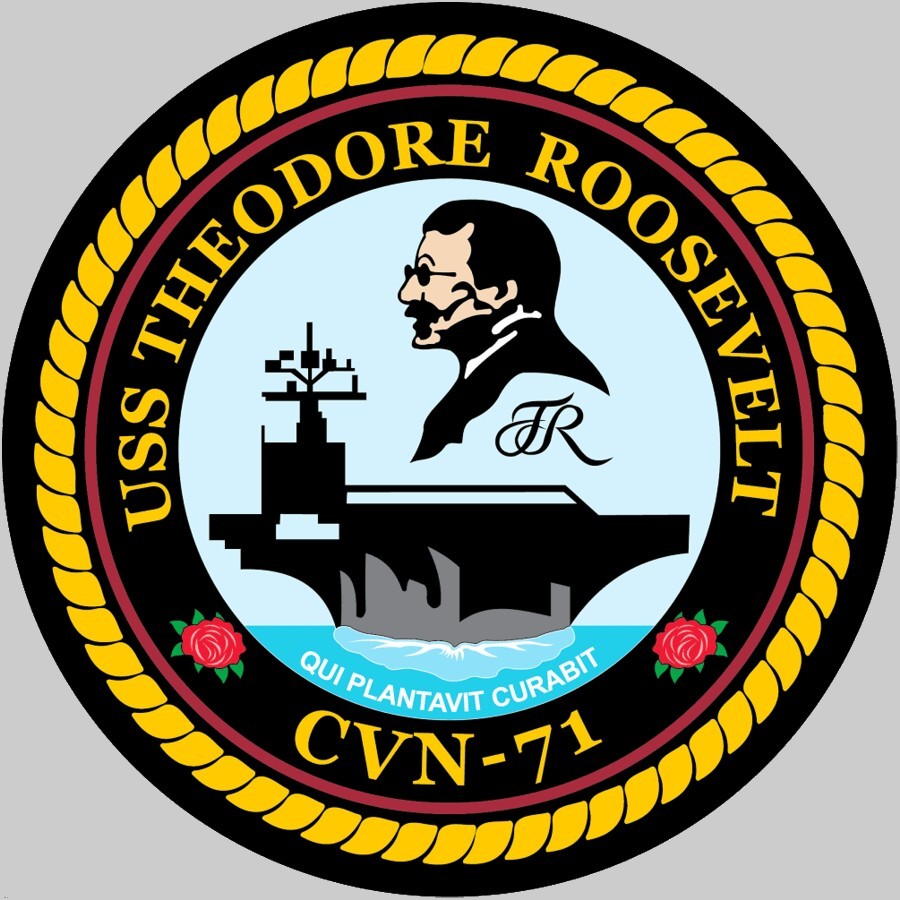 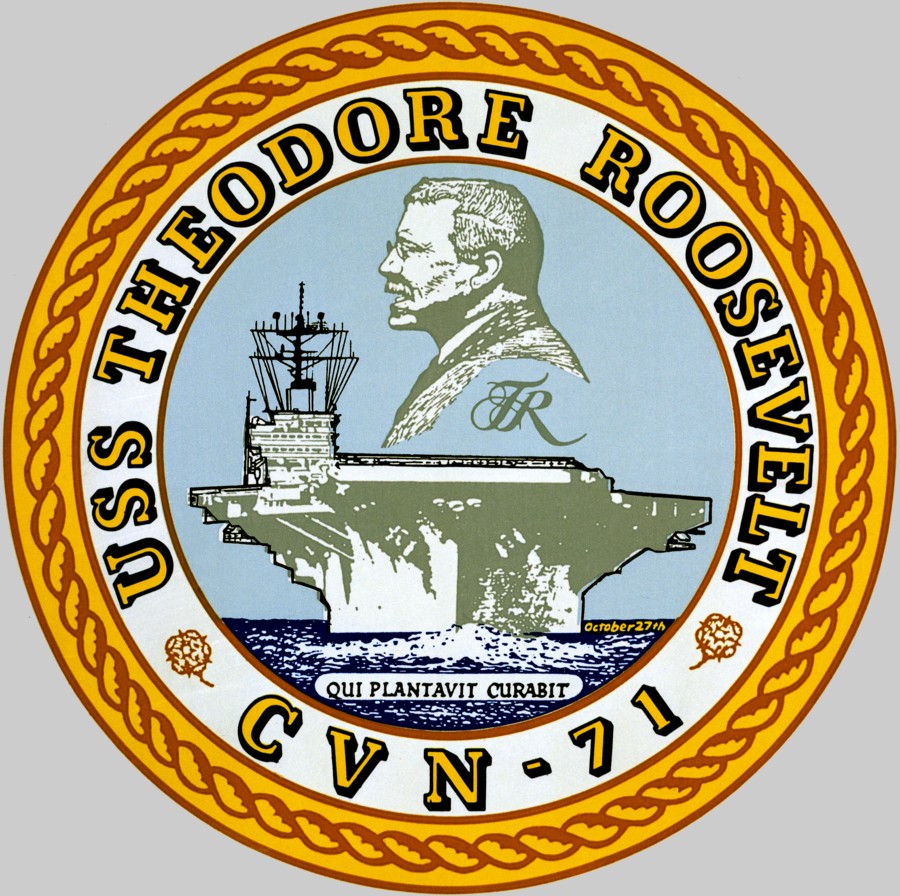 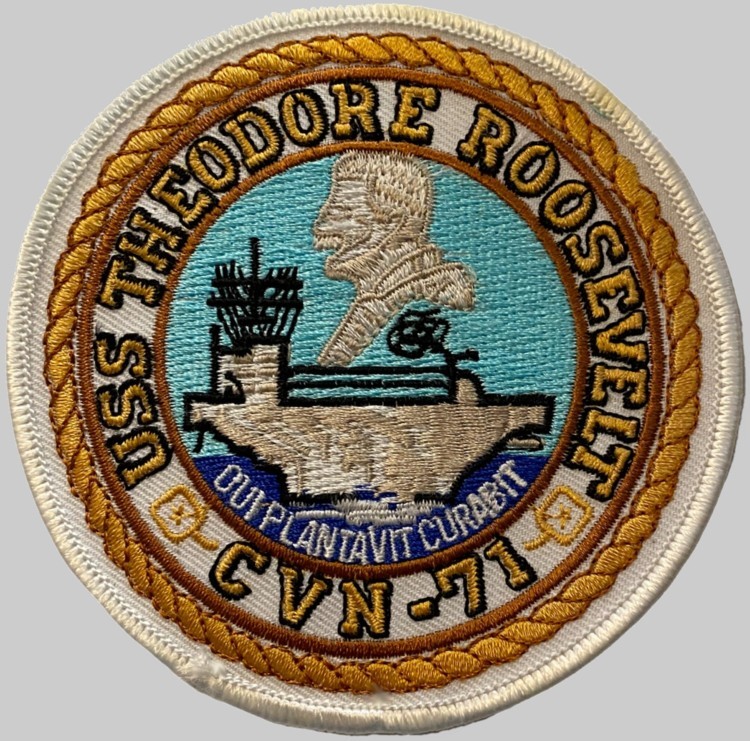 |
||
|
|
seaforces.org |
USN ships
start page | |
